Major Project
VerifiedAdded on 2023/02/06
|83
|21559
|60
AI Summary
Need complete Dissertation, 15000 words\nModule guide attached
Contribute Materials
Your contribution can guide someone’s learning journey. Share your
documents today.
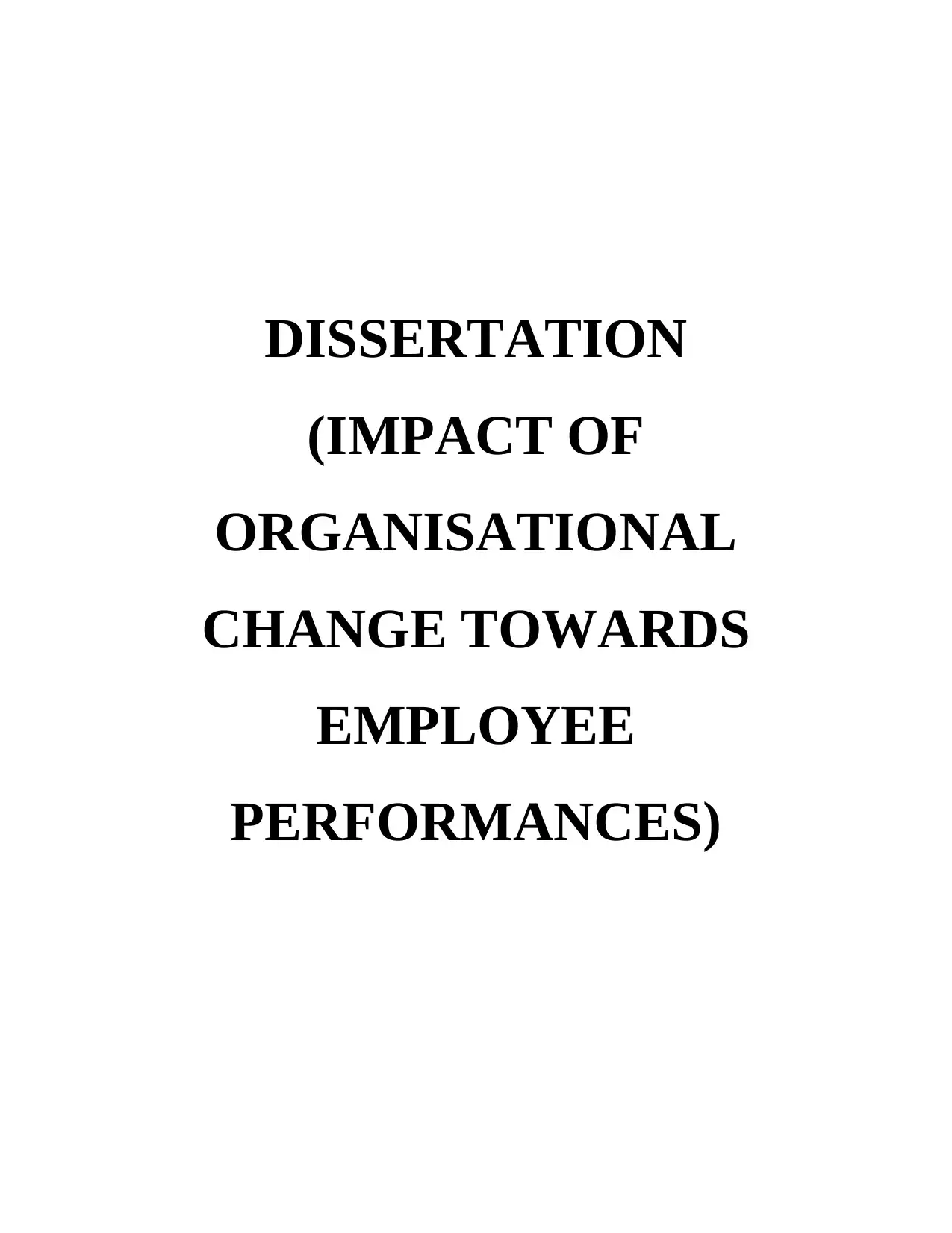
DISSERTATION
(IMPACT OF
ORGANISATIONAL
CHANGE TOWARDS
EMPLOYEE
PERFORMANCES)
(IMPACT OF
ORGANISATIONAL
CHANGE TOWARDS
EMPLOYEE
PERFORMANCES)
Secure Best Marks with AI Grader
Need help grading? Try our AI Grader for instant feedback on your assignments.
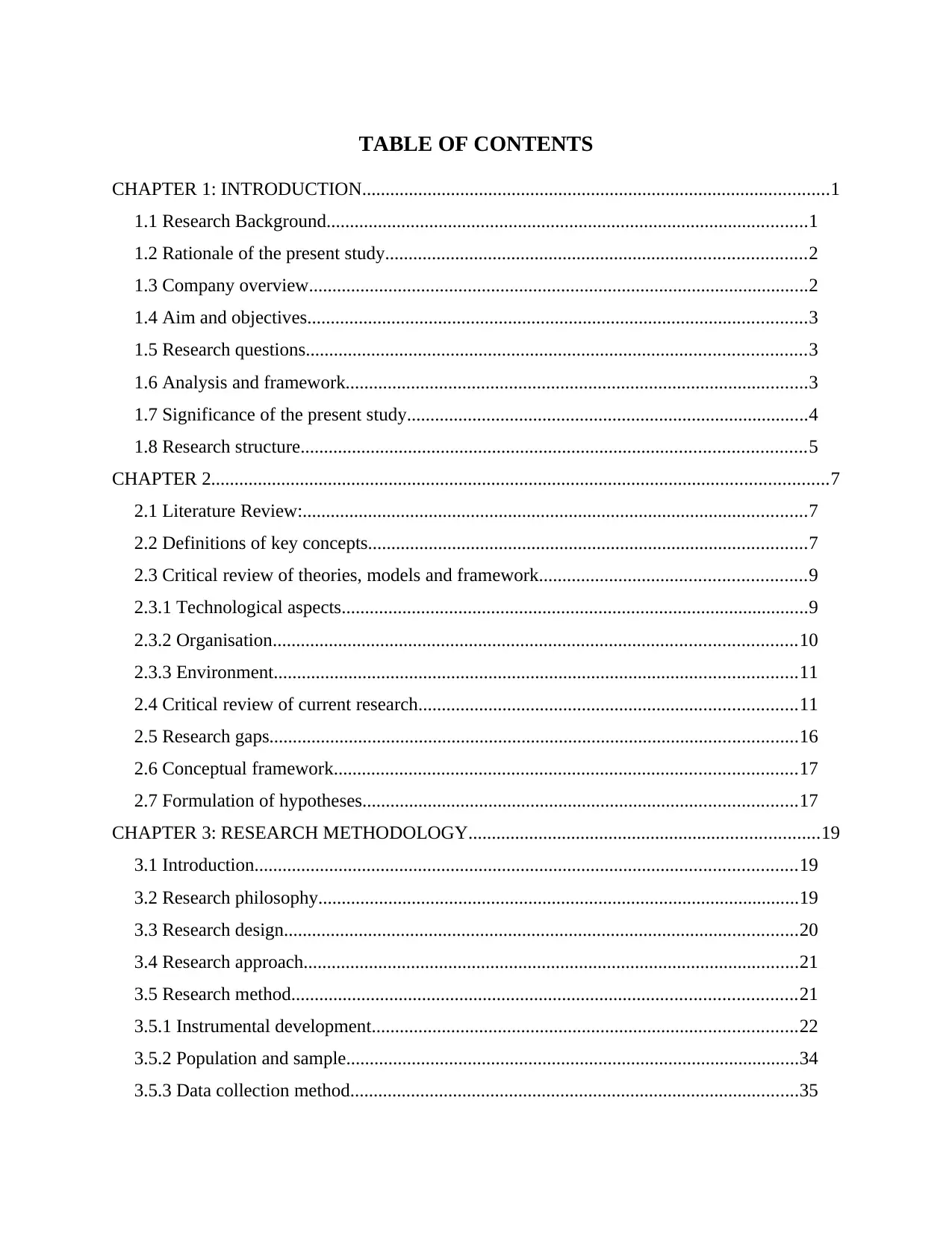
TABLE OF CONTENTS
CHAPTER 1: INTRODUCTION....................................................................................................1
1.1 Research Background.......................................................................................................1
1.2 Rationale of the present study..........................................................................................2
1.3 Company overview...........................................................................................................2
1.4 Aim and objectives...........................................................................................................3
1.5 Research questions...........................................................................................................3
1.6 Analysis and framework...................................................................................................3
1.7 Significance of the present study......................................................................................4
1.8 Research structure............................................................................................................5
CHAPTER 2....................................................................................................................................7
2.1 Literature Review:............................................................................................................7
2.2 Definitions of key concepts..............................................................................................7
2.3 Critical review of theories, models and framework.........................................................9
2.3.1 Technological aspects....................................................................................................9
2.3.2 Organisation................................................................................................................10
2.3.3 Environment................................................................................................................11
2.4 Critical review of current research.................................................................................11
2.5 Research gaps.................................................................................................................16
2.6 Conceptual framework...................................................................................................17
2.7 Formulation of hypotheses.............................................................................................17
CHAPTER 3: RESEARCH METHODOLOGY...........................................................................19
3.1 Introduction....................................................................................................................19
3.2 Research philosophy.......................................................................................................19
3.3 Research design..............................................................................................................20
3.4 Research approach..........................................................................................................21
3.5 Research method............................................................................................................21
3.5.1 Instrumental development...........................................................................................22
3.5.2 Population and sample.................................................................................................34
3.5.3 Data collection method................................................................................................35
CHAPTER 1: INTRODUCTION....................................................................................................1
1.1 Research Background.......................................................................................................1
1.2 Rationale of the present study..........................................................................................2
1.3 Company overview...........................................................................................................2
1.4 Aim and objectives...........................................................................................................3
1.5 Research questions...........................................................................................................3
1.6 Analysis and framework...................................................................................................3
1.7 Significance of the present study......................................................................................4
1.8 Research structure............................................................................................................5
CHAPTER 2....................................................................................................................................7
2.1 Literature Review:............................................................................................................7
2.2 Definitions of key concepts..............................................................................................7
2.3 Critical review of theories, models and framework.........................................................9
2.3.1 Technological aspects....................................................................................................9
2.3.2 Organisation................................................................................................................10
2.3.3 Environment................................................................................................................11
2.4 Critical review of current research.................................................................................11
2.5 Research gaps.................................................................................................................16
2.6 Conceptual framework...................................................................................................17
2.7 Formulation of hypotheses.............................................................................................17
CHAPTER 3: RESEARCH METHODOLOGY...........................................................................19
3.1 Introduction....................................................................................................................19
3.2 Research philosophy.......................................................................................................19
3.3 Research design..............................................................................................................20
3.4 Research approach..........................................................................................................21
3.5 Research method............................................................................................................21
3.5.1 Instrumental development...........................................................................................22
3.5.2 Population and sample.................................................................................................34
3.5.3 Data collection method................................................................................................35
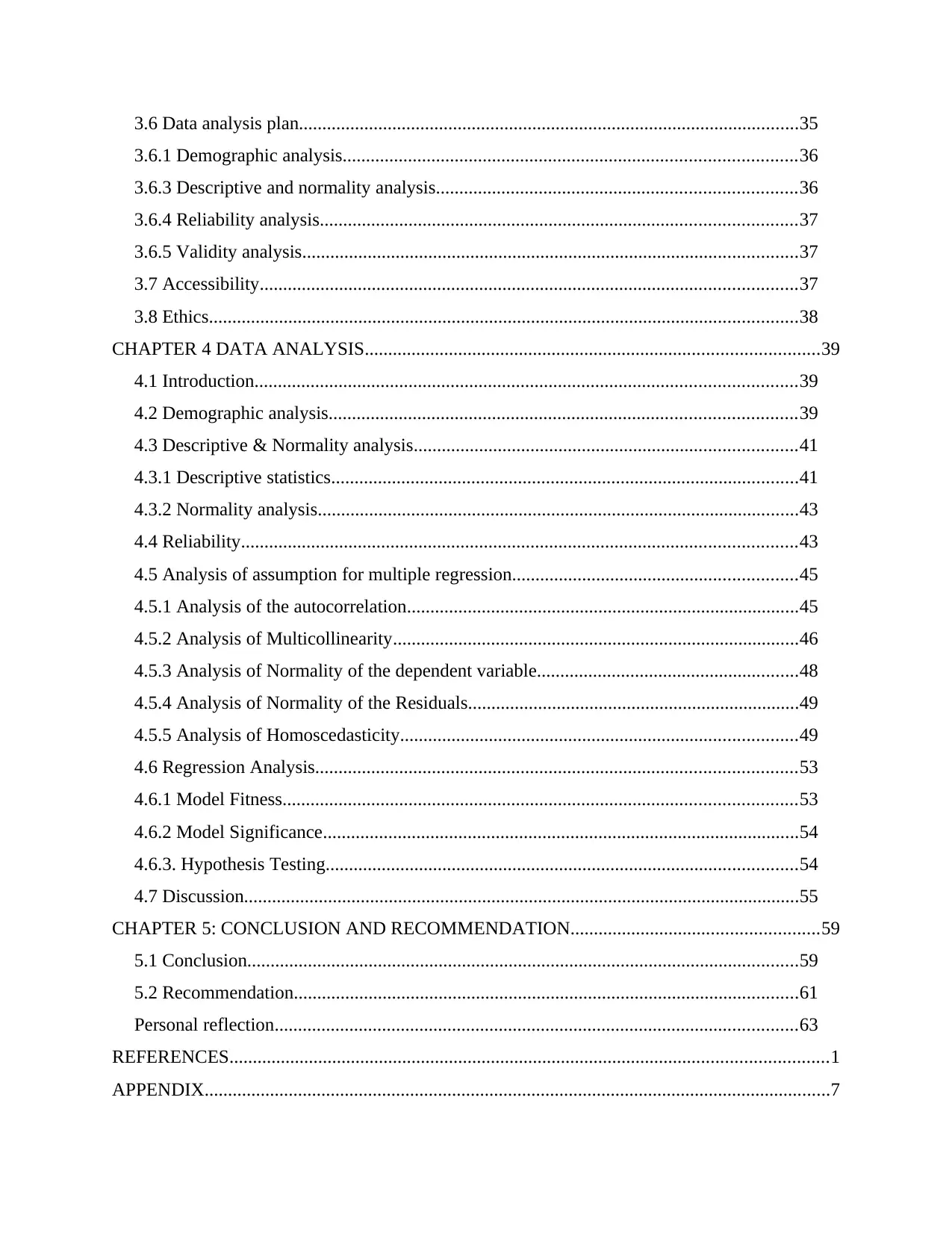
3.6 Data analysis plan...........................................................................................................35
3.6.1 Demographic analysis.................................................................................................36
3.6.3 Descriptive and normality analysis.............................................................................36
3.6.4 Reliability analysis......................................................................................................37
3.6.5 Validity analysis..........................................................................................................37
3.7 Accessibility...................................................................................................................37
3.8 Ethics..............................................................................................................................38
CHAPTER 4 DATA ANALYSIS.................................................................................................39
4.1 Introduction....................................................................................................................39
4.2 Demographic analysis....................................................................................................39
4.3 Descriptive & Normality analysis..................................................................................41
4.3.1 Descriptive statistics....................................................................................................41
4.3.2 Normality analysis.......................................................................................................43
4.4 Reliability.......................................................................................................................43
4.5 Analysis of assumption for multiple regression.............................................................45
4.5.1 Analysis of the autocorrelation....................................................................................45
4.5.2 Analysis of Multicollinearity.......................................................................................46
4.5.3 Analysis of Normality of the dependent variable........................................................48
4.5.4 Analysis of Normality of the Residuals.......................................................................49
4.5.5 Analysis of Homoscedasticity.....................................................................................49
4.6 Regression Analysis.......................................................................................................53
4.6.1 Model Fitness..............................................................................................................53
4.6.2 Model Significance......................................................................................................54
4.6.3. Hypothesis Testing.....................................................................................................54
4.7 Discussion.......................................................................................................................55
CHAPTER 5: CONCLUSION AND RECOMMENDATION.....................................................59
5.1 Conclusion......................................................................................................................59
5.2 Recommendation............................................................................................................61
Personal reflection................................................................................................................63
REFERENCES................................................................................................................................1
APPENDIX......................................................................................................................................7
3.6.1 Demographic analysis.................................................................................................36
3.6.3 Descriptive and normality analysis.............................................................................36
3.6.4 Reliability analysis......................................................................................................37
3.6.5 Validity analysis..........................................................................................................37
3.7 Accessibility...................................................................................................................37
3.8 Ethics..............................................................................................................................38
CHAPTER 4 DATA ANALYSIS.................................................................................................39
4.1 Introduction....................................................................................................................39
4.2 Demographic analysis....................................................................................................39
4.3 Descriptive & Normality analysis..................................................................................41
4.3.1 Descriptive statistics....................................................................................................41
4.3.2 Normality analysis.......................................................................................................43
4.4 Reliability.......................................................................................................................43
4.5 Analysis of assumption for multiple regression.............................................................45
4.5.1 Analysis of the autocorrelation....................................................................................45
4.5.2 Analysis of Multicollinearity.......................................................................................46
4.5.3 Analysis of Normality of the dependent variable........................................................48
4.5.4 Analysis of Normality of the Residuals.......................................................................49
4.5.5 Analysis of Homoscedasticity.....................................................................................49
4.6 Regression Analysis.......................................................................................................53
4.6.1 Model Fitness..............................................................................................................53
4.6.2 Model Significance......................................................................................................54
4.6.3. Hypothesis Testing.....................................................................................................54
4.7 Discussion.......................................................................................................................55
CHAPTER 5: CONCLUSION AND RECOMMENDATION.....................................................59
5.1 Conclusion......................................................................................................................59
5.2 Recommendation............................................................................................................61
Personal reflection................................................................................................................63
REFERENCES................................................................................................................................1
APPENDIX......................................................................................................................................7

Secure Best Marks with AI Grader
Need help grading? Try our AI Grader for instant feedback on your assignments.
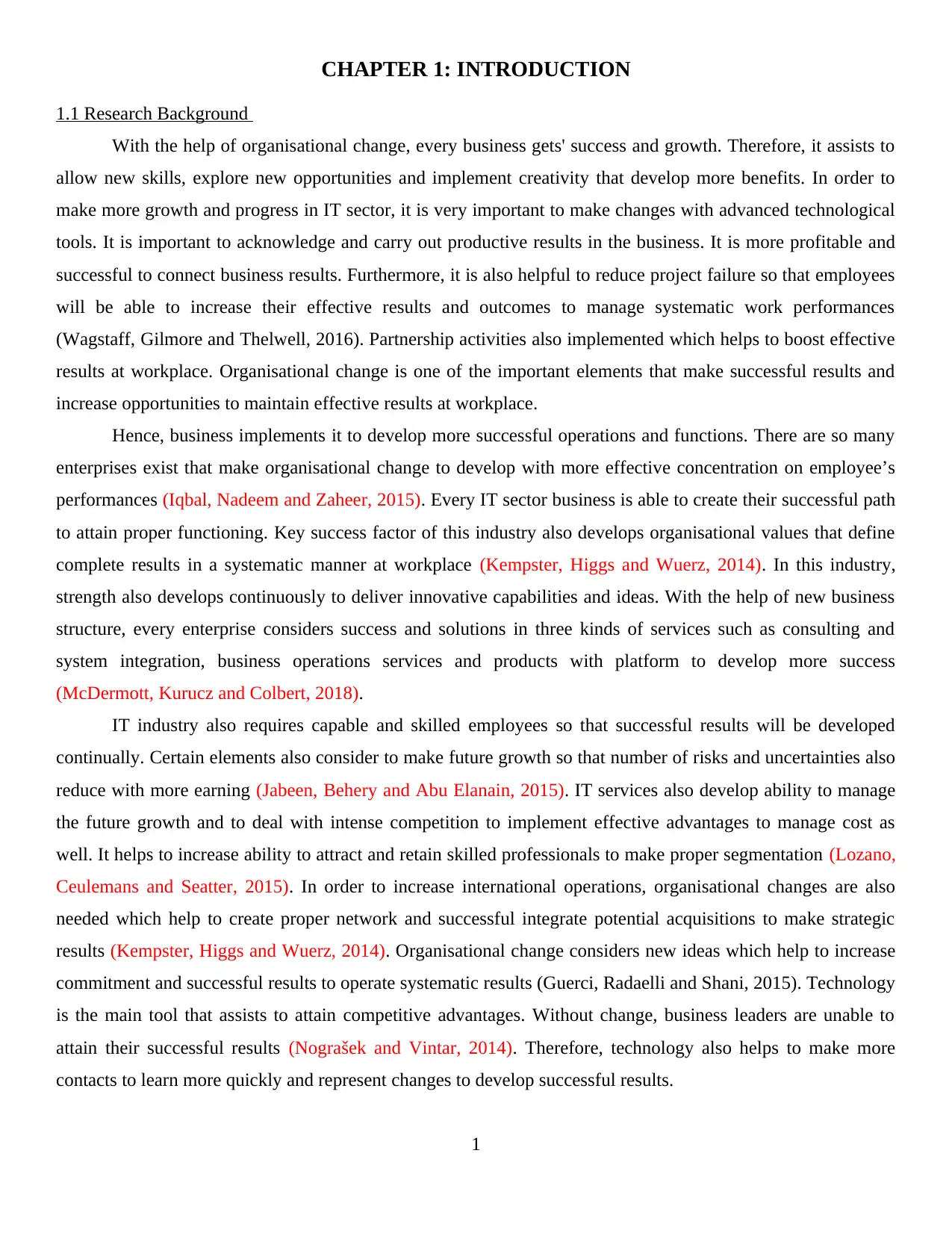
CHAPTER 1: INTRODUCTION
1.1 Research Background
With the help of organisational change, every business gets' success and growth. Therefore, it assists to
allow new skills, explore new opportunities and implement creativity that develop more benefits. In order to
make more growth and progress in IT sector, it is very important to make changes with advanced technological
tools. It is important to acknowledge and carry out productive results in the business. It is more profitable and
successful to connect business results. Furthermore, it is also helpful to reduce project failure so that employees
will be able to increase their effective results and outcomes to manage systematic work performances
(Wagstaff, Gilmore and Thelwell, 2016). Partnership activities also implemented which helps to boost effective
results at workplace. Organisational change is one of the important elements that make successful results and
increase opportunities to maintain effective results at workplace.
Hence, business implements it to develop more successful operations and functions. There are so many
enterprises exist that make organisational change to develop with more effective concentration on employee’s
performances (Iqbal, Nadeem and Zaheer, 2015). Every IT sector business is able to create their successful path
to attain proper functioning. Key success factor of this industry also develops organisational values that define
complete results in a systematic manner at workplace (Kempster, Higgs and Wuerz, 2014). In this industry,
strength also develops continuously to deliver innovative capabilities and ideas. With the help of new business
structure, every enterprise considers success and solutions in three kinds of services such as consulting and
system integration, business operations services and products with platform to develop more success
(McDermott, Kurucz and Colbert, 2018).
IT industry also requires capable and skilled employees so that successful results will be developed
continually. Certain elements also consider to make future growth so that number of risks and uncertainties also
reduce with more earning (Jabeen, Behery and Abu Elanain, 2015). IT services also develop ability to manage
the future growth and to deal with intense competition to implement effective advantages to manage cost as
well. It helps to increase ability to attract and retain skilled professionals to make proper segmentation (Lozano,
Ceulemans and Seatter, 2015). In order to increase international operations, organisational changes are also
needed which help to create proper network and successful integrate potential acquisitions to make strategic
results (Kempster, Higgs and Wuerz, 2014). Organisational change considers new ideas which help to increase
commitment and successful results to operate systematic results (Guerci, Radaelli and Shani, 2015). Technology
is the main tool that assists to attain competitive advantages. Without change, business leaders are unable to
attain their successful results (Nograšek and Vintar, 2014). Therefore, technology also helps to make more
contacts to learn more quickly and represent changes to develop successful results.
1
1.1 Research Background
With the help of organisational change, every business gets' success and growth. Therefore, it assists to
allow new skills, explore new opportunities and implement creativity that develop more benefits. In order to
make more growth and progress in IT sector, it is very important to make changes with advanced technological
tools. It is important to acknowledge and carry out productive results in the business. It is more profitable and
successful to connect business results. Furthermore, it is also helpful to reduce project failure so that employees
will be able to increase their effective results and outcomes to manage systematic work performances
(Wagstaff, Gilmore and Thelwell, 2016). Partnership activities also implemented which helps to boost effective
results at workplace. Organisational change is one of the important elements that make successful results and
increase opportunities to maintain effective results at workplace.
Hence, business implements it to develop more successful operations and functions. There are so many
enterprises exist that make organisational change to develop with more effective concentration on employee’s
performances (Iqbal, Nadeem and Zaheer, 2015). Every IT sector business is able to create their successful path
to attain proper functioning. Key success factor of this industry also develops organisational values that define
complete results in a systematic manner at workplace (Kempster, Higgs and Wuerz, 2014). In this industry,
strength also develops continuously to deliver innovative capabilities and ideas. With the help of new business
structure, every enterprise considers success and solutions in three kinds of services such as consulting and
system integration, business operations services and products with platform to develop more success
(McDermott, Kurucz and Colbert, 2018).
IT industry also requires capable and skilled employees so that successful results will be developed
continually. Certain elements also consider to make future growth so that number of risks and uncertainties also
reduce with more earning (Jabeen, Behery and Abu Elanain, 2015). IT services also develop ability to manage
the future growth and to deal with intense competition to implement effective advantages to manage cost as
well. It helps to increase ability to attract and retain skilled professionals to make proper segmentation (Lozano,
Ceulemans and Seatter, 2015). In order to increase international operations, organisational changes are also
needed which help to create proper network and successful integrate potential acquisitions to make strategic
results (Kempster, Higgs and Wuerz, 2014). Organisational change considers new ideas which help to increase
commitment and successful results to operate systematic results (Guerci, Radaelli and Shani, 2015). Technology
is the main tool that assists to attain competitive advantages. Without change, business leaders are unable to
attain their successful results (Nograšek and Vintar, 2014). Therefore, technology also helps to make more
contacts to learn more quickly and represent changes to develop successful results.
1
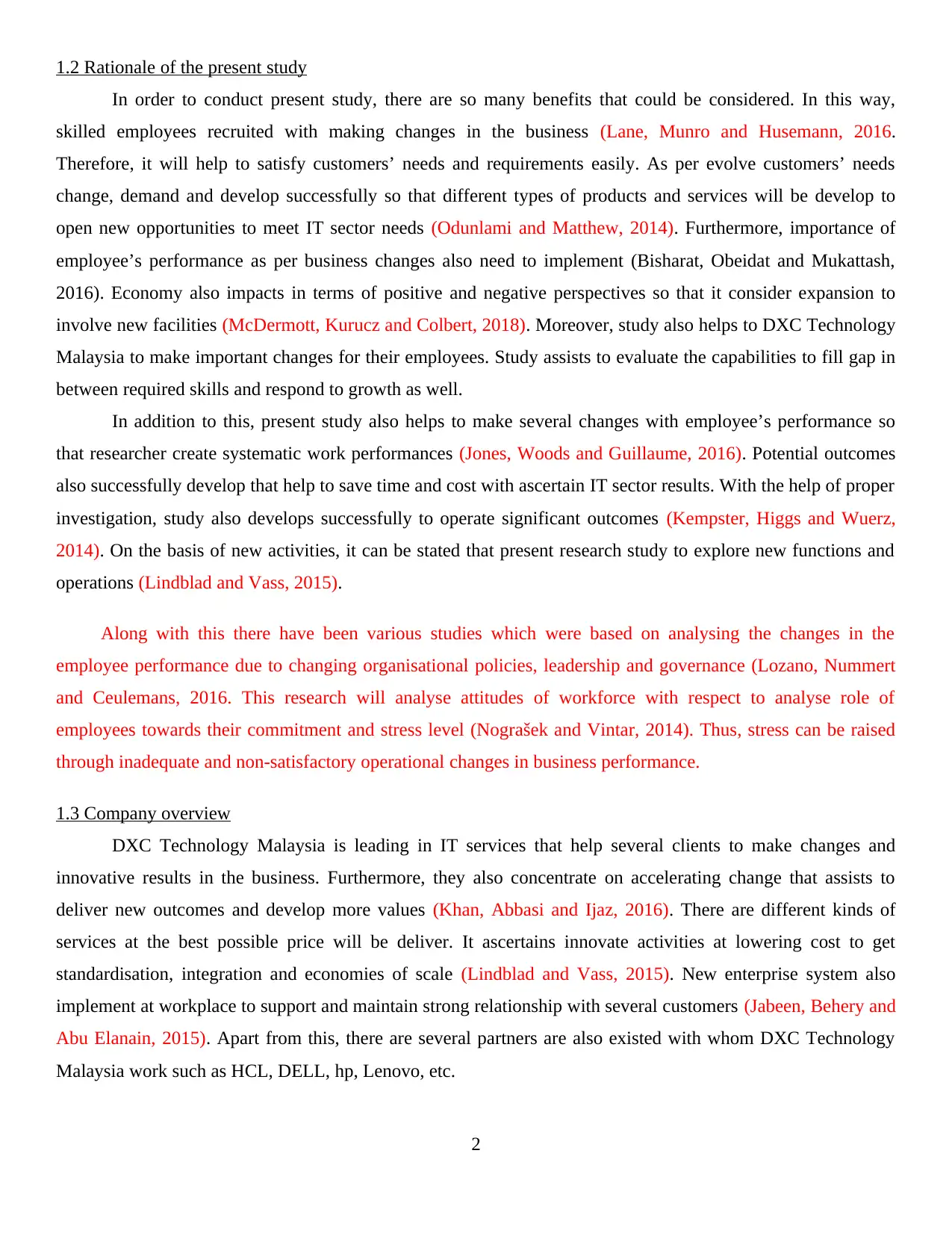
1.2 Rationale of the present study
In order to conduct present study, there are so many benefits that could be considered. In this way,
skilled employees recruited with making changes in the business (Lane, Munro and Husemann, 2016.
Therefore, it will help to satisfy customers’ needs and requirements easily. As per evolve customers’ needs
change, demand and develop successfully so that different types of products and services will be develop to
open new opportunities to meet IT sector needs (Odunlami and Matthew, 2014). Furthermore, importance of
employee’s performance as per business changes also need to implement (Bisharat, Obeidat and Mukattash,
2016). Economy also impacts in terms of positive and negative perspectives so that it consider expansion to
involve new facilities (McDermott, Kurucz and Colbert, 2018). Moreover, study also helps to DXC Technology
Malaysia to make important changes for their employees. Study assists to evaluate the capabilities to fill gap in
between required skills and respond to growth as well.
In addition to this, present study also helps to make several changes with employee’s performance so
that researcher create systematic work performances (Jones, Woods and Guillaume, 2016). Potential outcomes
also successfully develop that help to save time and cost with ascertain IT sector results. With the help of proper
investigation, study also develops successfully to operate significant outcomes (Kempster, Higgs and Wuerz,
2014). On the basis of new activities, it can be stated that present research study to explore new functions and
operations (Lindblad and Vass, 2015).
Along with this there have been various studies which were based on analysing the changes in the
employee performance due to changing organisational policies, leadership and governance (Lozano, Nummert
and Ceulemans, 2016. This research will analyse attitudes of workforce with respect to analyse role of
employees towards their commitment and stress level (Nograšek and Vintar, 2014). Thus, stress can be raised
through inadequate and non-satisfactory operational changes in business performance.
1.3 Company overview
DXC Technology Malaysia is leading in IT services that help several clients to make changes and
innovative results in the business. Furthermore, they also concentrate on accelerating change that assists to
deliver new outcomes and develop more values (Khan, Abbasi and Ijaz, 2016). There are different kinds of
services at the best possible price will be deliver. It ascertains innovate activities at lowering cost to get
standardisation, integration and economies of scale (Lindblad and Vass, 2015). New enterprise system also
implement at workplace to support and maintain strong relationship with several customers (Jabeen, Behery and
Abu Elanain, 2015). Apart from this, there are several partners are also existed with whom DXC Technology
Malaysia work such as HCL, DELL, hp, Lenovo, etc.
2
In order to conduct present study, there are so many benefits that could be considered. In this way,
skilled employees recruited with making changes in the business (Lane, Munro and Husemann, 2016.
Therefore, it will help to satisfy customers’ needs and requirements easily. As per evolve customers’ needs
change, demand and develop successfully so that different types of products and services will be develop to
open new opportunities to meet IT sector needs (Odunlami and Matthew, 2014). Furthermore, importance of
employee’s performance as per business changes also need to implement (Bisharat, Obeidat and Mukattash,
2016). Economy also impacts in terms of positive and negative perspectives so that it consider expansion to
involve new facilities (McDermott, Kurucz and Colbert, 2018). Moreover, study also helps to DXC Technology
Malaysia to make important changes for their employees. Study assists to evaluate the capabilities to fill gap in
between required skills and respond to growth as well.
In addition to this, present study also helps to make several changes with employee’s performance so
that researcher create systematic work performances (Jones, Woods and Guillaume, 2016). Potential outcomes
also successfully develop that help to save time and cost with ascertain IT sector results. With the help of proper
investigation, study also develops successfully to operate significant outcomes (Kempster, Higgs and Wuerz,
2014). On the basis of new activities, it can be stated that present research study to explore new functions and
operations (Lindblad and Vass, 2015).
Along with this there have been various studies which were based on analysing the changes in the
employee performance due to changing organisational policies, leadership and governance (Lozano, Nummert
and Ceulemans, 2016. This research will analyse attitudes of workforce with respect to analyse role of
employees towards their commitment and stress level (Nograšek and Vintar, 2014). Thus, stress can be raised
through inadequate and non-satisfactory operational changes in business performance.
1.3 Company overview
DXC Technology Malaysia is leading in IT services that help several clients to make changes and
innovative results in the business. Furthermore, they also concentrate on accelerating change that assists to
deliver new outcomes and develop more values (Khan, Abbasi and Ijaz, 2016). There are different kinds of
services at the best possible price will be deliver. It ascertains innovate activities at lowering cost to get
standardisation, integration and economies of scale (Lindblad and Vass, 2015). New enterprise system also
implement at workplace to support and maintain strong relationship with several customers (Jabeen, Behery and
Abu Elanain, 2015). Apart from this, there are several partners are also existed with whom DXC Technology
Malaysia work such as HCL, DELL, hp, Lenovo, etc.
2

1.4 Aim and objectives
In order to conduct present research, work will be done on analysis organisational change towards
employees performances. In this context, following aim and objectives develop to investigate effective results:
Aim: “To analyse the impact of organisational change towards employee’s performance in IT sector – A Case
Study on DXC Technology Malaysia”
Objectives
To understand the concept of organisational change on employees performances in IT sector
To explore the impact of organisational communication on employees' efficiency in DXC.
To analysis impact of organisational commitment on quality of employees in chosen business.
To recommend ways through organisation culture, communication and commitment implement in DXC
for development of employees efficiency, timeliness performances.
1.5 Research questions
What do you understand by the concept of organisational change on employees performances in IT
sector?
How to explore the impact of organisational communication on employees' efficiency in DXC?
What are the impact of organisational commitment on quality of employees in chosen business?
What are the recommendation through organisation culture, communication and commitment implement
in DXC for development of employees efficiency, timeliness performances?
1.6 Analysis and framework
In order to consider the present study, there are different kinds of data collected from resources to find
useful results in business. All resources are authentic so that researcher will develop their understanding to
focus on different perspectives (Mamic, 2017). Present study focuses on qualitative approach to analyse data
and gather relevant sources at workplace. Along with this, data and information gathered from primary and
secondary both kinds of sources so that systematic work performance develop to attain more desired results
(McDermott, Kurucz and Colbert, 2018). In order to collect primary data, researcher considers questionnaire
which undertakes certain questions from the respondents. Furthermore, secondary information is also gathered
from relevant sources such as journals, books, articles, magazines, etc. In order to consider primary data
analysis develop with assessment of impact of organisational change on employees performances (Lindblad and
Vass, 2015). Hence, primary and secondary both kinds of data ascertain in the present research to consider
relevant work. With the help of this research, analysis develops successfully which assists to conduct proper
3
In order to conduct present research, work will be done on analysis organisational change towards
employees performances. In this context, following aim and objectives develop to investigate effective results:
Aim: “To analyse the impact of organisational change towards employee’s performance in IT sector – A Case
Study on DXC Technology Malaysia”
Objectives
To understand the concept of organisational change on employees performances in IT sector
To explore the impact of organisational communication on employees' efficiency in DXC.
To analysis impact of organisational commitment on quality of employees in chosen business.
To recommend ways through organisation culture, communication and commitment implement in DXC
for development of employees efficiency, timeliness performances.
1.5 Research questions
What do you understand by the concept of organisational change on employees performances in IT
sector?
How to explore the impact of organisational communication on employees' efficiency in DXC?
What are the impact of organisational commitment on quality of employees in chosen business?
What are the recommendation through organisation culture, communication and commitment implement
in DXC for development of employees efficiency, timeliness performances?
1.6 Analysis and framework
In order to consider the present study, there are different kinds of data collected from resources to find
useful results in business. All resources are authentic so that researcher will develop their understanding to
focus on different perspectives (Mamic, 2017). Present study focuses on qualitative approach to analyse data
and gather relevant sources at workplace. Along with this, data and information gathered from primary and
secondary both kinds of sources so that systematic work performance develop to attain more desired results
(McDermott, Kurucz and Colbert, 2018). In order to collect primary data, researcher considers questionnaire
which undertakes certain questions from the respondents. Furthermore, secondary information is also gathered
from relevant sources such as journals, books, articles, magazines, etc. In order to consider primary data
analysis develop with assessment of impact of organisational change on employees performances (Lindblad and
Vass, 2015). Hence, primary and secondary both kinds of data ascertain in the present research to consider
relevant work. With the help of this research, analysis develops successfully which assists to conduct proper
3
Paraphrase This Document
Need a fresh take? Get an instant paraphrase of this document with our AI Paraphraser
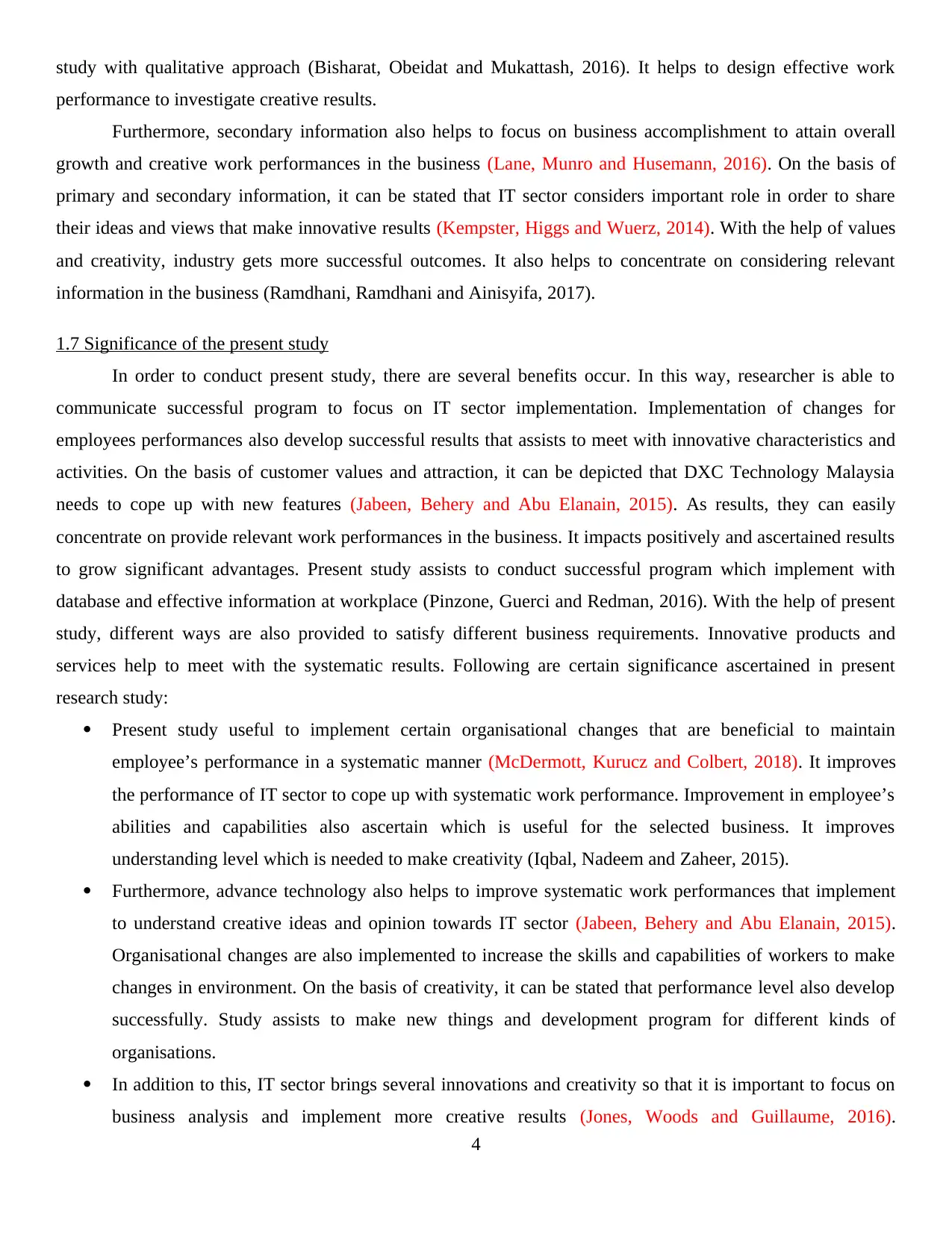
study with qualitative approach (Bisharat, Obeidat and Mukattash, 2016). It helps to design effective work
performance to investigate creative results.
Furthermore, secondary information also helps to focus on business accomplishment to attain overall
growth and creative work performances in the business (Lane, Munro and Husemann, 2016). On the basis of
primary and secondary information, it can be stated that IT sector considers important role in order to share
their ideas and views that make innovative results (Kempster, Higgs and Wuerz, 2014). With the help of values
and creativity, industry gets more successful outcomes. It also helps to concentrate on considering relevant
information in the business (Ramdhani, Ramdhani and Ainisyifa, 2017).
1.7 Significance of the present study
In order to conduct present study, there are several benefits occur. In this way, researcher is able to
communicate successful program to focus on IT sector implementation. Implementation of changes for
employees performances also develop successful results that assists to meet with innovative characteristics and
activities. On the basis of customer values and attraction, it can be depicted that DXC Technology Malaysia
needs to cope up with new features (Jabeen, Behery and Abu Elanain, 2015). As results, they can easily
concentrate on provide relevant work performances in the business. It impacts positively and ascertained results
to grow significant advantages. Present study assists to conduct successful program which implement with
database and effective information at workplace (Pinzone, Guerci and Redman, 2016). With the help of present
study, different ways are also provided to satisfy different business requirements. Innovative products and
services help to meet with the systematic results. Following are certain significance ascertained in present
research study:
Present study useful to implement certain organisational changes that are beneficial to maintain
employee’s performance in a systematic manner (McDermott, Kurucz and Colbert, 2018). It improves
the performance of IT sector to cope up with systematic work performance. Improvement in employee’s
abilities and capabilities also ascertain which is useful for the selected business. It improves
understanding level which is needed to make creativity (Iqbal, Nadeem and Zaheer, 2015).
Furthermore, advance technology also helps to improve systematic work performances that implement
to understand creative ideas and opinion towards IT sector (Jabeen, Behery and Abu Elanain, 2015).
Organisational changes are also implemented to increase the skills and capabilities of workers to make
changes in environment. On the basis of creativity, it can be stated that performance level also develop
successfully. Study assists to make new things and development program for different kinds of
organisations.
In addition to this, IT sector brings several innovations and creativity so that it is important to focus on
business analysis and implement more creative results (Jones, Woods and Guillaume, 2016).
4
performance to investigate creative results.
Furthermore, secondary information also helps to focus on business accomplishment to attain overall
growth and creative work performances in the business (Lane, Munro and Husemann, 2016). On the basis of
primary and secondary information, it can be stated that IT sector considers important role in order to share
their ideas and views that make innovative results (Kempster, Higgs and Wuerz, 2014). With the help of values
and creativity, industry gets more successful outcomes. It also helps to concentrate on considering relevant
information in the business (Ramdhani, Ramdhani and Ainisyifa, 2017).
1.7 Significance of the present study
In order to conduct present study, there are several benefits occur. In this way, researcher is able to
communicate successful program to focus on IT sector implementation. Implementation of changes for
employees performances also develop successful results that assists to meet with innovative characteristics and
activities. On the basis of customer values and attraction, it can be depicted that DXC Technology Malaysia
needs to cope up with new features (Jabeen, Behery and Abu Elanain, 2015). As results, they can easily
concentrate on provide relevant work performances in the business. It impacts positively and ascertained results
to grow significant advantages. Present study assists to conduct successful program which implement with
database and effective information at workplace (Pinzone, Guerci and Redman, 2016). With the help of present
study, different ways are also provided to satisfy different business requirements. Innovative products and
services help to meet with the systematic results. Following are certain significance ascertained in present
research study:
Present study useful to implement certain organisational changes that are beneficial to maintain
employee’s performance in a systematic manner (McDermott, Kurucz and Colbert, 2018). It improves
the performance of IT sector to cope up with systematic work performance. Improvement in employee’s
abilities and capabilities also ascertain which is useful for the selected business. It improves
understanding level which is needed to make creativity (Iqbal, Nadeem and Zaheer, 2015).
Furthermore, advance technology also helps to improve systematic work performances that implement
to understand creative ideas and opinion towards IT sector (Jabeen, Behery and Abu Elanain, 2015).
Organisational changes are also implemented to increase the skills and capabilities of workers to make
changes in environment. On the basis of creativity, it can be stated that performance level also develop
successfully. Study assists to make new things and development program for different kinds of
organisations.
In addition to this, IT sector brings several innovations and creativity so that it is important to focus on
business analysis and implement more creative results (Jones, Woods and Guillaume, 2016).
4
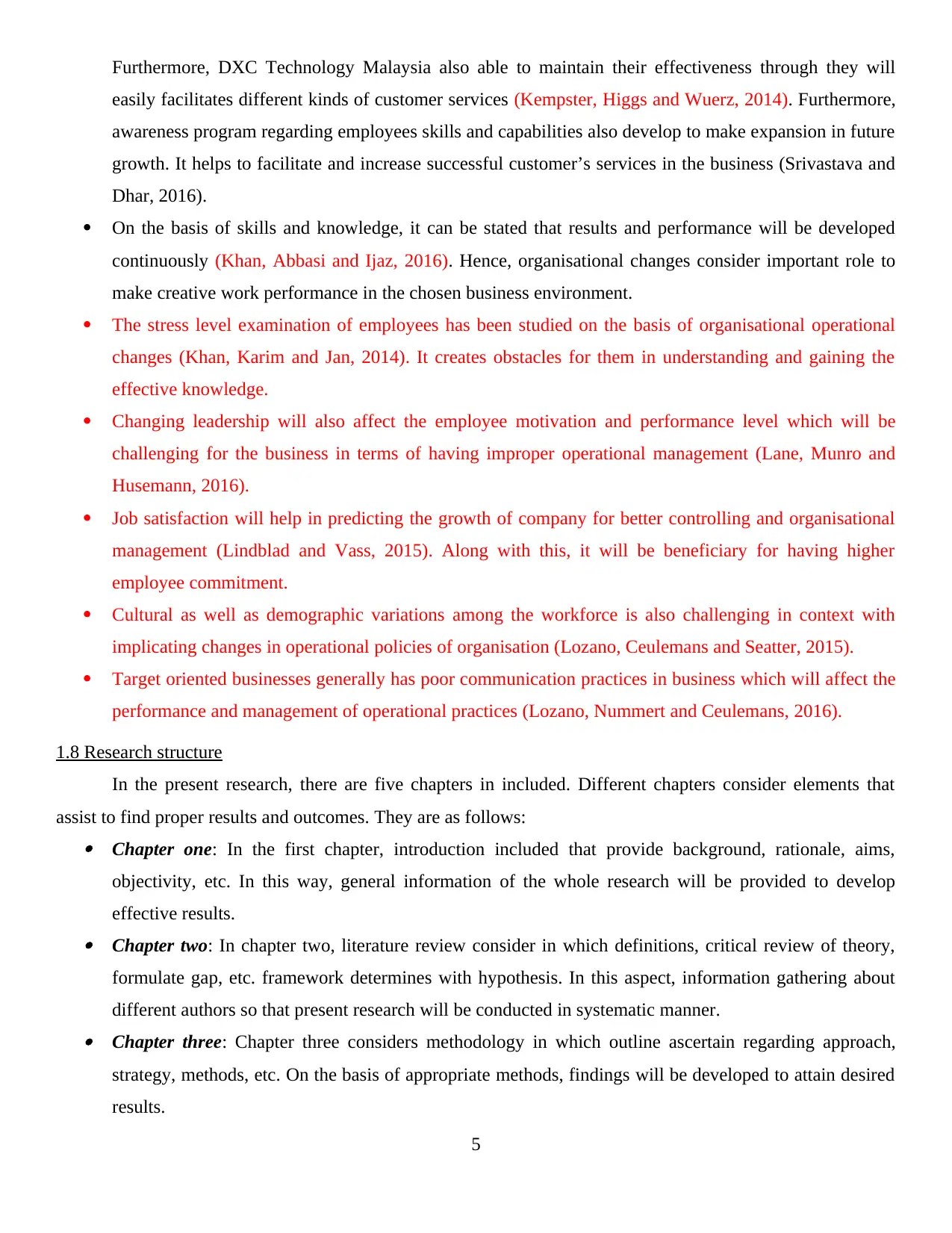
Furthermore, DXC Technology Malaysia also able to maintain their effectiveness through they will
easily facilitates different kinds of customer services (Kempster, Higgs and Wuerz, 2014). Furthermore,
awareness program regarding employees skills and capabilities also develop to make expansion in future
growth. It helps to facilitate and increase successful customer’s services in the business (Srivastava and
Dhar, 2016).
On the basis of skills and knowledge, it can be stated that results and performance will be developed
continuously (Khan, Abbasi and Ijaz, 2016). Hence, organisational changes consider important role to
make creative work performance in the chosen business environment.
The stress level examination of employees has been studied on the basis of organisational operational
changes (Khan, Karim and Jan, 2014). It creates obstacles for them in understanding and gaining the
effective knowledge.
Changing leadership will also affect the employee motivation and performance level which will be
challenging for the business in terms of having improper operational management (Lane, Munro and
Husemann, 2016).
Job satisfaction will help in predicting the growth of company for better controlling and organisational
management (Lindblad and Vass, 2015). Along with this, it will be beneficiary for having higher
employee commitment.
Cultural as well as demographic variations among the workforce is also challenging in context with
implicating changes in operational policies of organisation (Lozano, Ceulemans and Seatter, 2015).
Target oriented businesses generally has poor communication practices in business which will affect the
performance and management of operational practices (Lozano, Nummert and Ceulemans, 2016).
1.8 Research structure
In the present research, there are five chapters in included. Different chapters consider elements that
assist to find proper results and outcomes. They are as follows:
Chapter one: In the first chapter, introduction included that provide background, rationale, aims,
objectivity, etc. In this way, general information of the whole research will be provided to develop
effective results.
Chapter two: In chapter two, literature review consider in which definitions, critical review of theory,
formulate gap, etc. framework determines with hypothesis. In this aspect, information gathering about
different authors so that present research will be conducted in systematic manner.
Chapter three: Chapter three considers methodology in which outline ascertain regarding approach,
strategy, methods, etc. On the basis of appropriate methods, findings will be developed to attain desired
results.
5
easily facilitates different kinds of customer services (Kempster, Higgs and Wuerz, 2014). Furthermore,
awareness program regarding employees skills and capabilities also develop to make expansion in future
growth. It helps to facilitate and increase successful customer’s services in the business (Srivastava and
Dhar, 2016).
On the basis of skills and knowledge, it can be stated that results and performance will be developed
continuously (Khan, Abbasi and Ijaz, 2016). Hence, organisational changes consider important role to
make creative work performance in the chosen business environment.
The stress level examination of employees has been studied on the basis of organisational operational
changes (Khan, Karim and Jan, 2014). It creates obstacles for them in understanding and gaining the
effective knowledge.
Changing leadership will also affect the employee motivation and performance level which will be
challenging for the business in terms of having improper operational management (Lane, Munro and
Husemann, 2016).
Job satisfaction will help in predicting the growth of company for better controlling and organisational
management (Lindblad and Vass, 2015). Along with this, it will be beneficiary for having higher
employee commitment.
Cultural as well as demographic variations among the workforce is also challenging in context with
implicating changes in operational policies of organisation (Lozano, Ceulemans and Seatter, 2015).
Target oriented businesses generally has poor communication practices in business which will affect the
performance and management of operational practices (Lozano, Nummert and Ceulemans, 2016).
1.8 Research structure
In the present research, there are five chapters in included. Different chapters consider elements that
assist to find proper results and outcomes. They are as follows:
Chapter one: In the first chapter, introduction included that provide background, rationale, aims,
objectivity, etc. In this way, general information of the whole research will be provided to develop
effective results.
Chapter two: In chapter two, literature review consider in which definitions, critical review of theory,
formulate gap, etc. framework determines with hypothesis. In this aspect, information gathering about
different authors so that present research will be conducted in systematic manner.
Chapter three: Chapter three considers methodology in which outline ascertain regarding approach,
strategy, methods, etc. On the basis of appropriate methods, findings will be developed to attain desired
results.
5
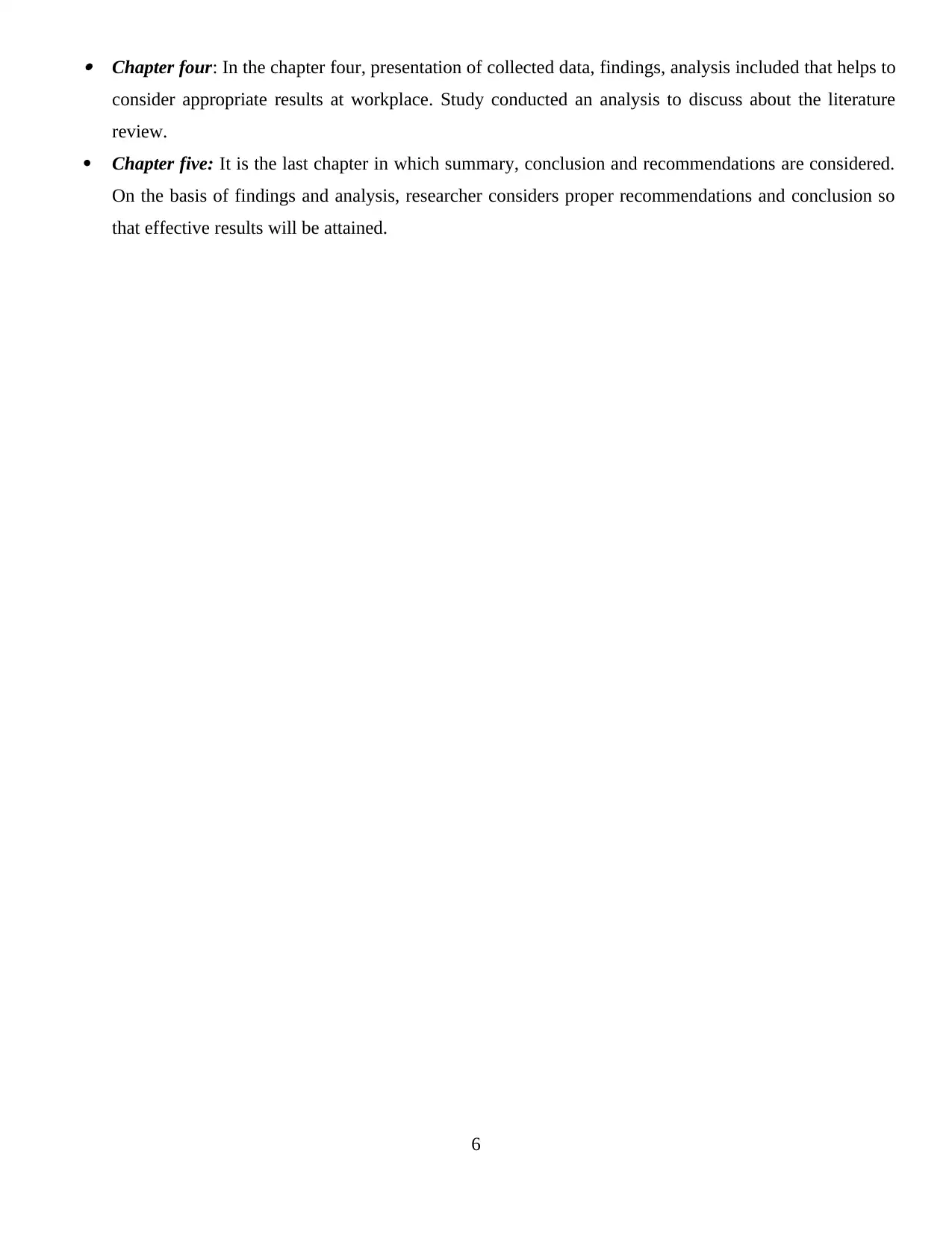
Chapter four: In the chapter four, presentation of collected data, findings, analysis included that helps to
consider appropriate results at workplace. Study conducted an analysis to discuss about the literature
review.
Chapter five: It is the last chapter in which summary, conclusion and recommendations are considered.
On the basis of findings and analysis, researcher considers proper recommendations and conclusion so
that effective results will be attained.
6
consider appropriate results at workplace. Study conducted an analysis to discuss about the literature
review.
Chapter five: It is the last chapter in which summary, conclusion and recommendations are considered.
On the basis of findings and analysis, researcher considers proper recommendations and conclusion so
that effective results will be attained.
6
Secure Best Marks with AI Grader
Need help grading? Try our AI Grader for instant feedback on your assignments.
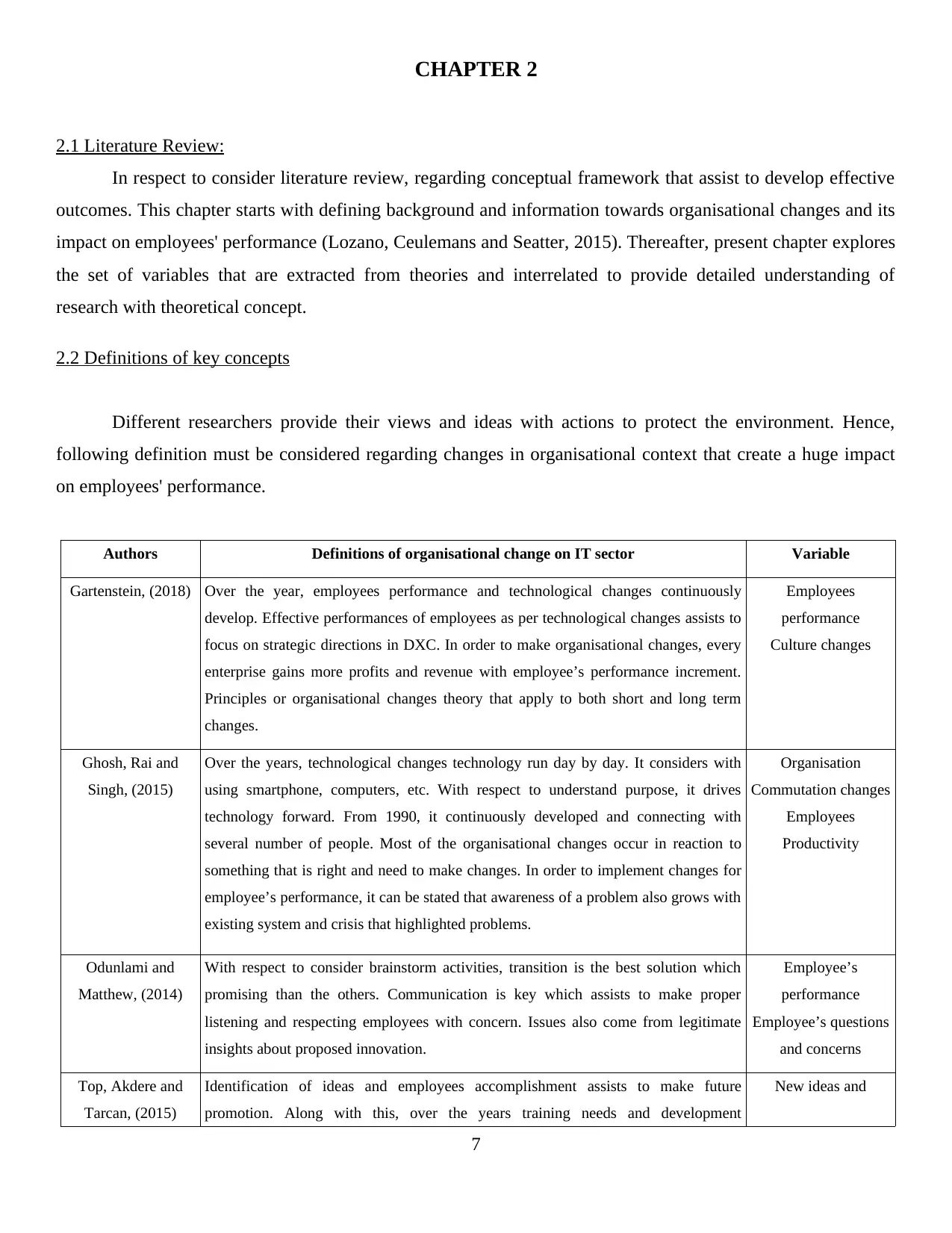
CHAPTER 2
2.1 Literature Review:
In respect to consider literature review, regarding conceptual framework that assist to develop effective
outcomes. This chapter starts with defining background and information towards organisational changes and its
impact on employees' performance (Lozano, Ceulemans and Seatter, 2015). Thereafter, present chapter explores
the set of variables that are extracted from theories and interrelated to provide detailed understanding of
research with theoretical concept.
2.2 Definitions of key concepts
Different researchers provide their views and ideas with actions to protect the environment. Hence,
following definition must be considered regarding changes in organisational context that create a huge impact
on employees' performance.
Authors Definitions of organisational change on IT sector Variable
Gartenstein, (2018) Over the year, employees performance and technological changes continuously
develop. Effective performances of employees as per technological changes assists to
focus on strategic directions in DXC. In order to make organisational changes, every
enterprise gains more profits and revenue with employee’s performance increment.
Principles or organisational changes theory that apply to both short and long term
changes.
Employees
performance
Culture changes
Ghosh, Rai and
Singh, (2015)
Over the years, technological changes technology run day by day. It considers with
using smartphone, computers, etc. With respect to understand purpose, it drives
technology forward. From 1990, it continuously developed and connecting with
several number of people. Most of the organisational changes occur in reaction to
something that is right and need to make changes. In order to implement changes for
employee’s performance, it can be stated that awareness of a problem also grows with
existing system and crisis that highlighted problems.
Organisation
Commutation changes
Employees
Productivity
Odunlami and
Matthew, (2014)
With respect to consider brainstorm activities, transition is the best solution which
promising than the others. Communication is key which assists to make proper
listening and respecting employees with concern. Issues also come from legitimate
insights about proposed innovation.
Employee’s
performance
Employee’s questions
and concerns
Top, Akdere and
Tarcan, (2015)
Identification of ideas and employees accomplishment assists to make future
promotion. Along with this, over the years training needs and development
New ideas and
7
2.1 Literature Review:
In respect to consider literature review, regarding conceptual framework that assist to develop effective
outcomes. This chapter starts with defining background and information towards organisational changes and its
impact on employees' performance (Lozano, Ceulemans and Seatter, 2015). Thereafter, present chapter explores
the set of variables that are extracted from theories and interrelated to provide detailed understanding of
research with theoretical concept.
2.2 Definitions of key concepts
Different researchers provide their views and ideas with actions to protect the environment. Hence,
following definition must be considered regarding changes in organisational context that create a huge impact
on employees' performance.
Authors Definitions of organisational change on IT sector Variable
Gartenstein, (2018) Over the year, employees performance and technological changes continuously
develop. Effective performances of employees as per technological changes assists to
focus on strategic directions in DXC. In order to make organisational changes, every
enterprise gains more profits and revenue with employee’s performance increment.
Principles or organisational changes theory that apply to both short and long term
changes.
Employees
performance
Culture changes
Ghosh, Rai and
Singh, (2015)
Over the years, technological changes technology run day by day. It considers with
using smartphone, computers, etc. With respect to understand purpose, it drives
technology forward. From 1990, it continuously developed and connecting with
several number of people. Most of the organisational changes occur in reaction to
something that is right and need to make changes. In order to implement changes for
employee’s performance, it can be stated that awareness of a problem also grows with
existing system and crisis that highlighted problems.
Organisation
Commutation changes
Employees
Productivity
Odunlami and
Matthew, (2014)
With respect to consider brainstorm activities, transition is the best solution which
promising than the others. Communication is key which assists to make proper
listening and respecting employees with concern. Issues also come from legitimate
insights about proposed innovation.
Employee’s
performance
Employee’s questions
and concerns
Top, Akdere and
Tarcan, (2015)
Identification of ideas and employees accomplishment assists to make future
promotion. Along with this, over the years training needs and development
New ideas and
7
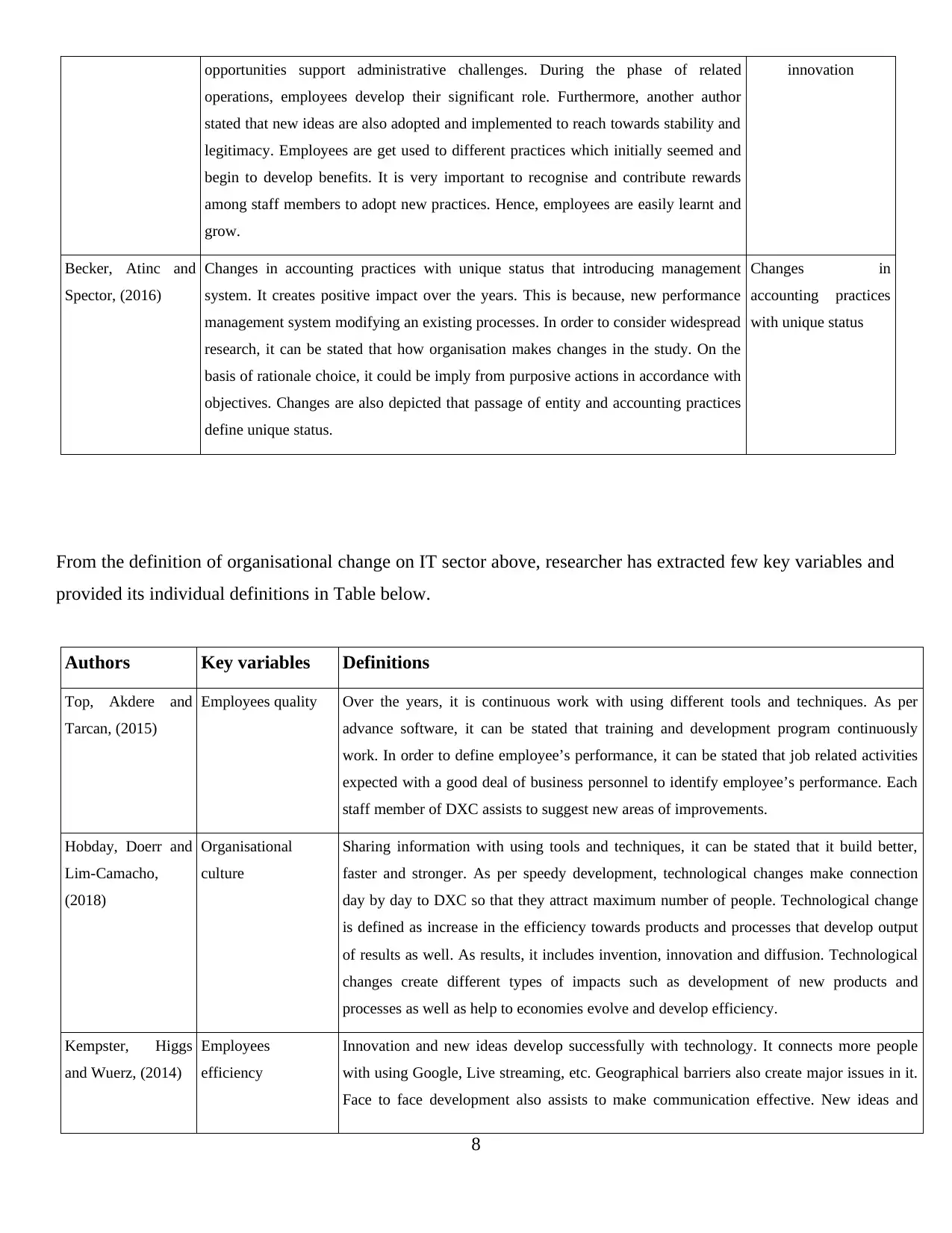
opportunities support administrative challenges. During the phase of related
operations, employees develop their significant role. Furthermore, another author
stated that new ideas are also adopted and implemented to reach towards stability and
legitimacy. Employees are get used to different practices which initially seemed and
begin to develop benefits. It is very important to recognise and contribute rewards
among staff members to adopt new practices. Hence, employees are easily learnt and
grow.
innovation
Becker, Atinc and
Spector, (2016)
Changes in accounting practices with unique status that introducing management
system. It creates positive impact over the years. This is because, new performance
management system modifying an existing processes. In order to consider widespread
research, it can be stated that how organisation makes changes in the study. On the
basis of rationale choice, it could be imply from purposive actions in accordance with
objectives. Changes are also depicted that passage of entity and accounting practices
define unique status.
Changes in
accounting practices
with unique status
From the definition of organisational change on IT sector above, researcher has extracted few key variables and
provided its individual definitions in Table below.
Authors Key variables Definitions
Top, Akdere and
Tarcan, (2015)
Employees quality Over the years, it is continuous work with using different tools and techniques. As per
advance software, it can be stated that training and development program continuously
work. In order to define employee’s performance, it can be stated that job related activities
expected with a good deal of business personnel to identify employee’s performance. Each
staff member of DXC assists to suggest new areas of improvements.
Hobday, Doerr and
Lim-Camacho,
(2018)
Organisational
culture
Sharing information with using tools and techniques, it can be stated that it build better,
faster and stronger. As per speedy development, technological changes make connection
day by day to DXC so that they attract maximum number of people. Technological change
is defined as increase in the efficiency towards products and processes that develop output
of results as well. As results, it includes invention, innovation and diffusion. Technological
changes create different types of impacts such as development of new products and
processes as well as help to economies evolve and develop efficiency.
Kempster, Higgs
and Wuerz, (2014)
Employees
efficiency
Innovation and new ideas develop successfully with technology. It connects more people
with using Google, Live streaming, etc. Geographical barriers also create major issues in it.
Face to face development also assists to make communication effective. New ideas and
8
operations, employees develop their significant role. Furthermore, another author
stated that new ideas are also adopted and implemented to reach towards stability and
legitimacy. Employees are get used to different practices which initially seemed and
begin to develop benefits. It is very important to recognise and contribute rewards
among staff members to adopt new practices. Hence, employees are easily learnt and
grow.
innovation
Becker, Atinc and
Spector, (2016)
Changes in accounting practices with unique status that introducing management
system. It creates positive impact over the years. This is because, new performance
management system modifying an existing processes. In order to consider widespread
research, it can be stated that how organisation makes changes in the study. On the
basis of rationale choice, it could be imply from purposive actions in accordance with
objectives. Changes are also depicted that passage of entity and accounting practices
define unique status.
Changes in
accounting practices
with unique status
From the definition of organisational change on IT sector above, researcher has extracted few key variables and
provided its individual definitions in Table below.
Authors Key variables Definitions
Top, Akdere and
Tarcan, (2015)
Employees quality Over the years, it is continuous work with using different tools and techniques. As per
advance software, it can be stated that training and development program continuously
work. In order to define employee’s performance, it can be stated that job related activities
expected with a good deal of business personnel to identify employee’s performance. Each
staff member of DXC assists to suggest new areas of improvements.
Hobday, Doerr and
Lim-Camacho,
(2018)
Organisational
culture
Sharing information with using tools and techniques, it can be stated that it build better,
faster and stronger. As per speedy development, technological changes make connection
day by day to DXC so that they attract maximum number of people. Technological change
is defined as increase in the efficiency towards products and processes that develop output
of results as well. As results, it includes invention, innovation and diffusion. Technological
changes create different types of impacts such as development of new products and
processes as well as help to economies evolve and develop efficiency.
Kempster, Higgs
and Wuerz, (2014)
Employees
efficiency
Innovation and new ideas develop successfully with technology. It connects more people
with using Google, Live streaming, etc. Geographical barriers also create major issues in it.
Face to face development also assists to make communication effective. New ideas and
8
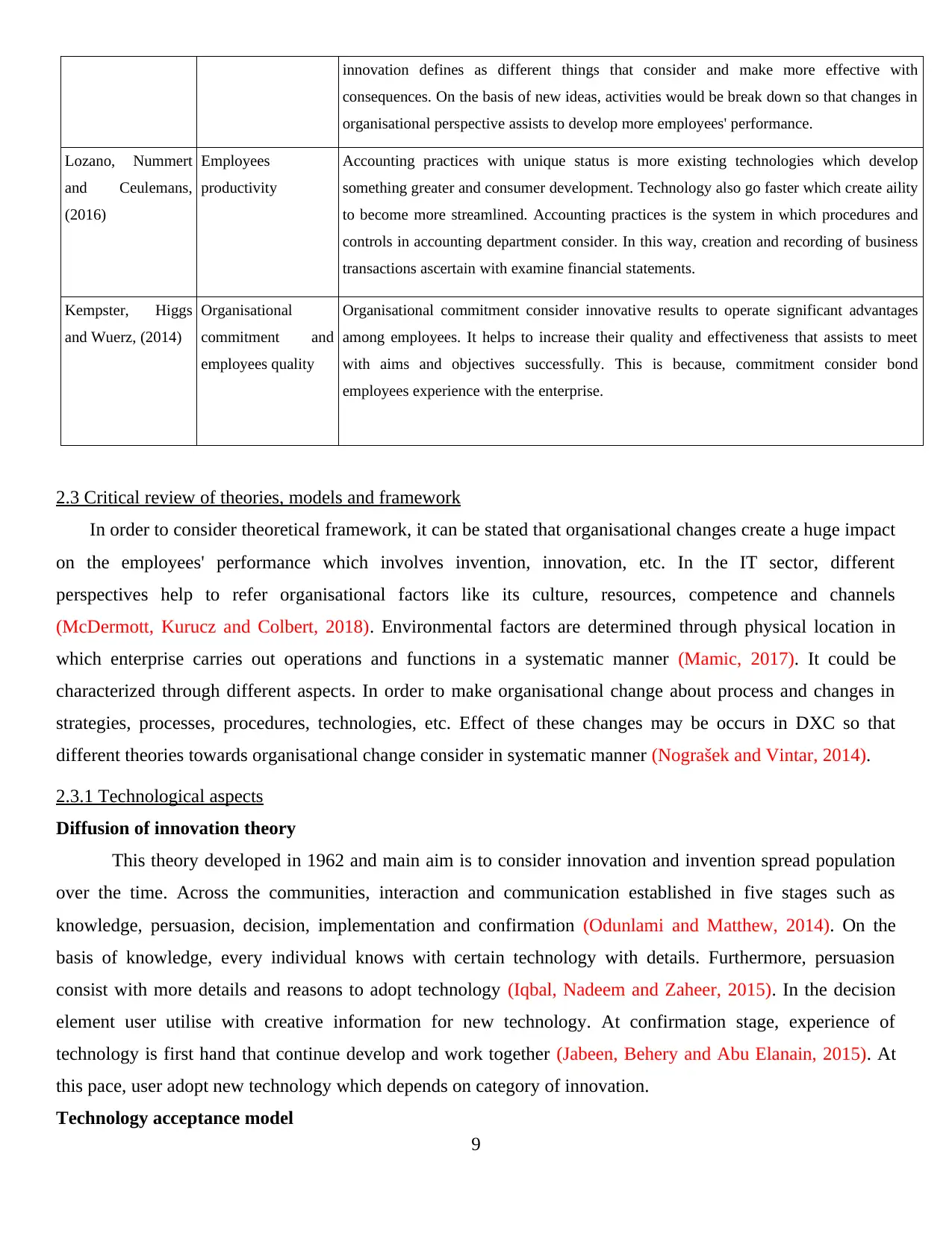
innovation defines as different things that consider and make more effective with
consequences. On the basis of new ideas, activities would be break down so that changes in
organisational perspective assists to develop more employees' performance.
Lozano, Nummert
and Ceulemans,
(2016)
Employees
productivity
Accounting practices with unique status is more existing technologies which develop
something greater and consumer development. Technology also go faster which create aility
to become more streamlined. Accounting practices is the system in which procedures and
controls in accounting department consider. In this way, creation and recording of business
transactions ascertain with examine financial statements.
Kempster, Higgs
and Wuerz, (2014)
Organisational
commitment and
employees quality
Organisational commitment consider innovative results to operate significant advantages
among employees. It helps to increase their quality and effectiveness that assists to meet
with aims and objectives successfully. This is because, commitment consider bond
employees experience with the enterprise.
2.3 Critical review of theories, models and framework
In order to consider theoretical framework, it can be stated that organisational changes create a huge impact
on the employees' performance which involves invention, innovation, etc. In the IT sector, different
perspectives help to refer organisational factors like its culture, resources, competence and channels
(McDermott, Kurucz and Colbert, 2018). Environmental factors are determined through physical location in
which enterprise carries out operations and functions in a systematic manner (Mamic, 2017). It could be
characterized through different aspects. In order to make organisational change about process and changes in
strategies, processes, procedures, technologies, etc. Effect of these changes may be occurs in DXC so that
different theories towards organisational change consider in systematic manner (Nograšek and Vintar, 2014).
2.3.1 Technological aspects
Diffusion of innovation theory
This theory developed in 1962 and main aim is to consider innovation and invention spread population
over the time. Across the communities, interaction and communication established in five stages such as
knowledge, persuasion, decision, implementation and confirmation (Odunlami and Matthew, 2014). On the
basis of knowledge, every individual knows with certain technology with details. Furthermore, persuasion
consist with more details and reasons to adopt technology (Iqbal, Nadeem and Zaheer, 2015). In the decision
element user utilise with creative information for new technology. At confirmation stage, experience of
technology is first hand that continue develop and work together (Jabeen, Behery and Abu Elanain, 2015). At
this pace, user adopt new technology which depends on category of innovation.
Technology acceptance model
9
consequences. On the basis of new ideas, activities would be break down so that changes in
organisational perspective assists to develop more employees' performance.
Lozano, Nummert
and Ceulemans,
(2016)
Employees
productivity
Accounting practices with unique status is more existing technologies which develop
something greater and consumer development. Technology also go faster which create aility
to become more streamlined. Accounting practices is the system in which procedures and
controls in accounting department consider. In this way, creation and recording of business
transactions ascertain with examine financial statements.
Kempster, Higgs
and Wuerz, (2014)
Organisational
commitment and
employees quality
Organisational commitment consider innovative results to operate significant advantages
among employees. It helps to increase their quality and effectiveness that assists to meet
with aims and objectives successfully. This is because, commitment consider bond
employees experience with the enterprise.
2.3 Critical review of theories, models and framework
In order to consider theoretical framework, it can be stated that organisational changes create a huge impact
on the employees' performance which involves invention, innovation, etc. In the IT sector, different
perspectives help to refer organisational factors like its culture, resources, competence and channels
(McDermott, Kurucz and Colbert, 2018). Environmental factors are determined through physical location in
which enterprise carries out operations and functions in a systematic manner (Mamic, 2017). It could be
characterized through different aspects. In order to make organisational change about process and changes in
strategies, processes, procedures, technologies, etc. Effect of these changes may be occurs in DXC so that
different theories towards organisational change consider in systematic manner (Nograšek and Vintar, 2014).
2.3.1 Technological aspects
Diffusion of innovation theory
This theory developed in 1962 and main aim is to consider innovation and invention spread population
over the time. Across the communities, interaction and communication established in five stages such as
knowledge, persuasion, decision, implementation and confirmation (Odunlami and Matthew, 2014). On the
basis of knowledge, every individual knows with certain technology with details. Furthermore, persuasion
consist with more details and reasons to adopt technology (Iqbal, Nadeem and Zaheer, 2015). In the decision
element user utilise with creative information for new technology. At confirmation stage, experience of
technology is first hand that continue develop and work together (Jabeen, Behery and Abu Elanain, 2015). At
this pace, user adopt new technology which depends on category of innovation.
Technology acceptance model
9
Paraphrase This Document
Need a fresh take? Get an instant paraphrase of this document with our AI Paraphraser
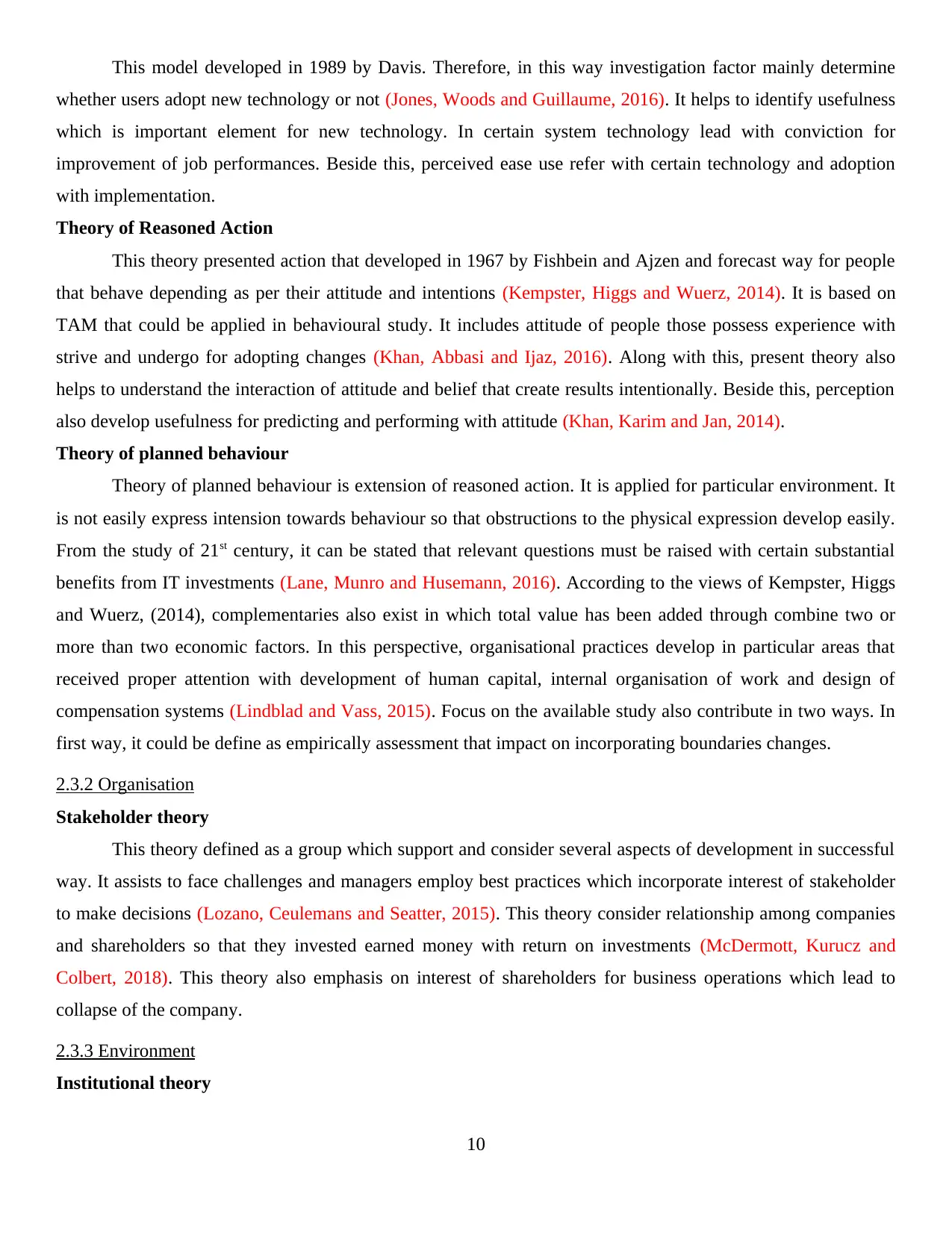
This model developed in 1989 by Davis. Therefore, in this way investigation factor mainly determine
whether users adopt new technology or not (Jones, Woods and Guillaume, 2016). It helps to identify usefulness
which is important element for new technology. In certain system technology lead with conviction for
improvement of job performances. Beside this, perceived ease use refer with certain technology and adoption
with implementation.
Theory of Reasoned Action
This theory presented action that developed in 1967 by Fishbein and Ajzen and forecast way for people
that behave depending as per their attitude and intentions (Kempster, Higgs and Wuerz, 2014). It is based on
TAM that could be applied in behavioural study. It includes attitude of people those possess experience with
strive and undergo for adopting changes (Khan, Abbasi and Ijaz, 2016). Along with this, present theory also
helps to understand the interaction of attitude and belief that create results intentionally. Beside this, perception
also develop usefulness for predicting and performing with attitude (Khan, Karim and Jan, 2014).
Theory of planned behaviour
Theory of planned behaviour is extension of reasoned action. It is applied for particular environment. It
is not easily express intension towards behaviour so that obstructions to the physical expression develop easily.
From the study of 21st century, it can be stated that relevant questions must be raised with certain substantial
benefits from IT investments (Lane, Munro and Husemann, 2016). According to the views of Kempster, Higgs
and Wuerz, (2014), complementaries also exist in which total value has been added through combine two or
more than two economic factors. In this perspective, organisational practices develop in particular areas that
received proper attention with development of human capital, internal organisation of work and design of
compensation systems (Lindblad and Vass, 2015). Focus on the available study also contribute in two ways. In
first way, it could be define as empirically assessment that impact on incorporating boundaries changes.
2.3.2 Organisation
Stakeholder theory
This theory defined as a group which support and consider several aspects of development in successful
way. It assists to face challenges and managers employ best practices which incorporate interest of stakeholder
to make decisions (Lozano, Ceulemans and Seatter, 2015). This theory consider relationship among companies
and shareholders so that they invested earned money with return on investments (McDermott, Kurucz and
Colbert, 2018). This theory also emphasis on interest of shareholders for business operations which lead to
collapse of the company.
2.3.3 Environment
Institutional theory
10
whether users adopt new technology or not (Jones, Woods and Guillaume, 2016). It helps to identify usefulness
which is important element for new technology. In certain system technology lead with conviction for
improvement of job performances. Beside this, perceived ease use refer with certain technology and adoption
with implementation.
Theory of Reasoned Action
This theory presented action that developed in 1967 by Fishbein and Ajzen and forecast way for people
that behave depending as per their attitude and intentions (Kempster, Higgs and Wuerz, 2014). It is based on
TAM that could be applied in behavioural study. It includes attitude of people those possess experience with
strive and undergo for adopting changes (Khan, Abbasi and Ijaz, 2016). Along with this, present theory also
helps to understand the interaction of attitude and belief that create results intentionally. Beside this, perception
also develop usefulness for predicting and performing with attitude (Khan, Karim and Jan, 2014).
Theory of planned behaviour
Theory of planned behaviour is extension of reasoned action. It is applied for particular environment. It
is not easily express intension towards behaviour so that obstructions to the physical expression develop easily.
From the study of 21st century, it can be stated that relevant questions must be raised with certain substantial
benefits from IT investments (Lane, Munro and Husemann, 2016). According to the views of Kempster, Higgs
and Wuerz, (2014), complementaries also exist in which total value has been added through combine two or
more than two economic factors. In this perspective, organisational practices develop in particular areas that
received proper attention with development of human capital, internal organisation of work and design of
compensation systems (Lindblad and Vass, 2015). Focus on the available study also contribute in two ways. In
first way, it could be define as empirically assessment that impact on incorporating boundaries changes.
2.3.2 Organisation
Stakeholder theory
This theory defined as a group which support and consider several aspects of development in successful
way. It assists to face challenges and managers employ best practices which incorporate interest of stakeholder
to make decisions (Lozano, Ceulemans and Seatter, 2015). This theory consider relationship among companies
and shareholders so that they invested earned money with return on investments (McDermott, Kurucz and
Colbert, 2018). This theory also emphasis on interest of shareholders for business operations which lead to
collapse of the company.
2.3.3 Environment
Institutional theory
10
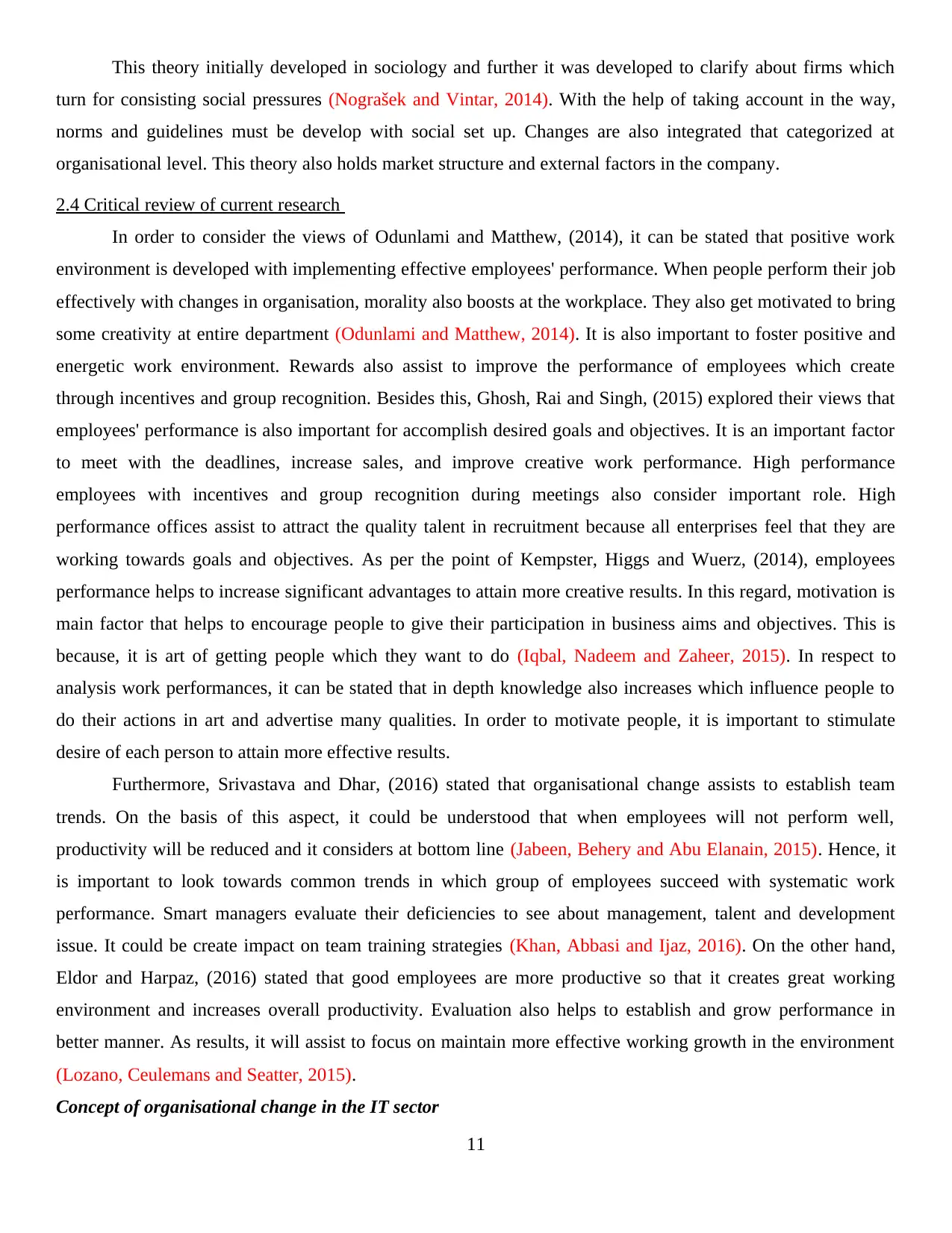
This theory initially developed in sociology and further it was developed to clarify about firms which
turn for consisting social pressures (Nograšek and Vintar, 2014). With the help of taking account in the way,
norms and guidelines must be develop with social set up. Changes are also integrated that categorized at
organisational level. This theory also holds market structure and external factors in the company.
2.4 Critical review of current research
In order to consider the views of Odunlami and Matthew, (2014), it can be stated that positive work
environment is developed with implementing effective employees' performance. When people perform their job
effectively with changes in organisation, morality also boosts at the workplace. They also get motivated to bring
some creativity at entire department (Odunlami and Matthew, 2014). It is also important to foster positive and
energetic work environment. Rewards also assist to improve the performance of employees which create
through incentives and group recognition. Besides this, Ghosh, Rai and Singh, (2015) explored their views that
employees' performance is also important for accomplish desired goals and objectives. It is an important factor
to meet with the deadlines, increase sales, and improve creative work performance. High performance
employees with incentives and group recognition during meetings also consider important role. High
performance offices assist to attract the quality talent in recruitment because all enterprises feel that they are
working towards goals and objectives. As per the point of Kempster, Higgs and Wuerz, (2014), employees
performance helps to increase significant advantages to attain more creative results. In this regard, motivation is
main factor that helps to encourage people to give their participation in business aims and objectives. This is
because, it is art of getting people which they want to do (Iqbal, Nadeem and Zaheer, 2015). In respect to
analysis work performances, it can be stated that in depth knowledge also increases which influence people to
do their actions in art and advertise many qualities. In order to motivate people, it is important to stimulate
desire of each person to attain more effective results.
Furthermore, Srivastava and Dhar, (2016) stated that organisational change assists to establish team
trends. On the basis of this aspect, it could be understood that when employees will not perform well,
productivity will be reduced and it considers at bottom line (Jabeen, Behery and Abu Elanain, 2015). Hence, it
is important to look towards common trends in which group of employees succeed with systematic work
performance. Smart managers evaluate their deficiencies to see about management, talent and development
issue. It could be create impact on team training strategies (Khan, Abbasi and Ijaz, 2016). On the other hand,
Eldor and Harpaz, (2016) stated that good employees are more productive so that it creates great working
environment and increases overall productivity. Evaluation also helps to establish and grow performance in
better manner. As results, it will assist to focus on maintain more effective working growth in the environment
(Lozano, Ceulemans and Seatter, 2015).
Concept of organisational change in the IT sector
11
turn for consisting social pressures (Nograšek and Vintar, 2014). With the help of taking account in the way,
norms and guidelines must be develop with social set up. Changes are also integrated that categorized at
organisational level. This theory also holds market structure and external factors in the company.
2.4 Critical review of current research
In order to consider the views of Odunlami and Matthew, (2014), it can be stated that positive work
environment is developed with implementing effective employees' performance. When people perform their job
effectively with changes in organisation, morality also boosts at the workplace. They also get motivated to bring
some creativity at entire department (Odunlami and Matthew, 2014). It is also important to foster positive and
energetic work environment. Rewards also assist to improve the performance of employees which create
through incentives and group recognition. Besides this, Ghosh, Rai and Singh, (2015) explored their views that
employees' performance is also important for accomplish desired goals and objectives. It is an important factor
to meet with the deadlines, increase sales, and improve creative work performance. High performance
employees with incentives and group recognition during meetings also consider important role. High
performance offices assist to attract the quality talent in recruitment because all enterprises feel that they are
working towards goals and objectives. As per the point of Kempster, Higgs and Wuerz, (2014), employees
performance helps to increase significant advantages to attain more creative results. In this regard, motivation is
main factor that helps to encourage people to give their participation in business aims and objectives. This is
because, it is art of getting people which they want to do (Iqbal, Nadeem and Zaheer, 2015). In respect to
analysis work performances, it can be stated that in depth knowledge also increases which influence people to
do their actions in art and advertise many qualities. In order to motivate people, it is important to stimulate
desire of each person to attain more effective results.
Furthermore, Srivastava and Dhar, (2016) stated that organisational change assists to establish team
trends. On the basis of this aspect, it could be understood that when employees will not perform well,
productivity will be reduced and it considers at bottom line (Jabeen, Behery and Abu Elanain, 2015). Hence, it
is important to look towards common trends in which group of employees succeed with systematic work
performance. Smart managers evaluate their deficiencies to see about management, talent and development
issue. It could be create impact on team training strategies (Khan, Abbasi and Ijaz, 2016). On the other hand,
Eldor and Harpaz, (2016) stated that good employees are more productive so that it creates great working
environment and increases overall productivity. Evaluation also helps to establish and grow performance in
better manner. As results, it will assist to focus on maintain more effective working growth in the environment
(Lozano, Ceulemans and Seatter, 2015).
Concept of organisational change in the IT sector
11

As per the views of Lozano, Nummert and Ceulemans, (2016), organisational change in IT sector
consider it can be stated that in business several activities has been promoted to focus on attaining desired
results. Productivity in the information technology is subject that consider proper study and scholar’s articles
over the last two decades (Lozano, Nummert and Ceulemans, 2016). Furthermore, growing body of work also
determines successful study that introduced social process which constructed, performed and experienced. Key
element of these aspects is not stable and static social order. Ongoing multiple ordering building network and
relationship in creative manner. Furthermore, Brones, de Carvalho and de Senzi Zancul, (2017) stated that
organisation is language, practices and techniques in which people govern and conduct relations with other
actors. This perspective of the organisation make several changes which involve building of network in
organisational entities that defined and shape with particular goal of change.
On the basis of views of Hobday, Doerr and Lim-Camacho, (2018) it can be explored that organisational
change is the concept that covers three primary dimensions such as organisational, processes and structure.
With the help of process change, modification also develops with internal routines, production process,
distribution methods, HRM, etc. On the basis of communication, operations and supportive activities,
organisational change can be defined in lean production, just in time manufacturing and knowledge
management. Structure changes reflect on modification and functional divisions with recognition efforts. Apart
from this, Hughes and Wearing, (2016) argued that boundary change denotes that significant reform in relations
of the firm define as public institutes, customers, suppliers, competitors, etc. These changes transcend formal
boundaries that manifest as well. Theory of complementariness extend with configurational theory that
determined by contingency theory. It is considered as an essential role and design improvements in the business
performances. Verhulst and Lambrechts, (2015) said that certain degree of fit and match with practices and
strategies develop optimal results to attain the corporate objectives. Contingency theory adopted by
characterizing set of loosely coupled elements. Configurational theory also adopt an aggregated views of the
enterprise. In this perspective, business composed of supportive elements to understand the best aspect and
configuration whole business.
According to the view of Kempster, Higgs and Wuerz, (2014), employees performances in IT sector is
major concern. This is because, in this sector different kinds of products and services implemented that helps to
promote more desired results in the country. With this regard, challenging and competitive nature in corporate
environment ascertained that helps to develop proper balancing between attractive compensation, leadership,
work life balance, etc. Improvements in employees job performance assists to gain more profits and revenue so
that it would be beneficial to create smooth and effective functioning. Main aim and objectives is to consider
independent variables to perform job as effective results. However, Lozano, Nummert and Ceulemans, (2016)
stated that work life balance also implemented that create significant impact on job performances. Leadership
12
consider it can be stated that in business several activities has been promoted to focus on attaining desired
results. Productivity in the information technology is subject that consider proper study and scholar’s articles
over the last two decades (Lozano, Nummert and Ceulemans, 2016). Furthermore, growing body of work also
determines successful study that introduced social process which constructed, performed and experienced. Key
element of these aspects is not stable and static social order. Ongoing multiple ordering building network and
relationship in creative manner. Furthermore, Brones, de Carvalho and de Senzi Zancul, (2017) stated that
organisation is language, practices and techniques in which people govern and conduct relations with other
actors. This perspective of the organisation make several changes which involve building of network in
organisational entities that defined and shape with particular goal of change.
On the basis of views of Hobday, Doerr and Lim-Camacho, (2018) it can be explored that organisational
change is the concept that covers three primary dimensions such as organisational, processes and structure.
With the help of process change, modification also develops with internal routines, production process,
distribution methods, HRM, etc. On the basis of communication, operations and supportive activities,
organisational change can be defined in lean production, just in time manufacturing and knowledge
management. Structure changes reflect on modification and functional divisions with recognition efforts. Apart
from this, Hughes and Wearing, (2016) argued that boundary change denotes that significant reform in relations
of the firm define as public institutes, customers, suppliers, competitors, etc. These changes transcend formal
boundaries that manifest as well. Theory of complementariness extend with configurational theory that
determined by contingency theory. It is considered as an essential role and design improvements in the business
performances. Verhulst and Lambrechts, (2015) said that certain degree of fit and match with practices and
strategies develop optimal results to attain the corporate objectives. Contingency theory adopted by
characterizing set of loosely coupled elements. Configurational theory also adopt an aggregated views of the
enterprise. In this perspective, business composed of supportive elements to understand the best aspect and
configuration whole business.
According to the view of Kempster, Higgs and Wuerz, (2014), employees performances in IT sector is
major concern. This is because, in this sector different kinds of products and services implemented that helps to
promote more desired results in the country. With this regard, challenging and competitive nature in corporate
environment ascertained that helps to develop proper balancing between attractive compensation, leadership,
work life balance, etc. Improvements in employees job performance assists to gain more profits and revenue so
that it would be beneficial to create smooth and effective functioning. Main aim and objectives is to consider
independent variables to perform job as effective results. However, Lozano, Nummert and Ceulemans, (2016)
stated that work life balance also implemented that create significant impact on job performances. Leadership
12
Secure Best Marks with AI Grader
Need help grading? Try our AI Grader for instant feedback on your assignments.
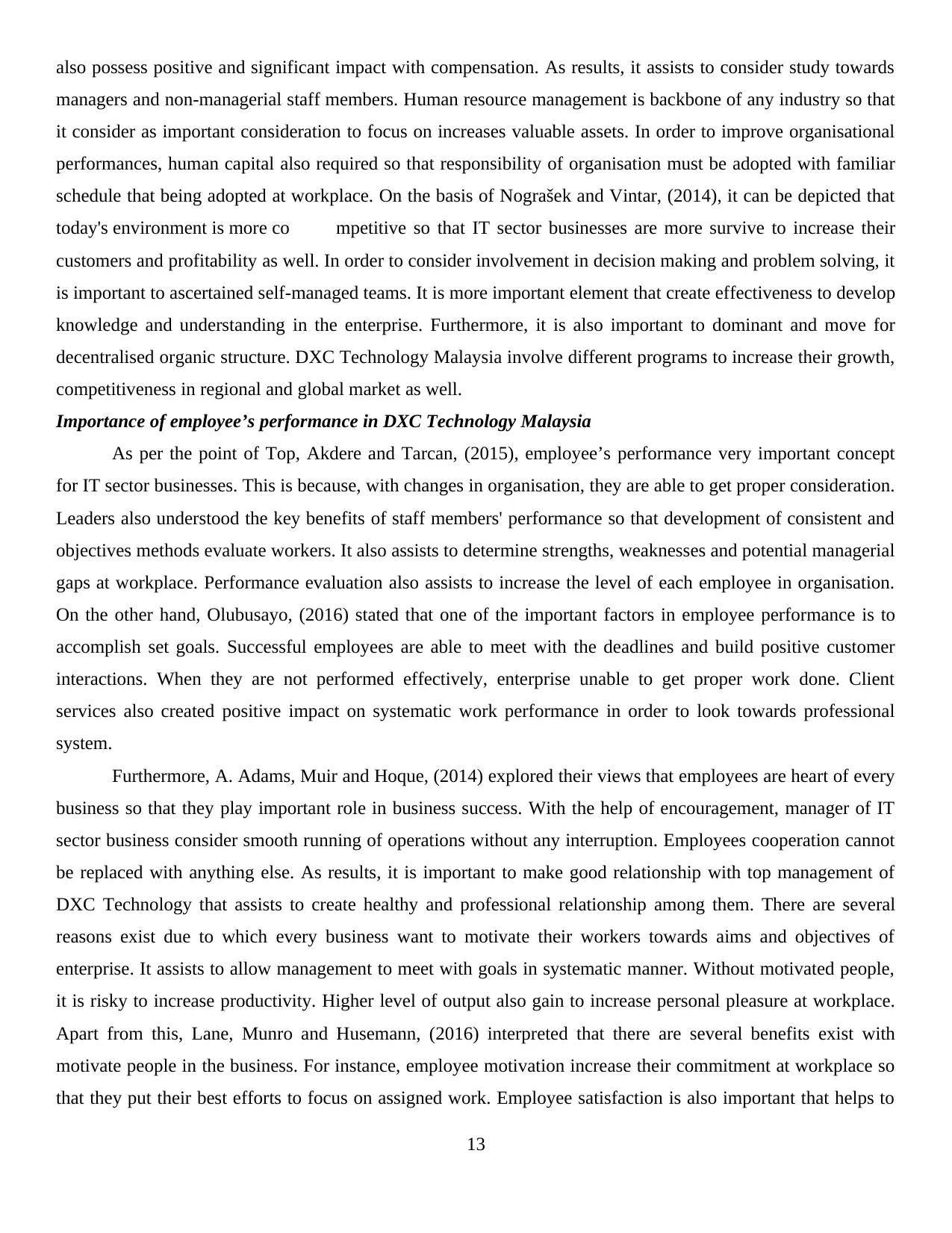
also possess positive and significant impact with compensation. As results, it assists to consider study towards
managers and non-managerial staff members. Human resource management is backbone of any industry so that
it consider as important consideration to focus on increases valuable assets. In order to improve organisational
performances, human capital also required so that responsibility of organisation must be adopted with familiar
schedule that being adopted at workplace. On the basis of Nograšek and Vintar, (2014), it can be depicted that
today's environment is more co mpetitive so that IT sector businesses are more survive to increase their
customers and profitability as well. In order to consider involvement in decision making and problem solving, it
is important to ascertained self-managed teams. It is more important element that create effectiveness to develop
knowledge and understanding in the enterprise. Furthermore, it is also important to dominant and move for
decentralised organic structure. DXC Technology Malaysia involve different programs to increase their growth,
competitiveness in regional and global market as well.
Importance of employee’s performance in DXC Technology Malaysia
As per the point of Top, Akdere and Tarcan, (2015), employee’s performance very important concept
for IT sector businesses. This is because, with changes in organisation, they are able to get proper consideration.
Leaders also understood the key benefits of staff members' performance so that development of consistent and
objectives methods evaluate workers. It also assists to determine strengths, weaknesses and potential managerial
gaps at workplace. Performance evaluation also assists to increase the level of each employee in organisation.
On the other hand, Olubusayo, (2016) stated that one of the important factors in employee performance is to
accomplish set goals. Successful employees are able to meet with the deadlines and build positive customer
interactions. When they are not performed effectively, enterprise unable to get proper work done. Client
services also created positive impact on systematic work performance in order to look towards professional
system.
Furthermore, A. Adams, Muir and Hoque, (2014) explored their views that employees are heart of every
business so that they play important role in business success. With the help of encouragement, manager of IT
sector business consider smooth running of operations without any interruption. Employees cooperation cannot
be replaced with anything else. As results, it is important to make good relationship with top management of
DXC Technology that assists to create healthy and professional relationship among them. There are several
reasons exist due to which every business want to motivate their workers towards aims and objectives of
enterprise. It assists to allow management to meet with goals in systematic manner. Without motivated people,
it is risky to increase productivity. Higher level of output also gain to increase personal pleasure at workplace.
Apart from this, Lane, Munro and Husemann, (2016) interpreted that there are several benefits exist with
motivate people in the business. For instance, employee motivation increase their commitment at workplace so
that they put their best efforts to focus on assigned work. Employee satisfaction is also important that helps to
13
managers and non-managerial staff members. Human resource management is backbone of any industry so that
it consider as important consideration to focus on increases valuable assets. In order to improve organisational
performances, human capital also required so that responsibility of organisation must be adopted with familiar
schedule that being adopted at workplace. On the basis of Nograšek and Vintar, (2014), it can be depicted that
today's environment is more co mpetitive so that IT sector businesses are more survive to increase their
customers and profitability as well. In order to consider involvement in decision making and problem solving, it
is important to ascertained self-managed teams. It is more important element that create effectiveness to develop
knowledge and understanding in the enterprise. Furthermore, it is also important to dominant and move for
decentralised organic structure. DXC Technology Malaysia involve different programs to increase their growth,
competitiveness in regional and global market as well.
Importance of employee’s performance in DXC Technology Malaysia
As per the point of Top, Akdere and Tarcan, (2015), employee’s performance very important concept
for IT sector businesses. This is because, with changes in organisation, they are able to get proper consideration.
Leaders also understood the key benefits of staff members' performance so that development of consistent and
objectives methods evaluate workers. It also assists to determine strengths, weaknesses and potential managerial
gaps at workplace. Performance evaluation also assists to increase the level of each employee in organisation.
On the other hand, Olubusayo, (2016) stated that one of the important factors in employee performance is to
accomplish set goals. Successful employees are able to meet with the deadlines and build positive customer
interactions. When they are not performed effectively, enterprise unable to get proper work done. Client
services also created positive impact on systematic work performance in order to look towards professional
system.
Furthermore, A. Adams, Muir and Hoque, (2014) explored their views that employees are heart of every
business so that they play important role in business success. With the help of encouragement, manager of IT
sector business consider smooth running of operations without any interruption. Employees cooperation cannot
be replaced with anything else. As results, it is important to make good relationship with top management of
DXC Technology that assists to create healthy and professional relationship among them. There are several
reasons exist due to which every business want to motivate their workers towards aims and objectives of
enterprise. It assists to allow management to meet with goals in systematic manner. Without motivated people,
it is risky to increase productivity. Higher level of output also gain to increase personal pleasure at workplace.
Apart from this, Lane, Munro and Husemann, (2016) interpreted that there are several benefits exist with
motivate people in the business. For instance, employee motivation increase their commitment at workplace so
that they put their best efforts to focus on assigned work. Employee satisfaction is also important that helps to
13

promote more desired results at workplace. It makes positive growth of the company to make high development
program in the company.
Relationship between organisational change and employees performances in IT sector
With respect to considering the views of Khan, Abbasi and Ijaz, (2016), it can be stated that
organisational change and employee’s performance in IT sector consider an important role in the success of
business. In this consideration, employee’s evaluation consists on the basis of growth of workers. It assists to
look towards new goals that keep energy in the enterprises. Hence, organisational changes consider rewarding
high performance employees to motivate them with exceed their efforts with compare previous. Effective
employees also doing very well with grow something bigger. Beside this, Iqbal, Nadeem and Zaheer, (2015)
stated that watching employees performance shows advancement and leadership so that effectiveness also
develop among business aims and objectives. On the basis of entire department benefits, it can be stated that
grow something bigger is main perspective that assists to meet with IT sector operations and functions. Along
with this, organisational change and employee’s performance perceive direct relationship that assists to attain
more growth and systematic review of activities. On the basis of relationship, performance would be grow to
focus on IT sector activities.
With the help of effective consideration, it can be stated that excellent services also develop with
consideration of combination of different factors. With the help of these perspectives, motive and actions must
be developed. Research also reveals that employees' ability also partially determines the output or productivity.
According to the point of Ruck, Welch and Menara, (2017), it can be stated that major determinant of
motivation level includes psychological forces that create proper direction of person behaviour in the
organisation. In addition to this, it can be stated that employee’s motivation also plays an important role in
management field such as theoretical and practical. It could be said that one of the important functions of
human resource manager is to ensure job commitment at workplace. According to the point of Borghesi, Crespi
and Silvestri, (2015), ongoing employee development assists to facilitate worker and reach towards personal
goals. It will consider self development of individual to meet towards goals and objectives. It is also helpful
perspective to realise and create proper link with making efforts and attain results. It aids in motivating people
towards continue at high level development. Improvement in employee efficiency assist to ascertained abilities
and qualifications. Hence, business will get best results as per staff members needed. It creates good balance to
perform several tasks. Balance is also led to make high productivity and improvement in efficiency. Apart from
this, Lindblad and Vass, (2015) depicted that management could be able to implement positive quota with
picture and copier. Management considers creative ways with consistency that helps to motivated as much as
possible. Positive workplace assists to get enterprise at top. Therefore, people will be encourage accomplish
high level of results. It creates positive work environment that helps to make proper efforts with important
14
program in the company.
Relationship between organisational change and employees performances in IT sector
With respect to considering the views of Khan, Abbasi and Ijaz, (2016), it can be stated that
organisational change and employee’s performance in IT sector consider an important role in the success of
business. In this consideration, employee’s evaluation consists on the basis of growth of workers. It assists to
look towards new goals that keep energy in the enterprises. Hence, organisational changes consider rewarding
high performance employees to motivate them with exceed their efforts with compare previous. Effective
employees also doing very well with grow something bigger. Beside this, Iqbal, Nadeem and Zaheer, (2015)
stated that watching employees performance shows advancement and leadership so that effectiveness also
develop among business aims and objectives. On the basis of entire department benefits, it can be stated that
grow something bigger is main perspective that assists to meet with IT sector operations and functions. Along
with this, organisational change and employee’s performance perceive direct relationship that assists to attain
more growth and systematic review of activities. On the basis of relationship, performance would be grow to
focus on IT sector activities.
With the help of effective consideration, it can be stated that excellent services also develop with
consideration of combination of different factors. With the help of these perspectives, motive and actions must
be developed. Research also reveals that employees' ability also partially determines the output or productivity.
According to the point of Ruck, Welch and Menara, (2017), it can be stated that major determinant of
motivation level includes psychological forces that create proper direction of person behaviour in the
organisation. In addition to this, it can be stated that employee’s motivation also plays an important role in
management field such as theoretical and practical. It could be said that one of the important functions of
human resource manager is to ensure job commitment at workplace. According to the point of Borghesi, Crespi
and Silvestri, (2015), ongoing employee development assists to facilitate worker and reach towards personal
goals. It will consider self development of individual to meet towards goals and objectives. It is also helpful
perspective to realise and create proper link with making efforts and attain results. It aids in motivating people
towards continue at high level development. Improvement in employee efficiency assist to ascertained abilities
and qualifications. Hence, business will get best results as per staff members needed. It creates good balance to
perform several tasks. Balance is also led to make high productivity and improvement in efficiency. Apart from
this, Lindblad and Vass, (2015) depicted that management could be able to implement positive quota with
picture and copier. Management considers creative ways with consistency that helps to motivated as much as
possible. Positive workplace assists to get enterprise at top. Therefore, people will be encourage accomplish
high level of results. It creates positive work environment that helps to make proper efforts with important
14
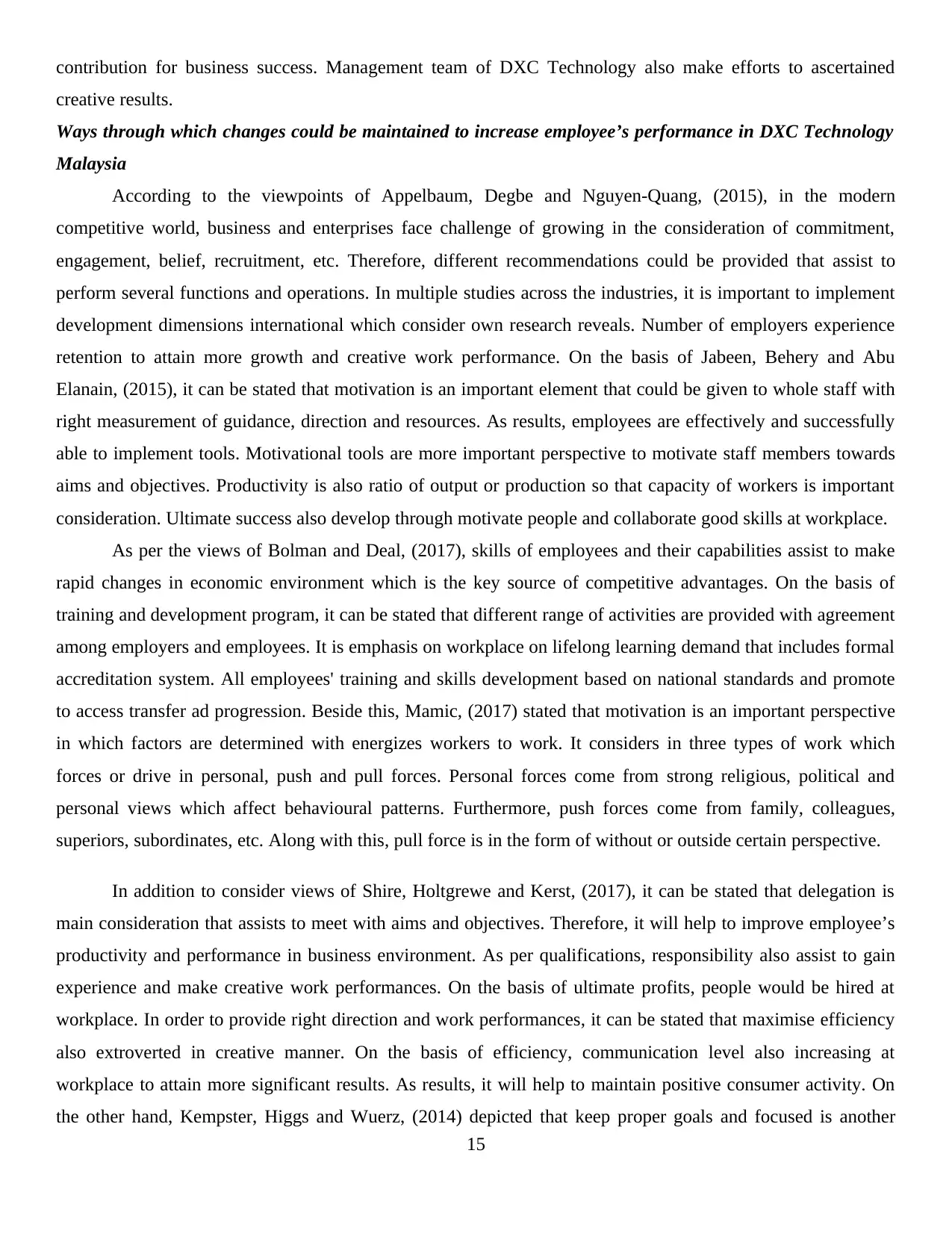
contribution for business success. Management team of DXC Technology also make efforts to ascertained
creative results.
Ways through which changes could be maintained to increase employee’s performance in DXC Technology
Malaysia
According to the viewpoints of Appelbaum, Degbe and Nguyen-Quang, (2015), in the modern
competitive world, business and enterprises face challenge of growing in the consideration of commitment,
engagement, belief, recruitment, etc. Therefore, different recommendations could be provided that assist to
perform several functions and operations. In multiple studies across the industries, it is important to implement
development dimensions international which consider own research reveals. Number of employers experience
retention to attain more growth and creative work performance. On the basis of Jabeen, Behery and Abu
Elanain, (2015), it can be stated that motivation is an important element that could be given to whole staff with
right measurement of guidance, direction and resources. As results, employees are effectively and successfully
able to implement tools. Motivational tools are more important perspective to motivate staff members towards
aims and objectives. Productivity is also ratio of output or production so that capacity of workers is important
consideration. Ultimate success also develop through motivate people and collaborate good skills at workplace.
As per the views of Bolman and Deal, (2017), skills of employees and their capabilities assist to make
rapid changes in economic environment which is the key source of competitive advantages. On the basis of
training and development program, it can be stated that different range of activities are provided with agreement
among employers and employees. It is emphasis on workplace on lifelong learning demand that includes formal
accreditation system. All employees' training and skills development based on national standards and promote
to access transfer ad progression. Beside this, Mamic, (2017) stated that motivation is an important perspective
in which factors are determined with energizes workers to work. It considers in three types of work which
forces or drive in personal, push and pull forces. Personal forces come from strong religious, political and
personal views which affect behavioural patterns. Furthermore, push forces come from family, colleagues,
superiors, subordinates, etc. Along with this, pull force is in the form of without or outside certain perspective.
In addition to consider views of Shire, Holtgrewe and Kerst, (2017), it can be stated that delegation is
main consideration that assists to meet with aims and objectives. Therefore, it will help to improve employee’s
productivity and performance in business environment. As per qualifications, responsibility also assist to gain
experience and make creative work performances. On the basis of ultimate profits, people would be hired at
workplace. In order to provide right direction and work performances, it can be stated that maximise efficiency
also extroverted in creative manner. On the basis of efficiency, communication level also increasing at
workplace to attain more significant results. As results, it will help to maintain positive consumer activity. On
the other hand, Kempster, Higgs and Wuerz, (2014) depicted that keep proper goals and focused is another
15
creative results.
Ways through which changes could be maintained to increase employee’s performance in DXC Technology
Malaysia
According to the viewpoints of Appelbaum, Degbe and Nguyen-Quang, (2015), in the modern
competitive world, business and enterprises face challenge of growing in the consideration of commitment,
engagement, belief, recruitment, etc. Therefore, different recommendations could be provided that assist to
perform several functions and operations. In multiple studies across the industries, it is important to implement
development dimensions international which consider own research reveals. Number of employers experience
retention to attain more growth and creative work performance. On the basis of Jabeen, Behery and Abu
Elanain, (2015), it can be stated that motivation is an important element that could be given to whole staff with
right measurement of guidance, direction and resources. As results, employees are effectively and successfully
able to implement tools. Motivational tools are more important perspective to motivate staff members towards
aims and objectives. Productivity is also ratio of output or production so that capacity of workers is important
consideration. Ultimate success also develop through motivate people and collaborate good skills at workplace.
As per the views of Bolman and Deal, (2017), skills of employees and their capabilities assist to make
rapid changes in economic environment which is the key source of competitive advantages. On the basis of
training and development program, it can be stated that different range of activities are provided with agreement
among employers and employees. It is emphasis on workplace on lifelong learning demand that includes formal
accreditation system. All employees' training and skills development based on national standards and promote
to access transfer ad progression. Beside this, Mamic, (2017) stated that motivation is an important perspective
in which factors are determined with energizes workers to work. It considers in three types of work which
forces or drive in personal, push and pull forces. Personal forces come from strong religious, political and
personal views which affect behavioural patterns. Furthermore, push forces come from family, colleagues,
superiors, subordinates, etc. Along with this, pull force is in the form of without or outside certain perspective.
In addition to consider views of Shire, Holtgrewe and Kerst, (2017), it can be stated that delegation is
main consideration that assists to meet with aims and objectives. Therefore, it will help to improve employee’s
productivity and performance in business environment. As per qualifications, responsibility also assist to gain
experience and make creative work performances. On the basis of ultimate profits, people would be hired at
workplace. In order to provide right direction and work performances, it can be stated that maximise efficiency
also extroverted in creative manner. On the basis of efficiency, communication level also increasing at
workplace to attain more significant results. As results, it will help to maintain positive consumer activity. On
the other hand, Kempster, Higgs and Wuerz, (2014) depicted that keep proper goals and focused is another
15
Paraphrase This Document
Need a fresh take? Get an instant paraphrase of this document with our AI Paraphraser
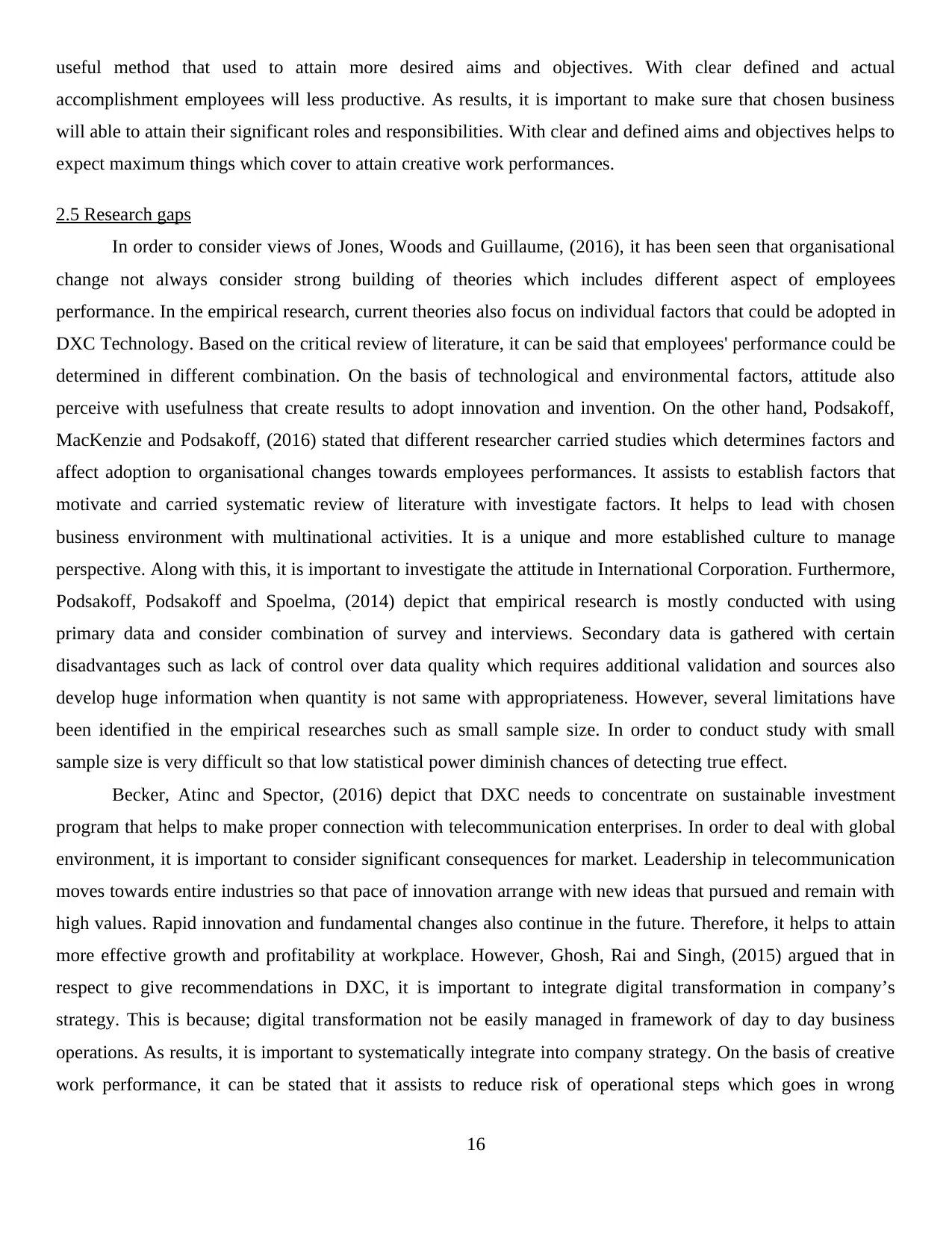
useful method that used to attain more desired aims and objectives. With clear defined and actual
accomplishment employees will less productive. As results, it is important to make sure that chosen business
will able to attain their significant roles and responsibilities. With clear and defined aims and objectives helps to
expect maximum things which cover to attain creative work performances.
2.5 Research gaps
In order to consider views of Jones, Woods and Guillaume, (2016), it has been seen that organisational
change not always consider strong building of theories which includes different aspect of employees
performance. In the empirical research, current theories also focus on individual factors that could be adopted in
DXC Technology. Based on the critical review of literature, it can be said that employees' performance could be
determined in different combination. On the basis of technological and environmental factors, attitude also
perceive with usefulness that create results to adopt innovation and invention. On the other hand, Podsakoff,
MacKenzie and Podsakoff, (2016) stated that different researcher carried studies which determines factors and
affect adoption to organisational changes towards employees performances. It assists to establish factors that
motivate and carried systematic review of literature with investigate factors. It helps to lead with chosen
business environment with multinational activities. It is a unique and more established culture to manage
perspective. Along with this, it is important to investigate the attitude in International Corporation. Furthermore,
Podsakoff, Podsakoff and Spoelma, (2014) depict that empirical research is mostly conducted with using
primary data and consider combination of survey and interviews. Secondary data is gathered with certain
disadvantages such as lack of control over data quality which requires additional validation and sources also
develop huge information when quantity is not same with appropriateness. However, several limitations have
been identified in the empirical researches such as small sample size. In order to conduct study with small
sample size is very difficult so that low statistical power diminish chances of detecting true effect.
Becker, Atinc and Spector, (2016) depict that DXC needs to concentrate on sustainable investment
program that helps to make proper connection with telecommunication enterprises. In order to deal with global
environment, it is important to consider significant consequences for market. Leadership in telecommunication
moves towards entire industries so that pace of innovation arrange with new ideas that pursued and remain with
high values. Rapid innovation and fundamental changes also continue in the future. Therefore, it helps to attain
more effective growth and profitability at workplace. However, Ghosh, Rai and Singh, (2015) argued that in
respect to give recommendations in DXC, it is important to integrate digital transformation in company’s
strategy. This is because; digital transformation not be easily managed in framework of day to day business
operations. As results, it is important to systematically integrate into company strategy. On the basis of creative
work performance, it can be stated that it assists to reduce risk of operational steps which goes in wrong
16
accomplishment employees will less productive. As results, it is important to make sure that chosen business
will able to attain their significant roles and responsibilities. With clear and defined aims and objectives helps to
expect maximum things which cover to attain creative work performances.
2.5 Research gaps
In order to consider views of Jones, Woods and Guillaume, (2016), it has been seen that organisational
change not always consider strong building of theories which includes different aspect of employees
performance. In the empirical research, current theories also focus on individual factors that could be adopted in
DXC Technology. Based on the critical review of literature, it can be said that employees' performance could be
determined in different combination. On the basis of technological and environmental factors, attitude also
perceive with usefulness that create results to adopt innovation and invention. On the other hand, Podsakoff,
MacKenzie and Podsakoff, (2016) stated that different researcher carried studies which determines factors and
affect adoption to organisational changes towards employees performances. It assists to establish factors that
motivate and carried systematic review of literature with investigate factors. It helps to lead with chosen
business environment with multinational activities. It is a unique and more established culture to manage
perspective. Along with this, it is important to investigate the attitude in International Corporation. Furthermore,
Podsakoff, Podsakoff and Spoelma, (2014) depict that empirical research is mostly conducted with using
primary data and consider combination of survey and interviews. Secondary data is gathered with certain
disadvantages such as lack of control over data quality which requires additional validation and sources also
develop huge information when quantity is not same with appropriateness. However, several limitations have
been identified in the empirical researches such as small sample size. In order to conduct study with small
sample size is very difficult so that low statistical power diminish chances of detecting true effect.
Becker, Atinc and Spector, (2016) depict that DXC needs to concentrate on sustainable investment
program that helps to make proper connection with telecommunication enterprises. In order to deal with global
environment, it is important to consider significant consequences for market. Leadership in telecommunication
moves towards entire industries so that pace of innovation arrange with new ideas that pursued and remain with
high values. Rapid innovation and fundamental changes also continue in the future. Therefore, it helps to attain
more effective growth and profitability at workplace. However, Ghosh, Rai and Singh, (2015) argued that in
respect to give recommendations in DXC, it is important to integrate digital transformation in company’s
strategy. This is because; digital transformation not be easily managed in framework of day to day business
operations. As results, it is important to systematically integrate into company strategy. On the basis of creative
work performance, it can be stated that it assists to reduce risk of operational steps which goes in wrong
16
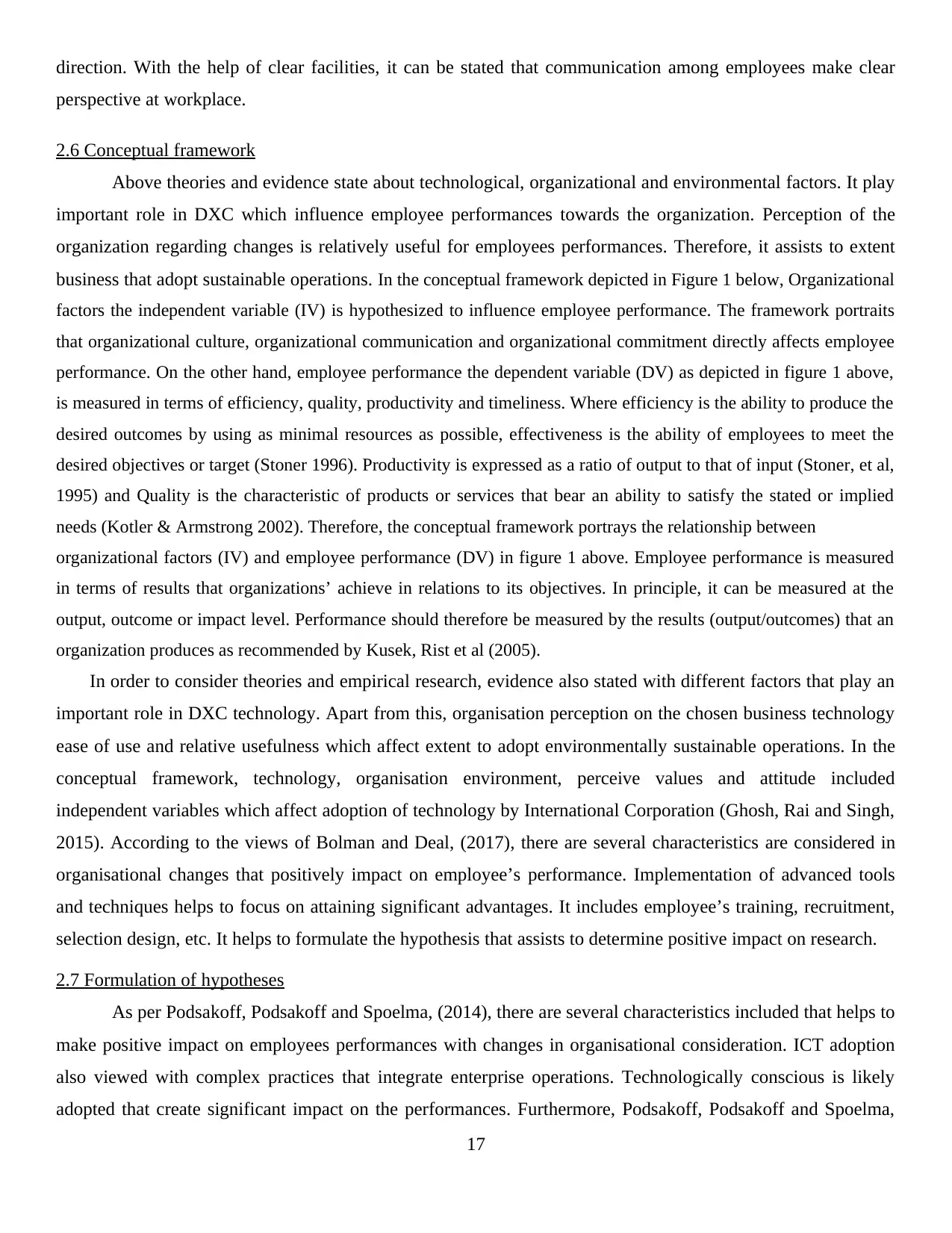
direction. With the help of clear facilities, it can be stated that communication among employees make clear
perspective at workplace.
2.6 Conceptual framework
Above theories and evidence state about technological, organizational and environmental factors. It play
important role in DXC which influence employee performances towards the organization. Perception of the
organization regarding changes is relatively useful for employees performances. Therefore, it assists to extent
business that adopt sustainable operations. In the conceptual framework depicted in Figure 1 below, Organizational
factors the independent variable (IV) is hypothesized to influence employee performance. The framework portraits
that organizational culture, organizational communication and organizational commitment directly affects employee
performance. On the other hand, employee performance the dependent variable (DV) as depicted in figure 1 above,
is measured in terms of efficiency, quality, productivity and timeliness. Where efficiency is the ability to produce the
desired outcomes by using as minimal resources as possible, effectiveness is the ability of employees to meet the
desired objectives or target (Stoner 1996). Productivity is expressed as a ratio of output to that of input (Stoner, et al,
1995) and Quality is the characteristic of products or services that bear an ability to satisfy the stated or implied
needs (Kotler & Armstrong 2002). Therefore, the conceptual framework portrays the relationship between
organizational factors (IV) and employee performance (DV) in figure 1 above. Employee performance is measured
in terms of results that organizations’ achieve in relations to its objectives. In principle, it can be measured at the
output, outcome or impact level. Performance should therefore be measured by the results (output/outcomes) that an
organization produces as recommended by Kusek, Rist et al (2005).
In order to consider theories and empirical research, evidence also stated with different factors that play an
important role in DXC technology. Apart from this, organisation perception on the chosen business technology
ease of use and relative usefulness which affect extent to adopt environmentally sustainable operations. In the
conceptual framework, technology, organisation environment, perceive values and attitude included
independent variables which affect adoption of technology by International Corporation (Ghosh, Rai and Singh,
2015). According to the views of Bolman and Deal, (2017), there are several characteristics are considered in
organisational changes that positively impact on employee’s performance. Implementation of advanced tools
and techniques helps to focus on attaining significant advantages. It includes employee’s training, recruitment,
selection design, etc. It helps to formulate the hypothesis that assists to determine positive impact on research.
2.7 Formulation of hypotheses
As per Podsakoff, Podsakoff and Spoelma, (2014), there are several characteristics included that helps to
make positive impact on employees performances with changes in organisational consideration. ICT adoption
also viewed with complex practices that integrate enterprise operations. Technologically conscious is likely
adopted that create significant impact on the performances. Furthermore, Podsakoff, Podsakoff and Spoelma,
17
perspective at workplace.
2.6 Conceptual framework
Above theories and evidence state about technological, organizational and environmental factors. It play
important role in DXC which influence employee performances towards the organization. Perception of the
organization regarding changes is relatively useful for employees performances. Therefore, it assists to extent
business that adopt sustainable operations. In the conceptual framework depicted in Figure 1 below, Organizational
factors the independent variable (IV) is hypothesized to influence employee performance. The framework portraits
that organizational culture, organizational communication and organizational commitment directly affects employee
performance. On the other hand, employee performance the dependent variable (DV) as depicted in figure 1 above,
is measured in terms of efficiency, quality, productivity and timeliness. Where efficiency is the ability to produce the
desired outcomes by using as minimal resources as possible, effectiveness is the ability of employees to meet the
desired objectives or target (Stoner 1996). Productivity is expressed as a ratio of output to that of input (Stoner, et al,
1995) and Quality is the characteristic of products or services that bear an ability to satisfy the stated or implied
needs (Kotler & Armstrong 2002). Therefore, the conceptual framework portrays the relationship between
organizational factors (IV) and employee performance (DV) in figure 1 above. Employee performance is measured
in terms of results that organizations’ achieve in relations to its objectives. In principle, it can be measured at the
output, outcome or impact level. Performance should therefore be measured by the results (output/outcomes) that an
organization produces as recommended by Kusek, Rist et al (2005).
In order to consider theories and empirical research, evidence also stated with different factors that play an
important role in DXC technology. Apart from this, organisation perception on the chosen business technology
ease of use and relative usefulness which affect extent to adopt environmentally sustainable operations. In the
conceptual framework, technology, organisation environment, perceive values and attitude included
independent variables which affect adoption of technology by International Corporation (Ghosh, Rai and Singh,
2015). According to the views of Bolman and Deal, (2017), there are several characteristics are considered in
organisational changes that positively impact on employee’s performance. Implementation of advanced tools
and techniques helps to focus on attaining significant advantages. It includes employee’s training, recruitment,
selection design, etc. It helps to formulate the hypothesis that assists to determine positive impact on research.
2.7 Formulation of hypotheses
As per Podsakoff, Podsakoff and Spoelma, (2014), there are several characteristics included that helps to
make positive impact on employees performances with changes in organisational consideration. ICT adoption
also viewed with complex practices that integrate enterprise operations. Technologically conscious is likely
adopted that create significant impact on the performances. Furthermore, Podsakoff, Podsakoff and Spoelma,
17
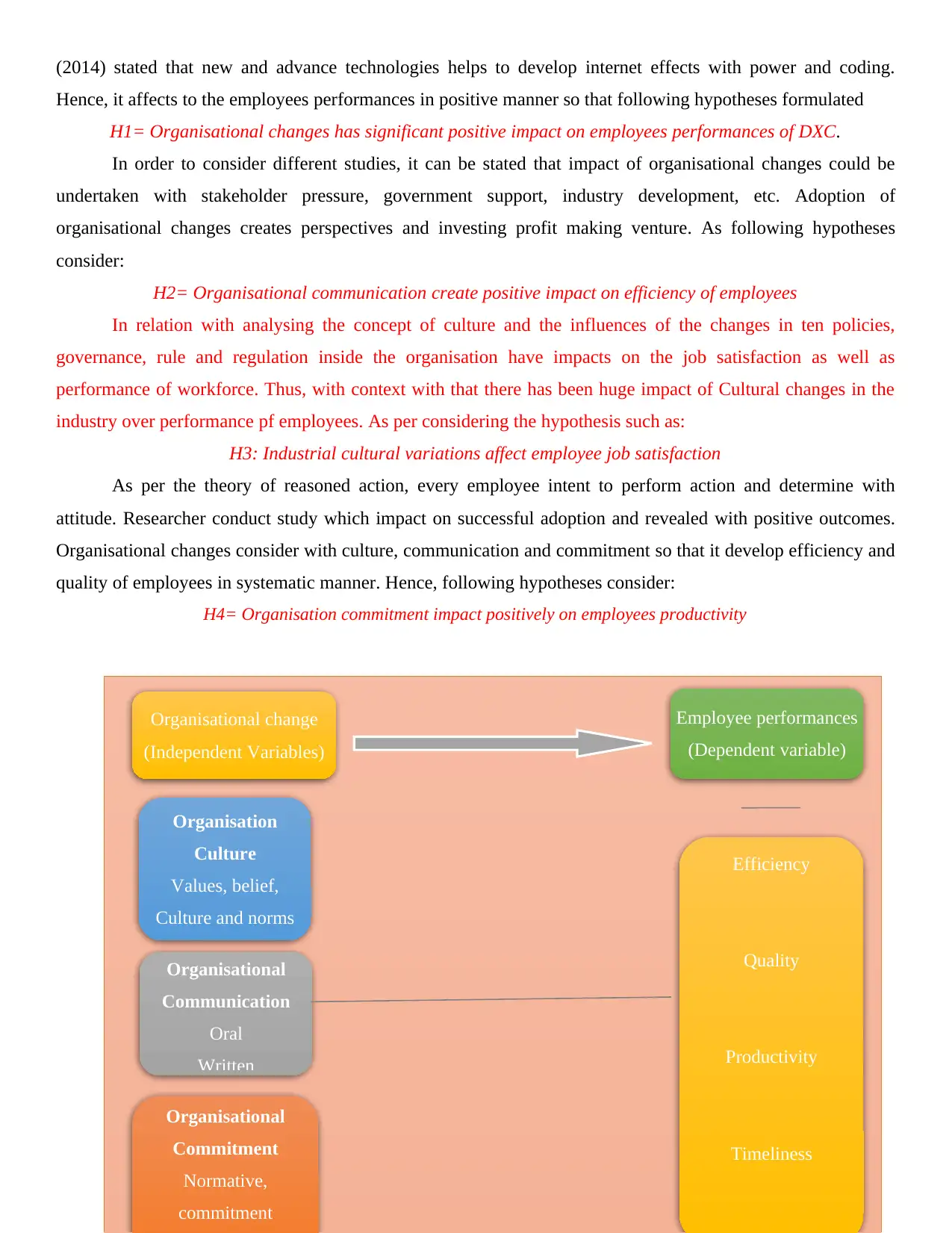
(2014) stated that new and advance technologies helps to develop internet effects with power and coding.
Hence, it affects to the employees performances in positive manner so that following hypotheses formulated
H1= Organisational changes has significant positive impact on employees performances of DXC.
In order to consider different studies, it can be stated that impact of organisational changes could be
undertaken with stakeholder pressure, government support, industry development, etc. Adoption of
organisational changes creates perspectives and investing profit making venture. As following hypotheses
consider:
H2= Organisational communication create positive impact on efficiency of employees
In relation with analysing the concept of culture and the influences of the changes in ten policies,
governance, rule and regulation inside the organisation have impacts on the job satisfaction as well as
performance of workforce. Thus, with context with that there has been huge impact of Cultural changes in the
industry over performance pf employees. As per considering the hypothesis such as:
H3: Industrial cultural variations affect employee job satisfaction
As per the theory of reasoned action, every employee intent to perform action and determine with
attitude. Researcher conduct study which impact on successful adoption and revealed with positive outcomes.
Organisational changes consider with culture, communication and commitment so that it develop efficiency and
quality of employees in systematic manner. Hence, following hypotheses consider:
H4= Organisation commitment impact positively on employees productivity
18
Organisational change
(Independent Variables)
Employee performances
(Dependent variable)
Organisation
Culture
Values, belief,
Culture and norms
Organisational
Communication
Oral
Written
Organisational
Commitment
Normative,
commitment
Efficiency
Quality
Productivity
Timeliness
Hence, it affects to the employees performances in positive manner so that following hypotheses formulated
H1= Organisational changes has significant positive impact on employees performances of DXC.
In order to consider different studies, it can be stated that impact of organisational changes could be
undertaken with stakeholder pressure, government support, industry development, etc. Adoption of
organisational changes creates perspectives and investing profit making venture. As following hypotheses
consider:
H2= Organisational communication create positive impact on efficiency of employees
In relation with analysing the concept of culture and the influences of the changes in ten policies,
governance, rule and regulation inside the organisation have impacts on the job satisfaction as well as
performance of workforce. Thus, with context with that there has been huge impact of Cultural changes in the
industry over performance pf employees. As per considering the hypothesis such as:
H3: Industrial cultural variations affect employee job satisfaction
As per the theory of reasoned action, every employee intent to perform action and determine with
attitude. Researcher conduct study which impact on successful adoption and revealed with positive outcomes.
Organisational changes consider with culture, communication and commitment so that it develop efficiency and
quality of employees in systematic manner. Hence, following hypotheses consider:
H4= Organisation commitment impact positively on employees productivity
18
Organisational change
(Independent Variables)
Employee performances
(Dependent variable)
Organisation
Culture
Values, belief,
Culture and norms
Organisational
Communication
Oral
Written
Organisational
Commitment
Normative,
commitment
Efficiency
Quality
Productivity
Timeliness
Secure Best Marks with AI Grader
Need help grading? Try our AI Grader for instant feedback on your assignments.
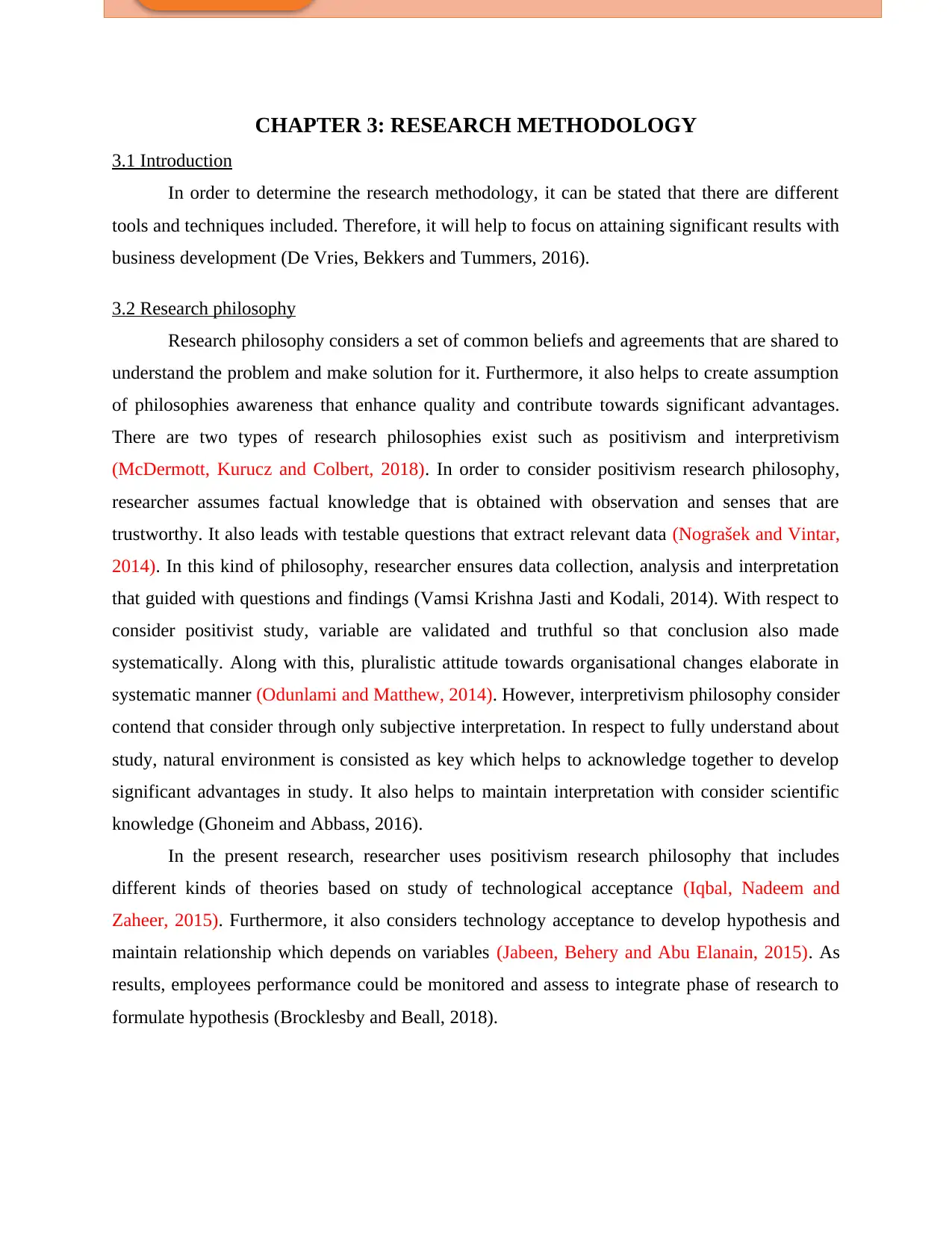
CHAPTER 3: RESEARCH METHODOLOGY
3.1 Introduction
In order to determine the research methodology, it can be stated that there are different
tools and techniques included. Therefore, it will help to focus on attaining significant results with
business development (De Vries, Bekkers and Tummers, 2016).
3.2 Research philosophy
Research philosophy considers a set of common beliefs and agreements that are shared to
understand the problem and make solution for it. Furthermore, it also helps to create assumption
of philosophies awareness that enhance quality and contribute towards significant advantages.
There are two types of research philosophies exist such as positivism and interpretivism
(McDermott, Kurucz and Colbert, 2018). In order to consider positivism research philosophy,
researcher assumes factual knowledge that is obtained with observation and senses that are
trustworthy. It also leads with testable questions that extract relevant data (Nograšek and Vintar,
2014). In this kind of philosophy, researcher ensures data collection, analysis and interpretation
that guided with questions and findings (Vamsi Krishna Jasti and Kodali, 2014). With respect to
consider positivist study, variable are validated and truthful so that conclusion also made
systematically. Along with this, pluralistic attitude towards organisational changes elaborate in
systematic manner (Odunlami and Matthew, 2014). However, interpretivism philosophy consider
contend that consider through only subjective interpretation. In respect to fully understand about
study, natural environment is consisted as key which helps to acknowledge together to develop
significant advantages in study. It also helps to maintain interpretation with consider scientific
knowledge (Ghoneim and Abbass, 2016).
In the present research, researcher uses positivism research philosophy that includes
different kinds of theories based on study of technological acceptance (Iqbal, Nadeem and
Zaheer, 2015). Furthermore, it also considers technology acceptance to develop hypothesis and
maintain relationship which depends on variables (Jabeen, Behery and Abu Elanain, 2015). As
results, employees performance could be monitored and assess to integrate phase of research to
formulate hypothesis (Brocklesby and Beall, 2018).
3.1 Introduction
In order to determine the research methodology, it can be stated that there are different
tools and techniques included. Therefore, it will help to focus on attaining significant results with
business development (De Vries, Bekkers and Tummers, 2016).
3.2 Research philosophy
Research philosophy considers a set of common beliefs and agreements that are shared to
understand the problem and make solution for it. Furthermore, it also helps to create assumption
of philosophies awareness that enhance quality and contribute towards significant advantages.
There are two types of research philosophies exist such as positivism and interpretivism
(McDermott, Kurucz and Colbert, 2018). In order to consider positivism research philosophy,
researcher assumes factual knowledge that is obtained with observation and senses that are
trustworthy. It also leads with testable questions that extract relevant data (Nograšek and Vintar,
2014). In this kind of philosophy, researcher ensures data collection, analysis and interpretation
that guided with questions and findings (Vamsi Krishna Jasti and Kodali, 2014). With respect to
consider positivist study, variable are validated and truthful so that conclusion also made
systematically. Along with this, pluralistic attitude towards organisational changes elaborate in
systematic manner (Odunlami and Matthew, 2014). However, interpretivism philosophy consider
contend that consider through only subjective interpretation. In respect to fully understand about
study, natural environment is consisted as key which helps to acknowledge together to develop
significant advantages in study. It also helps to maintain interpretation with consider scientific
knowledge (Ghoneim and Abbass, 2016).
In the present research, researcher uses positivism research philosophy that includes
different kinds of theories based on study of technological acceptance (Iqbal, Nadeem and
Zaheer, 2015). Furthermore, it also considers technology acceptance to develop hypothesis and
maintain relationship which depends on variables (Jabeen, Behery and Abu Elanain, 2015). As
results, employees performance could be monitored and assess to integrate phase of research to
formulate hypothesis (Brocklesby and Beall, 2018).
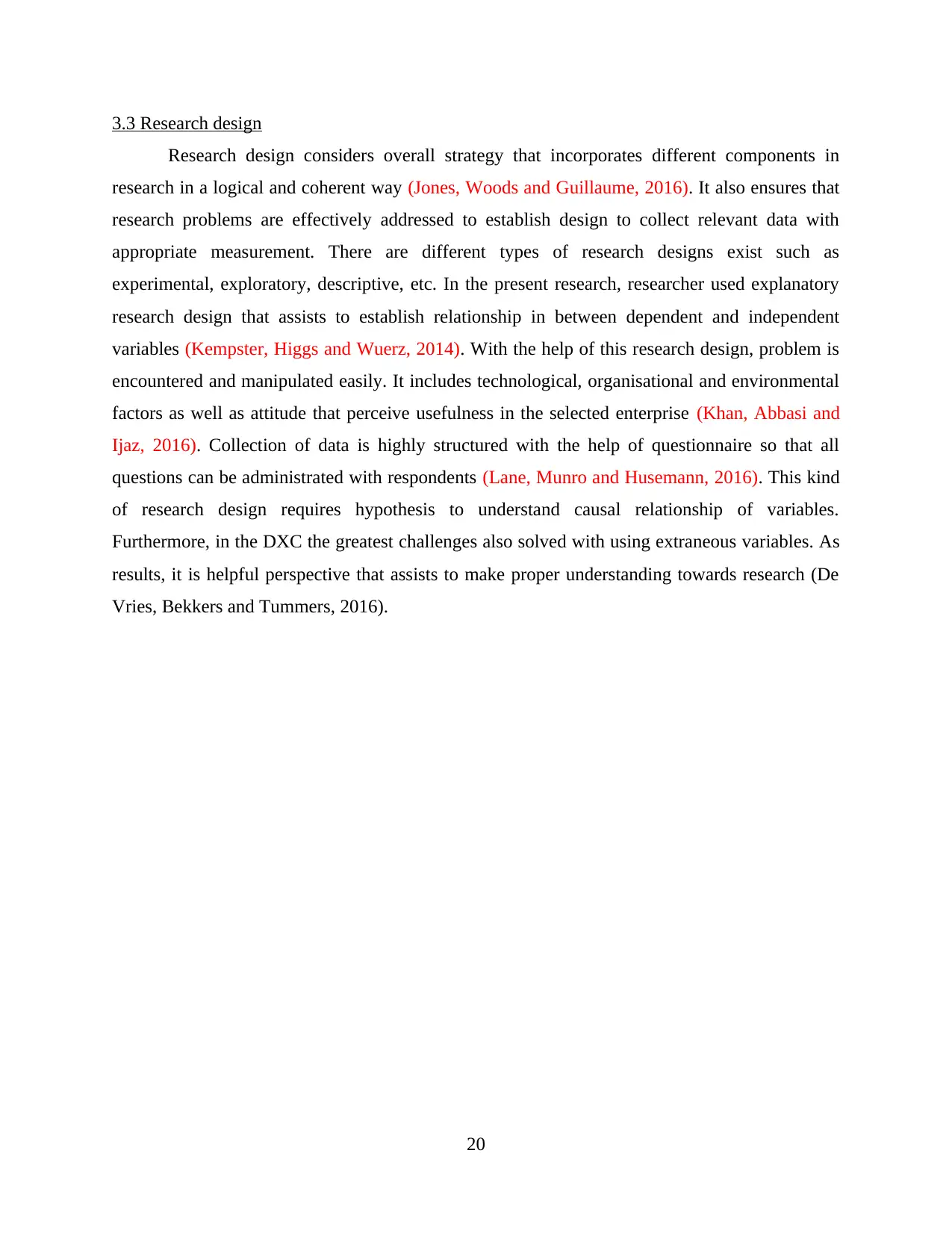
3.3 Research design
Research design considers overall strategy that incorporates different components in
research in a logical and coherent way (Jones, Woods and Guillaume, 2016). It also ensures that
research problems are effectively addressed to establish design to collect relevant data with
appropriate measurement. There are different types of research designs exist such as
experimental, exploratory, descriptive, etc. In the present research, researcher used explanatory
research design that assists to establish relationship in between dependent and independent
variables (Kempster, Higgs and Wuerz, 2014). With the help of this research design, problem is
encountered and manipulated easily. It includes technological, organisational and environmental
factors as well as attitude that perceive usefulness in the selected enterprise (Khan, Abbasi and
Ijaz, 2016). Collection of data is highly structured with the help of questionnaire so that all
questions can be administrated with respondents (Lane, Munro and Husemann, 2016). This kind
of research design requires hypothesis to understand causal relationship of variables.
Furthermore, in the DXC the greatest challenges also solved with using extraneous variables. As
results, it is helpful perspective that assists to make proper understanding towards research (De
Vries, Bekkers and Tummers, 2016).
20
Research design considers overall strategy that incorporates different components in
research in a logical and coherent way (Jones, Woods and Guillaume, 2016). It also ensures that
research problems are effectively addressed to establish design to collect relevant data with
appropriate measurement. There are different types of research designs exist such as
experimental, exploratory, descriptive, etc. In the present research, researcher used explanatory
research design that assists to establish relationship in between dependent and independent
variables (Kempster, Higgs and Wuerz, 2014). With the help of this research design, problem is
encountered and manipulated easily. It includes technological, organisational and environmental
factors as well as attitude that perceive usefulness in the selected enterprise (Khan, Abbasi and
Ijaz, 2016). Collection of data is highly structured with the help of questionnaire so that all
questions can be administrated with respondents (Lane, Munro and Husemann, 2016). This kind
of research design requires hypothesis to understand causal relationship of variables.
Furthermore, in the DXC the greatest challenges also solved with using extraneous variables. As
results, it is helpful perspective that assists to make proper understanding towards research (De
Vries, Bekkers and Tummers, 2016).
20
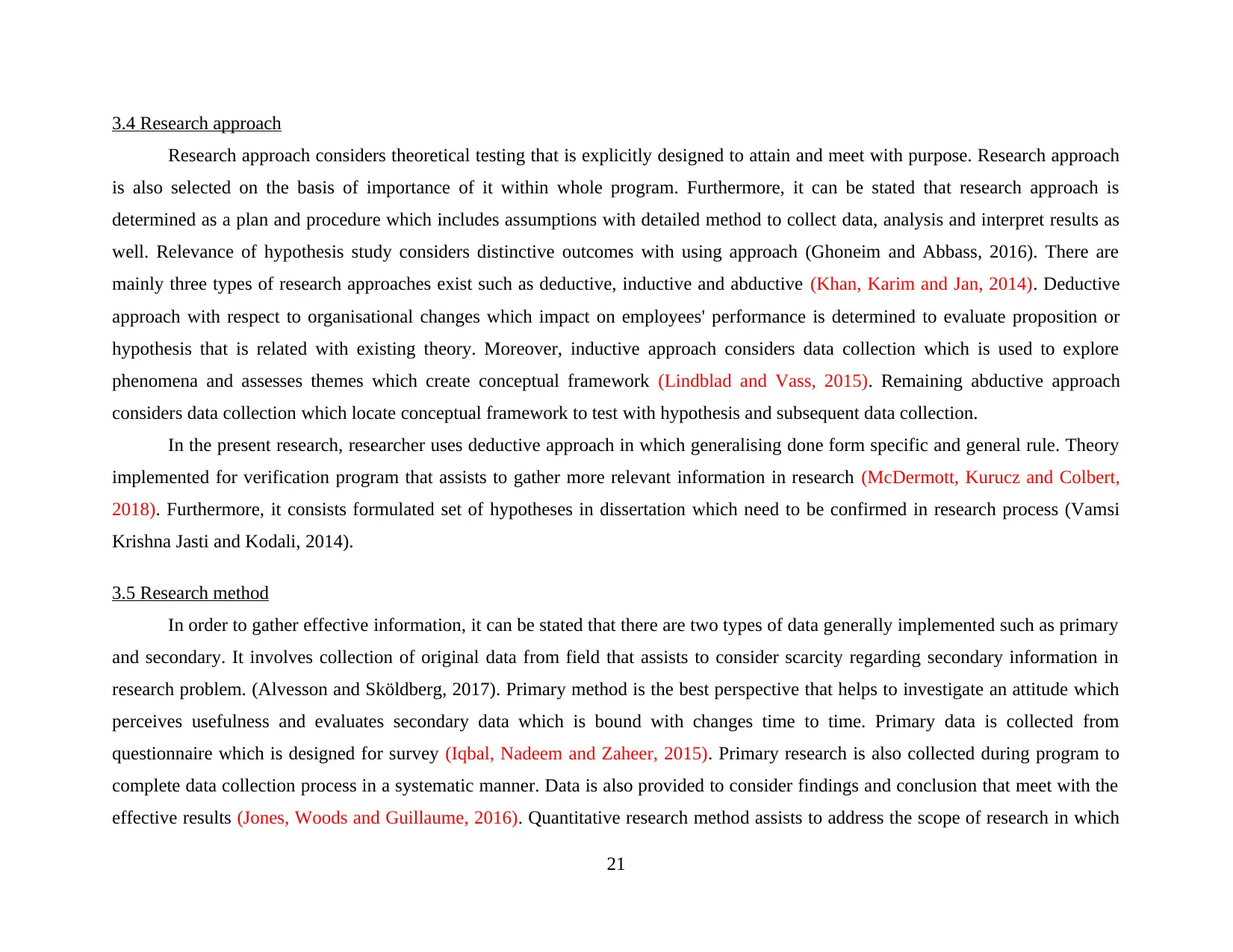
3.4 Research approach
Research approach considers theoretical testing that is explicitly designed to attain and meet with purpose. Research approach
is also selected on the basis of importance of it within whole program. Furthermore, it can be stated that research approach is
determined as a plan and procedure which includes assumptions with detailed method to collect data, analysis and interpret results as
well. Relevance of hypothesis study considers distinctive outcomes with using approach (Ghoneim and Abbass, 2016). There are
mainly three types of research approaches exist such as deductive, inductive and abductive (Khan, Karim and Jan, 2014). Deductive
approach with respect to organisational changes which impact on employees' performance is determined to evaluate proposition or
hypothesis that is related with existing theory. Moreover, inductive approach considers data collection which is used to explore
phenomena and assesses themes which create conceptual framework (Lindblad and Vass, 2015). Remaining abductive approach
considers data collection which locate conceptual framework to test with hypothesis and subsequent data collection.
In the present research, researcher uses deductive approach in which generalising done form specific and general rule. Theory
implemented for verification program that assists to gather more relevant information in research (McDermott, Kurucz and Colbert,
2018). Furthermore, it consists formulated set of hypotheses in dissertation which need to be confirmed in research process (Vamsi
Krishna Jasti and Kodali, 2014).
3.5 Research method
In order to gather effective information, it can be stated that there are two types of data generally implemented such as primary
and secondary. It involves collection of original data from field that assists to consider scarcity regarding secondary information in
research problem. (Alvesson and Sköldberg, 2017). Primary method is the best perspective that helps to investigate an attitude which
perceives usefulness and evaluates secondary data which is bound with changes time to time. Primary data is collected from
questionnaire which is designed for survey (Iqbal, Nadeem and Zaheer, 2015). Primary research is also collected during program to
complete data collection process in a systematic manner. Data is also provided to consider findings and conclusion that meet with the
effective results (Jones, Woods and Guillaume, 2016). Quantitative research method assists to address the scope of research in which
21
Research approach considers theoretical testing that is explicitly designed to attain and meet with purpose. Research approach
is also selected on the basis of importance of it within whole program. Furthermore, it can be stated that research approach is
determined as a plan and procedure which includes assumptions with detailed method to collect data, analysis and interpret results as
well. Relevance of hypothesis study considers distinctive outcomes with using approach (Ghoneim and Abbass, 2016). There are
mainly three types of research approaches exist such as deductive, inductive and abductive (Khan, Karim and Jan, 2014). Deductive
approach with respect to organisational changes which impact on employees' performance is determined to evaluate proposition or
hypothesis that is related with existing theory. Moreover, inductive approach considers data collection which is used to explore
phenomena and assesses themes which create conceptual framework (Lindblad and Vass, 2015). Remaining abductive approach
considers data collection which locate conceptual framework to test with hypothesis and subsequent data collection.
In the present research, researcher uses deductive approach in which generalising done form specific and general rule. Theory
implemented for verification program that assists to gather more relevant information in research (McDermott, Kurucz and Colbert,
2018). Furthermore, it consists formulated set of hypotheses in dissertation which need to be confirmed in research process (Vamsi
Krishna Jasti and Kodali, 2014).
3.5 Research method
In order to gather effective information, it can be stated that there are two types of data generally implemented such as primary
and secondary. It involves collection of original data from field that assists to consider scarcity regarding secondary information in
research problem. (Alvesson and Sköldberg, 2017). Primary method is the best perspective that helps to investigate an attitude which
perceives usefulness and evaluates secondary data which is bound with changes time to time. Primary data is collected from
questionnaire which is designed for survey (Iqbal, Nadeem and Zaheer, 2015). Primary research is also collected during program to
complete data collection process in a systematic manner. Data is also provided to consider findings and conclusion that meet with the
effective results (Jones, Woods and Guillaume, 2016). Quantitative research method assists to address the scope of research in which
21
Paraphrase This Document
Need a fresh take? Get an instant paraphrase of this document with our AI Paraphraser
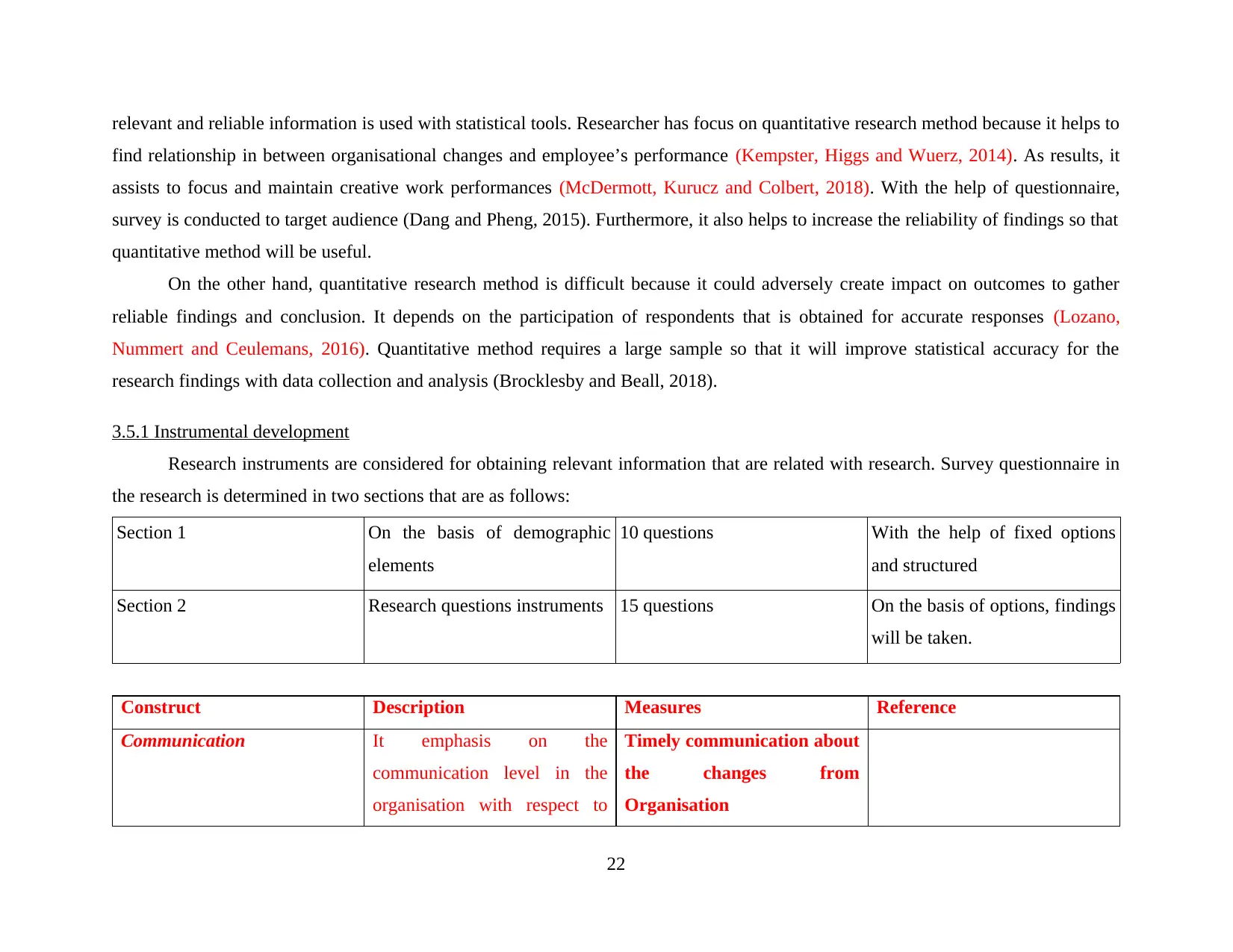
relevant and reliable information is used with statistical tools. Researcher has focus on quantitative research method because it helps to
find relationship in between organisational changes and employee’s performance (Kempster, Higgs and Wuerz, 2014). As results, it
assists to focus and maintain creative work performances (McDermott, Kurucz and Colbert, 2018). With the help of questionnaire,
survey is conducted to target audience (Dang and Pheng, 2015). Furthermore, it also helps to increase the reliability of findings so that
quantitative method will be useful.
On the other hand, quantitative research method is difficult because it could adversely create impact on outcomes to gather
reliable findings and conclusion. It depends on the participation of respondents that is obtained for accurate responses (Lozano,
Nummert and Ceulemans, 2016). Quantitative method requires a large sample so that it will improve statistical accuracy for the
research findings with data collection and analysis (Brocklesby and Beall, 2018).
3.5.1 Instrumental development
Research instruments are considered for obtaining relevant information that are related with research. Survey questionnaire in
the research is determined in two sections that are as follows:
Section 1 On the basis of demographic
elements
10 questions With the help of fixed options
and structured
Section 2 Research questions instruments 15 questions On the basis of options, findings
will be taken.
Construct Description Measures Reference
Communication It emphasis on the
communication level in the
organisation with respect to
Timely communication about
the changes from
Organisation
22
find relationship in between organisational changes and employee’s performance (Kempster, Higgs and Wuerz, 2014). As results, it
assists to focus and maintain creative work performances (McDermott, Kurucz and Colbert, 2018). With the help of questionnaire,
survey is conducted to target audience (Dang and Pheng, 2015). Furthermore, it also helps to increase the reliability of findings so that
quantitative method will be useful.
On the other hand, quantitative research method is difficult because it could adversely create impact on outcomes to gather
reliable findings and conclusion. It depends on the participation of respondents that is obtained for accurate responses (Lozano,
Nummert and Ceulemans, 2016). Quantitative method requires a large sample so that it will improve statistical accuracy for the
research findings with data collection and analysis (Brocklesby and Beall, 2018).
3.5.1 Instrumental development
Research instruments are considered for obtaining relevant information that are related with research. Survey questionnaire in
the research is determined in two sections that are as follows:
Section 1 On the basis of demographic
elements
10 questions With the help of fixed options
and structured
Section 2 Research questions instruments 15 questions On the basis of options, findings
will be taken.
Construct Description Measures Reference
Communication It emphasis on the
communication level in the
organisation with respect to
Timely communication about
the changes from
Organisation
22
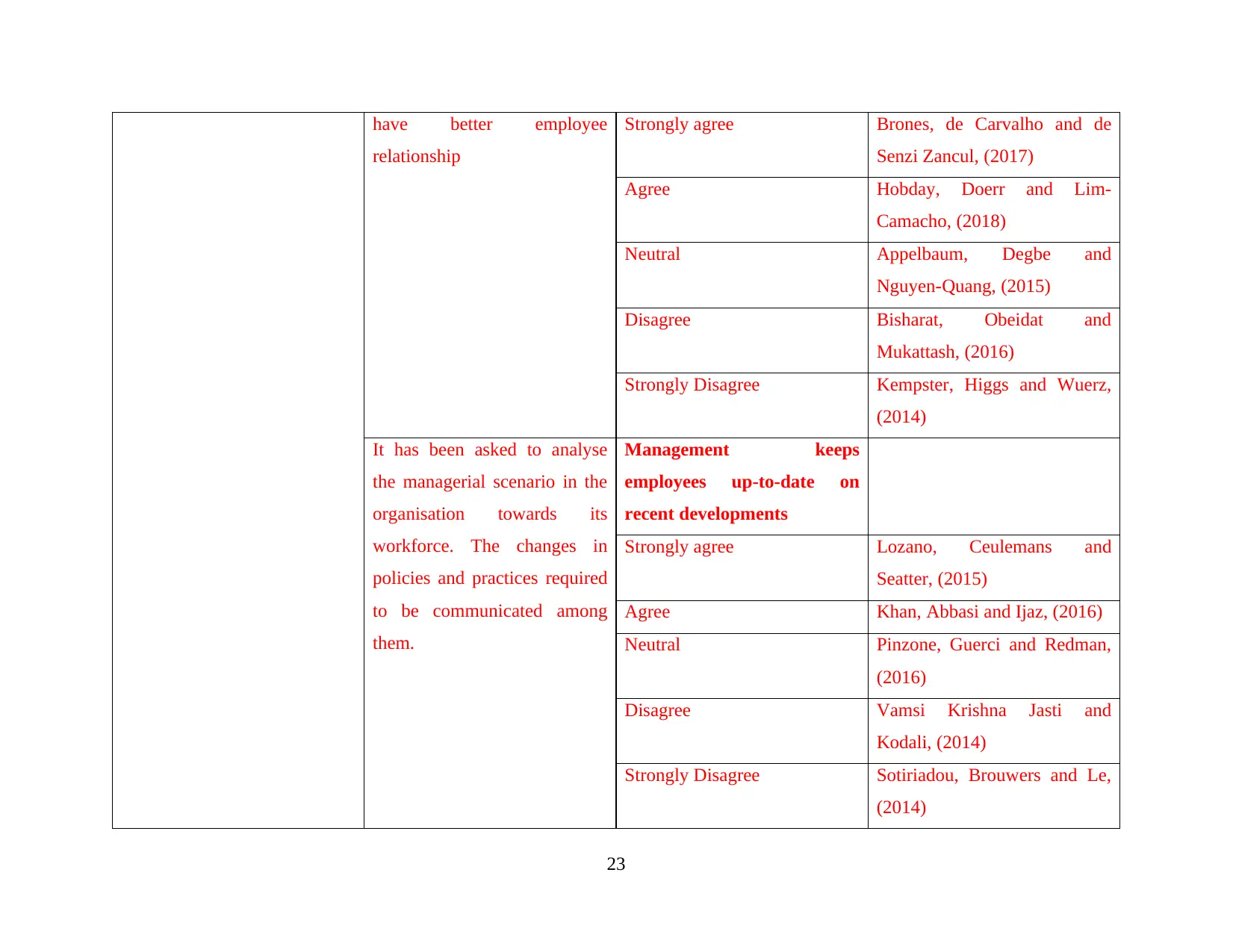
have better employee
relationship
Strongly agree Brones, de Carvalho and de
Senzi Zancul, (2017)
Agree Hobday, Doerr and Lim-
Camacho, (2018)
Neutral Appelbaum, Degbe and
Nguyen-Quang, (2015)
Disagree Bisharat, Obeidat and
Mukattash, (2016)
Strongly Disagree Kempster, Higgs and Wuerz,
(2014)
It has been asked to analyse
the managerial scenario in the
organisation towards its
workforce. The changes in
policies and practices required
to be communicated among
them.
Management keeps
employees up-to-date on
recent developments
Strongly agree Lozano, Ceulemans and
Seatter, (2015)
Agree Khan, Abbasi and Ijaz, (2016)
Neutral Pinzone, Guerci and Redman,
(2016)
Disagree Vamsi Krishna Jasti and
Kodali, (2014)
Strongly Disagree Sotiriadou, Brouwers and Le,
(2014)
23
relationship
Strongly agree Brones, de Carvalho and de
Senzi Zancul, (2017)
Agree Hobday, Doerr and Lim-
Camacho, (2018)
Neutral Appelbaum, Degbe and
Nguyen-Quang, (2015)
Disagree Bisharat, Obeidat and
Mukattash, (2016)
Strongly Disagree Kempster, Higgs and Wuerz,
(2014)
It has been asked to analyse
the managerial scenario in the
organisation towards its
workforce. The changes in
policies and practices required
to be communicated among
them.
Management keeps
employees up-to-date on
recent developments
Strongly agree Lozano, Ceulemans and
Seatter, (2015)
Agree Khan, Abbasi and Ijaz, (2016)
Neutral Pinzone, Guerci and Redman,
(2016)
Disagree Vamsi Krishna Jasti and
Kodali, (2014)
Strongly Disagree Sotiriadou, Brouwers and Le,
(2014)
23
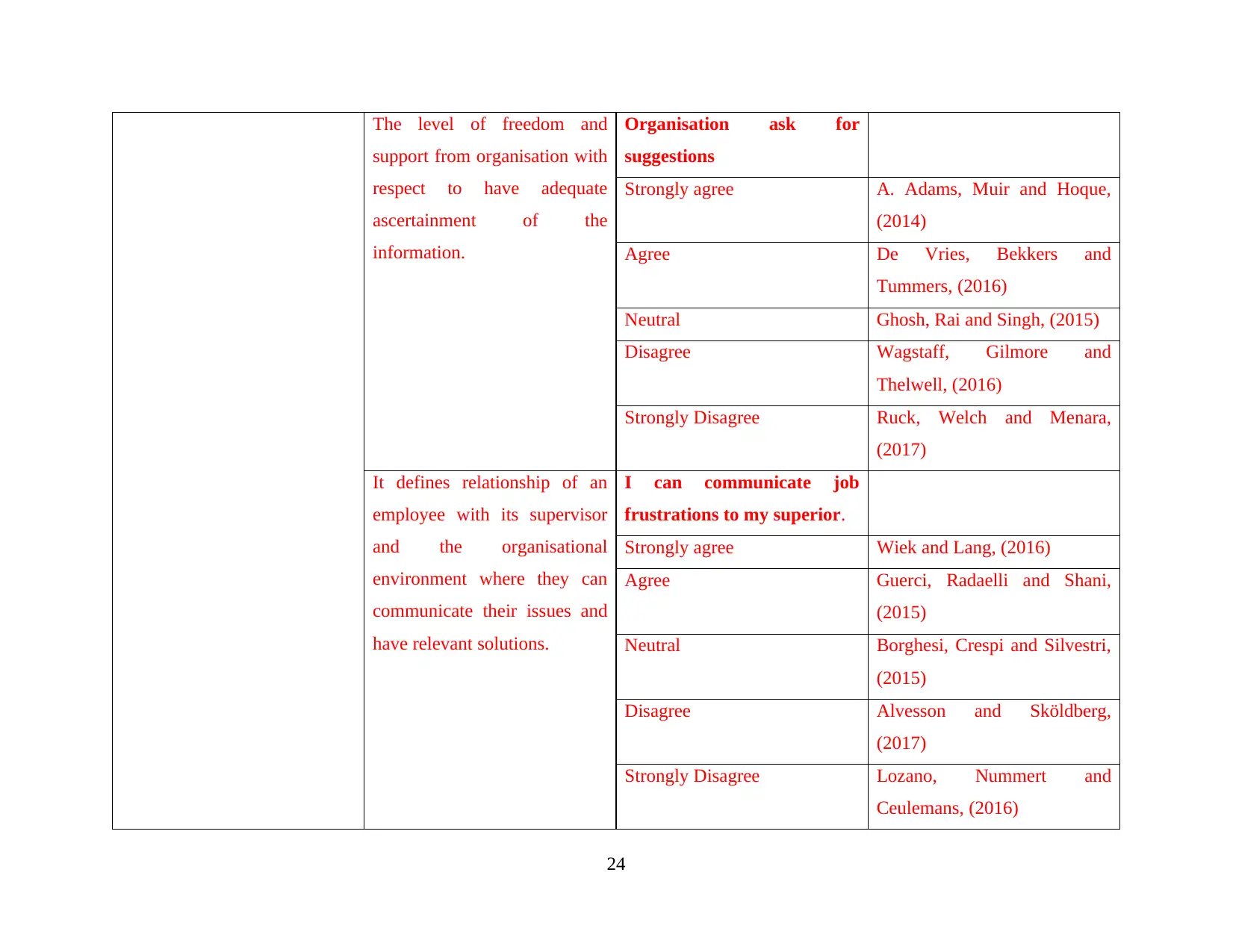
The level of freedom and
support from organisation with
respect to have adequate
ascertainment of the
information.
Organisation ask for
suggestions
Strongly agree A. Adams, Muir and Hoque,
(2014)
Agree De Vries, Bekkers and
Tummers, (2016)
Neutral Ghosh, Rai and Singh, (2015)
Disagree Wagstaff, Gilmore and
Thelwell, (2016)
Strongly Disagree Ruck, Welch and Menara,
(2017)
It defines relationship of an
employee with its supervisor
and the organisational
environment where they can
communicate their issues and
have relevant solutions.
I can communicate job
frustrations to my superior.
Strongly agree Wiek and Lang, (2016)
Agree Guerci, Radaelli and Shani,
(2015)
Neutral Borghesi, Crespi and Silvestri,
(2015)
Disagree Alvesson and Sköldberg,
(2017)
Strongly Disagree Lozano, Nummert and
Ceulemans, (2016)
24
support from organisation with
respect to have adequate
ascertainment of the
information.
Organisation ask for
suggestions
Strongly agree A. Adams, Muir and Hoque,
(2014)
Agree De Vries, Bekkers and
Tummers, (2016)
Neutral Ghosh, Rai and Singh, (2015)
Disagree Wagstaff, Gilmore and
Thelwell, (2016)
Strongly Disagree Ruck, Welch and Menara,
(2017)
It defines relationship of an
employee with its supervisor
and the organisational
environment where they can
communicate their issues and
have relevant solutions.
I can communicate job
frustrations to my superior.
Strongly agree Wiek and Lang, (2016)
Agree Guerci, Radaelli and Shani,
(2015)
Neutral Borghesi, Crespi and Silvestri,
(2015)
Disagree Alvesson and Sköldberg,
(2017)
Strongly Disagree Lozano, Nummert and
Ceulemans, (2016)
24
Secure Best Marks with AI Grader
Need help grading? Try our AI Grader for instant feedback on your assignments.
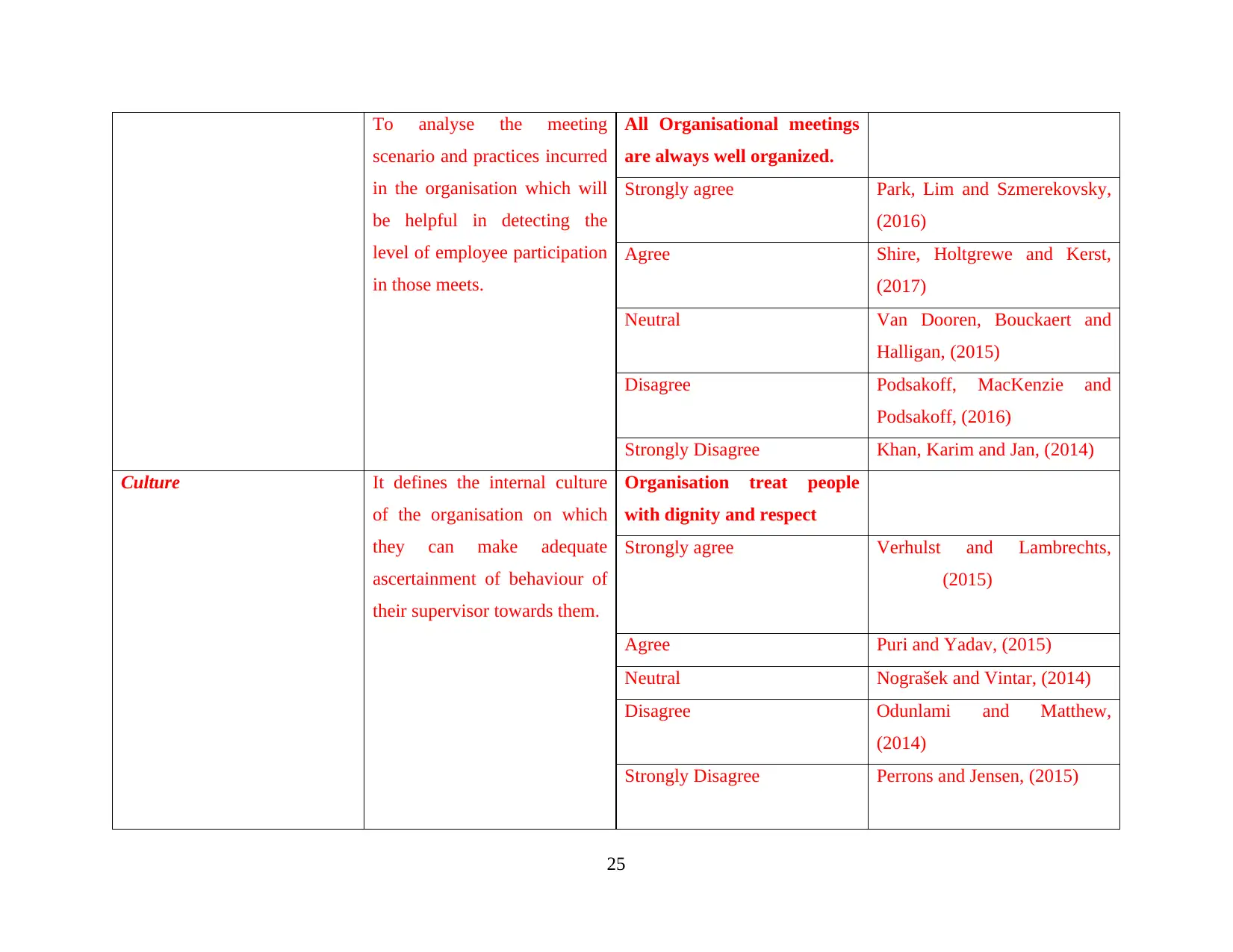
To analyse the meeting
scenario and practices incurred
in the organisation which will
be helpful in detecting the
level of employee participation
in those meets.
All Organisational meetings
are always well organized.
Strongly agree Park, Lim and Szmerekovsky,
(2016)
Agree Shire, Holtgrewe and Kerst,
(2017)
Neutral Van Dooren, Bouckaert and
Halligan, (2015)
Disagree Podsakoff, MacKenzie and
Podsakoff, (2016)
Strongly Disagree Khan, Karim and Jan, (2014)
Culture It defines the internal culture
of the organisation on which
they can make adequate
ascertainment of behaviour of
their supervisor towards them.
Organisation treat people
with dignity and respect
Strongly agree Verhulst and Lambrechts,
(2015)
Agree Puri and Yadav, (2015)
Neutral Nograšek and Vintar, (2014)
Disagree Odunlami and Matthew,
(2014)
Strongly Disagree Perrons and Jensen, (2015)
25
scenario and practices incurred
in the organisation which will
be helpful in detecting the
level of employee participation
in those meets.
All Organisational meetings
are always well organized.
Strongly agree Park, Lim and Szmerekovsky,
(2016)
Agree Shire, Holtgrewe and Kerst,
(2017)
Neutral Van Dooren, Bouckaert and
Halligan, (2015)
Disagree Podsakoff, MacKenzie and
Podsakoff, (2016)
Strongly Disagree Khan, Karim and Jan, (2014)
Culture It defines the internal culture
of the organisation on which
they can make adequate
ascertainment of behaviour of
their supervisor towards them.
Organisation treat people
with dignity and respect
Strongly agree Verhulst and Lambrechts,
(2015)
Agree Puri and Yadav, (2015)
Neutral Nograšek and Vintar, (2014)
Disagree Odunlami and Matthew,
(2014)
Strongly Disagree Perrons and Jensen, (2015)
25
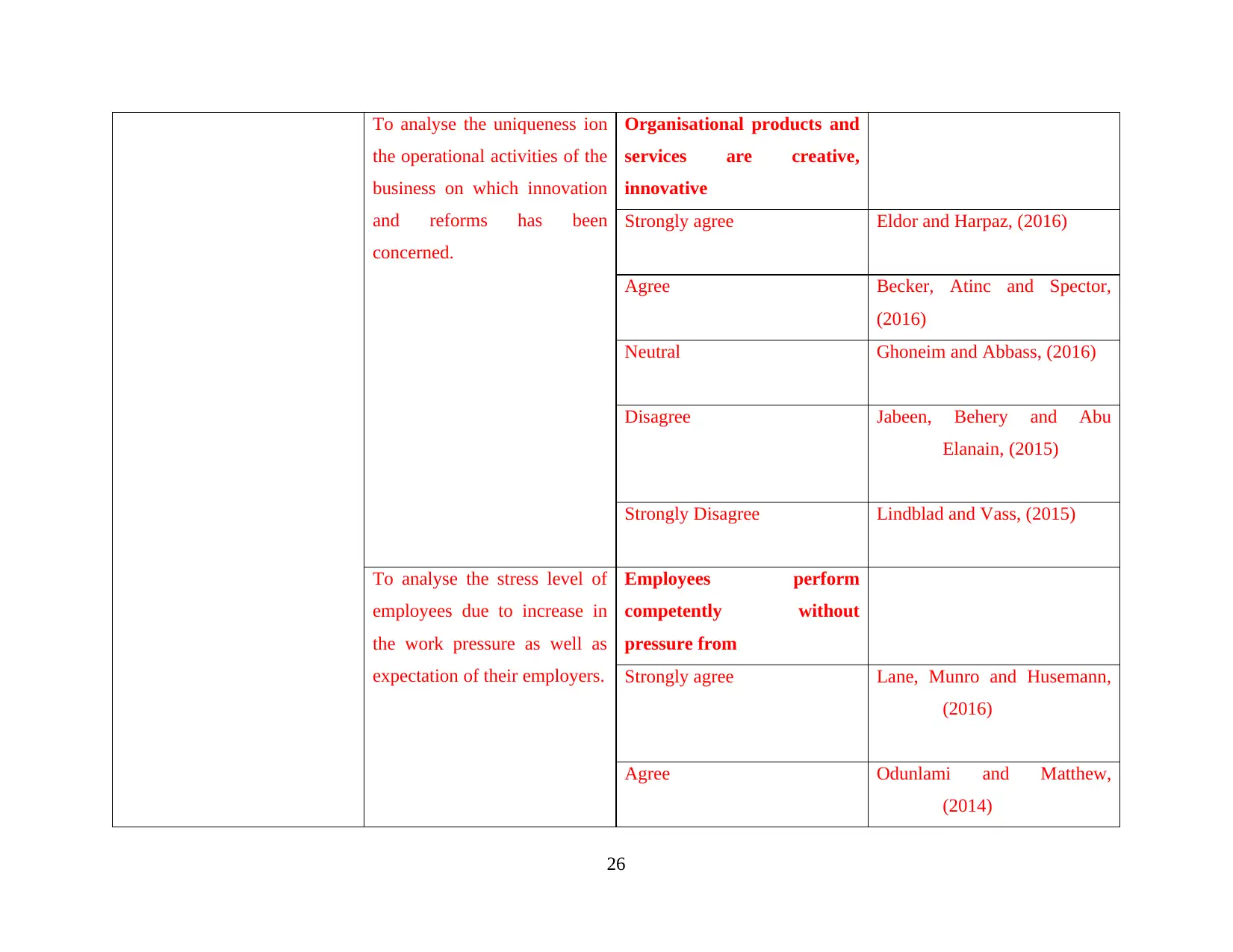
To analyse the uniqueness ion
the operational activities of the
business on which innovation
and reforms has been
concerned.
Organisational products and
services are creative,
innovative
Strongly agree Eldor and Harpaz, (2016)
Agree Becker, Atinc and Spector,
(2016)
Neutral Ghoneim and Abbass, (2016)
Disagree Jabeen, Behery and Abu
Elanain, (2015)
Strongly Disagree Lindblad and Vass, (2015)
To analyse the stress level of
employees due to increase in
the work pressure as well as
expectation of their employers.
Employees perform
competently without
pressure from
Strongly agree Lane, Munro and Husemann,
(2016)
Agree Odunlami and Matthew,
(2014)
26
the operational activities of the
business on which innovation
and reforms has been
concerned.
Organisational products and
services are creative,
innovative
Strongly agree Eldor and Harpaz, (2016)
Agree Becker, Atinc and Spector,
(2016)
Neutral Ghoneim and Abbass, (2016)
Disagree Jabeen, Behery and Abu
Elanain, (2015)
Strongly Disagree Lindblad and Vass, (2015)
To analyse the stress level of
employees due to increase in
the work pressure as well as
expectation of their employers.
Employees perform
competently without
pressure from
Strongly agree Lane, Munro and Husemann,
(2016)
Agree Odunlami and Matthew,
(2014)
26
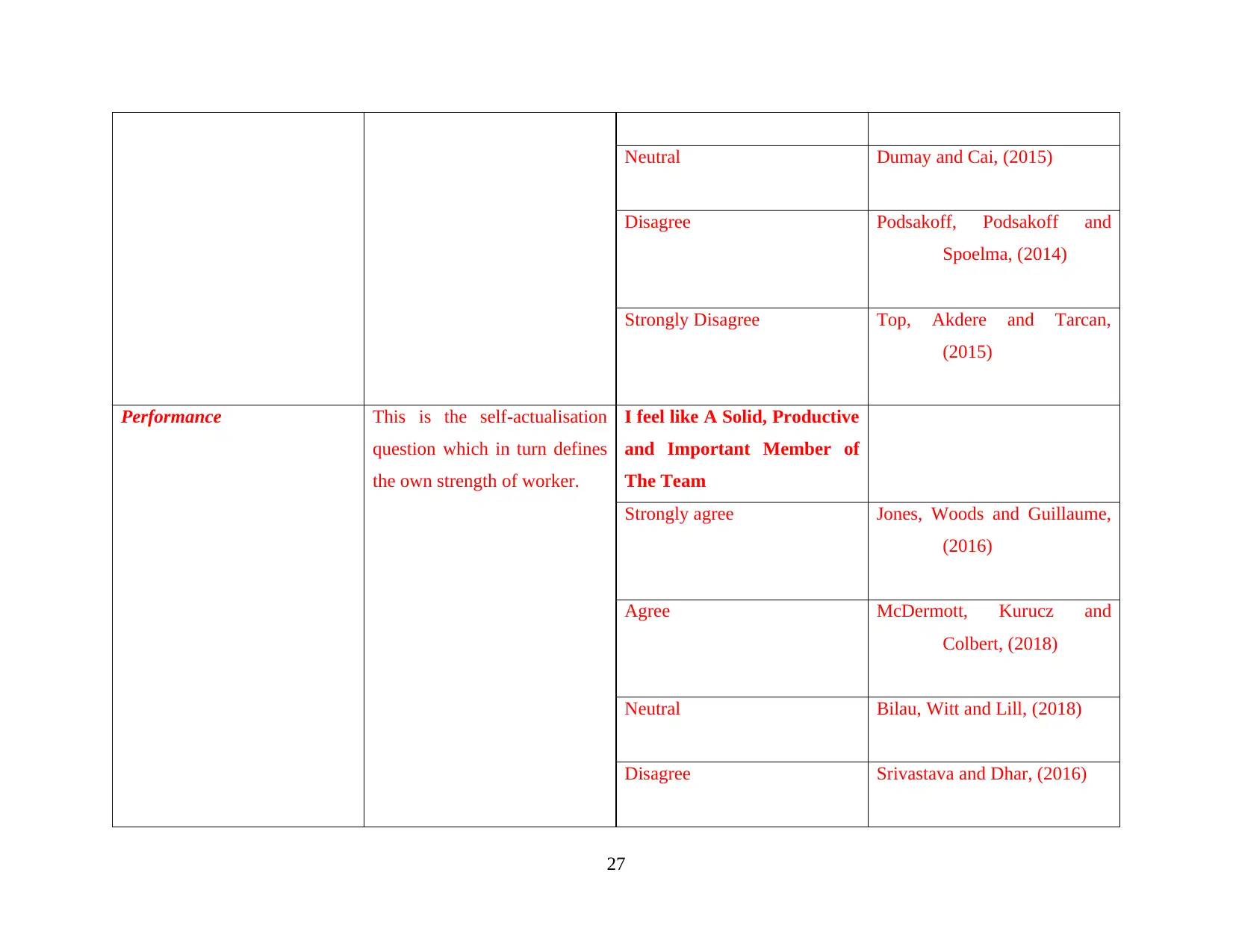
Neutral Dumay and Cai, (2015)
Disagree Podsakoff, Podsakoff and
Spoelma, (2014)
Strongly Disagree Top, Akdere and Tarcan,
(2015)
Performance This is the self-actualisation
question which in turn defines
the own strength of worker.
I feel like A Solid, Productive
and Important Member of
The Team
Strongly agree Jones, Woods and Guillaume,
(2016)
Agree McDermott, Kurucz and
Colbert, (2018)
Neutral Bilau, Witt and Lill, (2018)
Disagree Srivastava and Dhar, (2016)
27
Disagree Podsakoff, Podsakoff and
Spoelma, (2014)
Strongly Disagree Top, Akdere and Tarcan,
(2015)
Performance This is the self-actualisation
question which in turn defines
the own strength of worker.
I feel like A Solid, Productive
and Important Member of
The Team
Strongly agree Jones, Woods and Guillaume,
(2016)
Agree McDermott, Kurucz and
Colbert, (2018)
Neutral Bilau, Witt and Lill, (2018)
Disagree Srivastava and Dhar, (2016)
27
Paraphrase This Document
Need a fresh take? Get an instant paraphrase of this document with our AI Paraphraser

Strongly Disagree Brocklesby and Beall, (2018)
This indicates the true meaning
of the duties performed by the
individual.
I find the work that I do full
of meaning and purpose.
Strongly agree Bolman and Deal, (2017)
Agree Dang and Pheng, (2015)
Neutral Iqbal, Nadeem and Zaheer,
(2015)
Disagree Olubusayo, (2016)
Strongly Disagree Srivastava and Dhar, (2016)
The impacts of operational
changes on the employee
performance and raise in their
inner strength or skills.
Continually expanding my
Skill Set
Strongly agree Puri and Yadav, (2015)
Agree Hughes and Wearing, (2016)
Neutral Nograšek and Vintar, (2014)
28
This indicates the true meaning
of the duties performed by the
individual.
I find the work that I do full
of meaning and purpose.
Strongly agree Bolman and Deal, (2017)
Agree Dang and Pheng, (2015)
Neutral Iqbal, Nadeem and Zaheer,
(2015)
Disagree Olubusayo, (2016)
Strongly Disagree Srivastava and Dhar, (2016)
The impacts of operational
changes on the employee
performance and raise in their
inner strength or skills.
Continually expanding my
Skill Set
Strongly agree Puri and Yadav, (2015)
Agree Hughes and Wearing, (2016)
Neutral Nograšek and Vintar, (2014)
28

Disagree Mamic, (2017)
Strongly Disagree Top, Akdere and Tarcan,
(2015)
The gains retained and goals
achieved by the organisation
are how helpful to the
employees.
Organisational benefits are
suitable for me
Strongly agree Iqbal, Nadeem and Zaheer,
(2015)
Agree Olubusayo, (2016)
Neutral Top, Akdere and Tarcan,
(2015)
Disagree Jabeen, Behery and Abu
Elanain, (2015)
Strongly Disagree Lindblad and Vass, (2015)
The impacts of policies organisational change has
29
Strongly Disagree Top, Akdere and Tarcan,
(2015)
The gains retained and goals
achieved by the organisation
are how helpful to the
employees.
Organisational benefits are
suitable for me
Strongly agree Iqbal, Nadeem and Zaheer,
(2015)
Agree Olubusayo, (2016)
Neutral Top, Akdere and Tarcan,
(2015)
Disagree Jabeen, Behery and Abu
Elanain, (2015)
Strongly Disagree Lindblad and Vass, (2015)
The impacts of policies organisational change has
29
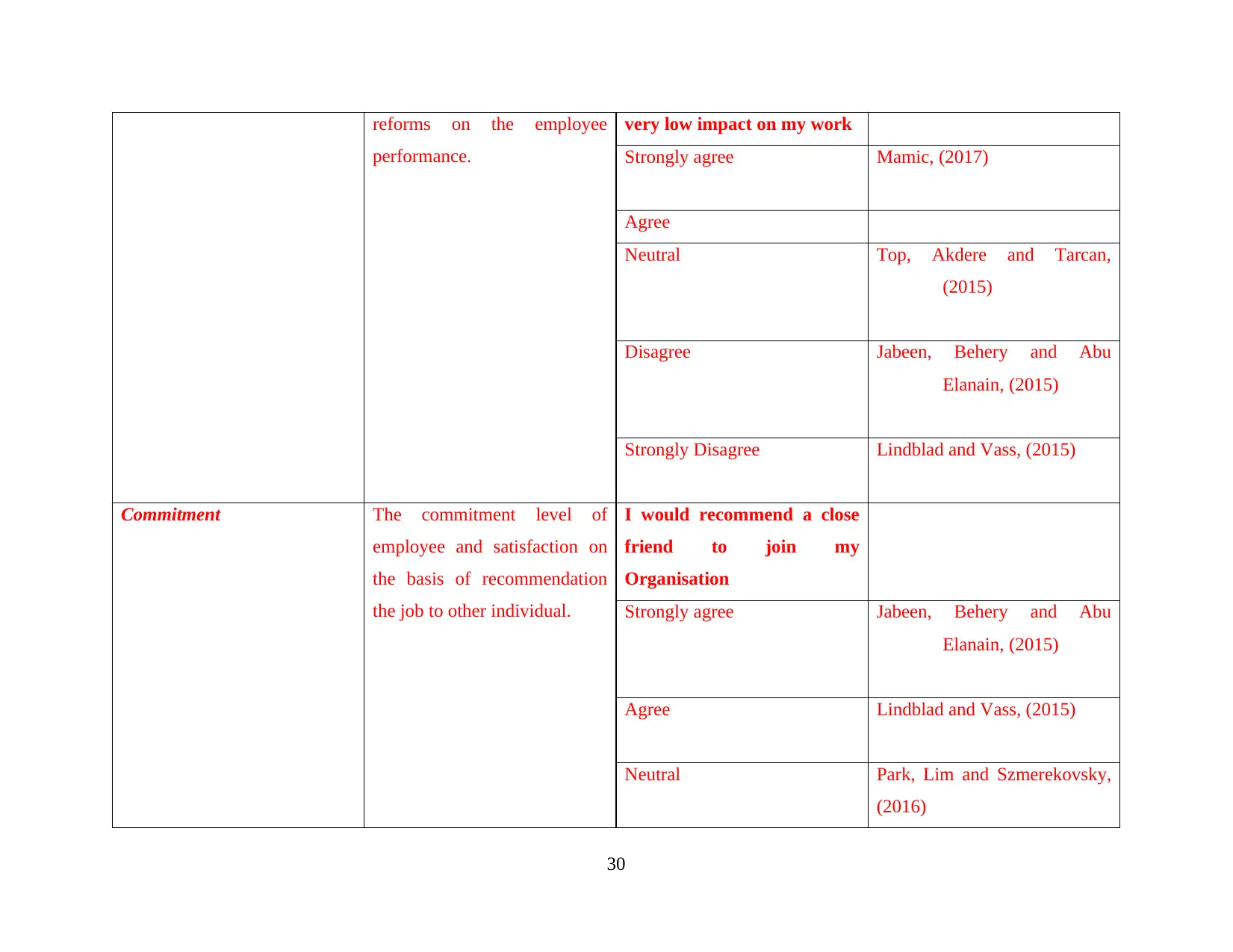
reforms on the employee
performance.
very low impact on my work
Strongly agree Mamic, (2017)
Agree
Neutral Top, Akdere and Tarcan,
(2015)
Disagree Jabeen, Behery and Abu
Elanain, (2015)
Strongly Disagree Lindblad and Vass, (2015)
Commitment The commitment level of
employee and satisfaction on
the basis of recommendation
the job to other individual.
I would recommend a close
friend to join my
Organisation
Strongly agree Jabeen, Behery and Abu
Elanain, (2015)
Agree Lindblad and Vass, (2015)
Neutral Park, Lim and Szmerekovsky,
(2016)
30
performance.
very low impact on my work
Strongly agree Mamic, (2017)
Agree
Neutral Top, Akdere and Tarcan,
(2015)
Disagree Jabeen, Behery and Abu
Elanain, (2015)
Strongly Disagree Lindblad and Vass, (2015)
Commitment The commitment level of
employee and satisfaction on
the basis of recommendation
the job to other individual.
I would recommend a close
friend to join my
Organisation
Strongly agree Jabeen, Behery and Abu
Elanain, (2015)
Agree Lindblad and Vass, (2015)
Neutral Park, Lim and Szmerekovsky,
(2016)
30
Secure Best Marks with AI Grader
Need help grading? Try our AI Grader for instant feedback on your assignments.
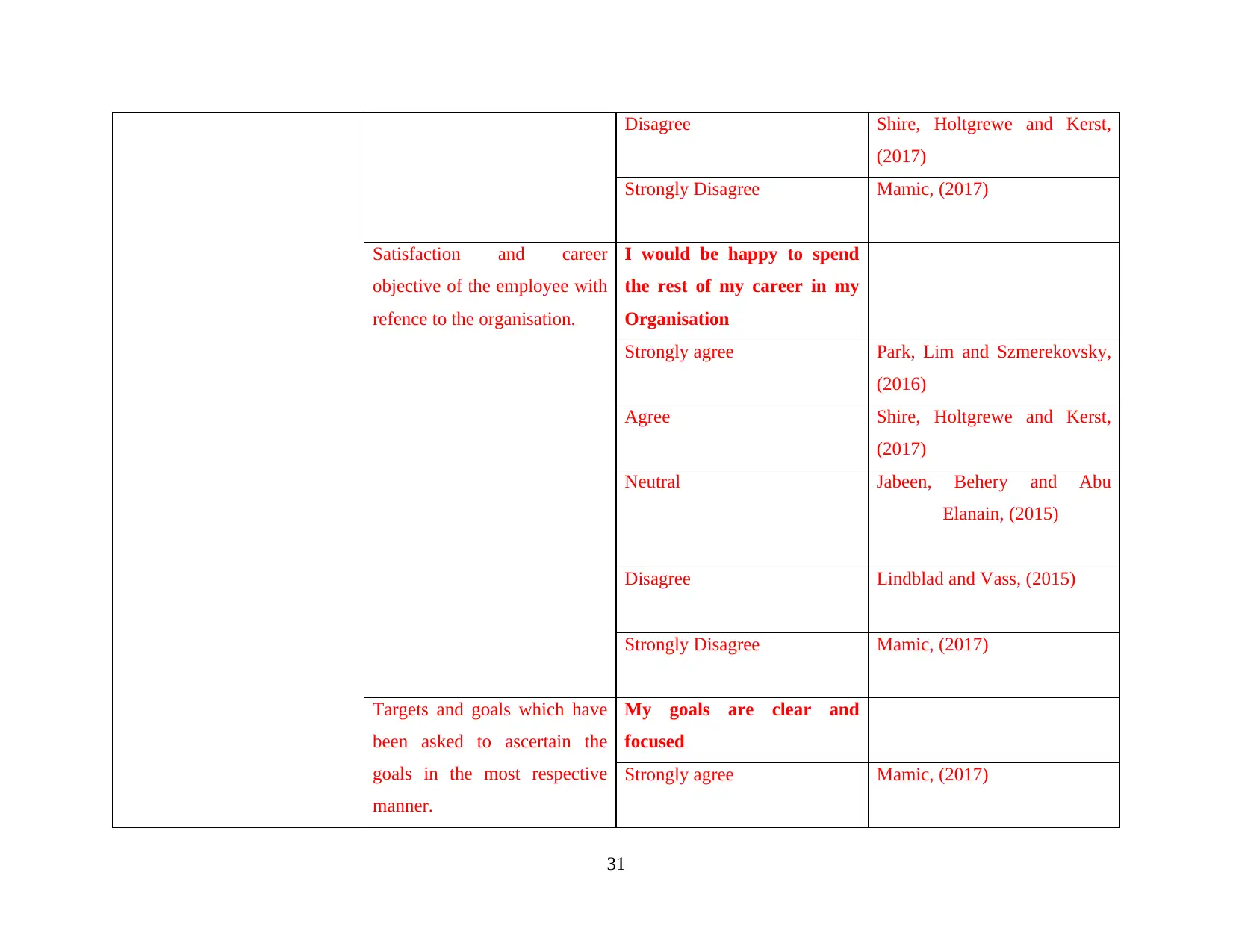
Disagree Shire, Holtgrewe and Kerst,
(2017)
Strongly Disagree Mamic, (2017)
Satisfaction and career
objective of the employee with
refence to the organisation.
I would be happy to spend
the rest of my career in my
Organisation
Strongly agree Park, Lim and Szmerekovsky,
(2016)
Agree Shire, Holtgrewe and Kerst,
(2017)
Neutral Jabeen, Behery and Abu
Elanain, (2015)
Disagree Lindblad and Vass, (2015)
Strongly Disagree Mamic, (2017)
Targets and goals which have
been asked to ascertain the
goals in the most respective
manner.
My goals are clear and
focused
Strongly agree Mamic, (2017)
31
(2017)
Strongly Disagree Mamic, (2017)
Satisfaction and career
objective of the employee with
refence to the organisation.
I would be happy to spend
the rest of my career in my
Organisation
Strongly agree Park, Lim and Szmerekovsky,
(2016)
Agree Shire, Holtgrewe and Kerst,
(2017)
Neutral Jabeen, Behery and Abu
Elanain, (2015)
Disagree Lindblad and Vass, (2015)
Strongly Disagree Mamic, (2017)
Targets and goals which have
been asked to ascertain the
goals in the most respective
manner.
My goals are clear and
focused
Strongly agree Mamic, (2017)
31
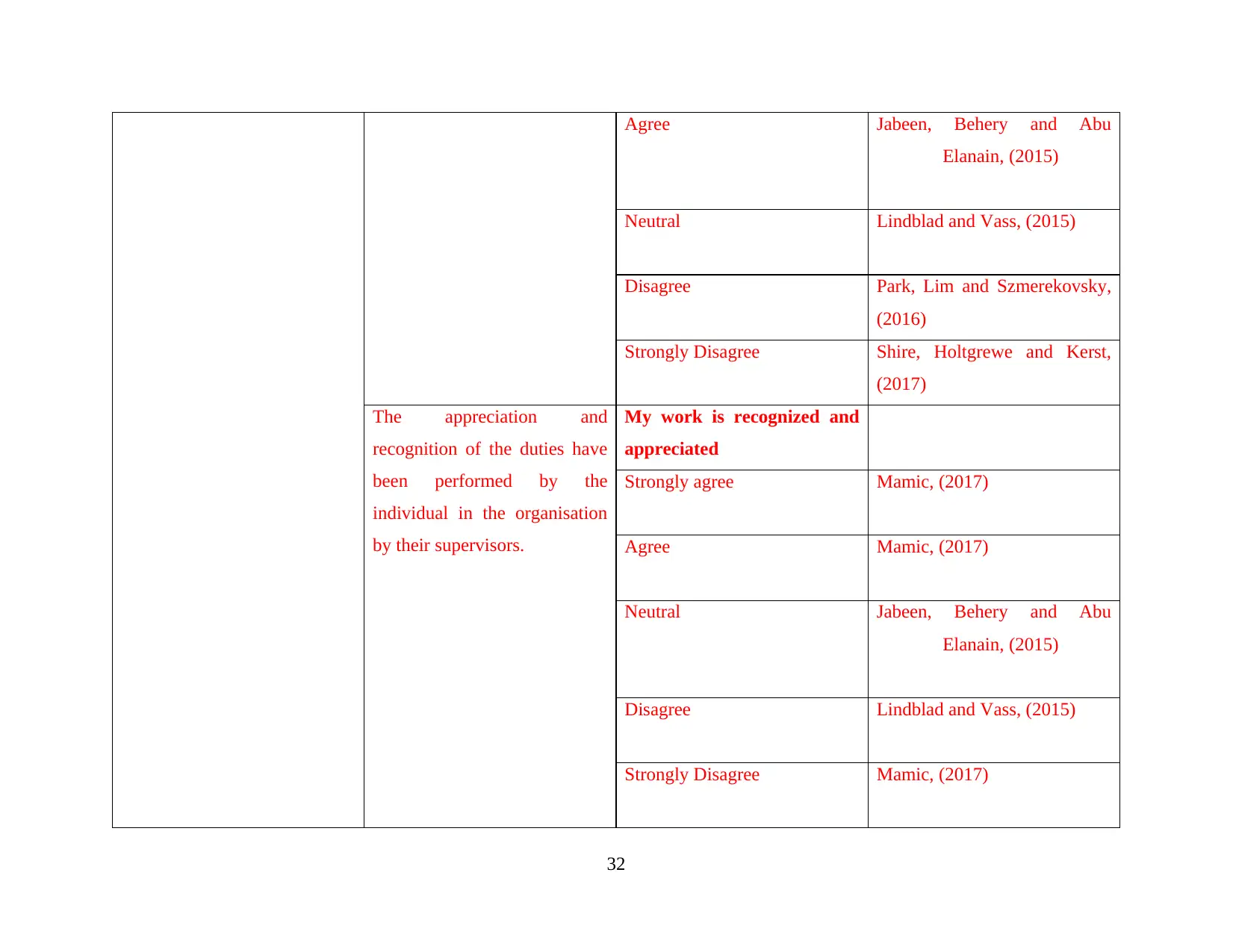
Agree Jabeen, Behery and Abu
Elanain, (2015)
Neutral Lindblad and Vass, (2015)
Disagree Park, Lim and Szmerekovsky,
(2016)
Strongly Disagree Shire, Holtgrewe and Kerst,
(2017)
The appreciation and
recognition of the duties have
been performed by the
individual in the organisation
by their supervisors.
My work is recognized and
appreciated
Strongly agree Mamic, (2017)
Agree Mamic, (2017)
Neutral Jabeen, Behery and Abu
Elanain, (2015)
Disagree Lindblad and Vass, (2015)
Strongly Disagree Mamic, (2017)
32
Elanain, (2015)
Neutral Lindblad and Vass, (2015)
Disagree Park, Lim and Szmerekovsky,
(2016)
Strongly Disagree Shire, Holtgrewe and Kerst,
(2017)
The appreciation and
recognition of the duties have
been performed by the
individual in the organisation
by their supervisors.
My work is recognized and
appreciated
Strongly agree Mamic, (2017)
Agree Mamic, (2017)
Neutral Jabeen, Behery and Abu
Elanain, (2015)
Disagree Lindblad and Vass, (2015)
Strongly Disagree Mamic, (2017)
32
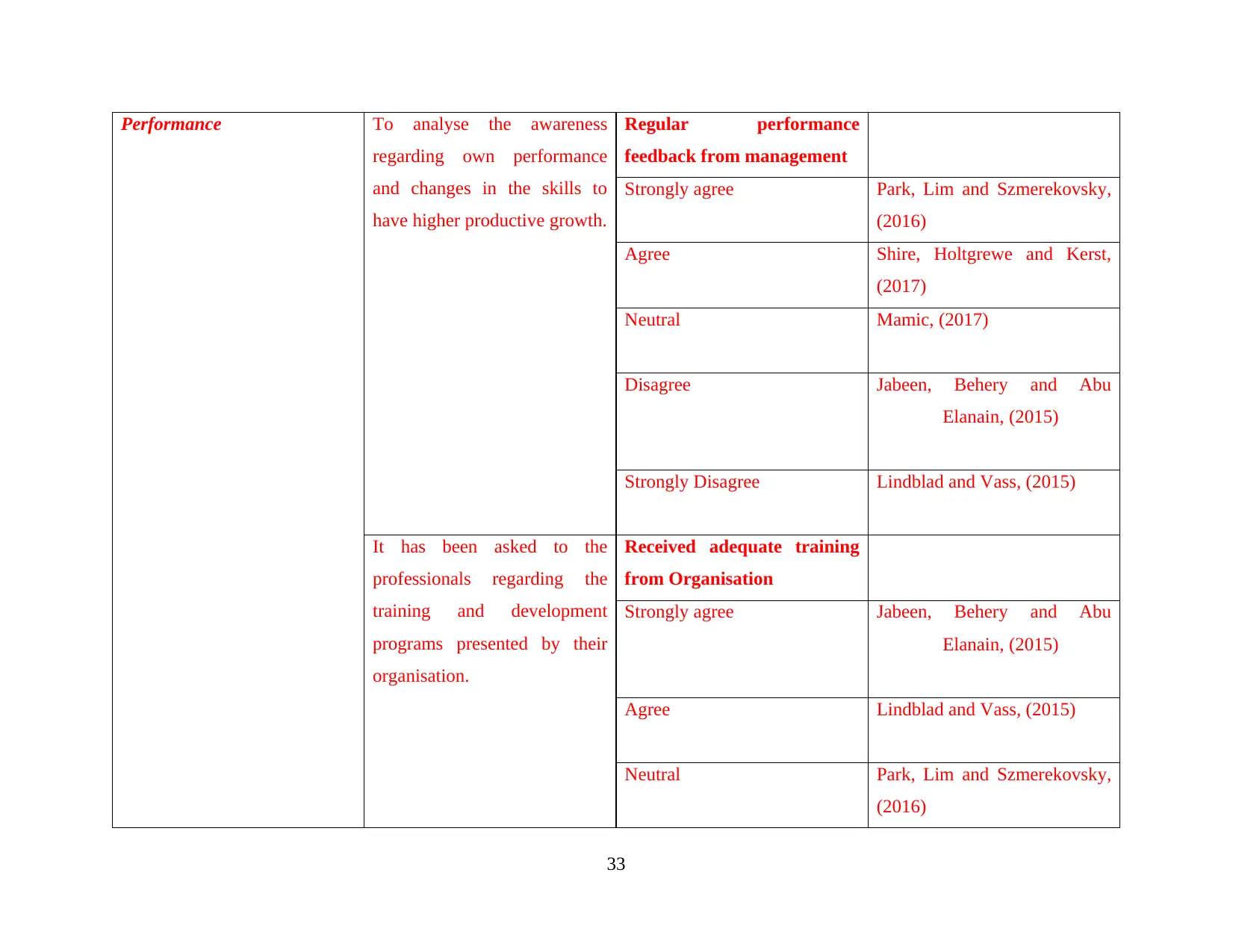
Performance To analyse the awareness
regarding own performance
and changes in the skills to
have higher productive growth.
Regular performance
feedback from management
Strongly agree Park, Lim and Szmerekovsky,
(2016)
Agree Shire, Holtgrewe and Kerst,
(2017)
Neutral Mamic, (2017)
Disagree Jabeen, Behery and Abu
Elanain, (2015)
Strongly Disagree Lindblad and Vass, (2015)
It has been asked to the
professionals regarding the
training and development
programs presented by their
organisation.
Received adequate training
from Organisation
Strongly agree Jabeen, Behery and Abu
Elanain, (2015)
Agree Lindblad and Vass, (2015)
Neutral Park, Lim and Szmerekovsky,
(2016)
33
regarding own performance
and changes in the skills to
have higher productive growth.
Regular performance
feedback from management
Strongly agree Park, Lim and Szmerekovsky,
(2016)
Agree Shire, Holtgrewe and Kerst,
(2017)
Neutral Mamic, (2017)
Disagree Jabeen, Behery and Abu
Elanain, (2015)
Strongly Disagree Lindblad and Vass, (2015)
It has been asked to the
professionals regarding the
training and development
programs presented by their
organisation.
Received adequate training
from Organisation
Strongly agree Jabeen, Behery and Abu
Elanain, (2015)
Agree Lindblad and Vass, (2015)
Neutral Park, Lim and Szmerekovsky,
(2016)
33
Paraphrase This Document
Need a fresh take? Get an instant paraphrase of this document with our AI Paraphraser
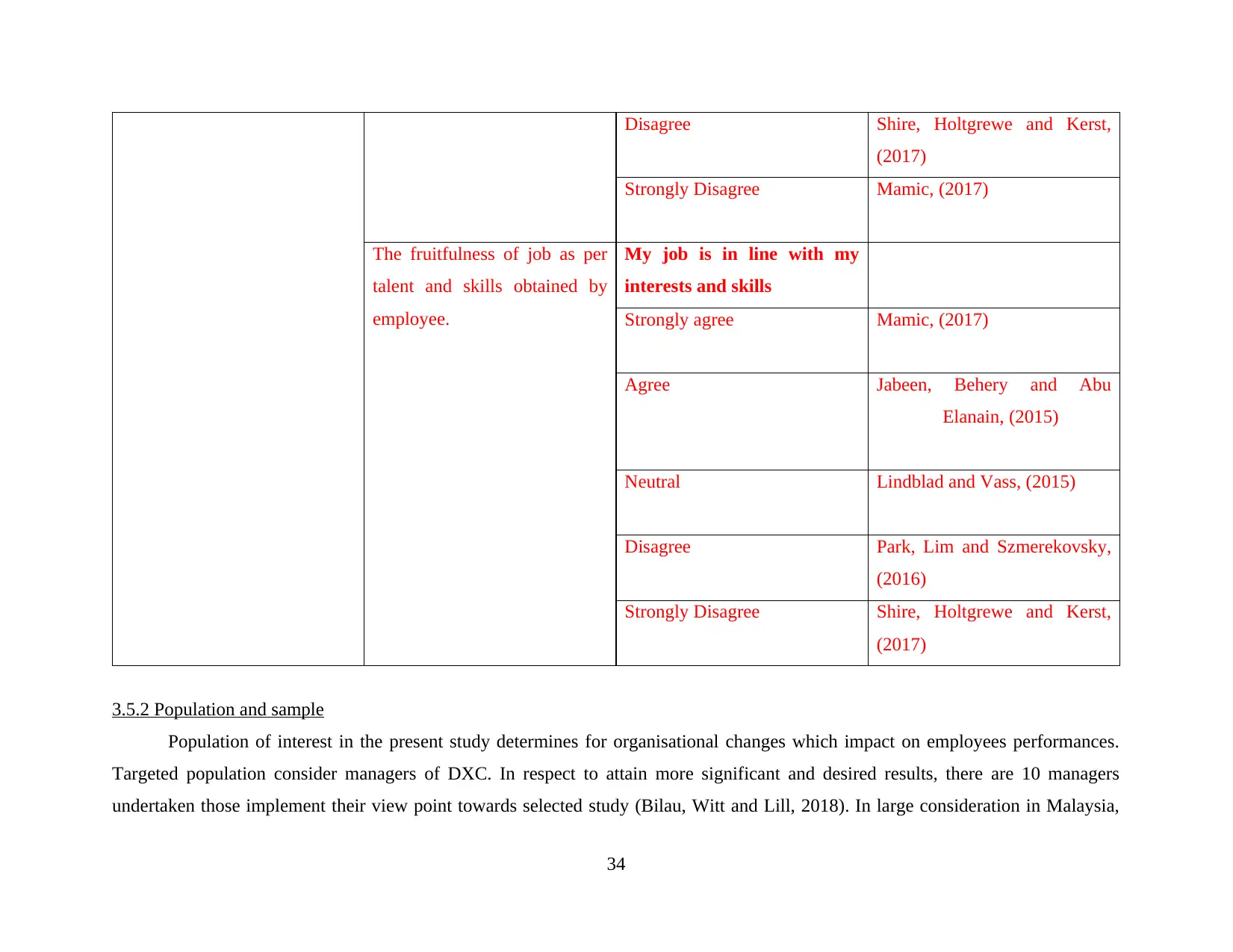
Disagree Shire, Holtgrewe and Kerst,
(2017)
Strongly Disagree Mamic, (2017)
The fruitfulness of job as per
talent and skills obtained by
employee.
My job is in line with my
interests and skills
Strongly agree Mamic, (2017)
Agree Jabeen, Behery and Abu
Elanain, (2015)
Neutral Lindblad and Vass, (2015)
Disagree Park, Lim and Szmerekovsky,
(2016)
Strongly Disagree Shire, Holtgrewe and Kerst,
(2017)
3.5.2 Population and sample
Population of interest in the present study determines for organisational changes which impact on employees performances.
Targeted population consider managers of DXC. In respect to attain more significant and desired results, there are 10 managers
undertaken those implement their view point towards selected study (Bilau, Witt and Lill, 2018). In large consideration in Malaysia,
34
(2017)
Strongly Disagree Mamic, (2017)
The fruitfulness of job as per
talent and skills obtained by
employee.
My job is in line with my
interests and skills
Strongly agree Mamic, (2017)
Agree Jabeen, Behery and Abu
Elanain, (2015)
Neutral Lindblad and Vass, (2015)
Disagree Park, Lim and Szmerekovsky,
(2016)
Strongly Disagree Shire, Holtgrewe and Kerst,
(2017)
3.5.2 Population and sample
Population of interest in the present study determines for organisational changes which impact on employees performances.
Targeted population consider managers of DXC. In respect to attain more significant and desired results, there are 10 managers
undertaken those implement their view point towards selected study (Bilau, Witt and Lill, 2018). In large consideration in Malaysia,
34
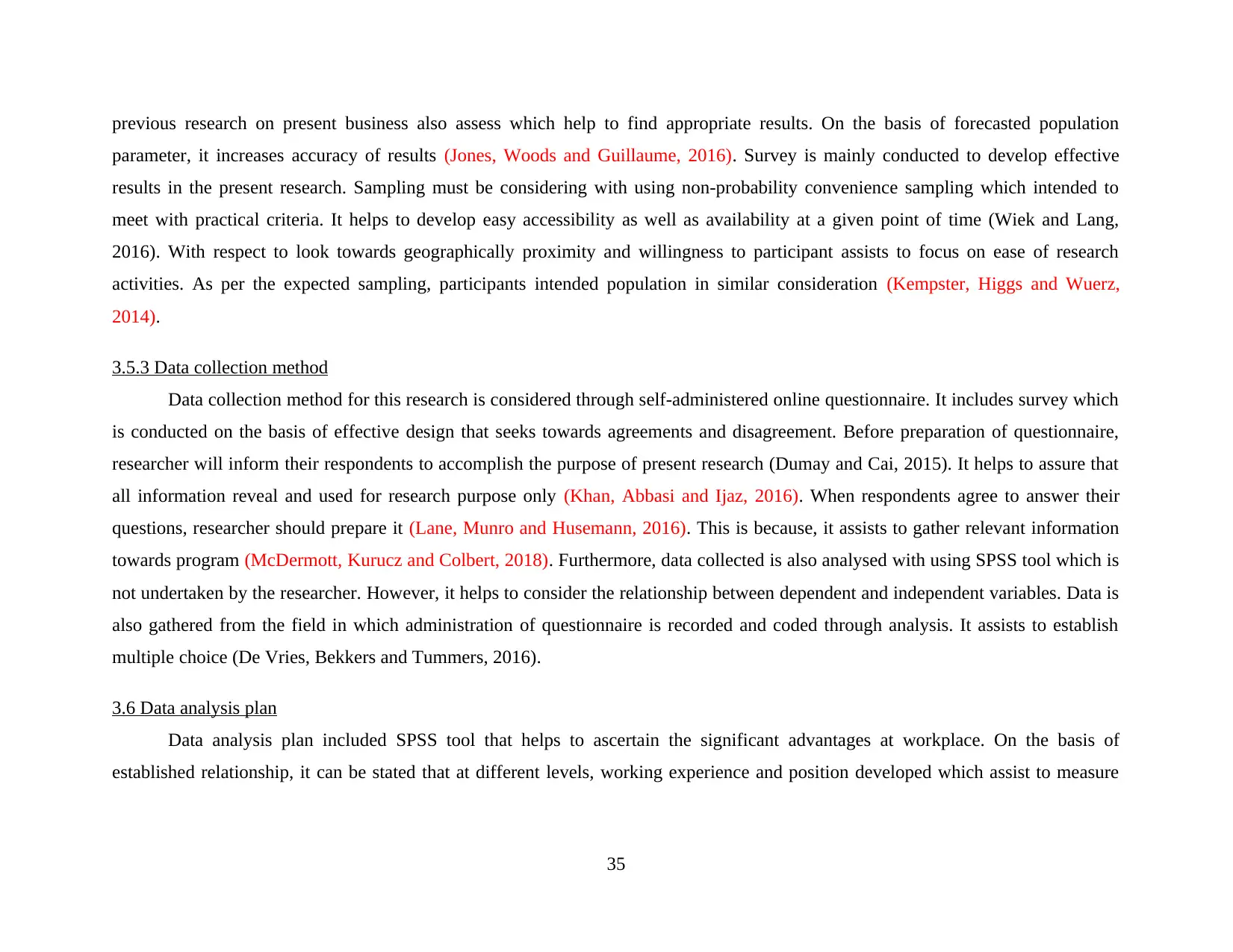
previous research on present business also assess which help to find appropriate results. On the basis of forecasted population
parameter, it increases accuracy of results (Jones, Woods and Guillaume, 2016). Survey is mainly conducted to develop effective
results in the present research. Sampling must be considering with using non-probability convenience sampling which intended to
meet with practical criteria. It helps to develop easy accessibility as well as availability at a given point of time (Wiek and Lang,
2016). With respect to look towards geographically proximity and willingness to participant assists to focus on ease of research
activities. As per the expected sampling, participants intended population in similar consideration (Kempster, Higgs and Wuerz,
2014).
3.5.3 Data collection method
Data collection method for this research is considered through self-administered online questionnaire. It includes survey which
is conducted on the basis of effective design that seeks towards agreements and disagreement. Before preparation of questionnaire,
researcher will inform their respondents to accomplish the purpose of present research (Dumay and Cai, 2015). It helps to assure that
all information reveal and used for research purpose only (Khan, Abbasi and Ijaz, 2016). When respondents agree to answer their
questions, researcher should prepare it (Lane, Munro and Husemann, 2016). This is because, it assists to gather relevant information
towards program (McDermott, Kurucz and Colbert, 2018). Furthermore, data collected is also analysed with using SPSS tool which is
not undertaken by the researcher. However, it helps to consider the relationship between dependent and independent variables. Data is
also gathered from the field in which administration of questionnaire is recorded and coded through analysis. It assists to establish
multiple choice (De Vries, Bekkers and Tummers, 2016).
3.6 Data analysis plan
Data analysis plan included SPSS tool that helps to ascertain the significant advantages at workplace. On the basis of
established relationship, it can be stated that at different levels, working experience and position developed which assist to measure
35
parameter, it increases accuracy of results (Jones, Woods and Guillaume, 2016). Survey is mainly conducted to develop effective
results in the present research. Sampling must be considering with using non-probability convenience sampling which intended to
meet with practical criteria. It helps to develop easy accessibility as well as availability at a given point of time (Wiek and Lang,
2016). With respect to look towards geographically proximity and willingness to participant assists to focus on ease of research
activities. As per the expected sampling, participants intended population in similar consideration (Kempster, Higgs and Wuerz,
2014).
3.5.3 Data collection method
Data collection method for this research is considered through self-administered online questionnaire. It includes survey which
is conducted on the basis of effective design that seeks towards agreements and disagreement. Before preparation of questionnaire,
researcher will inform their respondents to accomplish the purpose of present research (Dumay and Cai, 2015). It helps to assure that
all information reveal and used for research purpose only (Khan, Abbasi and Ijaz, 2016). When respondents agree to answer their
questions, researcher should prepare it (Lane, Munro and Husemann, 2016). This is because, it assists to gather relevant information
towards program (McDermott, Kurucz and Colbert, 2018). Furthermore, data collected is also analysed with using SPSS tool which is
not undertaken by the researcher. However, it helps to consider the relationship between dependent and independent variables. Data is
also gathered from the field in which administration of questionnaire is recorded and coded through analysis. It assists to establish
multiple choice (De Vries, Bekkers and Tummers, 2016).
3.6 Data analysis plan
Data analysis plan included SPSS tool that helps to ascertain the significant advantages at workplace. On the basis of
established relationship, it can be stated that at different levels, working experience and position developed which assist to measure
35
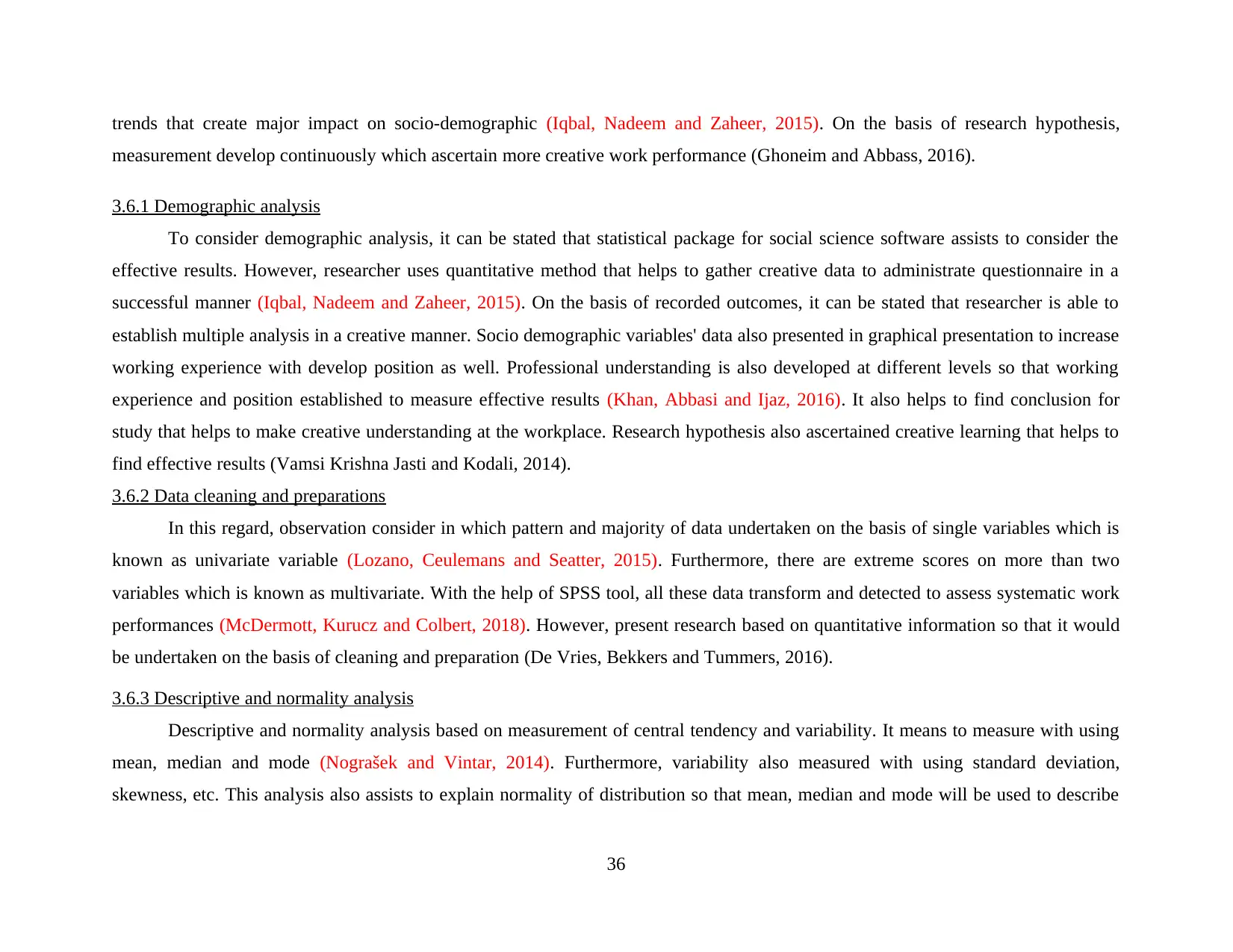
trends that create major impact on socio-demographic (Iqbal, Nadeem and Zaheer, 2015). On the basis of research hypothesis,
measurement develop continuously which ascertain more creative work performance (Ghoneim and Abbass, 2016).
3.6.1 Demographic analysis
To consider demographic analysis, it can be stated that statistical package for social science software assists to consider the
effective results. However, researcher uses quantitative method that helps to gather creative data to administrate questionnaire in a
successful manner (Iqbal, Nadeem and Zaheer, 2015). On the basis of recorded outcomes, it can be stated that researcher is able to
establish multiple analysis in a creative manner. Socio demographic variables' data also presented in graphical presentation to increase
working experience with develop position as well. Professional understanding is also developed at different levels so that working
experience and position established to measure effective results (Khan, Abbasi and Ijaz, 2016). It also helps to find conclusion for
study that helps to make creative understanding at the workplace. Research hypothesis also ascertained creative learning that helps to
find effective results (Vamsi Krishna Jasti and Kodali, 2014).
3.6.2 Data cleaning and preparations
In this regard, observation consider in which pattern and majority of data undertaken on the basis of single variables which is
known as univariate variable (Lozano, Ceulemans and Seatter, 2015). Furthermore, there are extreme scores on more than two
variables which is known as multivariate. With the help of SPSS tool, all these data transform and detected to assess systematic work
performances (McDermott, Kurucz and Colbert, 2018). However, present research based on quantitative information so that it would
be undertaken on the basis of cleaning and preparation (De Vries, Bekkers and Tummers, 2016).
3.6.3 Descriptive and normality analysis
Descriptive and normality analysis based on measurement of central tendency and variability. It means to measure with using
mean, median and mode (Nograšek and Vintar, 2014). Furthermore, variability also measured with using standard deviation,
skewness, etc. This analysis also assists to explain normality of distribution so that mean, median and mode will be used to describe
36
measurement develop continuously which ascertain more creative work performance (Ghoneim and Abbass, 2016).
3.6.1 Demographic analysis
To consider demographic analysis, it can be stated that statistical package for social science software assists to consider the
effective results. However, researcher uses quantitative method that helps to gather creative data to administrate questionnaire in a
successful manner (Iqbal, Nadeem and Zaheer, 2015). On the basis of recorded outcomes, it can be stated that researcher is able to
establish multiple analysis in a creative manner. Socio demographic variables' data also presented in graphical presentation to increase
working experience with develop position as well. Professional understanding is also developed at different levels so that working
experience and position established to measure effective results (Khan, Abbasi and Ijaz, 2016). It also helps to find conclusion for
study that helps to make creative understanding at the workplace. Research hypothesis also ascertained creative learning that helps to
find effective results (Vamsi Krishna Jasti and Kodali, 2014).
3.6.2 Data cleaning and preparations
In this regard, observation consider in which pattern and majority of data undertaken on the basis of single variables which is
known as univariate variable (Lozano, Ceulemans and Seatter, 2015). Furthermore, there are extreme scores on more than two
variables which is known as multivariate. With the help of SPSS tool, all these data transform and detected to assess systematic work
performances (McDermott, Kurucz and Colbert, 2018). However, present research based on quantitative information so that it would
be undertaken on the basis of cleaning and preparation (De Vries, Bekkers and Tummers, 2016).
3.6.3 Descriptive and normality analysis
Descriptive and normality analysis based on measurement of central tendency and variability. It means to measure with using
mean, median and mode (Nograšek and Vintar, 2014). Furthermore, variability also measured with using standard deviation,
skewness, etc. This analysis also assists to explain normality of distribution so that mean, median and mode will be used to describe
36
Secure Best Marks with AI Grader
Need help grading? Try our AI Grader for instant feedback on your assignments.
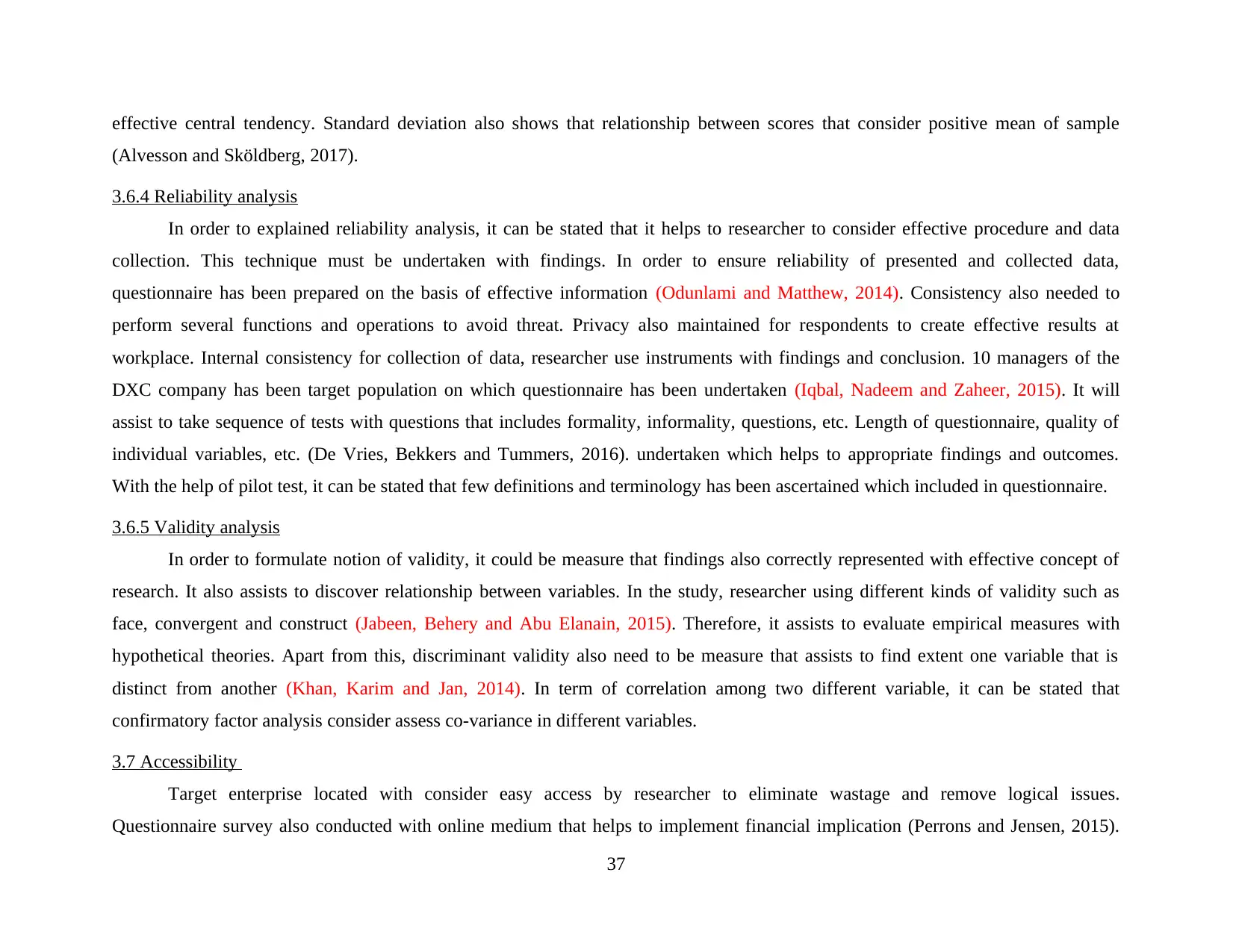
effective central tendency. Standard deviation also shows that relationship between scores that consider positive mean of sample
(Alvesson and Sköldberg, 2017).
3.6.4 Reliability analysis
In order to explained reliability analysis, it can be stated that it helps to researcher to consider effective procedure and data
collection. This technique must be undertaken with findings. In order to ensure reliability of presented and collected data,
questionnaire has been prepared on the basis of effective information (Odunlami and Matthew, 2014). Consistency also needed to
perform several functions and operations to avoid threat. Privacy also maintained for respondents to create effective results at
workplace. Internal consistency for collection of data, researcher use instruments with findings and conclusion. 10 managers of the
DXC company has been target population on which questionnaire has been undertaken (Iqbal, Nadeem and Zaheer, 2015). It will
assist to take sequence of tests with questions that includes formality, informality, questions, etc. Length of questionnaire, quality of
individual variables, etc. (De Vries, Bekkers and Tummers, 2016). undertaken which helps to appropriate findings and outcomes.
With the help of pilot test, it can be stated that few definitions and terminology has been ascertained which included in questionnaire.
3.6.5 Validity analysis
In order to formulate notion of validity, it could be measure that findings also correctly represented with effective concept of
research. It also assists to discover relationship between variables. In the study, researcher using different kinds of validity such as
face, convergent and construct (Jabeen, Behery and Abu Elanain, 2015). Therefore, it assists to evaluate empirical measures with
hypothetical theories. Apart from this, discriminant validity also need to be measure that assists to find extent one variable that is
distinct from another (Khan, Karim and Jan, 2014). In term of correlation among two different variable, it can be stated that
confirmatory factor analysis consider assess co-variance in different variables.
3.7 Accessibility
Target enterprise located with consider easy access by researcher to eliminate wastage and remove logical issues.
Questionnaire survey also conducted with online medium that helps to implement financial implication (Perrons and Jensen, 2015).
37
(Alvesson and Sköldberg, 2017).
3.6.4 Reliability analysis
In order to explained reliability analysis, it can be stated that it helps to researcher to consider effective procedure and data
collection. This technique must be undertaken with findings. In order to ensure reliability of presented and collected data,
questionnaire has been prepared on the basis of effective information (Odunlami and Matthew, 2014). Consistency also needed to
perform several functions and operations to avoid threat. Privacy also maintained for respondents to create effective results at
workplace. Internal consistency for collection of data, researcher use instruments with findings and conclusion. 10 managers of the
DXC company has been target population on which questionnaire has been undertaken (Iqbal, Nadeem and Zaheer, 2015). It will
assist to take sequence of tests with questions that includes formality, informality, questions, etc. Length of questionnaire, quality of
individual variables, etc. (De Vries, Bekkers and Tummers, 2016). undertaken which helps to appropriate findings and outcomes.
With the help of pilot test, it can be stated that few definitions and terminology has been ascertained which included in questionnaire.
3.6.5 Validity analysis
In order to formulate notion of validity, it could be measure that findings also correctly represented with effective concept of
research. It also assists to discover relationship between variables. In the study, researcher using different kinds of validity such as
face, convergent and construct (Jabeen, Behery and Abu Elanain, 2015). Therefore, it assists to evaluate empirical measures with
hypothetical theories. Apart from this, discriminant validity also need to be measure that assists to find extent one variable that is
distinct from another (Khan, Karim and Jan, 2014). In term of correlation among two different variable, it can be stated that
confirmatory factor analysis consider assess co-variance in different variables.
3.7 Accessibility
Target enterprise located with consider easy access by researcher to eliminate wastage and remove logical issues.
Questionnaire survey also conducted with online medium that helps to implement financial implication (Perrons and Jensen, 2015).
37
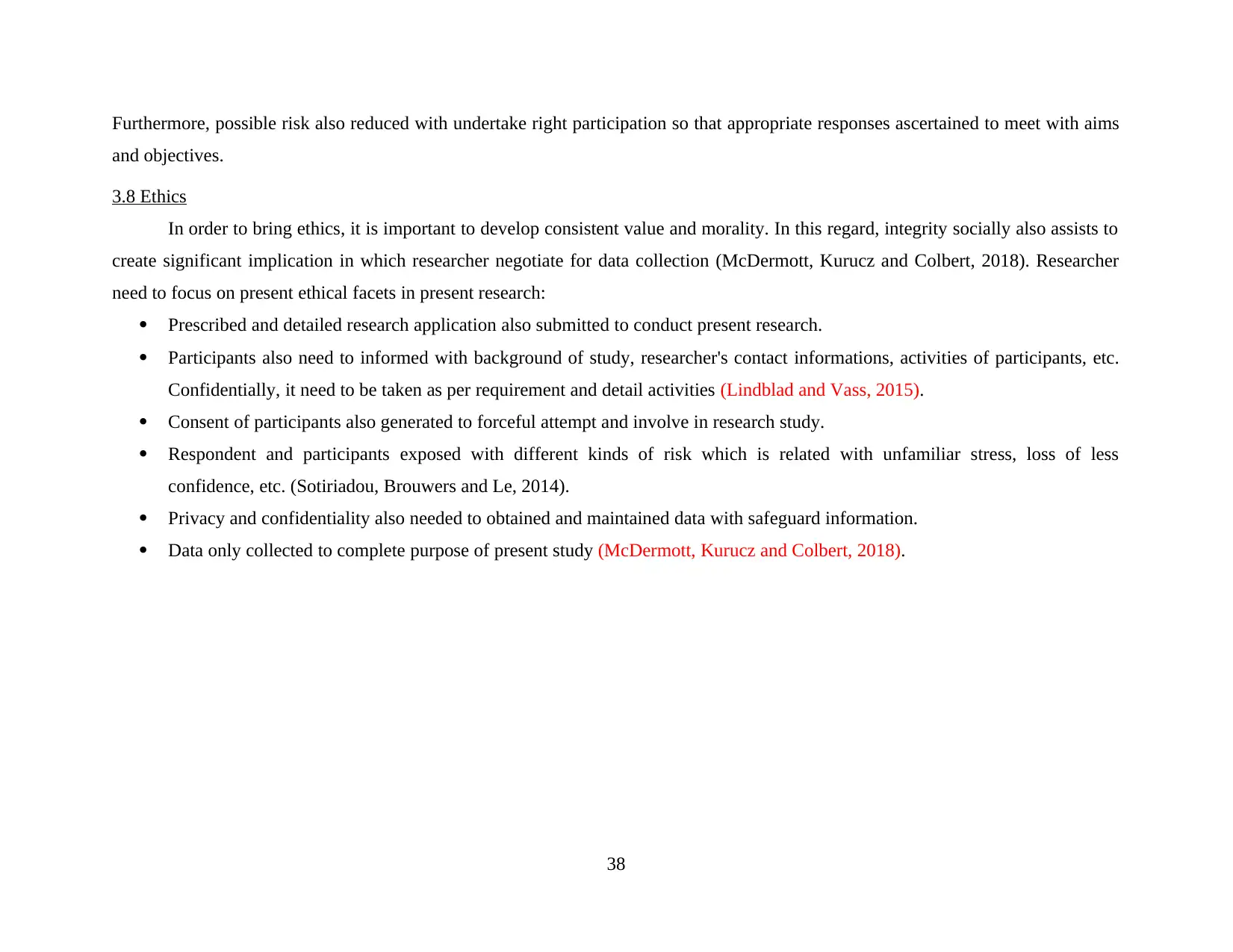
Furthermore, possible risk also reduced with undertake right participation so that appropriate responses ascertained to meet with aims
and objectives.
3.8 Ethics
In order to bring ethics, it is important to develop consistent value and morality. In this regard, integrity socially also assists to
create significant implication in which researcher negotiate for data collection (McDermott, Kurucz and Colbert, 2018). Researcher
need to focus on present ethical facets in present research:
Prescribed and detailed research application also submitted to conduct present research.
Participants also need to informed with background of study, researcher's contact informations, activities of participants, etc.
Confidentially, it need to be taken as per requirement and detail activities (Lindblad and Vass, 2015).
Consent of participants also generated to forceful attempt and involve in research study.
Respondent and participants exposed with different kinds of risk which is related with unfamiliar stress, loss of less
confidence, etc. (Sotiriadou, Brouwers and Le, 2014).
Privacy and confidentiality also needed to obtained and maintained data with safeguard information.
Data only collected to complete purpose of present study (McDermott, Kurucz and Colbert, 2018).
38
and objectives.
3.8 Ethics
In order to bring ethics, it is important to develop consistent value and morality. In this regard, integrity socially also assists to
create significant implication in which researcher negotiate for data collection (McDermott, Kurucz and Colbert, 2018). Researcher
need to focus on present ethical facets in present research:
Prescribed and detailed research application also submitted to conduct present research.
Participants also need to informed with background of study, researcher's contact informations, activities of participants, etc.
Confidentially, it need to be taken as per requirement and detail activities (Lindblad and Vass, 2015).
Consent of participants also generated to forceful attempt and involve in research study.
Respondent and participants exposed with different kinds of risk which is related with unfamiliar stress, loss of less
confidence, etc. (Sotiriadou, Brouwers and Le, 2014).
Privacy and confidentiality also needed to obtained and maintained data with safeguard information.
Data only collected to complete purpose of present study (McDermott, Kurucz and Colbert, 2018).
38
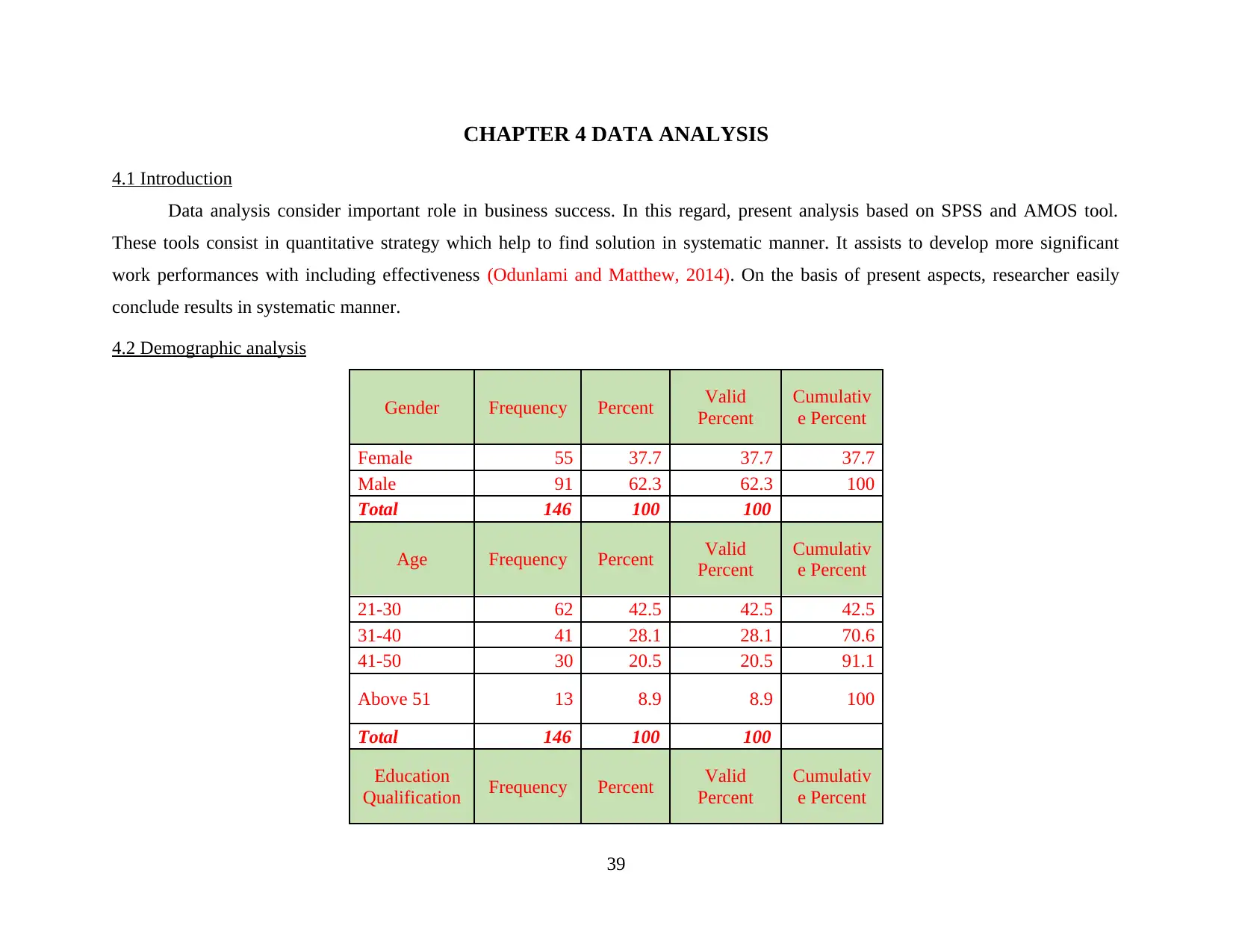
CHAPTER 4 DATA ANALYSIS
4.1 Introduction
Data analysis consider important role in business success. In this regard, present analysis based on SPSS and AMOS tool.
These tools consist in quantitative strategy which help to find solution in systematic manner. It assists to develop more significant
work performances with including effectiveness (Odunlami and Matthew, 2014). On the basis of present aspects, researcher easily
conclude results in systematic manner.
4.2 Demographic analysis
Gender Frequency Percent Valid
Percent
Cumulativ
e Percent
Female 55 37.7 37.7 37.7
Male 91 62.3 62.3 100
Total 146 100 100
Age Frequency Percent Valid
Percent
Cumulativ
e Percent
21-30 62 42.5 42.5 42.5
31-40 41 28.1 28.1 70.6
41-50 30 20.5 20.5 91.1
Above 51 13 8.9 8.9 100
Total 146 100 100
Education
Qualification Frequency Percent Valid
Percent
Cumulativ
e Percent
39
4.1 Introduction
Data analysis consider important role in business success. In this regard, present analysis based on SPSS and AMOS tool.
These tools consist in quantitative strategy which help to find solution in systematic manner. It assists to develop more significant
work performances with including effectiveness (Odunlami and Matthew, 2014). On the basis of present aspects, researcher easily
conclude results in systematic manner.
4.2 Demographic analysis
Gender Frequency Percent Valid
Percent
Cumulativ
e Percent
Female 55 37.7 37.7 37.7
Male 91 62.3 62.3 100
Total 146 100 100
Age Frequency Percent Valid
Percent
Cumulativ
e Percent
21-30 62 42.5 42.5 42.5
31-40 41 28.1 28.1 70.6
41-50 30 20.5 20.5 91.1
Above 51 13 8.9 8.9 100
Total 146 100 100
Education
Qualification Frequency Percent Valid
Percent
Cumulativ
e Percent
39
Paraphrase This Document
Need a fresh take? Get an instant paraphrase of this document with our AI Paraphraser

Bachelor
Degree 79 54.11 54.11 54.11
High School 25 17.12 17.12 71.23
Others 16 10.96 10.96 82.19
Postgraduate 26 17.81 17.81 100.00
Total 146 100 100
Position Frequency Percent Valid
Percent
Cumulativ
e Percent
Manager 68 46.58 46.58 46.58
Owner 31 21.23 21.23 67.81
Senior/Top
Management 39 26.71 26.71 94.52
Supervisor 8 5.48 5.48 100.00
Total 146 100 100
Department Frequency Percent Valid
Percent
Cumulativ
e Percent
Finance /
Human
Resource
10 6.85 6.85 6.85
40
Degree 79 54.11 54.11 54.11
High School 25 17.12 17.12 71.23
Others 16 10.96 10.96 82.19
Postgraduate 26 17.81 17.81 100.00
Total 146 100 100
Position Frequency Percent Valid
Percent
Cumulativ
e Percent
Manager 68 46.58 46.58 46.58
Owner 31 21.23 21.23 67.81
Senior/Top
Management 39 26.71 26.71 94.52
Supervisor 8 5.48 5.48 100.00
Total 146 100 100
Department Frequency Percent Valid
Percent
Cumulativ
e Percent
Finance /
Human
Resource
10 6.85 6.85 6.85
40
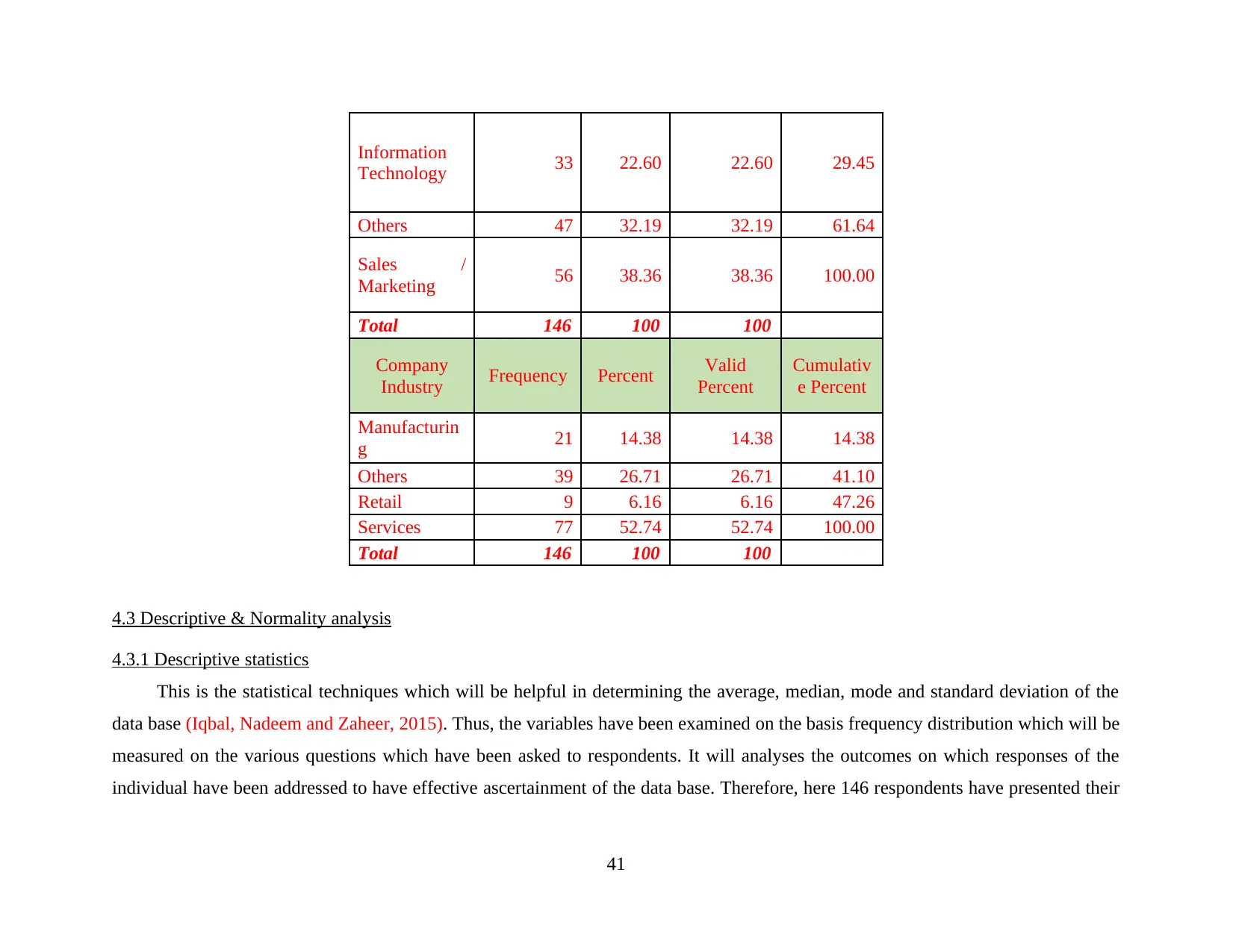
Information
Technology 33 22.60 22.60 29.45
Others 47 32.19 32.19 61.64
Sales /
Marketing 56 38.36 38.36 100.00
Total 146 100 100
Company
Industry Frequency Percent Valid
Percent
Cumulativ
e Percent
Manufacturin
g 21 14.38 14.38 14.38
Others 39 26.71 26.71 41.10
Retail 9 6.16 6.16 47.26
Services 77 52.74 52.74 100.00
Total 146 100 100
4.3 Descriptive & Normality analysis
4.3.1 Descriptive statistics
This is the statistical techniques which will be helpful in determining the average, median, mode and standard deviation of the
data base (Iqbal, Nadeem and Zaheer, 2015). Thus, the variables have been examined on the basis frequency distribution which will be
measured on the various questions which have been asked to respondents. It will analyses the outcomes on which responses of the
individual have been addressed to have effective ascertainment of the data base. Therefore, here 146 respondents have presented their
41
Technology 33 22.60 22.60 29.45
Others 47 32.19 32.19 61.64
Sales /
Marketing 56 38.36 38.36 100.00
Total 146 100 100
Company
Industry Frequency Percent Valid
Percent
Cumulativ
e Percent
Manufacturin
g 21 14.38 14.38 14.38
Others 39 26.71 26.71 41.10
Retail 9 6.16 6.16 47.26
Services 77 52.74 52.74 100.00
Total 146 100 100
4.3 Descriptive & Normality analysis
4.3.1 Descriptive statistics
This is the statistical techniques which will be helpful in determining the average, median, mode and standard deviation of the
data base (Iqbal, Nadeem and Zaheer, 2015). Thus, the variables have been examined on the basis frequency distribution which will be
measured on the various questions which have been asked to respondents. It will analyses the outcomes on which responses of the
individual have been addressed to have effective ascertainment of the data base. Therefore, here 146 respondents have presented their
41
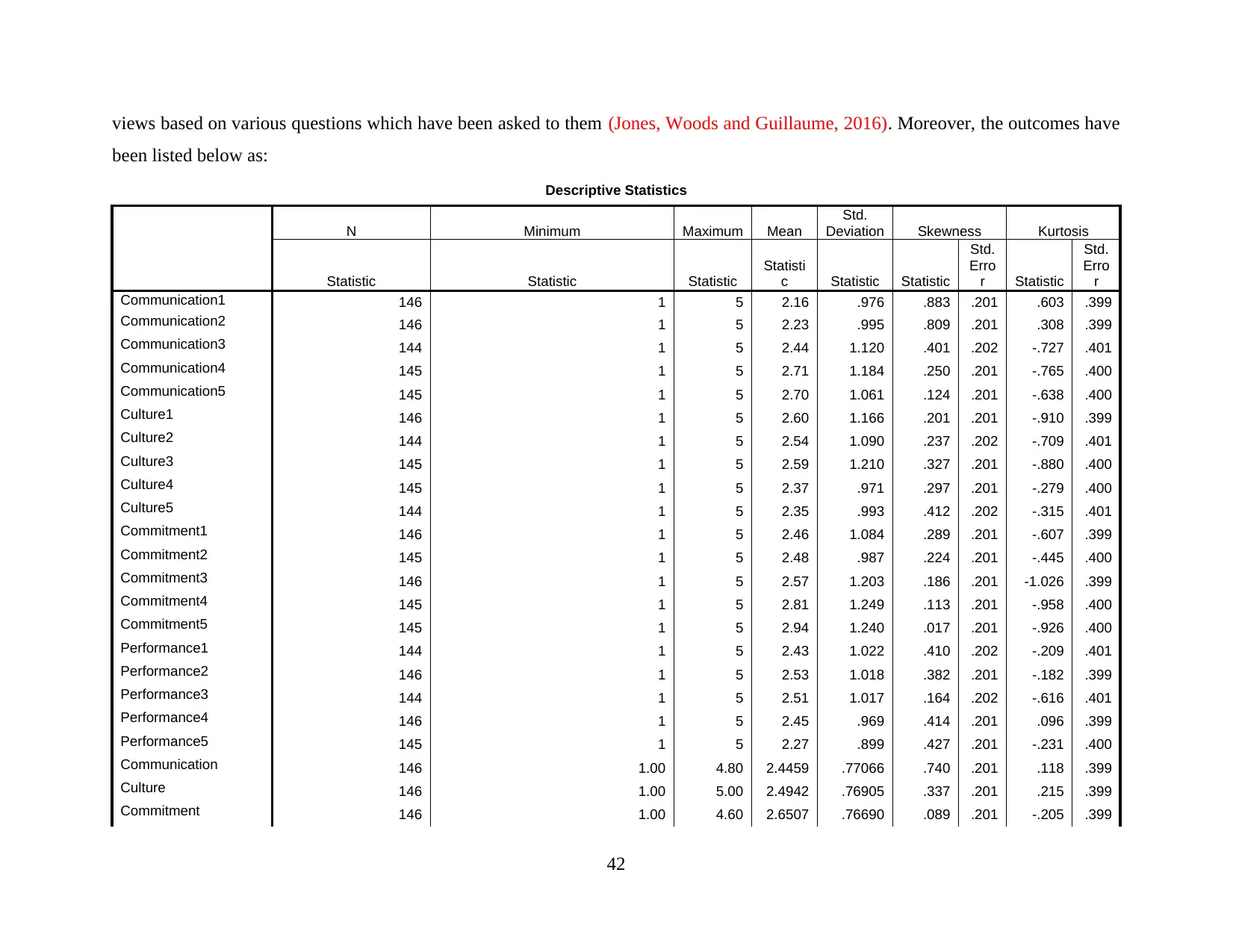
views based on various questions which have been asked to them (Jones, Woods and Guillaume, 2016). Moreover, the outcomes have
been listed below as:
Descriptive Statistics
N Minimum Maximum Mean
Std.
Deviation Skewness Kurtosis
Statistic Statistic Statistic
Statisti
c Statistic Statistic
Std.
Erro
r Statistic
Std.
Erro
r
Communication1 146 1 5 2.16 .976 .883 .201 .603 .399
Communication2 146 1 5 2.23 .995 .809 .201 .308 .399
Communication3 144 1 5 2.44 1.120 .401 .202 -.727 .401
Communication4 145 1 5 2.71 1.184 .250 .201 -.765 .400
Communication5 145 1 5 2.70 1.061 .124 .201 -.638 .400
Culture1 146 1 5 2.60 1.166 .201 .201 -.910 .399
Culture2 144 1 5 2.54 1.090 .237 .202 -.709 .401
Culture3 145 1 5 2.59 1.210 .327 .201 -.880 .400
Culture4 145 1 5 2.37 .971 .297 .201 -.279 .400
Culture5 144 1 5 2.35 .993 .412 .202 -.315 .401
Commitment1 146 1 5 2.46 1.084 .289 .201 -.607 .399
Commitment2 145 1 5 2.48 .987 .224 .201 -.445 .400
Commitment3 146 1 5 2.57 1.203 .186 .201 -1.026 .399
Commitment4 145 1 5 2.81 1.249 .113 .201 -.958 .400
Commitment5 145 1 5 2.94 1.240 .017 .201 -.926 .400
Performance1 144 1 5 2.43 1.022 .410 .202 -.209 .401
Performance2 146 1 5 2.53 1.018 .382 .201 -.182 .399
Performance3 144 1 5 2.51 1.017 .164 .202 -.616 .401
Performance4 146 1 5 2.45 .969 .414 .201 .096 .399
Performance5 145 1 5 2.27 .899 .427 .201 -.231 .400
Communication 146 1.00 4.80 2.4459 .77066 .740 .201 .118 .399
Culture 146 1.00 5.00 2.4942 .76905 .337 .201 .215 .399
Commitment 146 1.00 4.60 2.6507 .76690 .089 .201 -.205 .399
42
been listed below as:
Descriptive Statistics
N Minimum Maximum Mean
Std.
Deviation Skewness Kurtosis
Statistic Statistic Statistic
Statisti
c Statistic Statistic
Std.
Erro
r Statistic
Std.
Erro
r
Communication1 146 1 5 2.16 .976 .883 .201 .603 .399
Communication2 146 1 5 2.23 .995 .809 .201 .308 .399
Communication3 144 1 5 2.44 1.120 .401 .202 -.727 .401
Communication4 145 1 5 2.71 1.184 .250 .201 -.765 .400
Communication5 145 1 5 2.70 1.061 .124 .201 -.638 .400
Culture1 146 1 5 2.60 1.166 .201 .201 -.910 .399
Culture2 144 1 5 2.54 1.090 .237 .202 -.709 .401
Culture3 145 1 5 2.59 1.210 .327 .201 -.880 .400
Culture4 145 1 5 2.37 .971 .297 .201 -.279 .400
Culture5 144 1 5 2.35 .993 .412 .202 -.315 .401
Commitment1 146 1 5 2.46 1.084 .289 .201 -.607 .399
Commitment2 145 1 5 2.48 .987 .224 .201 -.445 .400
Commitment3 146 1 5 2.57 1.203 .186 .201 -1.026 .399
Commitment4 145 1 5 2.81 1.249 .113 .201 -.958 .400
Commitment5 145 1 5 2.94 1.240 .017 .201 -.926 .400
Performance1 144 1 5 2.43 1.022 .410 .202 -.209 .401
Performance2 146 1 5 2.53 1.018 .382 .201 -.182 .399
Performance3 144 1 5 2.51 1.017 .164 .202 -.616 .401
Performance4 146 1 5 2.45 .969 .414 .201 .096 .399
Performance5 145 1 5 2.27 .899 .427 .201 -.231 .400
Communication 146 1.00 4.80 2.4459 .77066 .740 .201 .118 .399
Culture 146 1.00 5.00 2.4942 .76905 .337 .201 .215 .399
Commitment 146 1.00 4.60 2.6507 .76690 .089 .201 -.205 .399
42
Secure Best Marks with AI Grader
Need help grading? Try our AI Grader for instant feedback on your assignments.
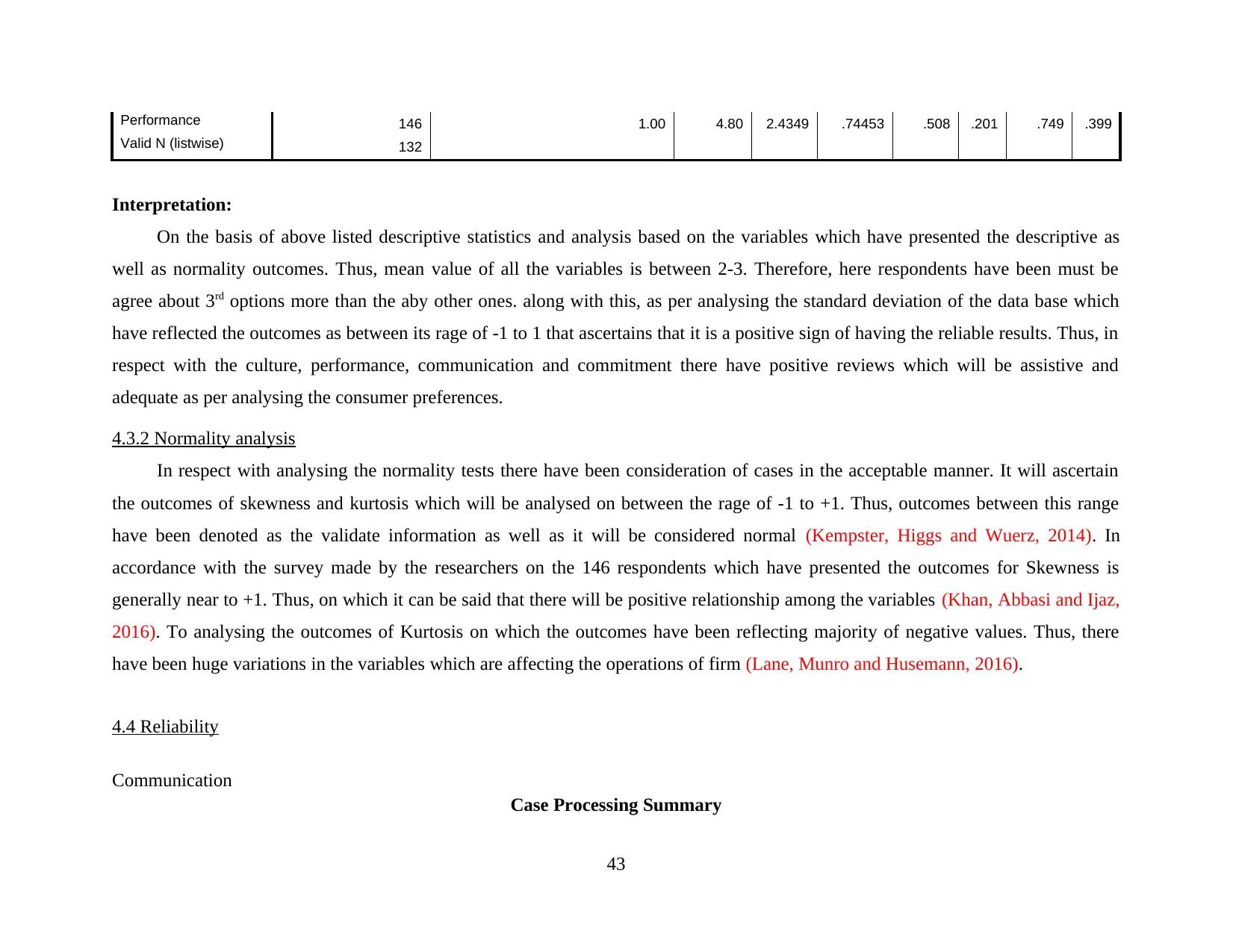
Performance 146 1.00 4.80 2.4349 .74453 .508 .201 .749 .399
Valid N (listwise) 132
Interpretation:
On the basis of above listed descriptive statistics and analysis based on the variables which have presented the descriptive as
well as normality outcomes. Thus, mean value of all the variables is between 2-3. Therefore, here respondents have been must be
agree about 3rd options more than the aby other ones. along with this, as per analysing the standard deviation of the data base which
have reflected the outcomes as between its rage of -1 to 1 that ascertains that it is a positive sign of having the reliable results. Thus, in
respect with the culture, performance, communication and commitment there have positive reviews which will be assistive and
adequate as per analysing the consumer preferences.
4.3.2 Normality analysis
In respect with analysing the normality tests there have been consideration of cases in the acceptable manner. It will ascertain
the outcomes of skewness and kurtosis which will be analysed on between the rage of -1 to +1. Thus, outcomes between this range
have been denoted as the validate information as well as it will be considered normal (Kempster, Higgs and Wuerz, 2014). In
accordance with the survey made by the researchers on the 146 respondents which have presented the outcomes for Skewness is
generally near to +1. Thus, on which it can be said that there will be positive relationship among the variables (Khan, Abbasi and Ijaz,
2016). To analysing the outcomes of Kurtosis on which the outcomes have been reflecting majority of negative values. Thus, there
have been huge variations in the variables which are affecting the operations of firm (Lane, Munro and Husemann, 2016).
4.4 Reliability
Communication
Case Processing Summary
43
Valid N (listwise) 132
Interpretation:
On the basis of above listed descriptive statistics and analysis based on the variables which have presented the descriptive as
well as normality outcomes. Thus, mean value of all the variables is between 2-3. Therefore, here respondents have been must be
agree about 3rd options more than the aby other ones. along with this, as per analysing the standard deviation of the data base which
have reflected the outcomes as between its rage of -1 to 1 that ascertains that it is a positive sign of having the reliable results. Thus, in
respect with the culture, performance, communication and commitment there have positive reviews which will be assistive and
adequate as per analysing the consumer preferences.
4.3.2 Normality analysis
In respect with analysing the normality tests there have been consideration of cases in the acceptable manner. It will ascertain
the outcomes of skewness and kurtosis which will be analysed on between the rage of -1 to +1. Thus, outcomes between this range
have been denoted as the validate information as well as it will be considered normal (Kempster, Higgs and Wuerz, 2014). In
accordance with the survey made by the researchers on the 146 respondents which have presented the outcomes for Skewness is
generally near to +1. Thus, on which it can be said that there will be positive relationship among the variables (Khan, Abbasi and Ijaz,
2016). To analysing the outcomes of Kurtosis on which the outcomes have been reflecting majority of negative values. Thus, there
have been huge variations in the variables which are affecting the operations of firm (Lane, Munro and Husemann, 2016).
4.4 Reliability
Communication
Case Processing Summary
43
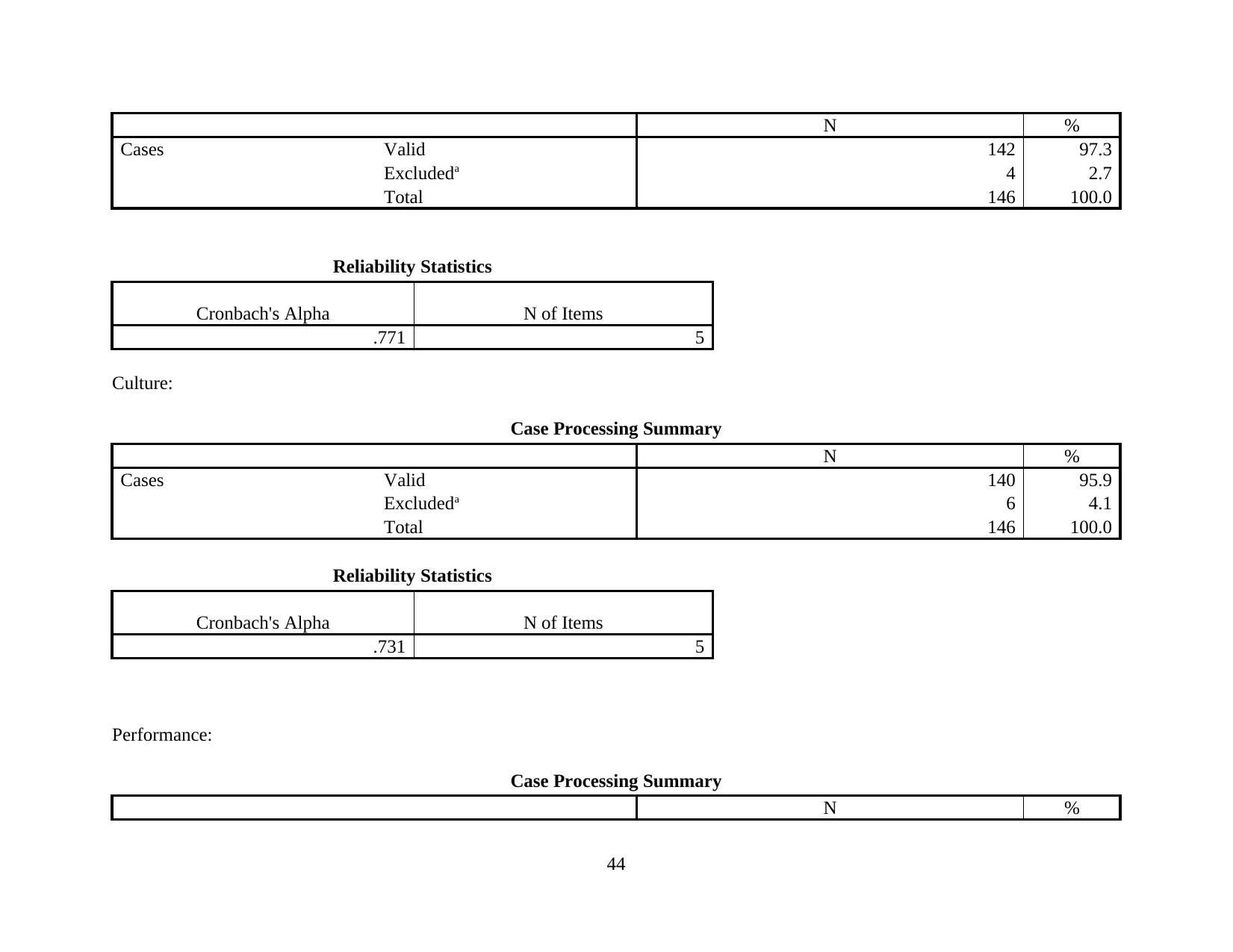
N %
Cases Valid 142 97.3
Excludeda 4 2.7
Total 146 100.0
Reliability Statistics
Cronbach's Alpha N of Items
.771 5
Culture:
Case Processing Summary
N %
Cases Valid 140 95.9
Excludeda 6 4.1
Total 146 100.0
Reliability Statistics
Cronbach's Alpha N of Items
.731 5
Performance:
Case Processing Summary
N %
44
Cases Valid 142 97.3
Excludeda 4 2.7
Total 146 100.0
Reliability Statistics
Cronbach's Alpha N of Items
.771 5
Culture:
Case Processing Summary
N %
Cases Valid 140 95.9
Excludeda 6 4.1
Total 146 100.0
Reliability Statistics
Cronbach's Alpha N of Items
.731 5
Performance:
Case Processing Summary
N %
44
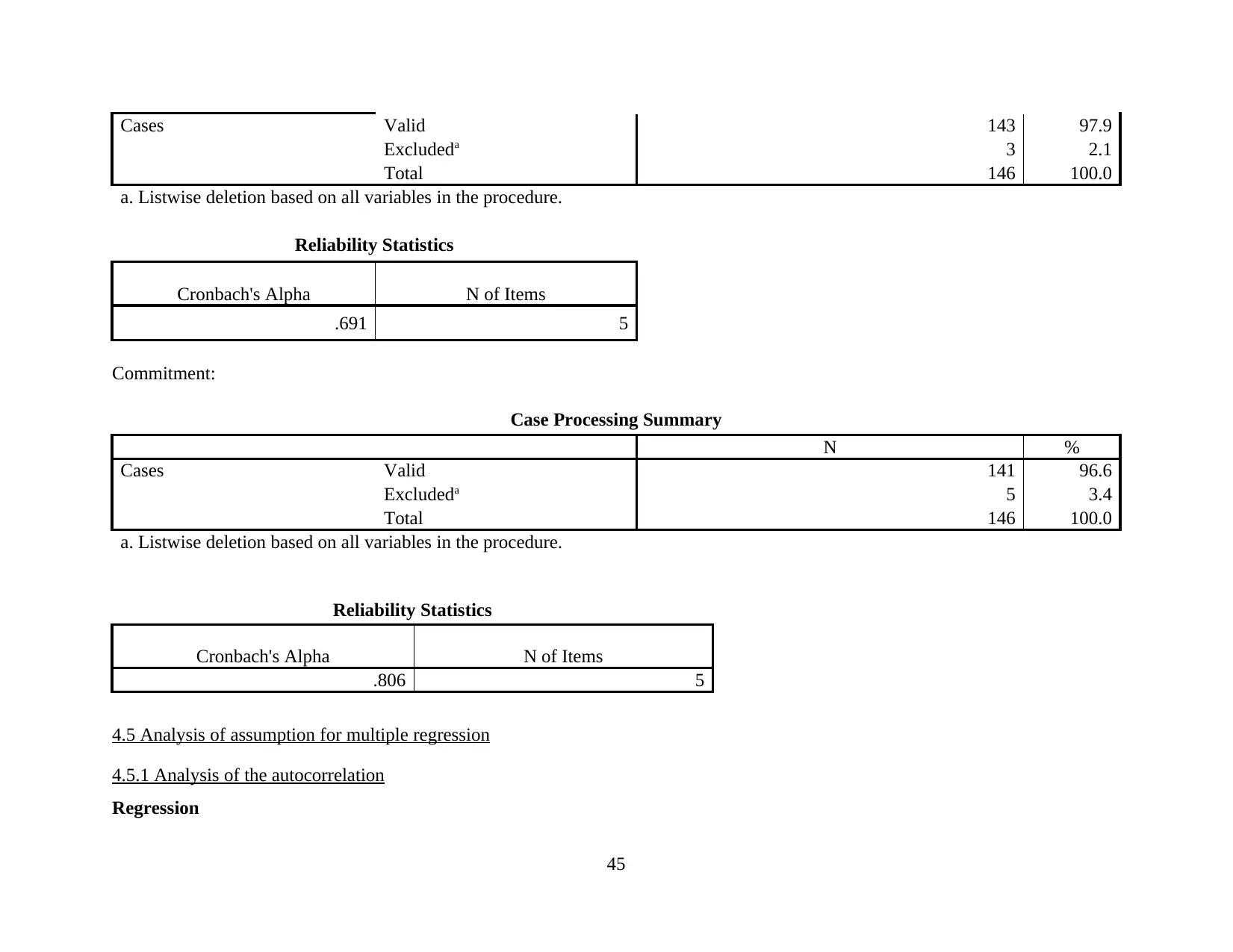
Cases Valid 143 97.9
Excludeda 3 2.1
Total 146 100.0
a. Listwise deletion based on all variables in the procedure.
Reliability Statistics
Cronbach's Alpha N of Items
.691 5
Commitment:
Case Processing Summary
N %
Cases Valid 141 96.6
Excludeda 5 3.4
Total 146 100.0
a. Listwise deletion based on all variables in the procedure.
Reliability Statistics
Cronbach's Alpha N of Items
.806 5
4.5 Analysis of assumption for multiple regression
4.5.1 Analysis of the autocorrelation
Regression
45
Excludeda 3 2.1
Total 146 100.0
a. Listwise deletion based on all variables in the procedure.
Reliability Statistics
Cronbach's Alpha N of Items
.691 5
Commitment:
Case Processing Summary
N %
Cases Valid 141 96.6
Excludeda 5 3.4
Total 146 100.0
a. Listwise deletion based on all variables in the procedure.
Reliability Statistics
Cronbach's Alpha N of Items
.806 5
4.5 Analysis of assumption for multiple regression
4.5.1 Analysis of the autocorrelation
Regression
45
Paraphrase This Document
Need a fresh take? Get an instant paraphrase of this document with our AI Paraphraser
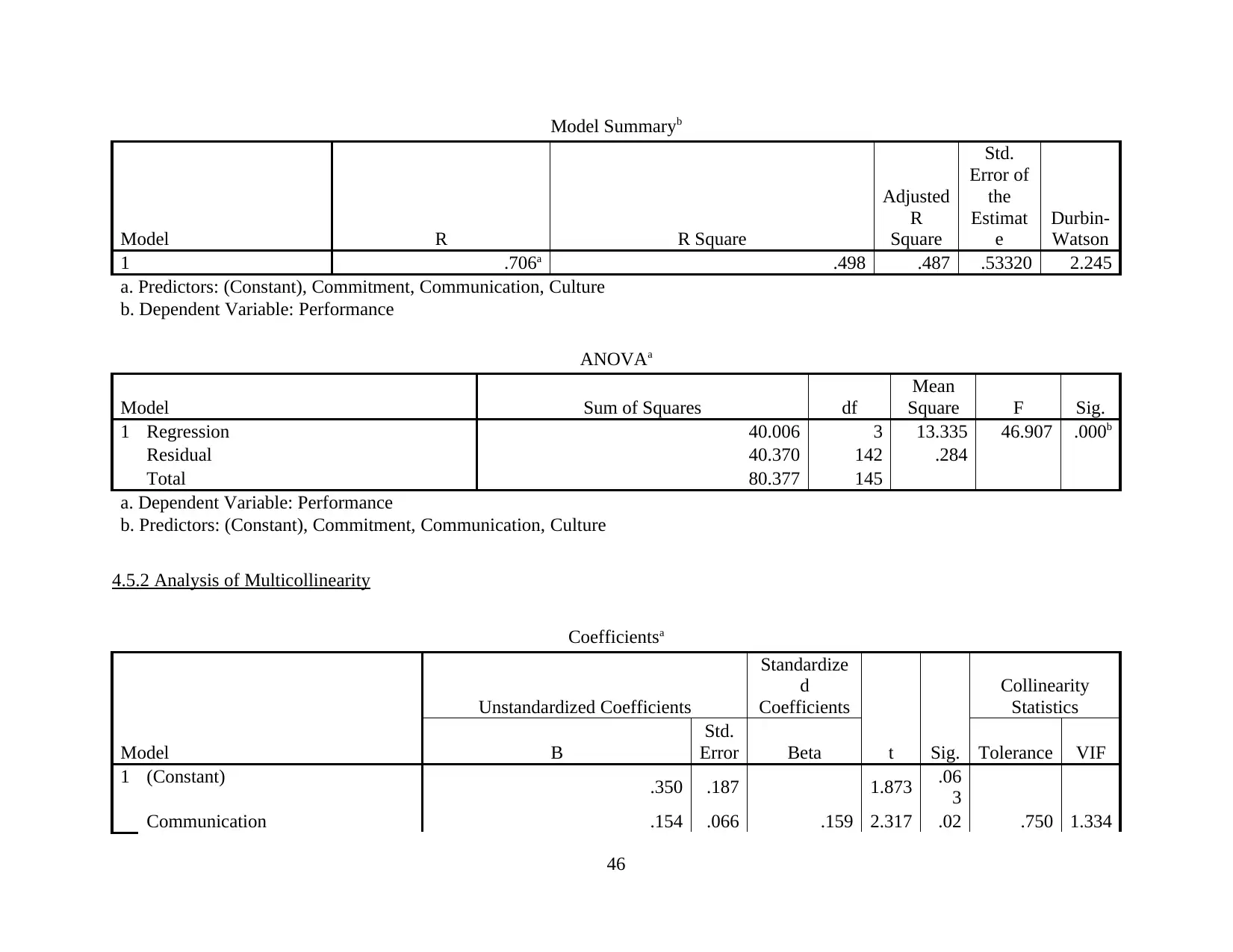
Model Summaryb
Model R R Square
Adjusted
R
Square
Std.
Error of
the
Estimat
e
Durbin-
Watson
1 .706a .498 .487 .53320 2.245
a. Predictors: (Constant), Commitment, Communication, Culture
b. Dependent Variable: Performance
ANOVAa
Model Sum of Squares df
Mean
Square F Sig.
1 Regression 40.006 3 13.335 46.907 .000b
Residual 40.370 142 .284
Total 80.377 145
a. Dependent Variable: Performance
b. Predictors: (Constant), Commitment, Communication, Culture
4.5.2 Analysis of Multicollinearity
Coefficientsa
Model
Unstandardized Coefficients
Standardize
d
Coefficients
t Sig.
Collinearity
Statistics
B
Std.
Error Beta Tolerance VIF
1 (Constant) .350 .187 1.873 .06
3
Communication .154 .066 .159 2.317 .02 .750 1.334
46
Model R R Square
Adjusted
R
Square
Std.
Error of
the
Estimat
e
Durbin-
Watson
1 .706a .498 .487 .53320 2.245
a. Predictors: (Constant), Commitment, Communication, Culture
b. Dependent Variable: Performance
ANOVAa
Model Sum of Squares df
Mean
Square F Sig.
1 Regression 40.006 3 13.335 46.907 .000b
Residual 40.370 142 .284
Total 80.377 145
a. Dependent Variable: Performance
b. Predictors: (Constant), Commitment, Communication, Culture
4.5.2 Analysis of Multicollinearity
Coefficientsa
Model
Unstandardized Coefficients
Standardize
d
Coefficients
t Sig.
Collinearity
Statistics
B
Std.
Error Beta Tolerance VIF
1 (Constant) .350 .187 1.873 .06
3
Communication .154 .066 .159 2.317 .02 .750 1.334
46

2
Culture .180 .081 .186 2.230 .02
7 .510 1.959
Commitment .476 .075 .490 6.382 .00
0 .600 1.667
Collinearity Diagnosticsa
Mode
l Eigenvalue
Condition
Index
Variance Proportions
(Constant) Communication Culture Commitment
1 1 3.871 1.000 .00 .00 .00 .00
2 .057 8.217 .00 .73 .05 .25
3 .045 9.285 .84 .08 .26 .00
4 .027 12.001 .16 .18 .69 .74
Residuals Statisticsa
Minimum Maximum Mean
Std.
Deviation N
Predicted Value 1.1896 3.9408 2.4349 .52527 146
Residual -1.37287 1.62602 .00000 .52765 146
Std. Predicted Value -2.371 2.867 .000 1.000 146
Std. Residual -2.575 3.050 .000 .990 146
a. Dependent Variable: Performance
47
Culture .180 .081 .186 2.230 .02
7 .510 1.959
Commitment .476 .075 .490 6.382 .00
0 .600 1.667
Collinearity Diagnosticsa
Mode
l Eigenvalue
Condition
Index
Variance Proportions
(Constant) Communication Culture Commitment
1 1 3.871 1.000 .00 .00 .00 .00
2 .057 8.217 .00 .73 .05 .25
3 .045 9.285 .84 .08 .26 .00
4 .027 12.001 .16 .18 .69 .74
Residuals Statisticsa
Minimum Maximum Mean
Std.
Deviation N
Predicted Value 1.1896 3.9408 2.4349 .52527 146
Residual -1.37287 1.62602 .00000 .52765 146
Std. Predicted Value -2.371 2.867 .000 1.000 146
Std. Residual -2.575 3.050 .000 .990 146
a. Dependent Variable: Performance
47
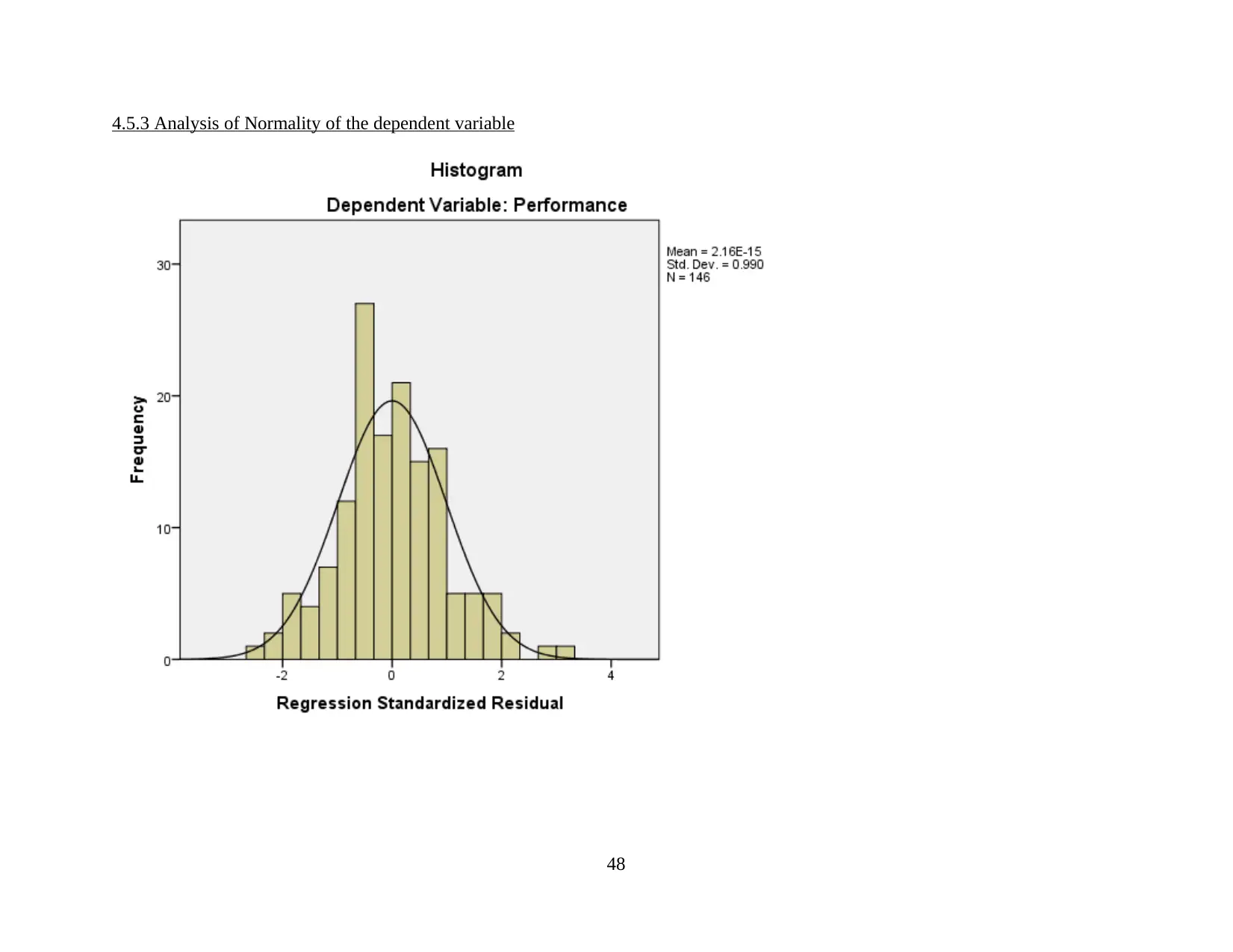
4.5.3 Analysis of Normality of the dependent variable
48
48
Secure Best Marks with AI Grader
Need help grading? Try our AI Grader for instant feedback on your assignments.
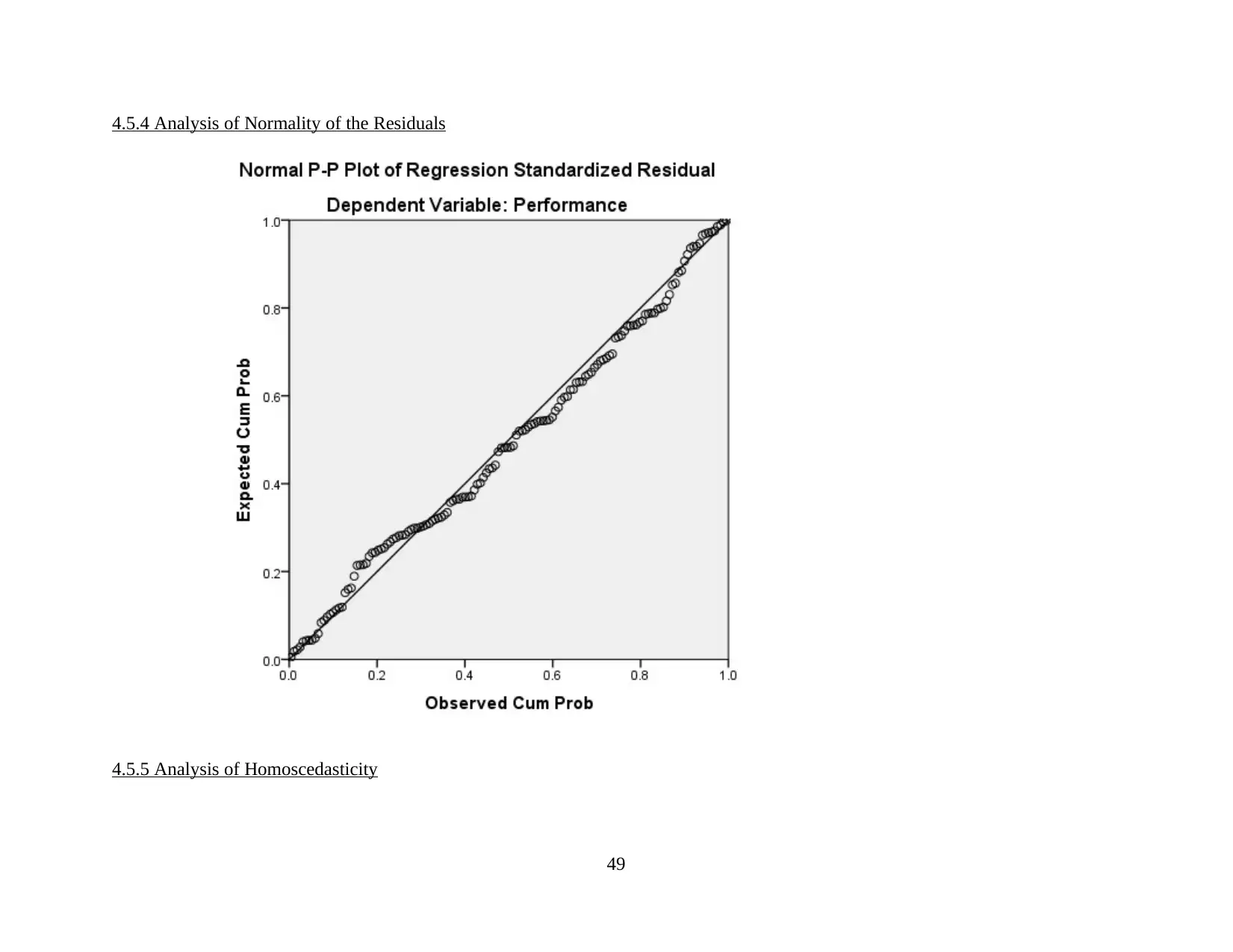
4.5.4 Analysis of Normality of the Residuals
4.5.5 Analysis of Homoscedasticity
49
4.5.5 Analysis of Homoscedasticity
49

50

51
Paraphrase This Document
Need a fresh take? Get an instant paraphrase of this document with our AI Paraphraser

52
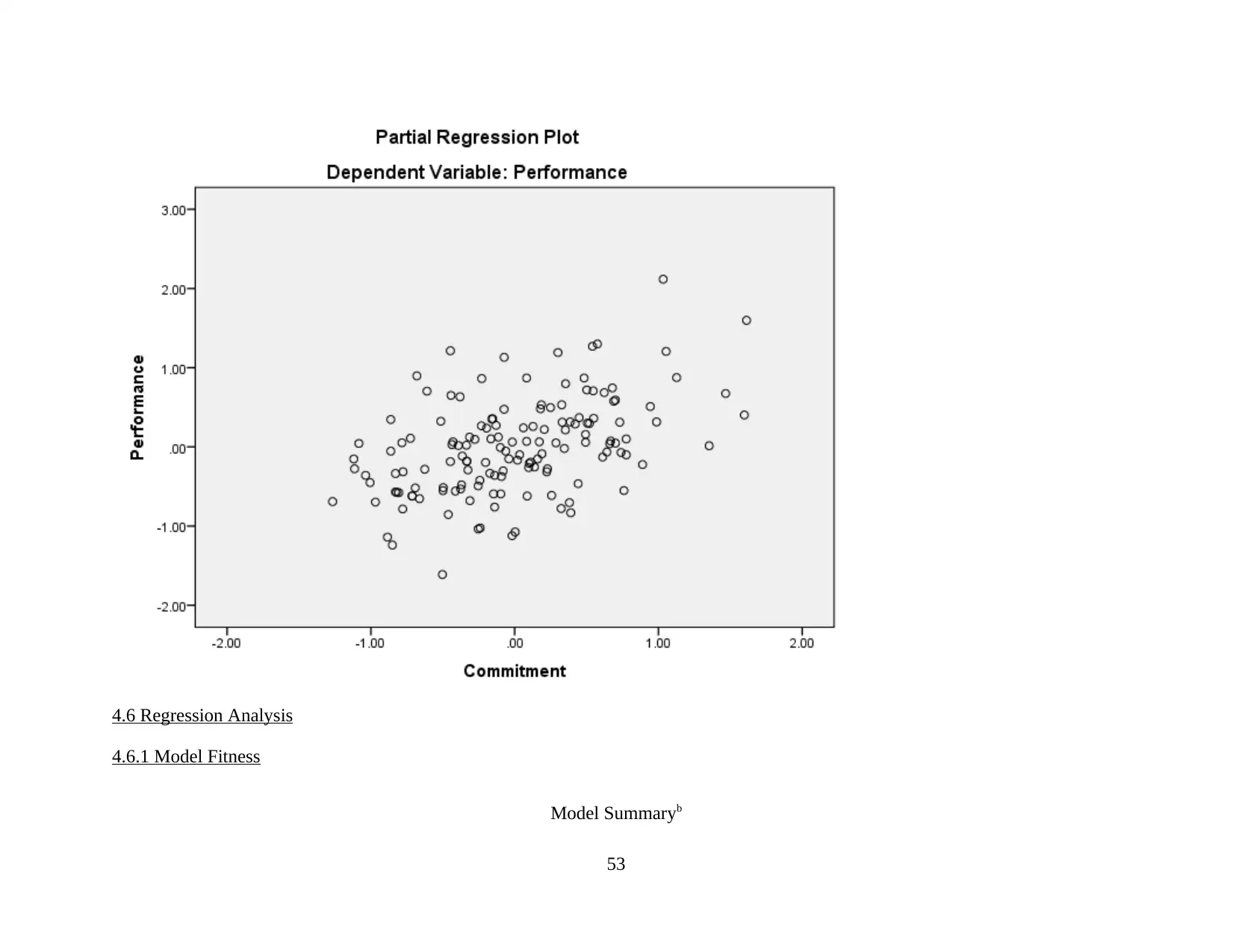
4.6 Regression Analysis
4.6.1 Model Fitness
Model Summaryb
53
4.6.1 Model Fitness
Model Summaryb
53
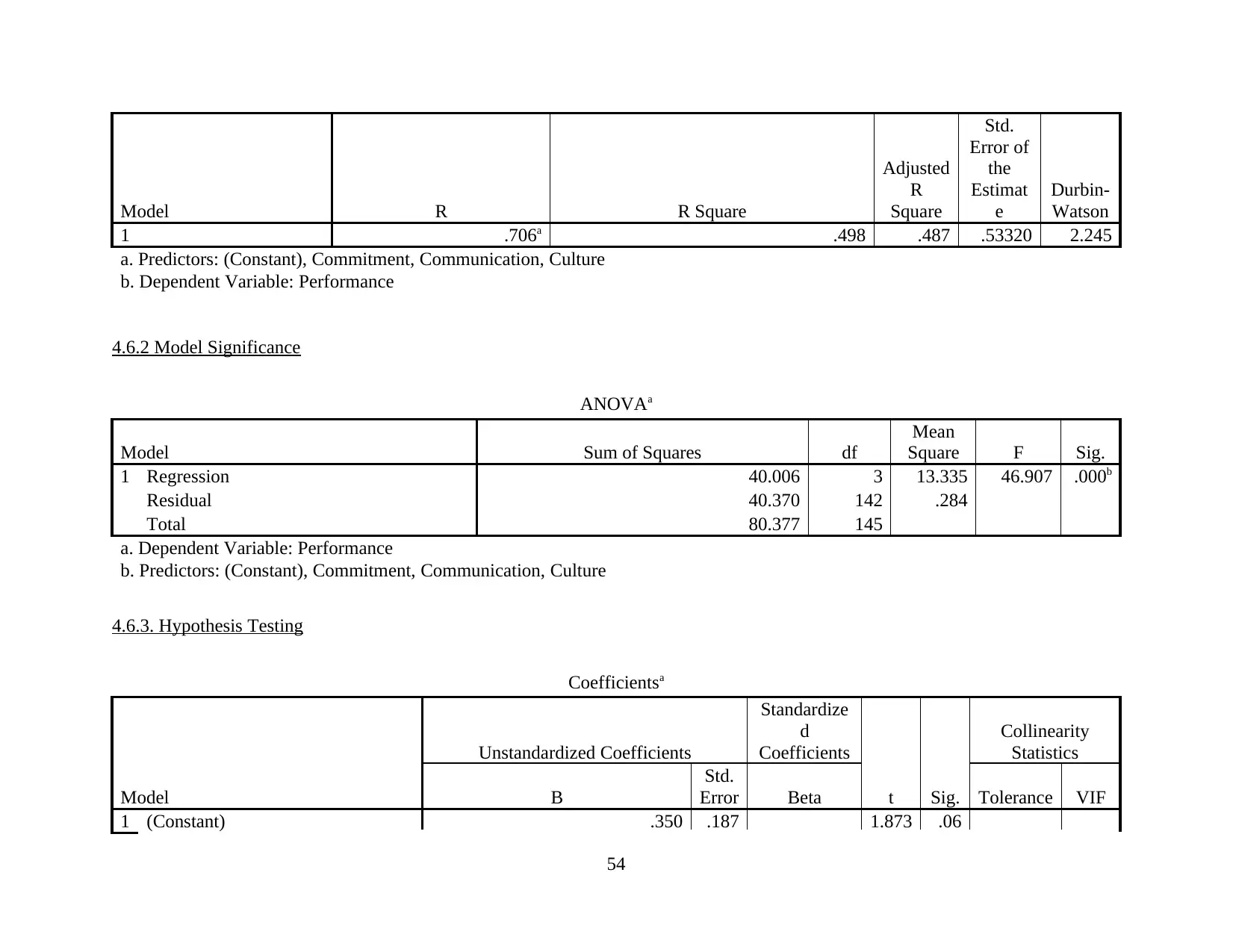
Model R R Square
Adjusted
R
Square
Std.
Error of
the
Estimat
e
Durbin-
Watson
1 .706a .498 .487 .53320 2.245
a. Predictors: (Constant), Commitment, Communication, Culture
b. Dependent Variable: Performance
4.6.2 Model Significance
ANOVAa
Model Sum of Squares df
Mean
Square F Sig.
1 Regression 40.006 3 13.335 46.907 .000b
Residual 40.370 142 .284
Total 80.377 145
a. Dependent Variable: Performance
b. Predictors: (Constant), Commitment, Communication, Culture
4.6.3. Hypothesis Testing
Coefficientsa
Model
Unstandardized Coefficients
Standardize
d
Coefficients
t Sig.
Collinearity
Statistics
B
Std.
Error Beta Tolerance VIF
1 (Constant) .350 .187 1.873 .06
54
Adjusted
R
Square
Std.
Error of
the
Estimat
e
Durbin-
Watson
1 .706a .498 .487 .53320 2.245
a. Predictors: (Constant), Commitment, Communication, Culture
b. Dependent Variable: Performance
4.6.2 Model Significance
ANOVAa
Model Sum of Squares df
Mean
Square F Sig.
1 Regression 40.006 3 13.335 46.907 .000b
Residual 40.370 142 .284
Total 80.377 145
a. Dependent Variable: Performance
b. Predictors: (Constant), Commitment, Communication, Culture
4.6.3. Hypothesis Testing
Coefficientsa
Model
Unstandardized Coefficients
Standardize
d
Coefficients
t Sig.
Collinearity
Statistics
B
Std.
Error Beta Tolerance VIF
1 (Constant) .350 .187 1.873 .06
54
Secure Best Marks with AI Grader
Need help grading? Try our AI Grader for instant feedback on your assignments.
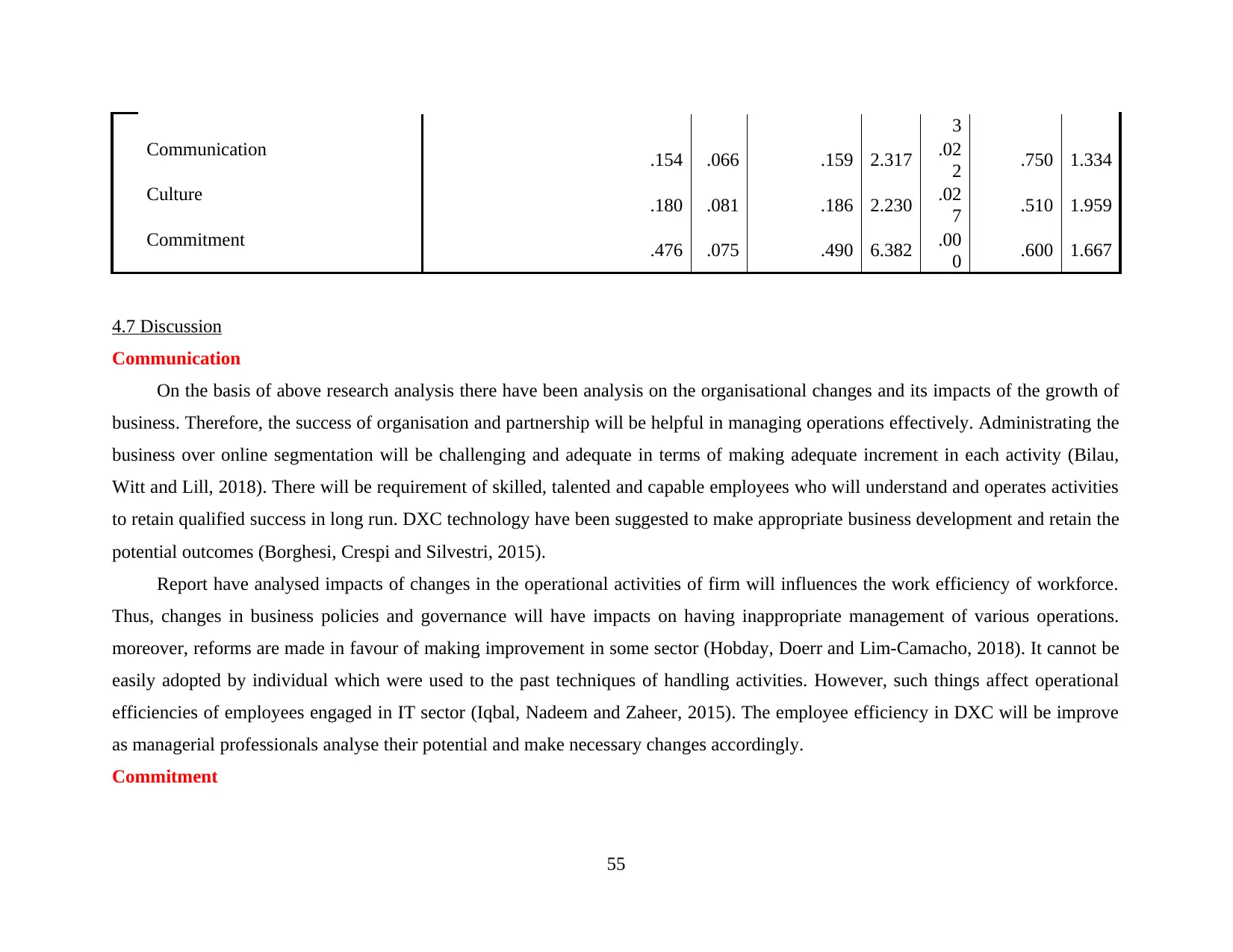
3
Communication .154 .066 .159 2.317 .02
2 .750 1.334
Culture .180 .081 .186 2.230 .02
7 .510 1.959
Commitment .476 .075 .490 6.382 .00
0 .600 1.667
4.7 Discussion
Communication
On the basis of above research analysis there have been analysis on the organisational changes and its impacts of the growth of
business. Therefore, the success of organisation and partnership will be helpful in managing operations effectively. Administrating the
business over online segmentation will be challenging and adequate in terms of making adequate increment in each activity (Bilau,
Witt and Lill, 2018). There will be requirement of skilled, talented and capable employees who will understand and operates activities
to retain qualified success in long run. DXC technology have been suggested to make appropriate business development and retain the
potential outcomes (Borghesi, Crespi and Silvestri, 2015).
Report have analysed impacts of changes in the operational activities of firm will influences the work efficiency of workforce.
Thus, changes in business policies and governance will have impacts on having inappropriate management of various operations.
moreover, reforms are made in favour of making improvement in some sector (Hobday, Doerr and Lim-Camacho, 2018). It cannot be
easily adopted by individual which were used to the past techniques of handling activities. However, such things affect operational
efficiencies of employees engaged in IT sector (Iqbal, Nadeem and Zaheer, 2015). The employee efficiency in DXC will be improve
as managerial professionals analyse their potential and make necessary changes accordingly.
Commitment
55
Communication .154 .066 .159 2.317 .02
2 .750 1.334
Culture .180 .081 .186 2.230 .02
7 .510 1.959
Commitment .476 .075 .490 6.382 .00
0 .600 1.667
4.7 Discussion
Communication
On the basis of above research analysis there have been analysis on the organisational changes and its impacts of the growth of
business. Therefore, the success of organisation and partnership will be helpful in managing operations effectively. Administrating the
business over online segmentation will be challenging and adequate in terms of making adequate increment in each activity (Bilau,
Witt and Lill, 2018). There will be requirement of skilled, talented and capable employees who will understand and operates activities
to retain qualified success in long run. DXC technology have been suggested to make appropriate business development and retain the
potential outcomes (Borghesi, Crespi and Silvestri, 2015).
Report have analysed impacts of changes in the operational activities of firm will influences the work efficiency of workforce.
Thus, changes in business policies and governance will have impacts on having inappropriate management of various operations.
moreover, reforms are made in favour of making improvement in some sector (Hobday, Doerr and Lim-Camacho, 2018). It cannot be
easily adopted by individual which were used to the past techniques of handling activities. However, such things affect operational
efficiencies of employees engaged in IT sector (Iqbal, Nadeem and Zaheer, 2015). The employee efficiency in DXC will be improve
as managerial professionals analyse their potential and make necessary changes accordingly.
Commitment
55
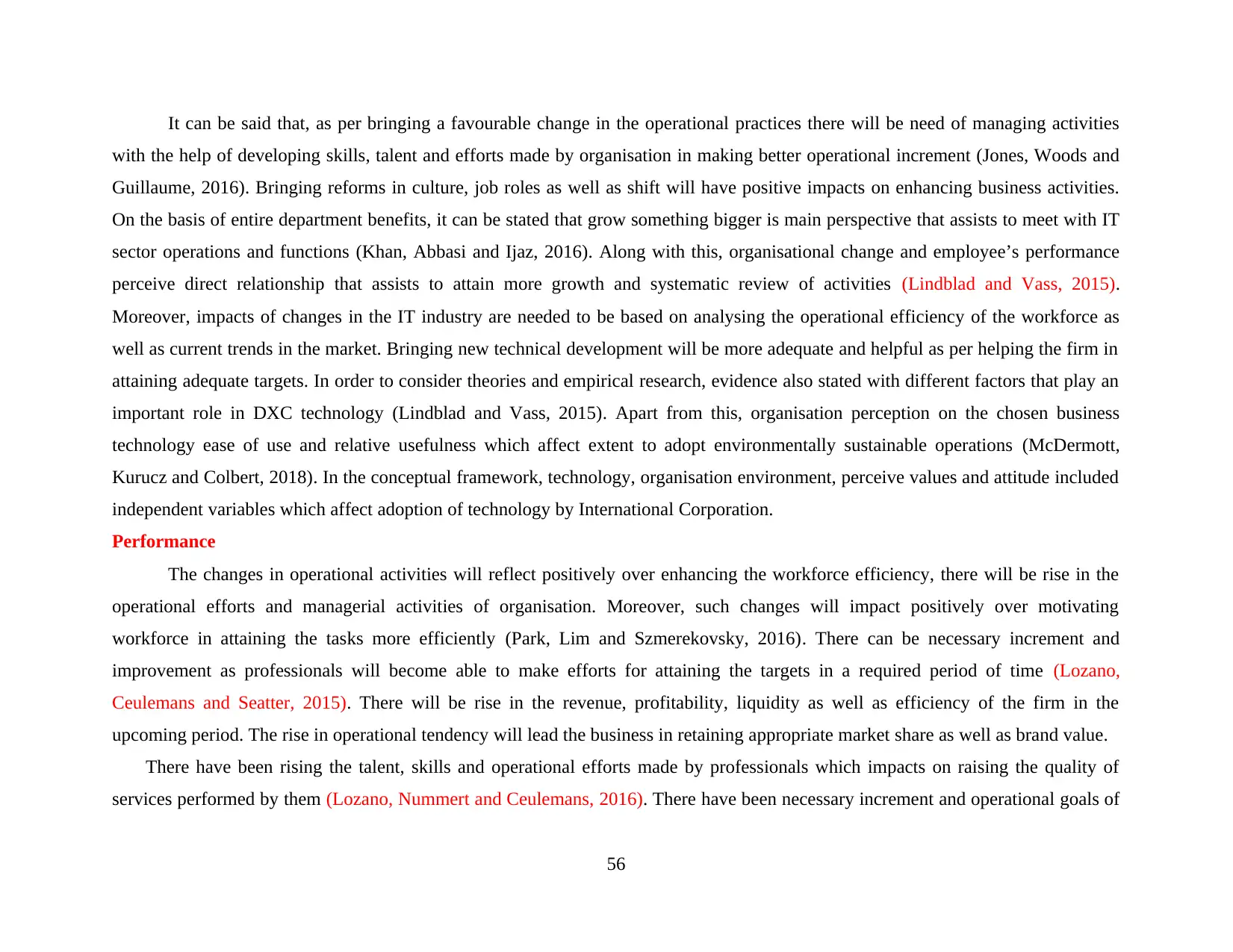
It can be said that, as per bringing a favourable change in the operational practices there will be need of managing activities
with the help of developing skills, talent and efforts made by organisation in making better operational increment (Jones, Woods and
Guillaume, 2016). Bringing reforms in culture, job roles as well as shift will have positive impacts on enhancing business activities.
On the basis of entire department benefits, it can be stated that grow something bigger is main perspective that assists to meet with IT
sector operations and functions (Khan, Abbasi and Ijaz, 2016). Along with this, organisational change and employee’s performance
perceive direct relationship that assists to attain more growth and systematic review of activities (Lindblad and Vass, 2015).
Moreover, impacts of changes in the IT industry are needed to be based on analysing the operational efficiency of the workforce as
well as current trends in the market. Bringing new technical development will be more adequate and helpful as per helping the firm in
attaining adequate targets. In order to consider theories and empirical research, evidence also stated with different factors that play an
important role in DXC technology (Lindblad and Vass, 2015). Apart from this, organisation perception on the chosen business
technology ease of use and relative usefulness which affect extent to adopt environmentally sustainable operations (McDermott,
Kurucz and Colbert, 2018). In the conceptual framework, technology, organisation environment, perceive values and attitude included
independent variables which affect adoption of technology by International Corporation.
Performance
The changes in operational activities will reflect positively over enhancing the workforce efficiency, there will be rise in the
operational efforts and managerial activities of organisation. Moreover, such changes will impact positively over motivating
workforce in attaining the tasks more efficiently (Park, Lim and Szmerekovsky, 2016). There can be necessary increment and
improvement as professionals will become able to make efforts for attaining the targets in a required period of time (Lozano,
Ceulemans and Seatter, 2015). There will be rise in the revenue, profitability, liquidity as well as efficiency of the firm in the
upcoming period. The rise in operational tendency will lead the business in retaining appropriate market share as well as brand value.
There have been rising the talent, skills and operational efforts made by professionals which impacts on raising the quality of
services performed by them (Lozano, Nummert and Ceulemans, 2016). There have been necessary increment and operational goals of
56
with the help of developing skills, talent and efforts made by organisation in making better operational increment (Jones, Woods and
Guillaume, 2016). Bringing reforms in culture, job roles as well as shift will have positive impacts on enhancing business activities.
On the basis of entire department benefits, it can be stated that grow something bigger is main perspective that assists to meet with IT
sector operations and functions (Khan, Abbasi and Ijaz, 2016). Along with this, organisational change and employee’s performance
perceive direct relationship that assists to attain more growth and systematic review of activities (Lindblad and Vass, 2015).
Moreover, impacts of changes in the IT industry are needed to be based on analysing the operational efficiency of the workforce as
well as current trends in the market. Bringing new technical development will be more adequate and helpful as per helping the firm in
attaining adequate targets. In order to consider theories and empirical research, evidence also stated with different factors that play an
important role in DXC technology (Lindblad and Vass, 2015). Apart from this, organisation perception on the chosen business
technology ease of use and relative usefulness which affect extent to adopt environmentally sustainable operations (McDermott,
Kurucz and Colbert, 2018). In the conceptual framework, technology, organisation environment, perceive values and attitude included
independent variables which affect adoption of technology by International Corporation.
Performance
The changes in operational activities will reflect positively over enhancing the workforce efficiency, there will be rise in the
operational efforts and managerial activities of organisation. Moreover, such changes will impact positively over motivating
workforce in attaining the tasks more efficiently (Park, Lim and Szmerekovsky, 2016). There can be necessary increment and
improvement as professionals will become able to make efforts for attaining the targets in a required period of time (Lozano,
Ceulemans and Seatter, 2015). There will be rise in the revenue, profitability, liquidity as well as efficiency of the firm in the
upcoming period. The rise in operational tendency will lead the business in retaining appropriate market share as well as brand value.
There have been rising the talent, skills and operational efforts made by professionals which impacts on raising the quality of
services performed by them (Lozano, Nummert and Ceulemans, 2016). There have been necessary increment and operational goals of
56
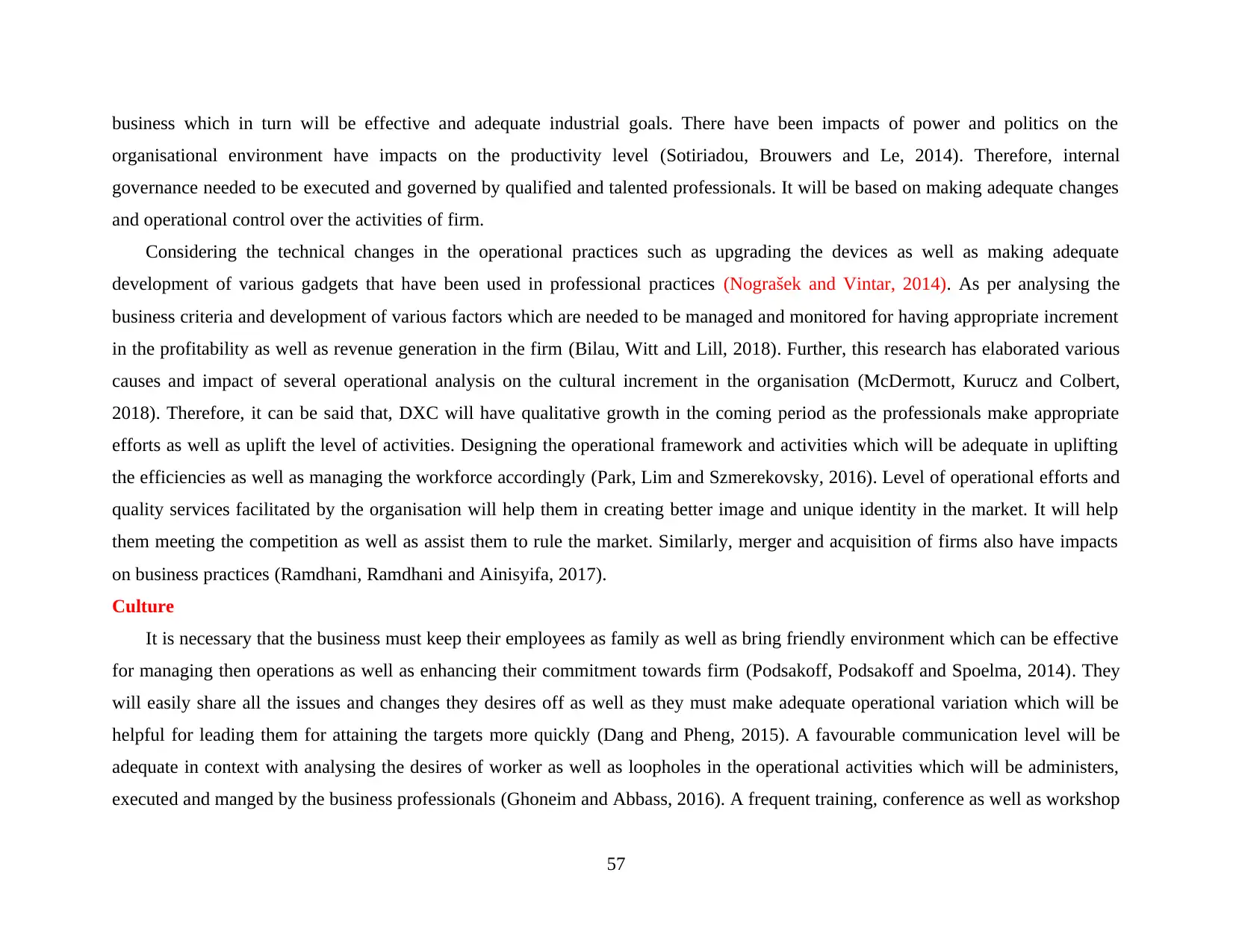
business which in turn will be effective and adequate industrial goals. There have been impacts of power and politics on the
organisational environment have impacts on the productivity level (Sotiriadou, Brouwers and Le, 2014). Therefore, internal
governance needed to be executed and governed by qualified and talented professionals. It will be based on making adequate changes
and operational control over the activities of firm.
Considering the technical changes in the operational practices such as upgrading the devices as well as making adequate
development of various gadgets that have been used in professional practices (Nograšek and Vintar, 2014). As per analysing the
business criteria and development of various factors which are needed to be managed and monitored for having appropriate increment
in the profitability as well as revenue generation in the firm (Bilau, Witt and Lill, 2018). Further, this research has elaborated various
causes and impact of several operational analysis on the cultural increment in the organisation (McDermott, Kurucz and Colbert,
2018). Therefore, it can be said that, DXC will have qualitative growth in the coming period as the professionals make appropriate
efforts as well as uplift the level of activities. Designing the operational framework and activities which will be adequate in uplifting
the efficiencies as well as managing the workforce accordingly (Park, Lim and Szmerekovsky, 2016). Level of operational efforts and
quality services facilitated by the organisation will help them in creating better image and unique identity in the market. It will help
them meeting the competition as well as assist them to rule the market. Similarly, merger and acquisition of firms also have impacts
on business practices (Ramdhani, Ramdhani and Ainisyifa, 2017).
Culture
It is necessary that the business must keep their employees as family as well as bring friendly environment which can be effective
for managing then operations as well as enhancing their commitment towards firm (Podsakoff, Podsakoff and Spoelma, 2014). They
will easily share all the issues and changes they desires off as well as they must make adequate operational variation which will be
helpful for leading them for attaining the targets more quickly (Dang and Pheng, 2015). A favourable communication level will be
adequate in context with analysing the desires of worker as well as loopholes in the operational activities which will be administers,
executed and manged by the business professionals (Ghoneim and Abbass, 2016). A frequent training, conference as well as workshop
57
organisational environment have impacts on the productivity level (Sotiriadou, Brouwers and Le, 2014). Therefore, internal
governance needed to be executed and governed by qualified and talented professionals. It will be based on making adequate changes
and operational control over the activities of firm.
Considering the technical changes in the operational practices such as upgrading the devices as well as making adequate
development of various gadgets that have been used in professional practices (Nograšek and Vintar, 2014). As per analysing the
business criteria and development of various factors which are needed to be managed and monitored for having appropriate increment
in the profitability as well as revenue generation in the firm (Bilau, Witt and Lill, 2018). Further, this research has elaborated various
causes and impact of several operational analysis on the cultural increment in the organisation (McDermott, Kurucz and Colbert,
2018). Therefore, it can be said that, DXC will have qualitative growth in the coming period as the professionals make appropriate
efforts as well as uplift the level of activities. Designing the operational framework and activities which will be adequate in uplifting
the efficiencies as well as managing the workforce accordingly (Park, Lim and Szmerekovsky, 2016). Level of operational efforts and
quality services facilitated by the organisation will help them in creating better image and unique identity in the market. It will help
them meeting the competition as well as assist them to rule the market. Similarly, merger and acquisition of firms also have impacts
on business practices (Ramdhani, Ramdhani and Ainisyifa, 2017).
Culture
It is necessary that the business must keep their employees as family as well as bring friendly environment which can be effective
for managing then operations as well as enhancing their commitment towards firm (Podsakoff, Podsakoff and Spoelma, 2014). They
will easily share all the issues and changes they desires off as well as they must make adequate operational variation which will be
helpful for leading them for attaining the targets more quickly (Dang and Pheng, 2015). A favourable communication level will be
adequate in context with analysing the desires of worker as well as loopholes in the operational activities which will be administers,
executed and manged by the business professionals (Ghoneim and Abbass, 2016). A frequent training, conference as well as workshop
57
Paraphrase This Document
Need a fresh take? Get an instant paraphrase of this document with our AI Paraphraser
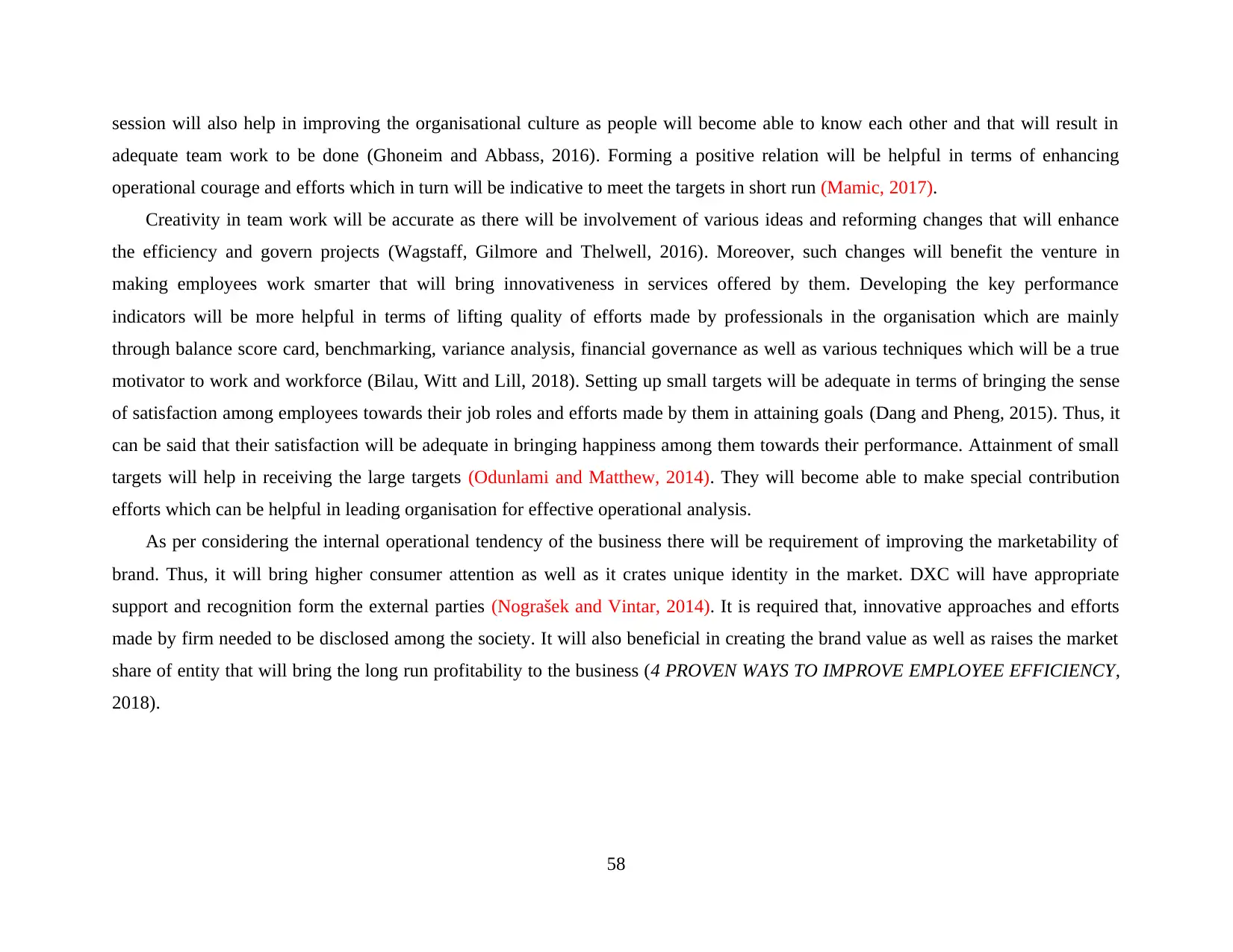
session will also help in improving the organisational culture as people will become able to know each other and that will result in
adequate team work to be done (Ghoneim and Abbass, 2016). Forming a positive relation will be helpful in terms of enhancing
operational courage and efforts which in turn will be indicative to meet the targets in short run (Mamic, 2017).
Creativity in team work will be accurate as there will be involvement of various ideas and reforming changes that will enhance
the efficiency and govern projects (Wagstaff, Gilmore and Thelwell, 2016). Moreover, such changes will benefit the venture in
making employees work smarter that will bring innovativeness in services offered by them. Developing the key performance
indicators will be more helpful in terms of lifting quality of efforts made by professionals in the organisation which are mainly
through balance score card, benchmarking, variance analysis, financial governance as well as various techniques which will be a true
motivator to work and workforce (Bilau, Witt and Lill, 2018). Setting up small targets will be adequate in terms of bringing the sense
of satisfaction among employees towards their job roles and efforts made by them in attaining goals (Dang and Pheng, 2015). Thus, it
can be said that their satisfaction will be adequate in bringing happiness among them towards their performance. Attainment of small
targets will help in receiving the large targets (Odunlami and Matthew, 2014). They will become able to make special contribution
efforts which can be helpful in leading organisation for effective operational analysis.
As per considering the internal operational tendency of the business there will be requirement of improving the marketability of
brand. Thus, it will bring higher consumer attention as well as it crates unique identity in the market. DXC will have appropriate
support and recognition form the external parties (Nograšek and Vintar, 2014). It is required that, innovative approaches and efforts
made by firm needed to be disclosed among the society. It will also beneficial in creating the brand value as well as raises the market
share of entity that will bring the long run profitability to the business (4 PROVEN WAYS TO IMPROVE EMPLOYEE EFFICIENCY,
2018).
58
adequate team work to be done (Ghoneim and Abbass, 2016). Forming a positive relation will be helpful in terms of enhancing
operational courage and efforts which in turn will be indicative to meet the targets in short run (Mamic, 2017).
Creativity in team work will be accurate as there will be involvement of various ideas and reforming changes that will enhance
the efficiency and govern projects (Wagstaff, Gilmore and Thelwell, 2016). Moreover, such changes will benefit the venture in
making employees work smarter that will bring innovativeness in services offered by them. Developing the key performance
indicators will be more helpful in terms of lifting quality of efforts made by professionals in the organisation which are mainly
through balance score card, benchmarking, variance analysis, financial governance as well as various techniques which will be a true
motivator to work and workforce (Bilau, Witt and Lill, 2018). Setting up small targets will be adequate in terms of bringing the sense
of satisfaction among employees towards their job roles and efforts made by them in attaining goals (Dang and Pheng, 2015). Thus, it
can be said that their satisfaction will be adequate in bringing happiness among them towards their performance. Attainment of small
targets will help in receiving the large targets (Odunlami and Matthew, 2014). They will become able to make special contribution
efforts which can be helpful in leading organisation for effective operational analysis.
As per considering the internal operational tendency of the business there will be requirement of improving the marketability of
brand. Thus, it will bring higher consumer attention as well as it crates unique identity in the market. DXC will have appropriate
support and recognition form the external parties (Nograšek and Vintar, 2014). It is required that, innovative approaches and efforts
made by firm needed to be disclosed among the society. It will also beneficial in creating the brand value as well as raises the market
share of entity that will bring the long run profitability to the business (4 PROVEN WAYS TO IMPROVE EMPLOYEE EFFICIENCY,
2018).
58
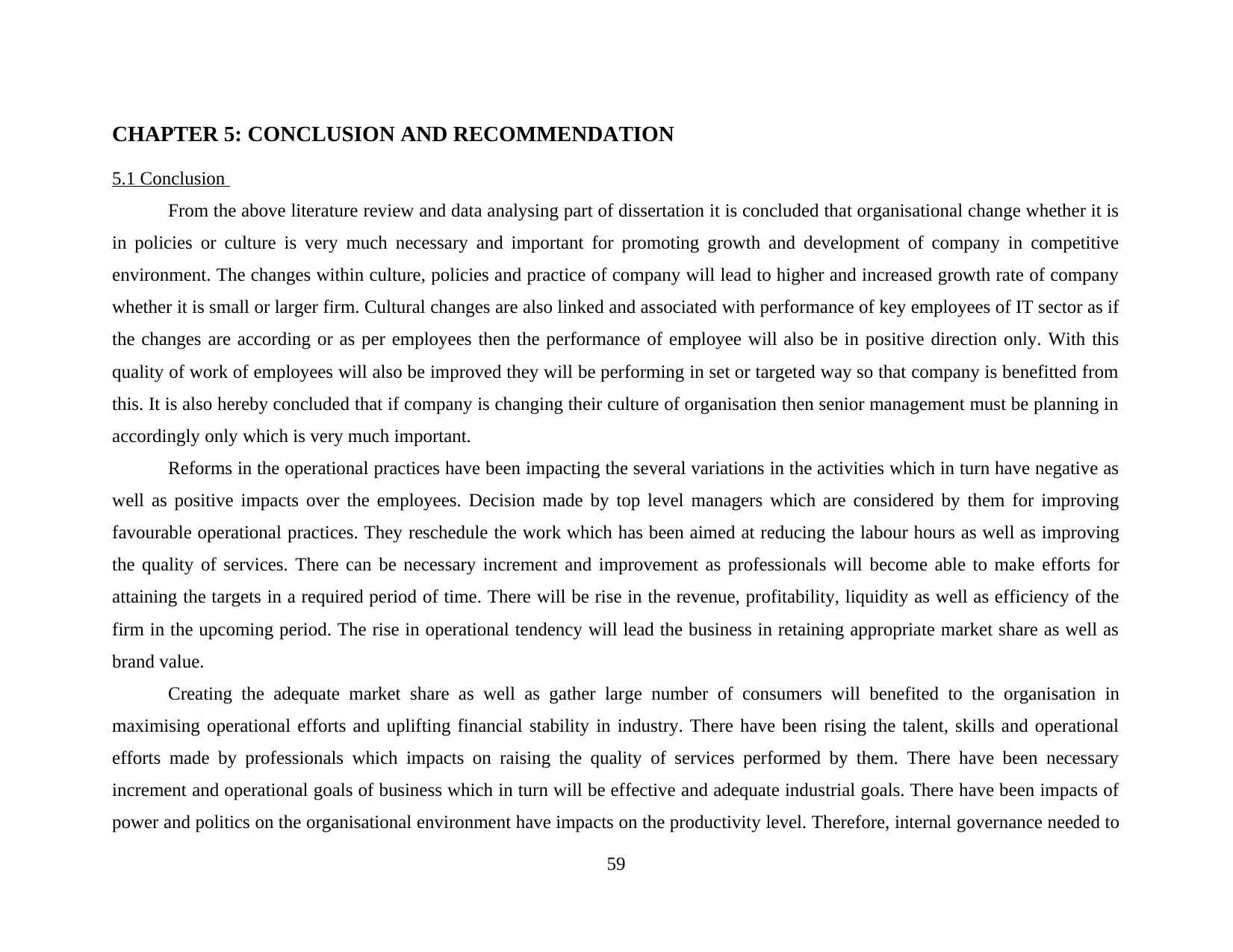
CHAPTER 5: CONCLUSION AND RECOMMENDATION
5.1 Conclusion
From the above literature review and data analysing part of dissertation it is concluded that organisational change whether it is
in policies or culture is very much necessary and important for promoting growth and development of company in competitive
environment. The changes within culture, policies and practice of company will lead to higher and increased growth rate of company
whether it is small or larger firm. Cultural changes are also linked and associated with performance of key employees of IT sector as if
the changes are according or as per employees then the performance of employee will also be in positive direction only. With this
quality of work of employees will also be improved they will be performing in set or targeted way so that company is benefitted from
this. It is also hereby concluded that if company is changing their culture of organisation then senior management must be planning in
accordingly only which is very much important.
Reforms in the operational practices have been impacting the several variations in the activities which in turn have negative as
well as positive impacts over the employees. Decision made by top level managers which are considered by them for improving
favourable operational practices. They reschedule the work which has been aimed at reducing the labour hours as well as improving
the quality of services. There can be necessary increment and improvement as professionals will become able to make efforts for
attaining the targets in a required period of time. There will be rise in the revenue, profitability, liquidity as well as efficiency of the
firm in the upcoming period. The rise in operational tendency will lead the business in retaining appropriate market share as well as
brand value.
Creating the adequate market share as well as gather large number of consumers will benefited to the organisation in
maximising operational efforts and uplifting financial stability in industry. There have been rising the talent, skills and operational
efforts made by professionals which impacts on raising the quality of services performed by them. There have been necessary
increment and operational goals of business which in turn will be effective and adequate industrial goals. There have been impacts of
power and politics on the organisational environment have impacts on the productivity level. Therefore, internal governance needed to
59
5.1 Conclusion
From the above literature review and data analysing part of dissertation it is concluded that organisational change whether it is
in policies or culture is very much necessary and important for promoting growth and development of company in competitive
environment. The changes within culture, policies and practice of company will lead to higher and increased growth rate of company
whether it is small or larger firm. Cultural changes are also linked and associated with performance of key employees of IT sector as if
the changes are according or as per employees then the performance of employee will also be in positive direction only. With this
quality of work of employees will also be improved they will be performing in set or targeted way so that company is benefitted from
this. It is also hereby concluded that if company is changing their culture of organisation then senior management must be planning in
accordingly only which is very much important.
Reforms in the operational practices have been impacting the several variations in the activities which in turn have negative as
well as positive impacts over the employees. Decision made by top level managers which are considered by them for improving
favourable operational practices. They reschedule the work which has been aimed at reducing the labour hours as well as improving
the quality of services. There can be necessary increment and improvement as professionals will become able to make efforts for
attaining the targets in a required period of time. There will be rise in the revenue, profitability, liquidity as well as efficiency of the
firm in the upcoming period. The rise in operational tendency will lead the business in retaining appropriate market share as well as
brand value.
Creating the adequate market share as well as gather large number of consumers will benefited to the organisation in
maximising operational efforts and uplifting financial stability in industry. There have been rising the talent, skills and operational
efforts made by professionals which impacts on raising the quality of services performed by them. There have been necessary
increment and operational goals of business which in turn will be effective and adequate industrial goals. There have been impacts of
power and politics on the organisational environment have impacts on the productivity level. Therefore, internal governance needed to
59
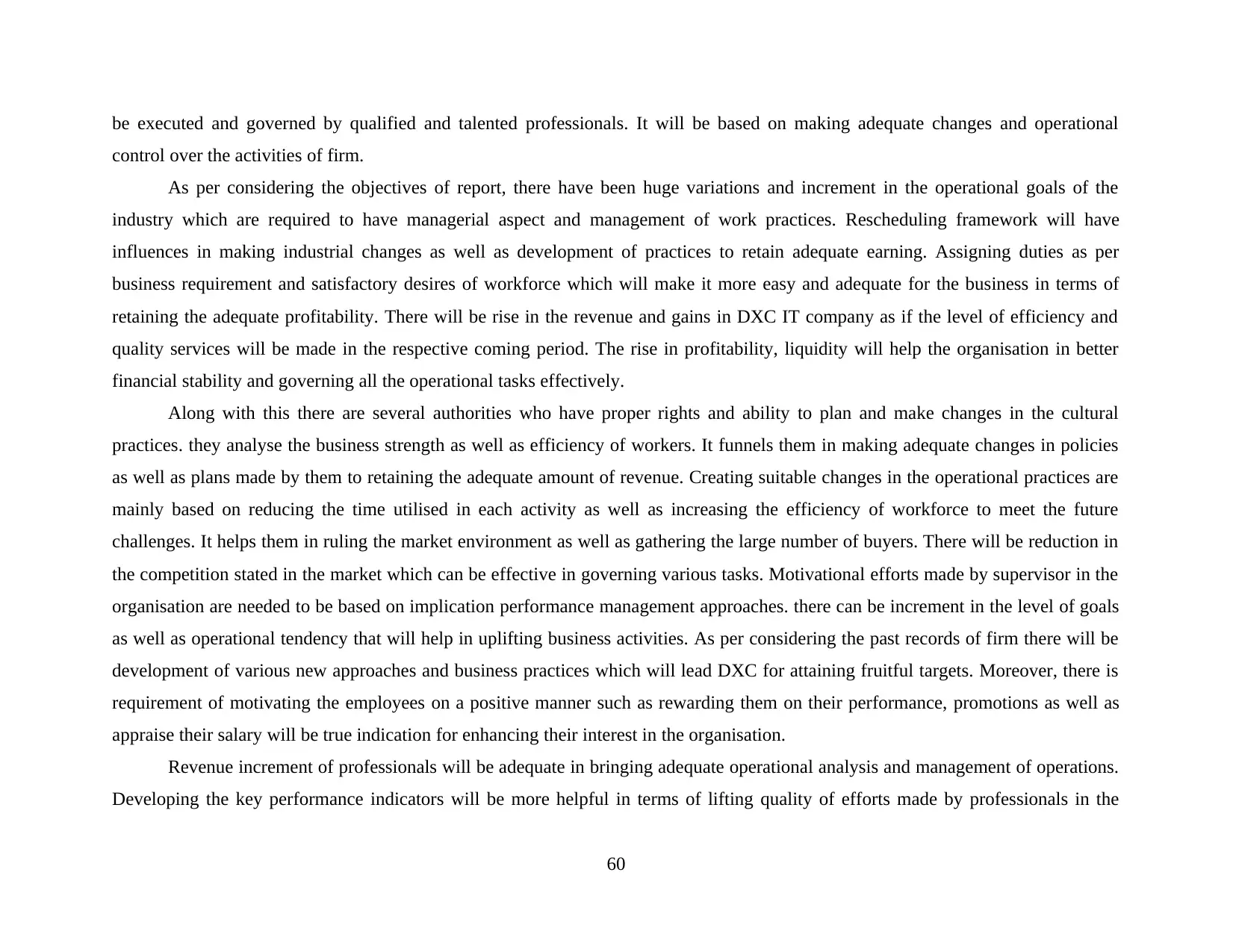
be executed and governed by qualified and talented professionals. It will be based on making adequate changes and operational
control over the activities of firm.
As per considering the objectives of report, there have been huge variations and increment in the operational goals of the
industry which are required to have managerial aspect and management of work practices. Rescheduling framework will have
influences in making industrial changes as well as development of practices to retain adequate earning. Assigning duties as per
business requirement and satisfactory desires of workforce which will make it more easy and adequate for the business in terms of
retaining the adequate profitability. There will be rise in the revenue and gains in DXC IT company as if the level of efficiency and
quality services will be made in the respective coming period. The rise in profitability, liquidity will help the organisation in better
financial stability and governing all the operational tasks effectively.
Along with this there are several authorities who have proper rights and ability to plan and make changes in the cultural
practices. they analyse the business strength as well as efficiency of workers. It funnels them in making adequate changes in policies
as well as plans made by them to retaining the adequate amount of revenue. Creating suitable changes in the operational practices are
mainly based on reducing the time utilised in each activity as well as increasing the efficiency of workforce to meet the future
challenges. It helps them in ruling the market environment as well as gathering the large number of buyers. There will be reduction in
the competition stated in the market which can be effective in governing various tasks. Motivational efforts made by supervisor in the
organisation are needed to be based on implication performance management approaches. there can be increment in the level of goals
as well as operational tendency that will help in uplifting business activities. As per considering the past records of firm there will be
development of various new approaches and business practices which will lead DXC for attaining fruitful targets. Moreover, there is
requirement of motivating the employees on a positive manner such as rewarding them on their performance, promotions as well as
appraise their salary will be true indication for enhancing their interest in the organisation.
Revenue increment of professionals will be adequate in bringing adequate operational analysis and management of operations.
Developing the key performance indicators will be more helpful in terms of lifting quality of efforts made by professionals in the
60
control over the activities of firm.
As per considering the objectives of report, there have been huge variations and increment in the operational goals of the
industry which are required to have managerial aspect and management of work practices. Rescheduling framework will have
influences in making industrial changes as well as development of practices to retain adequate earning. Assigning duties as per
business requirement and satisfactory desires of workforce which will make it more easy and adequate for the business in terms of
retaining the adequate profitability. There will be rise in the revenue and gains in DXC IT company as if the level of efficiency and
quality services will be made in the respective coming period. The rise in profitability, liquidity will help the organisation in better
financial stability and governing all the operational tasks effectively.
Along with this there are several authorities who have proper rights and ability to plan and make changes in the cultural
practices. they analyse the business strength as well as efficiency of workers. It funnels them in making adequate changes in policies
as well as plans made by them to retaining the adequate amount of revenue. Creating suitable changes in the operational practices are
mainly based on reducing the time utilised in each activity as well as increasing the efficiency of workforce to meet the future
challenges. It helps them in ruling the market environment as well as gathering the large number of buyers. There will be reduction in
the competition stated in the market which can be effective in governing various tasks. Motivational efforts made by supervisor in the
organisation are needed to be based on implication performance management approaches. there can be increment in the level of goals
as well as operational tendency that will help in uplifting business activities. As per considering the past records of firm there will be
development of various new approaches and business practices which will lead DXC for attaining fruitful targets. Moreover, there is
requirement of motivating the employees on a positive manner such as rewarding them on their performance, promotions as well as
appraise their salary will be true indication for enhancing their interest in the organisation.
Revenue increment of professionals will be adequate in bringing adequate operational analysis and management of operations.
Developing the key performance indicators will be more helpful in terms of lifting quality of efforts made by professionals in the
60
Secure Best Marks with AI Grader
Need help grading? Try our AI Grader for instant feedback on your assignments.
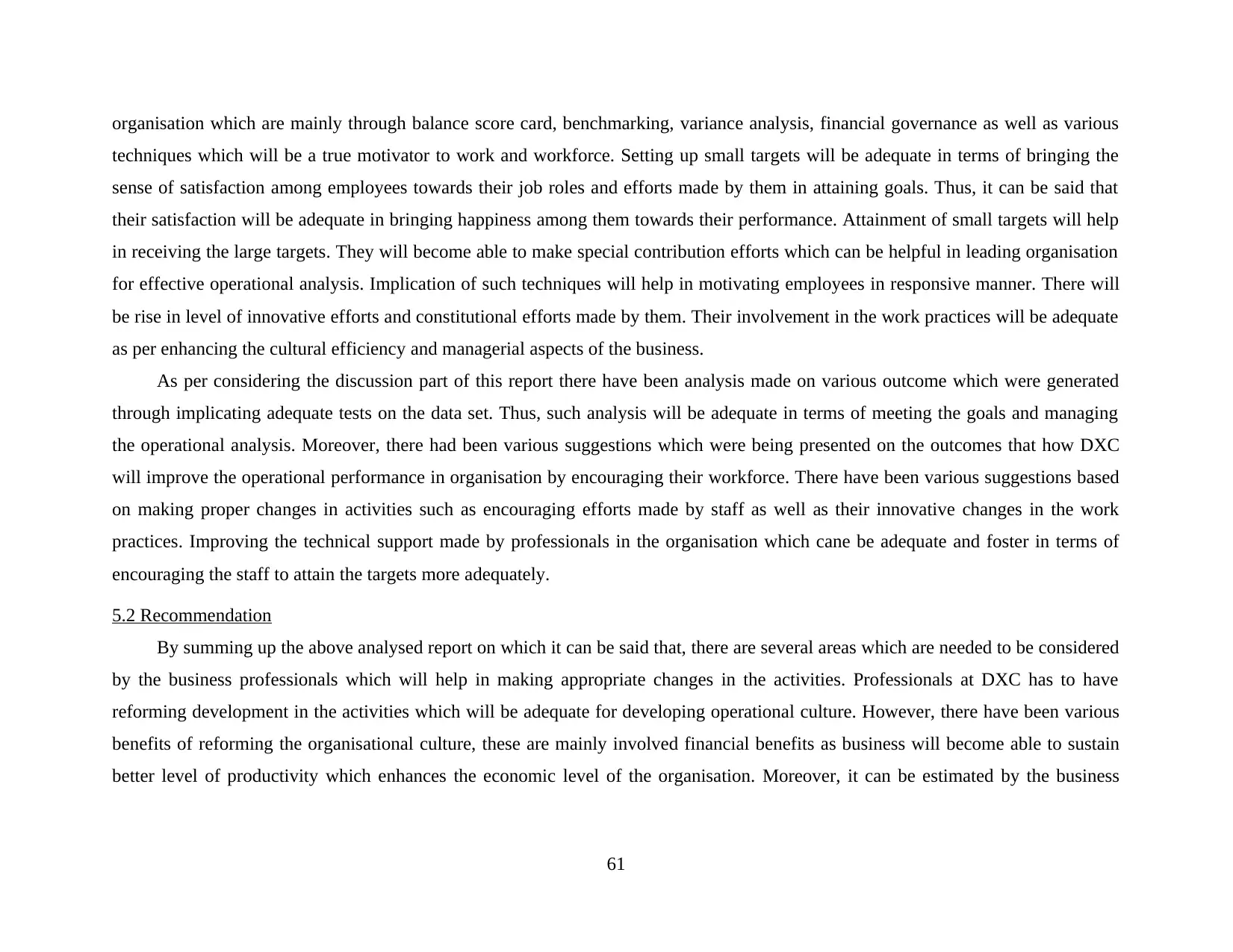
organisation which are mainly through balance score card, benchmarking, variance analysis, financial governance as well as various
techniques which will be a true motivator to work and workforce. Setting up small targets will be adequate in terms of bringing the
sense of satisfaction among employees towards their job roles and efforts made by them in attaining goals. Thus, it can be said that
their satisfaction will be adequate in bringing happiness among them towards their performance. Attainment of small targets will help
in receiving the large targets. They will become able to make special contribution efforts which can be helpful in leading organisation
for effective operational analysis. Implication of such techniques will help in motivating employees in responsive manner. There will
be rise in level of innovative efforts and constitutional efforts made by them. Their involvement in the work practices will be adequate
as per enhancing the cultural efficiency and managerial aspects of the business.
As per considering the discussion part of this report there have been analysis made on various outcome which were generated
through implicating adequate tests on the data set. Thus, such analysis will be adequate in terms of meeting the goals and managing
the operational analysis. Moreover, there had been various suggestions which were being presented on the outcomes that how DXC
will improve the operational performance in organisation by encouraging their workforce. There have been various suggestions based
on making proper changes in activities such as encouraging efforts made by staff as well as their innovative changes in the work
practices. Improving the technical support made by professionals in the organisation which cane be adequate and foster in terms of
encouraging the staff to attain the targets more adequately.
5.2 Recommendation
By summing up the above analysed report on which it can be said that, there are several areas which are needed to be considered
by the business professionals which will help in making appropriate changes in the activities. Professionals at DXC has to have
reforming development in the activities which will be adequate for developing operational culture. However, there have been various
benefits of reforming the organisational culture, these are mainly involved financial benefits as business will become able to sustain
better level of productivity which enhances the economic level of the organisation. Moreover, it can be estimated by the business
61
techniques which will be a true motivator to work and workforce. Setting up small targets will be adequate in terms of bringing the
sense of satisfaction among employees towards their job roles and efforts made by them in attaining goals. Thus, it can be said that
their satisfaction will be adequate in bringing happiness among them towards their performance. Attainment of small targets will help
in receiving the large targets. They will become able to make special contribution efforts which can be helpful in leading organisation
for effective operational analysis. Implication of such techniques will help in motivating employees in responsive manner. There will
be rise in level of innovative efforts and constitutional efforts made by them. Their involvement in the work practices will be adequate
as per enhancing the cultural efficiency and managerial aspects of the business.
As per considering the discussion part of this report there have been analysis made on various outcome which were generated
through implicating adequate tests on the data set. Thus, such analysis will be adequate in terms of meeting the goals and managing
the operational analysis. Moreover, there had been various suggestions which were being presented on the outcomes that how DXC
will improve the operational performance in organisation by encouraging their workforce. There have been various suggestions based
on making proper changes in activities such as encouraging efforts made by staff as well as their innovative changes in the work
practices. Improving the technical support made by professionals in the organisation which cane be adequate and foster in terms of
encouraging the staff to attain the targets more adequately.
5.2 Recommendation
By summing up the above analysed report on which it can be said that, there are several areas which are needed to be considered
by the business professionals which will help in making appropriate changes in the activities. Professionals at DXC has to have
reforming development in the activities which will be adequate for developing operational culture. However, there have been various
benefits of reforming the organisational culture, these are mainly involved financial benefits as business will become able to sustain
better level of productivity which enhances the economic level of the organisation. Moreover, it can be estimated by the business
61
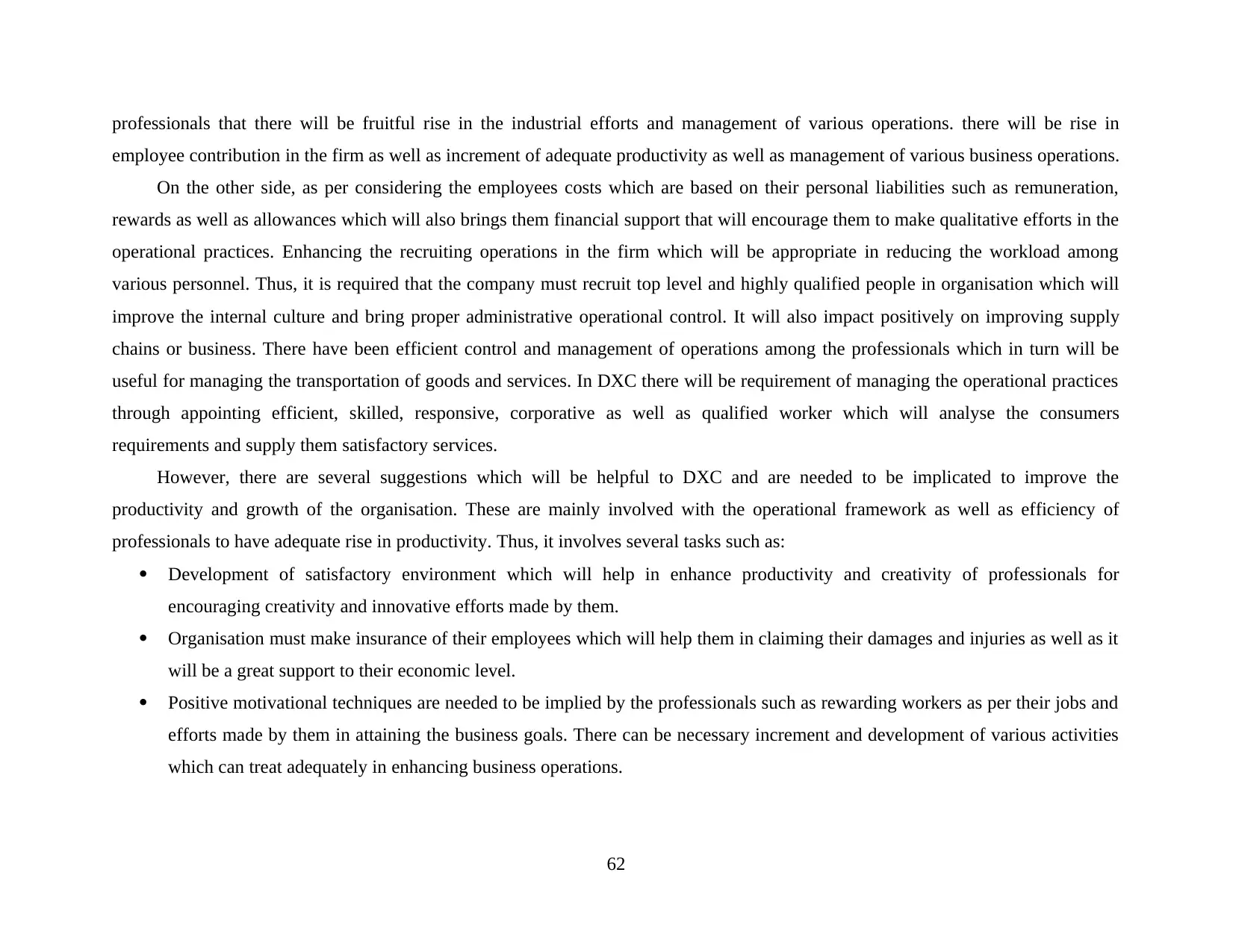
professionals that there will be fruitful rise in the industrial efforts and management of various operations. there will be rise in
employee contribution in the firm as well as increment of adequate productivity as well as management of various business operations.
On the other side, as per considering the employees costs which are based on their personal liabilities such as remuneration,
rewards as well as allowances which will also brings them financial support that will encourage them to make qualitative efforts in the
operational practices. Enhancing the recruiting operations in the firm which will be appropriate in reducing the workload among
various personnel. Thus, it is required that the company must recruit top level and highly qualified people in organisation which will
improve the internal culture and bring proper administrative operational control. It will also impact positively on improving supply
chains or business. There have been efficient control and management of operations among the professionals which in turn will be
useful for managing the transportation of goods and services. In DXC there will be requirement of managing the operational practices
through appointing efficient, skilled, responsive, corporative as well as qualified worker which will analyse the consumers
requirements and supply them satisfactory services.
However, there are several suggestions which will be helpful to DXC and are needed to be implicated to improve the
productivity and growth of the organisation. These are mainly involved with the operational framework as well as efficiency of
professionals to have adequate rise in productivity. Thus, it involves several tasks such as:
Development of satisfactory environment which will help in enhance productivity and creativity of professionals for
encouraging creativity and innovative efforts made by them.
Organisation must make insurance of their employees which will help them in claiming their damages and injuries as well as it
will be a great support to their economic level.
Positive motivational techniques are needed to be implied by the professionals such as rewarding workers as per their jobs and
efforts made by them in attaining the business goals. There can be necessary increment and development of various activities
which can treat adequately in enhancing business operations.
62
employee contribution in the firm as well as increment of adequate productivity as well as management of various business operations.
On the other side, as per considering the employees costs which are based on their personal liabilities such as remuneration,
rewards as well as allowances which will also brings them financial support that will encourage them to make qualitative efforts in the
operational practices. Enhancing the recruiting operations in the firm which will be appropriate in reducing the workload among
various personnel. Thus, it is required that the company must recruit top level and highly qualified people in organisation which will
improve the internal culture and bring proper administrative operational control. It will also impact positively on improving supply
chains or business. There have been efficient control and management of operations among the professionals which in turn will be
useful for managing the transportation of goods and services. In DXC there will be requirement of managing the operational practices
through appointing efficient, skilled, responsive, corporative as well as qualified worker which will analyse the consumers
requirements and supply them satisfactory services.
However, there are several suggestions which will be helpful to DXC and are needed to be implicated to improve the
productivity and growth of the organisation. These are mainly involved with the operational framework as well as efficiency of
professionals to have adequate rise in productivity. Thus, it involves several tasks such as:
Development of satisfactory environment which will help in enhance productivity and creativity of professionals for
encouraging creativity and innovative efforts made by them.
Organisation must make insurance of their employees which will help them in claiming their damages and injuries as well as it
will be a great support to their economic level.
Positive motivational techniques are needed to be implied by the professionals such as rewarding workers as per their jobs and
efforts made by them in attaining the business goals. There can be necessary increment and development of various activities
which can treat adequately in enhancing business operations.
62

Implicating ongoing training session which will be helpful in improving learning capabilities as well as tendency to handle a
job role. It will also beneficial to firm in context with reduction in the time and expenses made by the professionals which will
be helpful in attaining proper targets.
Bringing the key performance indicators into practice such as balance score card, benchmarking, variance analysis and
financial governance which will help the professionals in keeping proper records of small goals that has been attained by them.
Along with this, it will also business in having proper workforce contribution inn uplifting the level of efforts made by them.
There is need of adopting the marketing techniques for the firm which will help in creating the unique identity in the market
which will be appropriate in gathering the large number of audiences that will be adequate and influential in creating the
unique image among the external environment. Along with this it will bring surplus to the revenue generated by organisation.
Bringing accountability in work and workforce will be helpful in managing the operational tasks with proper disciplinary
efforts. It will help the organisation in keeping proper records of all the transactional efforts made by the professionals in terms
of attaining the targets and analysing the operational needs of firm.
63
job role. It will also beneficial to firm in context with reduction in the time and expenses made by the professionals which will
be helpful in attaining proper targets.
Bringing the key performance indicators into practice such as balance score card, benchmarking, variance analysis and
financial governance which will help the professionals in keeping proper records of small goals that has been attained by them.
Along with this, it will also business in having proper workforce contribution inn uplifting the level of efforts made by them.
There is need of adopting the marketing techniques for the firm which will help in creating the unique identity in the market
which will be appropriate in gathering the large number of audiences that will be adequate and influential in creating the
unique image among the external environment. Along with this it will bring surplus to the revenue generated by organisation.
Bringing accountability in work and workforce will be helpful in managing the operational tasks with proper disciplinary
efforts. It will help the organisation in keeping proper records of all the transactional efforts made by the professionals in terms
of attaining the targets and analysing the operational needs of firm.
63
Paraphrase This Document
Need a fresh take? Get an instant paraphrase of this document with our AI Paraphraser
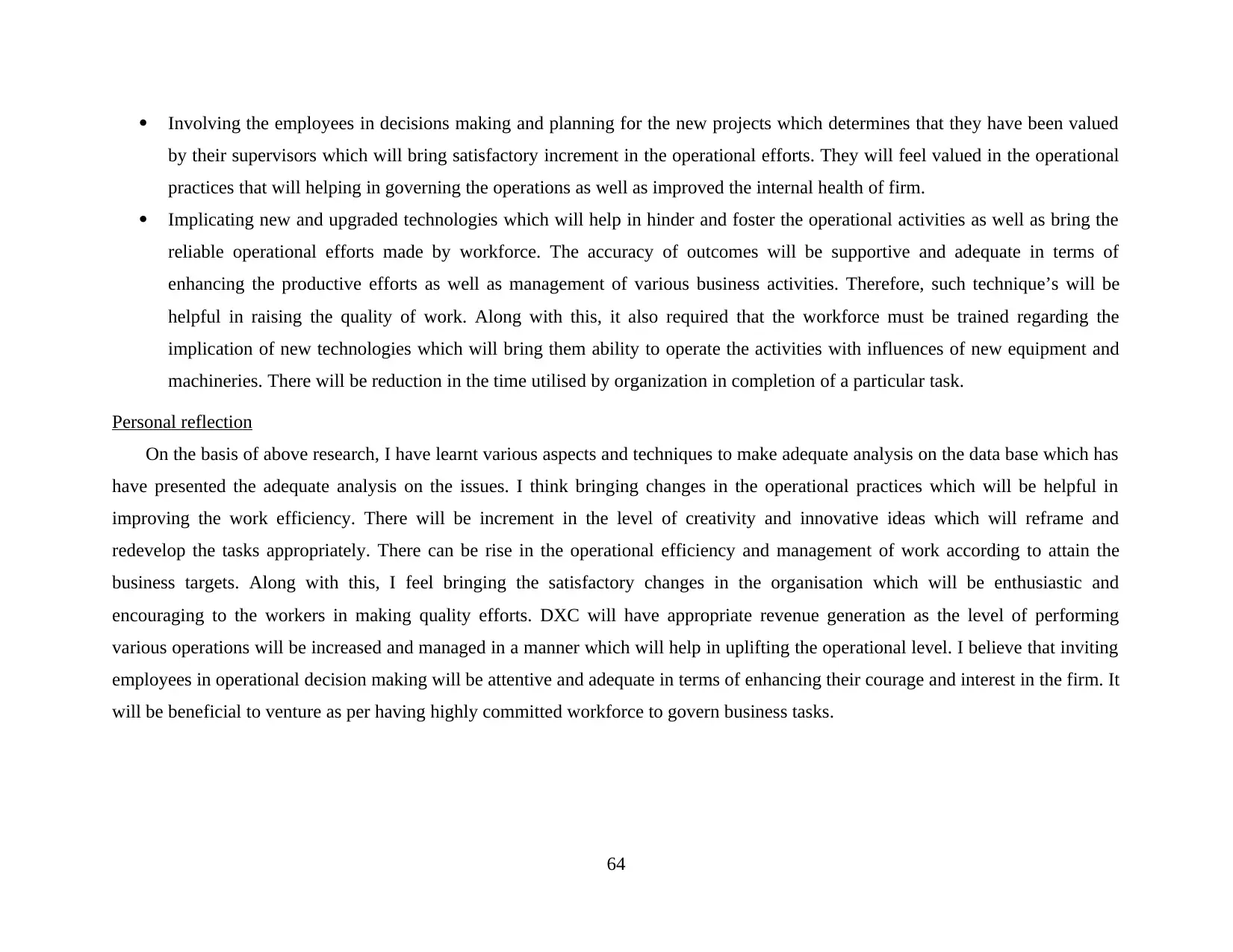
Involving the employees in decisions making and planning for the new projects which determines that they have been valued
by their supervisors which will bring satisfactory increment in the operational efforts. They will feel valued in the operational
practices that will helping in governing the operations as well as improved the internal health of firm.
Implicating new and upgraded technologies which will help in hinder and foster the operational activities as well as bring the
reliable operational efforts made by workforce. The accuracy of outcomes will be supportive and adequate in terms of
enhancing the productive efforts as well as management of various business activities. Therefore, such technique’s will be
helpful in raising the quality of work. Along with this, it also required that the workforce must be trained regarding the
implication of new technologies which will bring them ability to operate the activities with influences of new equipment and
machineries. There will be reduction in the time utilised by organization in completion of a particular task.
Personal reflection
On the basis of above research, I have learnt various aspects and techniques to make adequate analysis on the data base which has
have presented the adequate analysis on the issues. I think bringing changes in the operational practices which will be helpful in
improving the work efficiency. There will be increment in the level of creativity and innovative ideas which will reframe and
redevelop the tasks appropriately. There can be rise in the operational efficiency and management of work according to attain the
business targets. Along with this, I feel bringing the satisfactory changes in the organisation which will be enthusiastic and
encouraging to the workers in making quality efforts. DXC will have appropriate revenue generation as the level of performing
various operations will be increased and managed in a manner which will help in uplifting the operational level. I believe that inviting
employees in operational decision making will be attentive and adequate in terms of enhancing their courage and interest in the firm. It
will be beneficial to venture as per having highly committed workforce to govern business tasks.
64
by their supervisors which will bring satisfactory increment in the operational efforts. They will feel valued in the operational
practices that will helping in governing the operations as well as improved the internal health of firm.
Implicating new and upgraded technologies which will help in hinder and foster the operational activities as well as bring the
reliable operational efforts made by workforce. The accuracy of outcomes will be supportive and adequate in terms of
enhancing the productive efforts as well as management of various business activities. Therefore, such technique’s will be
helpful in raising the quality of work. Along with this, it also required that the workforce must be trained regarding the
implication of new technologies which will bring them ability to operate the activities with influences of new equipment and
machineries. There will be reduction in the time utilised by organization in completion of a particular task.
Personal reflection
On the basis of above research, I have learnt various aspects and techniques to make adequate analysis on the data base which has
have presented the adequate analysis on the issues. I think bringing changes in the operational practices which will be helpful in
improving the work efficiency. There will be increment in the level of creativity and innovative ideas which will reframe and
redevelop the tasks appropriately. There can be rise in the operational efficiency and management of work according to attain the
business targets. Along with this, I feel bringing the satisfactory changes in the organisation which will be enthusiastic and
encouraging to the workers in making quality efforts. DXC will have appropriate revenue generation as the level of performing
various operations will be increased and managed in a manner which will help in uplifting the operational level. I believe that inviting
employees in operational decision making will be attentive and adequate in terms of enhancing their courage and interest in the firm. It
will be beneficial to venture as per having highly committed workforce to govern business tasks.
64
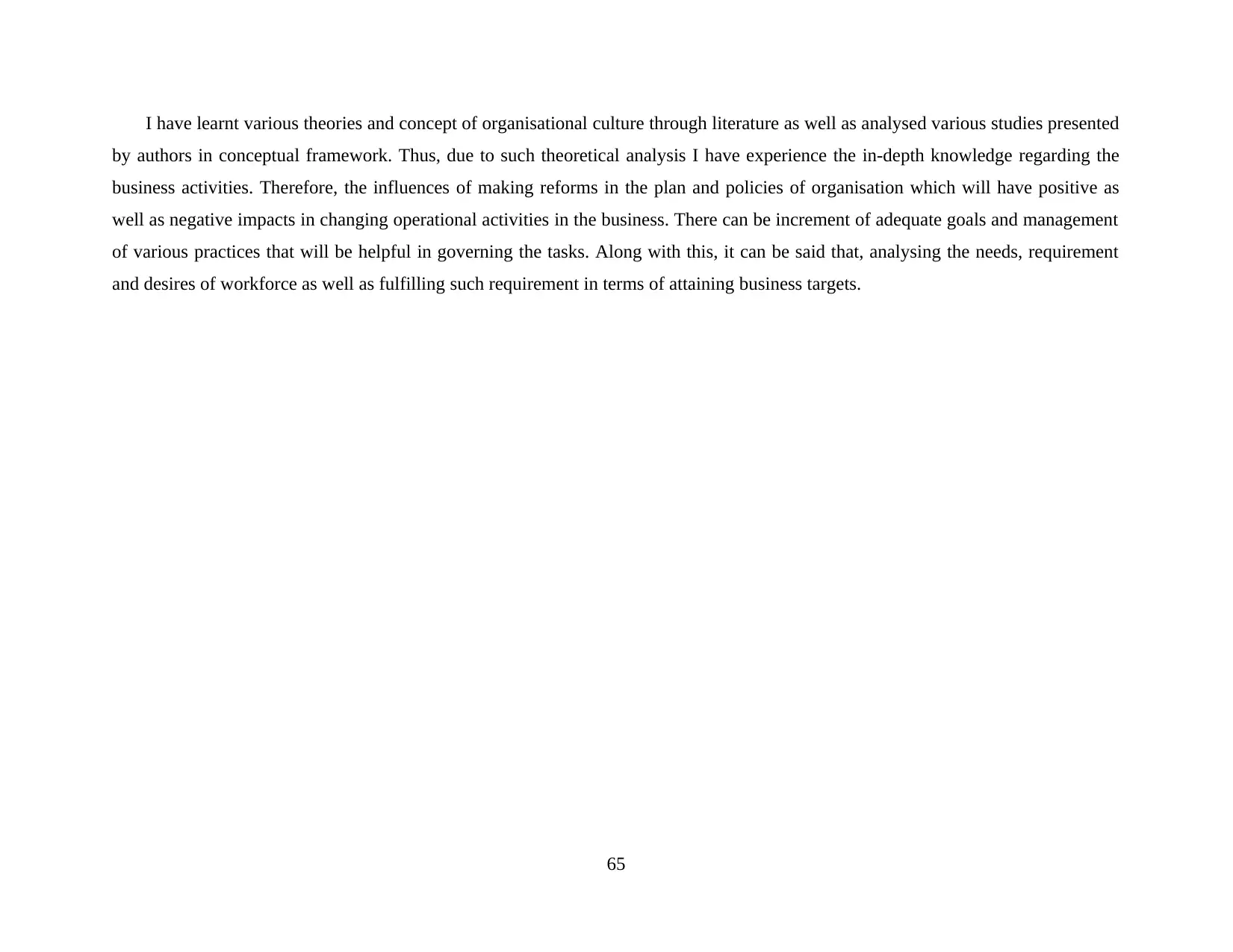
I have learnt various theories and concept of organisational culture through literature as well as analysed various studies presented
by authors in conceptual framework. Thus, due to such theoretical analysis I have experience the in-depth knowledge regarding the
business activities. Therefore, the influences of making reforms in the plan and policies of organisation which will have positive as
well as negative impacts in changing operational activities in the business. There can be increment of adequate goals and management
of various practices that will be helpful in governing the tasks. Along with this, it can be said that, analysing the needs, requirement
and desires of workforce as well as fulfilling such requirement in terms of attaining business targets.
65
by authors in conceptual framework. Thus, due to such theoretical analysis I have experience the in-depth knowledge regarding the
business activities. Therefore, the influences of making reforms in the plan and policies of organisation which will have positive as
well as negative impacts in changing operational activities in the business. There can be increment of adequate goals and management
of various practices that will be helpful in governing the tasks. Along with this, it can be said that, analysing the needs, requirement
and desires of workforce as well as fulfilling such requirement in terms of attaining business targets.
65
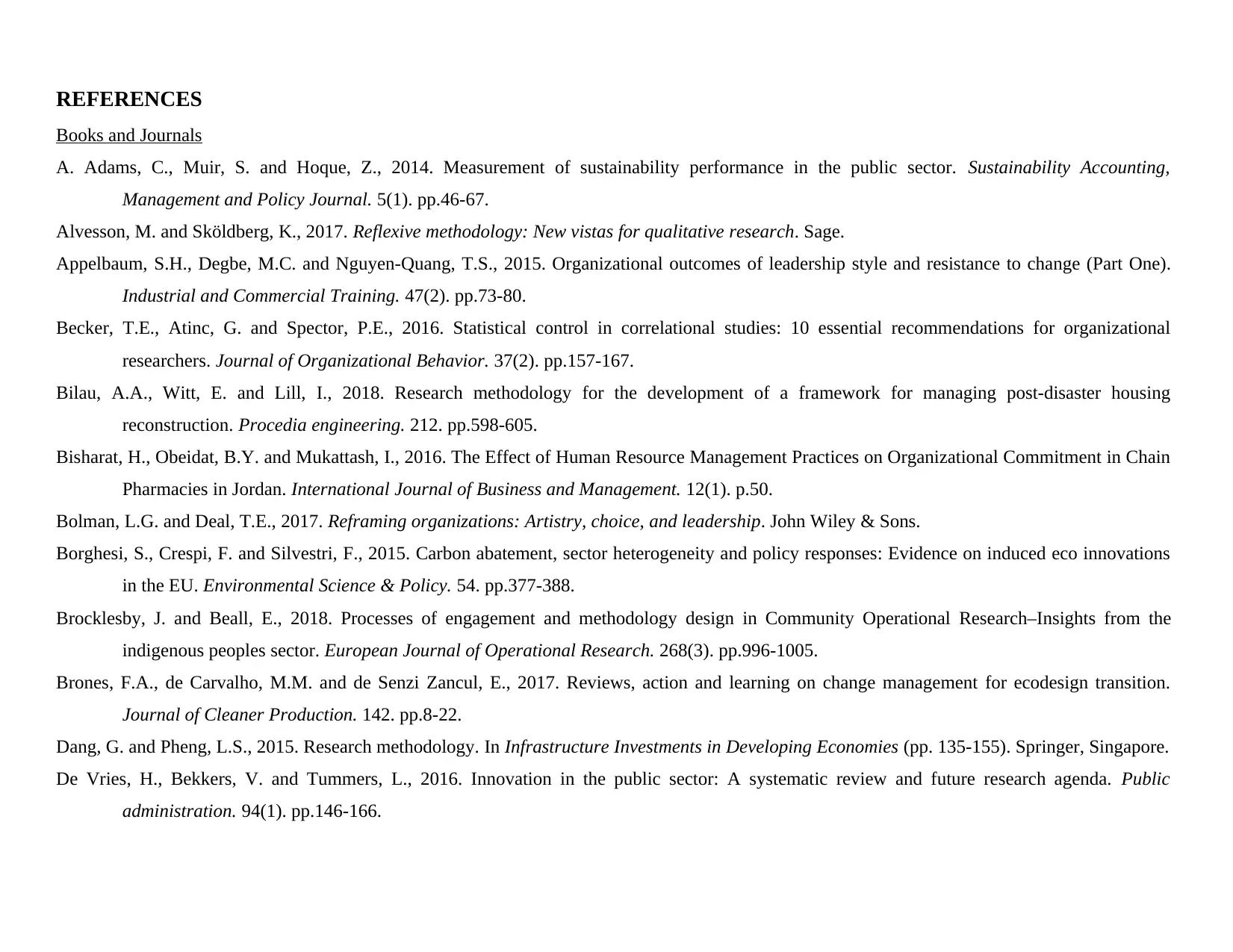
REFERENCES
Books and Journals
A. Adams, C., Muir, S. and Hoque, Z., 2014. Measurement of sustainability performance in the public sector. Sustainability Accounting,
Management and Policy Journal. 5(1). pp.46-67.
Alvesson, M. and Sköldberg, K., 2017. Reflexive methodology: New vistas for qualitative research. Sage.
Appelbaum, S.H., Degbe, M.C. and Nguyen-Quang, T.S., 2015. Organizational outcomes of leadership style and resistance to change (Part One).
Industrial and Commercial Training. 47(2). pp.73-80.
Becker, T.E., Atinc, G. and Spector, P.E., 2016. Statistical control in correlational studies: 10 essential recommendations for organizational
researchers. Journal of Organizational Behavior. 37(2). pp.157-167.
Bilau, A.A., Witt, E. and Lill, I., 2018. Research methodology for the development of a framework for managing post-disaster housing
reconstruction. Procedia engineering. 212. pp.598-605.
Bisharat, H., Obeidat, B.Y. and Mukattash, I., 2016. The Effect of Human Resource Management Practices on Organizational Commitment in Chain
Pharmacies in Jordan. International Journal of Business and Management. 12(1). p.50.
Bolman, L.G. and Deal, T.E., 2017. Reframing organizations: Artistry, choice, and leadership. John Wiley & Sons.
Borghesi, S., Crespi, F. and Silvestri, F., 2015. Carbon abatement, sector heterogeneity and policy responses: Evidence on induced eco innovations
in the EU. Environmental Science & Policy. 54. pp.377-388.
Brocklesby, J. and Beall, E., 2018. Processes of engagement and methodology design in Community Operational Research–Insights from the
indigenous peoples sector. European Journal of Operational Research. 268(3). pp.996-1005.
Brones, F.A., de Carvalho, M.M. and de Senzi Zancul, E., 2017. Reviews, action and learning on change management for ecodesign transition.
Journal of Cleaner Production. 142. pp.8-22.
Dang, G. and Pheng, L.S., 2015. Research methodology. In Infrastructure Investments in Developing Economies (pp. 135-155). Springer, Singapore.
De Vries, H., Bekkers, V. and Tummers, L., 2016. Innovation in the public sector: A systematic review and future research agenda. Public
administration. 94(1). pp.146-166.
Books and Journals
A. Adams, C., Muir, S. and Hoque, Z., 2014. Measurement of sustainability performance in the public sector. Sustainability Accounting,
Management and Policy Journal. 5(1). pp.46-67.
Alvesson, M. and Sköldberg, K., 2017. Reflexive methodology: New vistas for qualitative research. Sage.
Appelbaum, S.H., Degbe, M.C. and Nguyen-Quang, T.S., 2015. Organizational outcomes of leadership style and resistance to change (Part One).
Industrial and Commercial Training. 47(2). pp.73-80.
Becker, T.E., Atinc, G. and Spector, P.E., 2016. Statistical control in correlational studies: 10 essential recommendations for organizational
researchers. Journal of Organizational Behavior. 37(2). pp.157-167.
Bilau, A.A., Witt, E. and Lill, I., 2018. Research methodology for the development of a framework for managing post-disaster housing
reconstruction. Procedia engineering. 212. pp.598-605.
Bisharat, H., Obeidat, B.Y. and Mukattash, I., 2016. The Effect of Human Resource Management Practices on Organizational Commitment in Chain
Pharmacies in Jordan. International Journal of Business and Management. 12(1). p.50.
Bolman, L.G. and Deal, T.E., 2017. Reframing organizations: Artistry, choice, and leadership. John Wiley & Sons.
Borghesi, S., Crespi, F. and Silvestri, F., 2015. Carbon abatement, sector heterogeneity and policy responses: Evidence on induced eco innovations
in the EU. Environmental Science & Policy. 54. pp.377-388.
Brocklesby, J. and Beall, E., 2018. Processes of engagement and methodology design in Community Operational Research–Insights from the
indigenous peoples sector. European Journal of Operational Research. 268(3). pp.996-1005.
Brones, F.A., de Carvalho, M.M. and de Senzi Zancul, E., 2017. Reviews, action and learning on change management for ecodesign transition.
Journal of Cleaner Production. 142. pp.8-22.
Dang, G. and Pheng, L.S., 2015. Research methodology. In Infrastructure Investments in Developing Economies (pp. 135-155). Springer, Singapore.
De Vries, H., Bekkers, V. and Tummers, L., 2016. Innovation in the public sector: A systematic review and future research agenda. Public
administration. 94(1). pp.146-166.
Secure Best Marks with AI Grader
Need help grading? Try our AI Grader for instant feedback on your assignments.
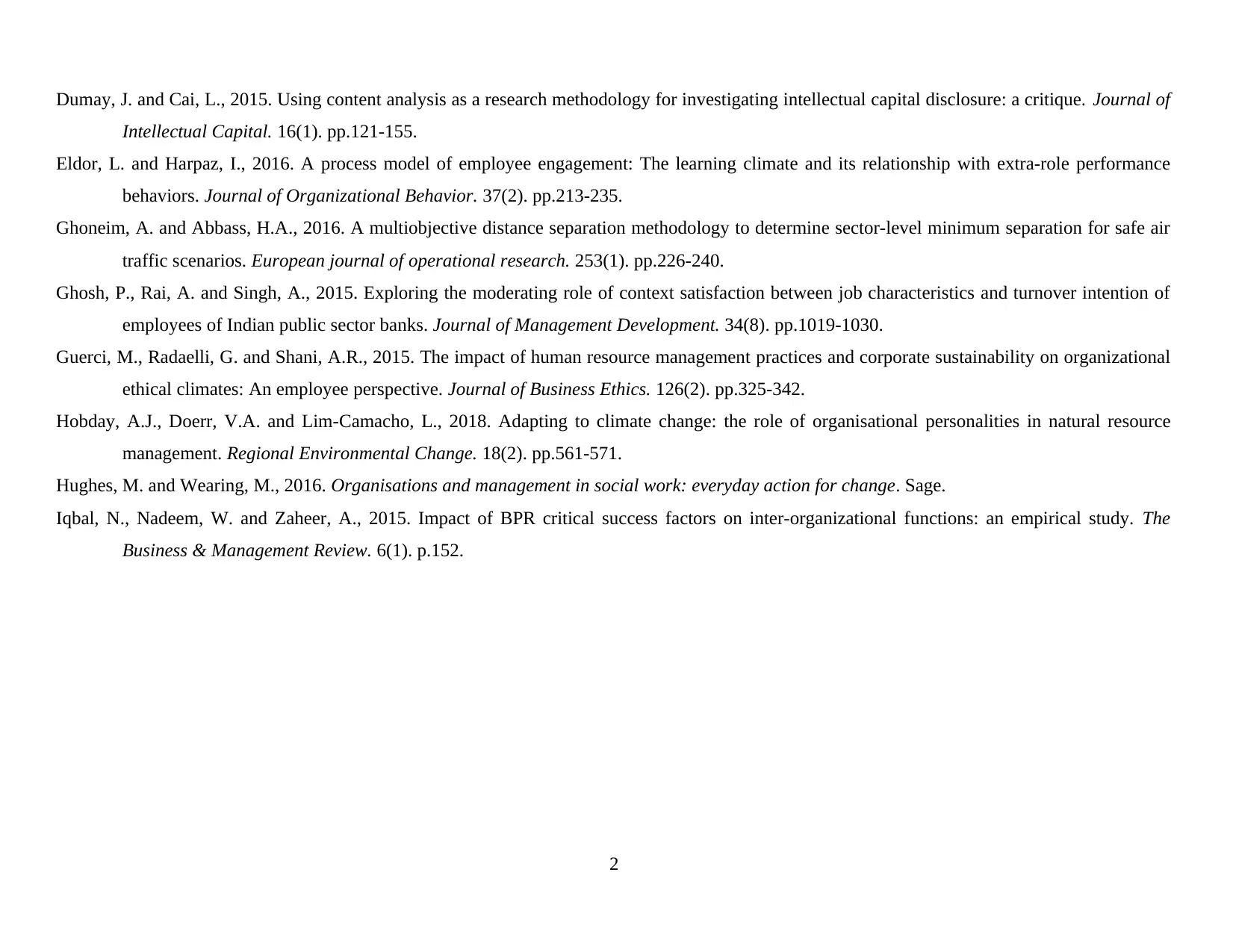
Dumay, J. and Cai, L., 2015. Using content analysis as a research methodology for investigating intellectual capital disclosure: a critique. Journal of
Intellectual Capital. 16(1). pp.121-155.
Eldor, L. and Harpaz, I., 2016. A process model of employee engagement: The learning climate and its relationship with extra‐role performance
behaviors. Journal of Organizational Behavior. 37(2). pp.213-235.
Ghoneim, A. and Abbass, H.A., 2016. A multiobjective distance separation methodology to determine sector-level minimum separation for safe air
traffic scenarios. European journal of operational research. 253(1). pp.226-240.
Ghosh, P., Rai, A. and Singh, A., 2015. Exploring the moderating role of context satisfaction between job characteristics and turnover intention of
employees of Indian public sector banks. Journal of Management Development. 34(8). pp.1019-1030.
Guerci, M., Radaelli, G. and Shani, A.R., 2015. The impact of human resource management practices and corporate sustainability on organizational
ethical climates: An employee perspective. Journal of Business Ethics. 126(2). pp.325-342.
Hobday, A.J., Doerr, V.A. and Lim-Camacho, L., 2018. Adapting to climate change: the role of organisational personalities in natural resource
management. Regional Environmental Change. 18(2). pp.561-571.
Hughes, M. and Wearing, M., 2016. Organisations and management in social work: everyday action for change. Sage.
Iqbal, N., Nadeem, W. and Zaheer, A., 2015. Impact of BPR critical success factors on inter-organizational functions: an empirical study. The
Business & Management Review. 6(1). p.152.
2
Intellectual Capital. 16(1). pp.121-155.
Eldor, L. and Harpaz, I., 2016. A process model of employee engagement: The learning climate and its relationship with extra‐role performance
behaviors. Journal of Organizational Behavior. 37(2). pp.213-235.
Ghoneim, A. and Abbass, H.A., 2016. A multiobjective distance separation methodology to determine sector-level minimum separation for safe air
traffic scenarios. European journal of operational research. 253(1). pp.226-240.
Ghosh, P., Rai, A. and Singh, A., 2015. Exploring the moderating role of context satisfaction between job characteristics and turnover intention of
employees of Indian public sector banks. Journal of Management Development. 34(8). pp.1019-1030.
Guerci, M., Radaelli, G. and Shani, A.R., 2015. The impact of human resource management practices and corporate sustainability on organizational
ethical climates: An employee perspective. Journal of Business Ethics. 126(2). pp.325-342.
Hobday, A.J., Doerr, V.A. and Lim-Camacho, L., 2018. Adapting to climate change: the role of organisational personalities in natural resource
management. Regional Environmental Change. 18(2). pp.561-571.
Hughes, M. and Wearing, M., 2016. Organisations and management in social work: everyday action for change. Sage.
Iqbal, N., Nadeem, W. and Zaheer, A., 2015. Impact of BPR critical success factors on inter-organizational functions: an empirical study. The
Business & Management Review. 6(1). p.152.
2
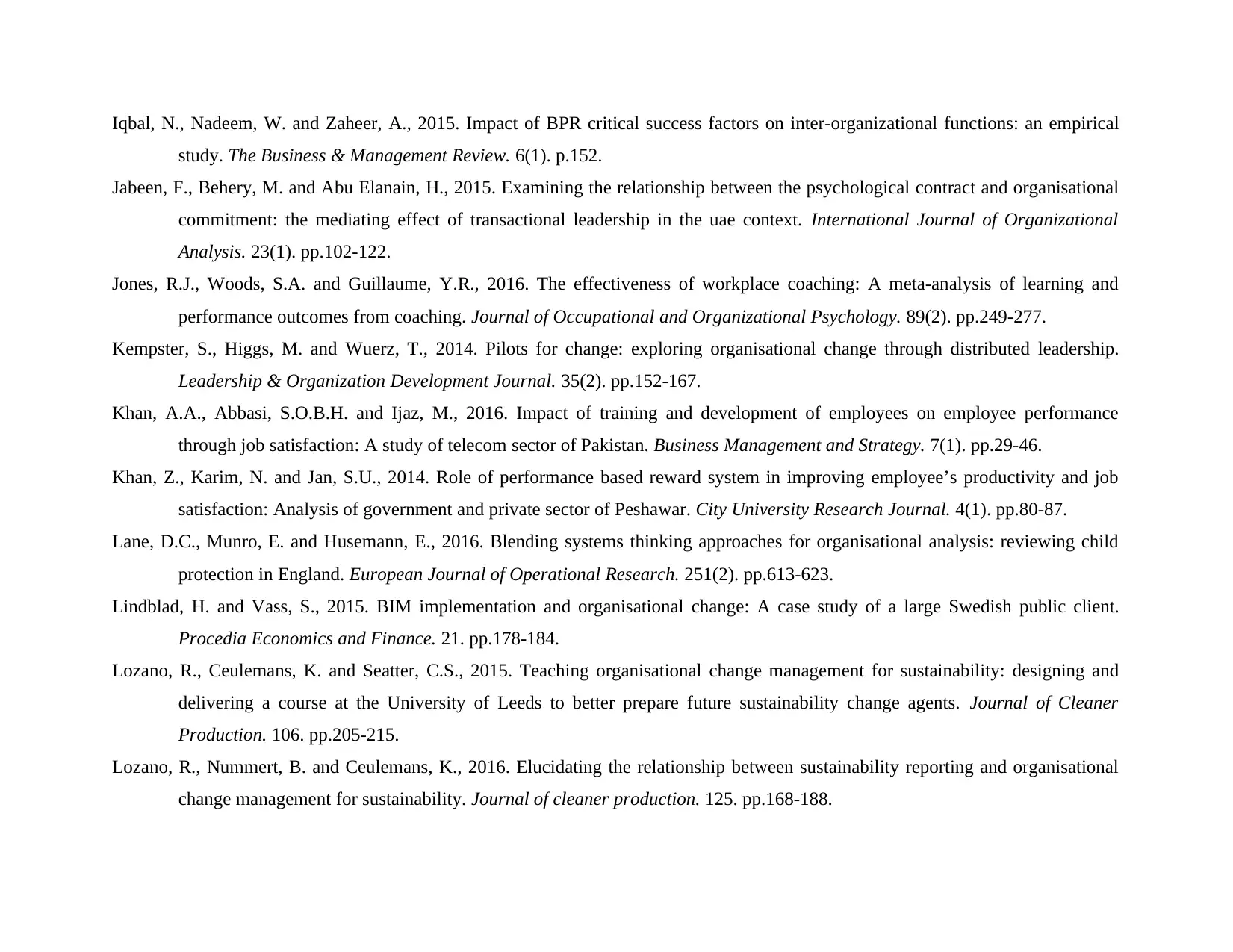
Iqbal, N., Nadeem, W. and Zaheer, A., 2015. Impact of BPR critical success factors on inter-organizational functions: an empirical
study. The Business & Management Review. 6(1). p.152.
Jabeen, F., Behery, M. and Abu Elanain, H., 2015. Examining the relationship between the psychological contract and organisational
commitment: the mediating effect of transactional leadership in the uae context. International Journal of Organizational
Analysis. 23(1). pp.102-122.
Jones, R.J., Woods, S.A. and Guillaume, Y.R., 2016. The effectiveness of workplace coaching: A meta‐analysis of learning and
performance outcomes from coaching. Journal of Occupational and Organizational Psychology. 89(2). pp.249-277.
Kempster, S., Higgs, M. and Wuerz, T., 2014. Pilots for change: exploring organisational change through distributed leadership.
Leadership & Organization Development Journal. 35(2). pp.152-167.
Khan, A.A., Abbasi, S.O.B.H. and Ijaz, M., 2016. Impact of training and development of employees on employee performance
through job satisfaction: A study of telecom sector of Pakistan. Business Management and Strategy. 7(1). pp.29-46.
Khan, Z., Karim, N. and Jan, S.U., 2014. Role of performance based reward system in improving employee’s productivity and job
satisfaction: Analysis of government and private sector of Peshawar. City University Research Journal. 4(1). pp.80-87.
Lane, D.C., Munro, E. and Husemann, E., 2016. Blending systems thinking approaches for organisational analysis: reviewing child
protection in England. European Journal of Operational Research. 251(2). pp.613-623.
Lindblad, H. and Vass, S., 2015. BIM implementation and organisational change: A case study of a large Swedish public client.
Procedia Economics and Finance. 21. pp.178-184.
Lozano, R., Ceulemans, K. and Seatter, C.S., 2015. Teaching organisational change management for sustainability: designing and
delivering a course at the University of Leeds to better prepare future sustainability change agents. Journal of Cleaner
Production. 106. pp.205-215.
Lozano, R., Nummert, B. and Ceulemans, K., 2016. Elucidating the relationship between sustainability reporting and organisational
change management for sustainability. Journal of cleaner production. 125. pp.168-188.
study. The Business & Management Review. 6(1). p.152.
Jabeen, F., Behery, M. and Abu Elanain, H., 2015. Examining the relationship between the psychological contract and organisational
commitment: the mediating effect of transactional leadership in the uae context. International Journal of Organizational
Analysis. 23(1). pp.102-122.
Jones, R.J., Woods, S.A. and Guillaume, Y.R., 2016. The effectiveness of workplace coaching: A meta‐analysis of learning and
performance outcomes from coaching. Journal of Occupational and Organizational Psychology. 89(2). pp.249-277.
Kempster, S., Higgs, M. and Wuerz, T., 2014. Pilots for change: exploring organisational change through distributed leadership.
Leadership & Organization Development Journal. 35(2). pp.152-167.
Khan, A.A., Abbasi, S.O.B.H. and Ijaz, M., 2016. Impact of training and development of employees on employee performance
through job satisfaction: A study of telecom sector of Pakistan. Business Management and Strategy. 7(1). pp.29-46.
Khan, Z., Karim, N. and Jan, S.U., 2014. Role of performance based reward system in improving employee’s productivity and job
satisfaction: Analysis of government and private sector of Peshawar. City University Research Journal. 4(1). pp.80-87.
Lane, D.C., Munro, E. and Husemann, E., 2016. Blending systems thinking approaches for organisational analysis: reviewing child
protection in England. European Journal of Operational Research. 251(2). pp.613-623.
Lindblad, H. and Vass, S., 2015. BIM implementation and organisational change: A case study of a large Swedish public client.
Procedia Economics and Finance. 21. pp.178-184.
Lozano, R., Ceulemans, K. and Seatter, C.S., 2015. Teaching organisational change management for sustainability: designing and
delivering a course at the University of Leeds to better prepare future sustainability change agents. Journal of Cleaner
Production. 106. pp.205-215.
Lozano, R., Nummert, B. and Ceulemans, K., 2016. Elucidating the relationship between sustainability reporting and organisational
change management for sustainability. Journal of cleaner production. 125. pp.168-188.
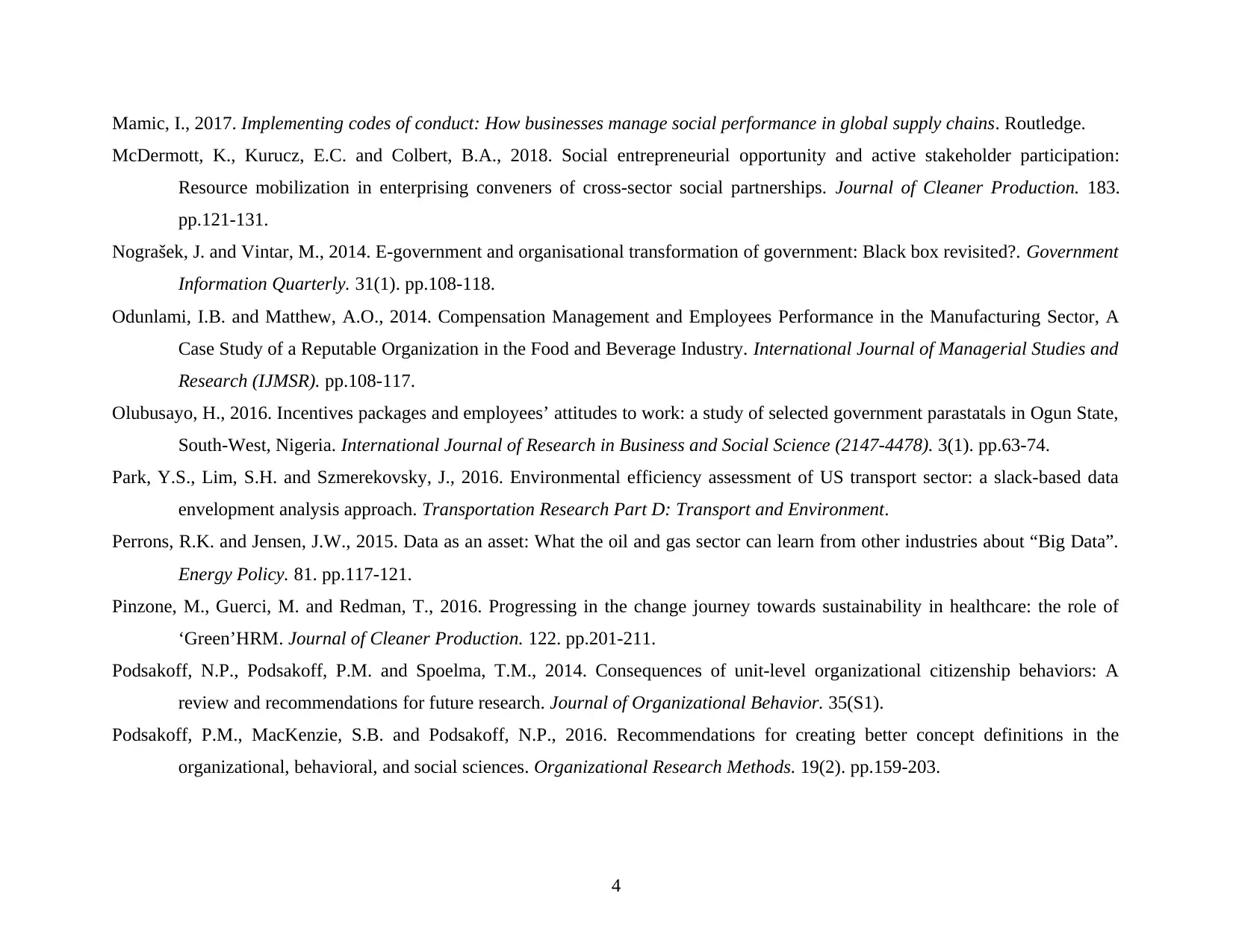
Mamic, I., 2017. Implementing codes of conduct: How businesses manage social performance in global supply chains. Routledge.
McDermott, K., Kurucz, E.C. and Colbert, B.A., 2018. Social entrepreneurial opportunity and active stakeholder participation:
Resource mobilization in enterprising conveners of cross-sector social partnerships. Journal of Cleaner Production. 183.
pp.121-131.
Nograšek, J. and Vintar, M., 2014. E-government and organisational transformation of government: Black box revisited?. Government
Information Quarterly. 31(1). pp.108-118.
Odunlami, I.B. and Matthew, A.O., 2014. Compensation Management and Employees Performance in the Manufacturing Sector, A
Case Study of a Reputable Organization in the Food and Beverage Industry. International Journal of Managerial Studies and
Research (IJMSR). pp.108-117.
Olubusayo, H., 2016. Incentives packages and employees’ attitudes to work: a study of selected government parastatals in Ogun State,
South-West, Nigeria. International Journal of Research in Business and Social Science (2147-4478). 3(1). pp.63-74.
Park, Y.S., Lim, S.H. and Szmerekovsky, J., 2016. Environmental efficiency assessment of US transport sector: a slack-based data
envelopment analysis approach. Transportation Research Part D: Transport and Environment.
Perrons, R.K. and Jensen, J.W., 2015. Data as an asset: What the oil and gas sector can learn from other industries about “Big Data”.
Energy Policy. 81. pp.117-121.
Pinzone, M., Guerci, M. and Redman, T., 2016. Progressing in the change journey towards sustainability in healthcare: the role of
‘Green’HRM. Journal of Cleaner Production. 122. pp.201-211.
Podsakoff, N.P., Podsakoff, P.M. and Spoelma, T.M., 2014. Consequences of unit‐level organizational citizenship behaviors: A
review and recommendations for future research. Journal of Organizational Behavior. 35(S1).
Podsakoff, P.M., MacKenzie, S.B. and Podsakoff, N.P., 2016. Recommendations for creating better concept definitions in the
organizational, behavioral, and social sciences. Organizational Research Methods. 19(2). pp.159-203.
4
McDermott, K., Kurucz, E.C. and Colbert, B.A., 2018. Social entrepreneurial opportunity and active stakeholder participation:
Resource mobilization in enterprising conveners of cross-sector social partnerships. Journal of Cleaner Production. 183.
pp.121-131.
Nograšek, J. and Vintar, M., 2014. E-government and organisational transformation of government: Black box revisited?. Government
Information Quarterly. 31(1). pp.108-118.
Odunlami, I.B. and Matthew, A.O., 2014. Compensation Management and Employees Performance in the Manufacturing Sector, A
Case Study of a Reputable Organization in the Food and Beverage Industry. International Journal of Managerial Studies and
Research (IJMSR). pp.108-117.
Olubusayo, H., 2016. Incentives packages and employees’ attitudes to work: a study of selected government parastatals in Ogun State,
South-West, Nigeria. International Journal of Research in Business and Social Science (2147-4478). 3(1). pp.63-74.
Park, Y.S., Lim, S.H. and Szmerekovsky, J., 2016. Environmental efficiency assessment of US transport sector: a slack-based data
envelopment analysis approach. Transportation Research Part D: Transport and Environment.
Perrons, R.K. and Jensen, J.W., 2015. Data as an asset: What the oil and gas sector can learn from other industries about “Big Data”.
Energy Policy. 81. pp.117-121.
Pinzone, M., Guerci, M. and Redman, T., 2016. Progressing in the change journey towards sustainability in healthcare: the role of
‘Green’HRM. Journal of Cleaner Production. 122. pp.201-211.
Podsakoff, N.P., Podsakoff, P.M. and Spoelma, T.M., 2014. Consequences of unit‐level organizational citizenship behaviors: A
review and recommendations for future research. Journal of Organizational Behavior. 35(S1).
Podsakoff, P.M., MacKenzie, S.B. and Podsakoff, N.P., 2016. Recommendations for creating better concept definitions in the
organizational, behavioral, and social sciences. Organizational Research Methods. 19(2). pp.159-203.
4
Paraphrase This Document
Need a fresh take? Get an instant paraphrase of this document with our AI Paraphraser

Puri, J. and Yadav, S.P., 2015. Intuitionistic fuzzy data envelopment analysis: An application to the banking sector in India. Expert
Systems with Applications. 42(11). pp.4982-4998.
Ramdhani, A., Ramdhani, M.A. and Ainisyifa, H., 2017. Conceptual Framework of Corporate Culture Influenced on Employees
Commitment to Organization. International Business Management. 11(3). pp.826-830.
Ruck, K., Welch, M. and Menara, B., 2017. Employee voice: An antecedent to organisational engagement?. Public Relations Review.
43(5). pp.904-914.
Shire, K.A., Holtgrewe, U. and Kerst, C., 2017. Re-organising Service Work: Call Centres in Germany and Britain: Call Centres in
Germany and Britain. Routledge.
Sotiriadou, P., Brouwers, J. and Le, T.A., 2014. Choosing a qualitative data analysis tool: A comparison of NVivo and Leximancer.
Annals of Leisure Research. 17(2). pp.218-234.
Srivastava, A.P. and Dhar, R.L., 2016. Impact of Leader member exchange, human resource management practices and psychological
empowerment on extra role performances: the mediating role of organisational commitment. International Journal of
Productivity and Performance Management. 65(3). pp.351-377.
Srivastava, A.P. and Dhar, R.L., 2016. Impact of Leader member exchange, human resource management practices and psychological
empowerment on extra role performances: the mediating role of organisational commitment. International Journal of
Productivity and Performance Management. 65(3). pp.351-377.
Top, M., Akdere, M. and Tarcan, M., 2015. Examining transformational leadership, job satisfaction, organizational commitment and
organizational trust in Turkish hospitals: public servants versus private sector employees. The International Journal of
Human Resource Management. 26(9). pp.1259-1282.
Vamsi Krishna Jasti, N. and Kodali, R., 2014. A literature review of empirical research methodology in lean manufacturing.
International Journal of Operations & Production Management. 34(8). pp.1080-1122.
Van Dooren, W., Bouckaert, G. and Halligan, J., 2015. Performance management in the public sector. Routledge.
5
Systems with Applications. 42(11). pp.4982-4998.
Ramdhani, A., Ramdhani, M.A. and Ainisyifa, H., 2017. Conceptual Framework of Corporate Culture Influenced on Employees
Commitment to Organization. International Business Management. 11(3). pp.826-830.
Ruck, K., Welch, M. and Menara, B., 2017. Employee voice: An antecedent to organisational engagement?. Public Relations Review.
43(5). pp.904-914.
Shire, K.A., Holtgrewe, U. and Kerst, C., 2017. Re-organising Service Work: Call Centres in Germany and Britain: Call Centres in
Germany and Britain. Routledge.
Sotiriadou, P., Brouwers, J. and Le, T.A., 2014. Choosing a qualitative data analysis tool: A comparison of NVivo and Leximancer.
Annals of Leisure Research. 17(2). pp.218-234.
Srivastava, A.P. and Dhar, R.L., 2016. Impact of Leader member exchange, human resource management practices and psychological
empowerment on extra role performances: the mediating role of organisational commitment. International Journal of
Productivity and Performance Management. 65(3). pp.351-377.
Srivastava, A.P. and Dhar, R.L., 2016. Impact of Leader member exchange, human resource management practices and psychological
empowerment on extra role performances: the mediating role of organisational commitment. International Journal of
Productivity and Performance Management. 65(3). pp.351-377.
Top, M., Akdere, M. and Tarcan, M., 2015. Examining transformational leadership, job satisfaction, organizational commitment and
organizational trust in Turkish hospitals: public servants versus private sector employees. The International Journal of
Human Resource Management. 26(9). pp.1259-1282.
Vamsi Krishna Jasti, N. and Kodali, R., 2014. A literature review of empirical research methodology in lean manufacturing.
International Journal of Operations & Production Management. 34(8). pp.1080-1122.
Van Dooren, W., Bouckaert, G. and Halligan, J., 2015. Performance management in the public sector. Routledge.
5
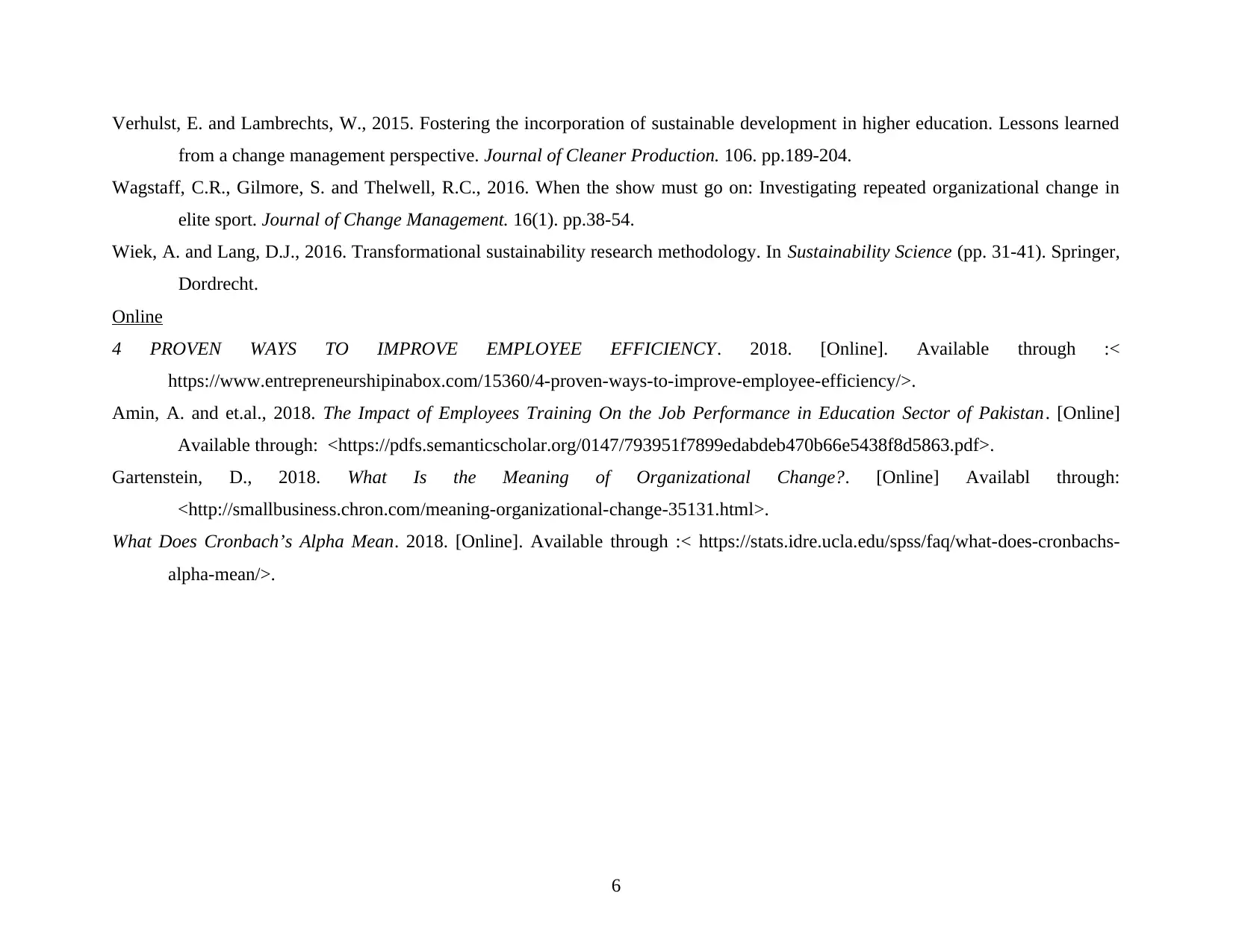
Verhulst, E. and Lambrechts, W., 2015. Fostering the incorporation of sustainable development in higher education. Lessons learned
from a change management perspective. Journal of Cleaner Production. 106. pp.189-204.
Wagstaff, C.R., Gilmore, S. and Thelwell, R.C., 2016. When the show must go on: Investigating repeated organizational change in
elite sport. Journal of Change Management. 16(1). pp.38-54.
Wiek, A. and Lang, D.J., 2016. Transformational sustainability research methodology. In Sustainability Science (pp. 31-41). Springer,
Dordrecht.
Online
4 PROVEN WAYS TO IMPROVE EMPLOYEE EFFICIENCY. 2018. [Online]. Available through :<
https://www.entrepreneurshipinabox.com/15360/4-proven-ways-to-improve-employee-efficiency/>.
Amin, A. and et.al., 2018. The Impact of Employees Training On the Job Performance in Education Sector of Pakistan. [Online]
Available through: <https://pdfs.semanticscholar.org/0147/793951f7899edabdeb470b66e5438f8d5863.pdf>.
Gartenstein, D., 2018. What Is the Meaning of Organizational Change?. [Online] Availabl through:
<http://smallbusiness.chron.com/meaning-organizational-change-35131.html>.
What Does Cronbach’s Alpha Mean. 2018. [Online]. Available through :< https://stats.idre.ucla.edu/spss/faq/what-does-cronbachs-
alpha-mean/>.
6
from a change management perspective. Journal of Cleaner Production. 106. pp.189-204.
Wagstaff, C.R., Gilmore, S. and Thelwell, R.C., 2016. When the show must go on: Investigating repeated organizational change in
elite sport. Journal of Change Management. 16(1). pp.38-54.
Wiek, A. and Lang, D.J., 2016. Transformational sustainability research methodology. In Sustainability Science (pp. 31-41). Springer,
Dordrecht.
Online
4 PROVEN WAYS TO IMPROVE EMPLOYEE EFFICIENCY. 2018. [Online]. Available through :<
https://www.entrepreneurshipinabox.com/15360/4-proven-ways-to-improve-employee-efficiency/>.
Amin, A. and et.al., 2018. The Impact of Employees Training On the Job Performance in Education Sector of Pakistan. [Online]
Available through: <https://pdfs.semanticscholar.org/0147/793951f7899edabdeb470b66e5438f8d5863.pdf>.
Gartenstein, D., 2018. What Is the Meaning of Organizational Change?. [Online] Availabl through:
<http://smallbusiness.chron.com/meaning-organizational-change-35131.html>.
What Does Cronbach’s Alpha Mean. 2018. [Online]. Available through :< https://stats.idre.ucla.edu/spss/faq/what-does-cronbachs-
alpha-mean/>.
6

APPENDIX
Questionnaire
Name:
Age:
Gender:
1. How are you agree with cultural changes towards employees’ performances in positive
context? ind
Strongly agreed
Agreed
Neutral
Disagree
Highly disagree
2. How much do you agree with organisational communication changes towards increment in
employee’s productivity?
Strongly agreed
Agreed
Neutral
Disagree
Highly disagree
3. How much do you agree with employees’ performances relation with concern and questions?
7
Questionnaire
Name:
Age:
Gender:
1. How are you agree with cultural changes towards employees’ performances in positive
context? ind
Strongly agreed
Agreed
Neutral
Disagree
Highly disagree
2. How much do you agree with organisational communication changes towards increment in
employee’s productivity?
Strongly agreed
Agreed
Neutral
Disagree
Highly disagree
3. How much do you agree with employees’ performances relation with concern and questions?
7
Secure Best Marks with AI Grader
Need help grading? Try our AI Grader for instant feedback on your assignments.
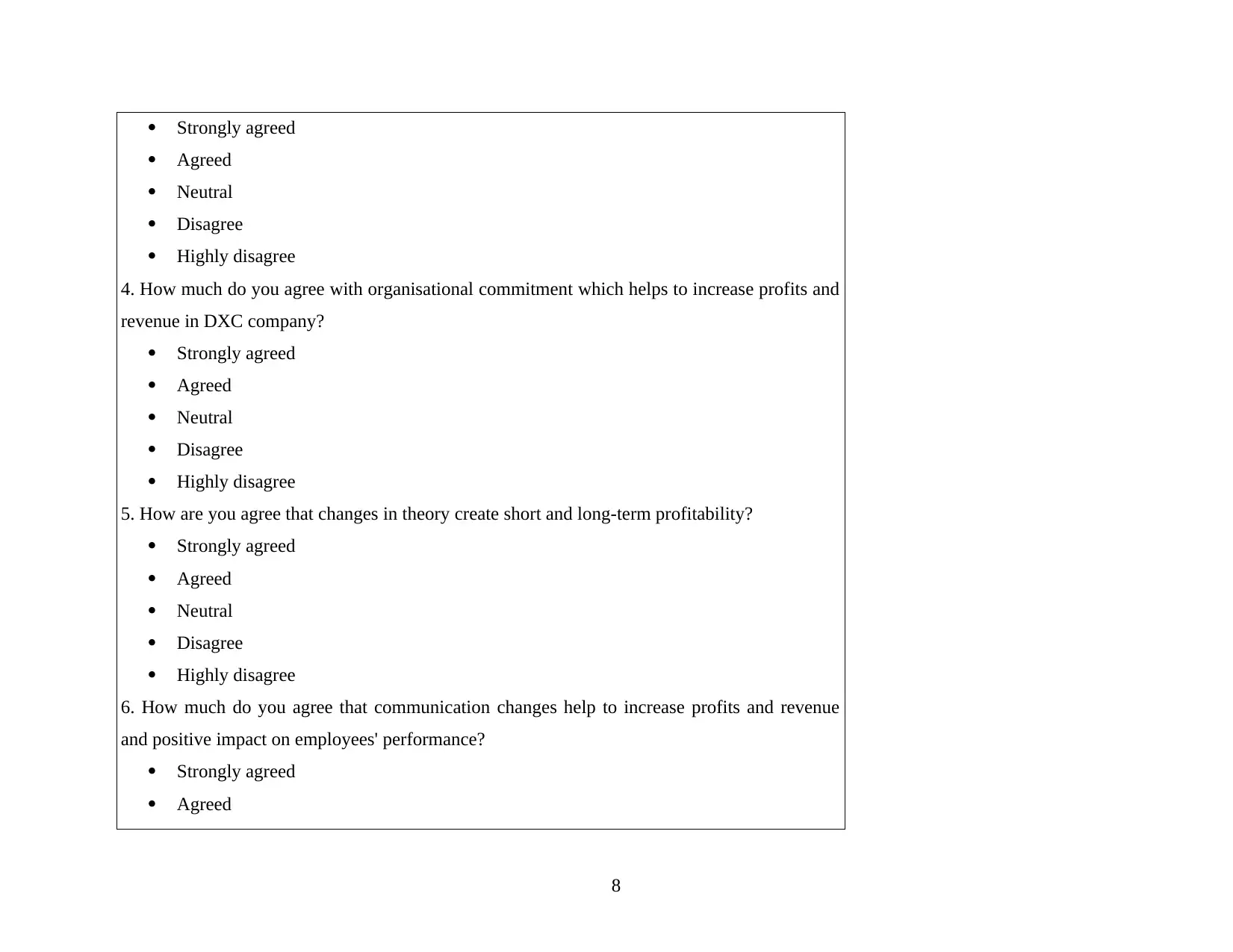
Strongly agreed
Agreed
Neutral
Disagree
Highly disagree
4. How much do you agree with organisational commitment which helps to increase profits and
revenue in DXC company?
Strongly agreed
Agreed
Neutral
Disagree
Highly disagree
5. How are you agree that changes in theory create short and long-term profitability?
Strongly agreed
Agreed
Neutral
Disagree
Highly disagree
6. How much do you agree that communication changes help to increase profits and revenue
and positive impact on employees' performance?
Strongly agreed
Agreed
8
Agreed
Neutral
Disagree
Highly disagree
4. How much do you agree with organisational commitment which helps to increase profits and
revenue in DXC company?
Strongly agreed
Agreed
Neutral
Disagree
Highly disagree
5. How are you agree that changes in theory create short and long-term profitability?
Strongly agreed
Agreed
Neutral
Disagree
Highly disagree
6. How much do you agree that communication changes help to increase profits and revenue
and positive impact on employees' performance?
Strongly agreed
Agreed
8
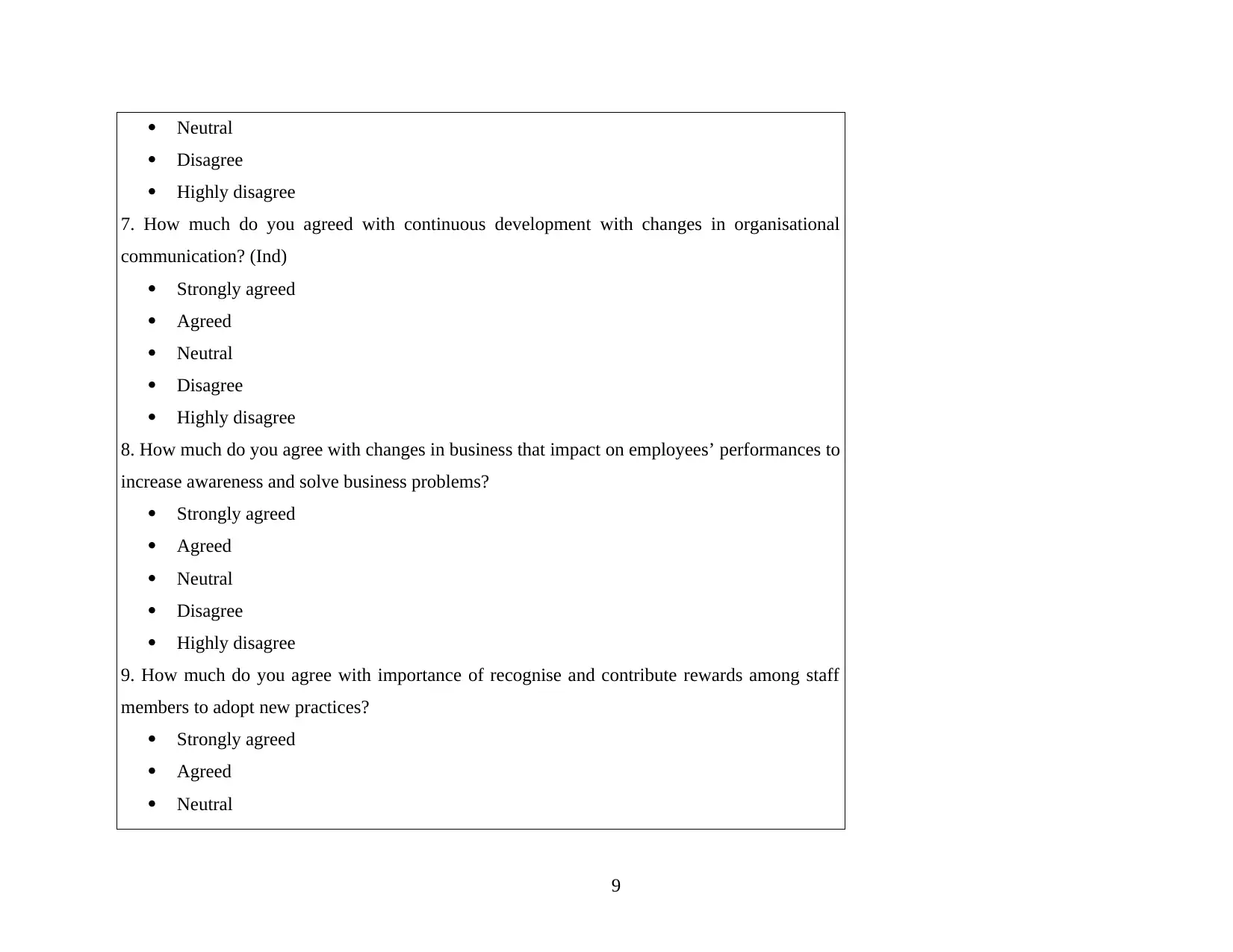
Neutral
Disagree
Highly disagree
7. How much do you agreed with continuous development with changes in organisational
communication? (Ind)
Strongly agreed
Agreed
Neutral
Disagree
Highly disagree
8. How much do you agree with changes in business that impact on employees’ performances to
increase awareness and solve business problems?
Strongly agreed
Agreed
Neutral
Disagree
Highly disagree
9. How much do you agree with importance of recognise and contribute rewards among staff
members to adopt new practices?
Strongly agreed
Agreed
Neutral
9
Disagree
Highly disagree
7. How much do you agreed with continuous development with changes in organisational
communication? (Ind)
Strongly agreed
Agreed
Neutral
Disagree
Highly disagree
8. How much do you agree with changes in business that impact on employees’ performances to
increase awareness and solve business problems?
Strongly agreed
Agreed
Neutral
Disagree
Highly disagree
9. How much do you agree with importance of recognise and contribute rewards among staff
members to adopt new practices?
Strongly agreed
Agreed
Neutral
9
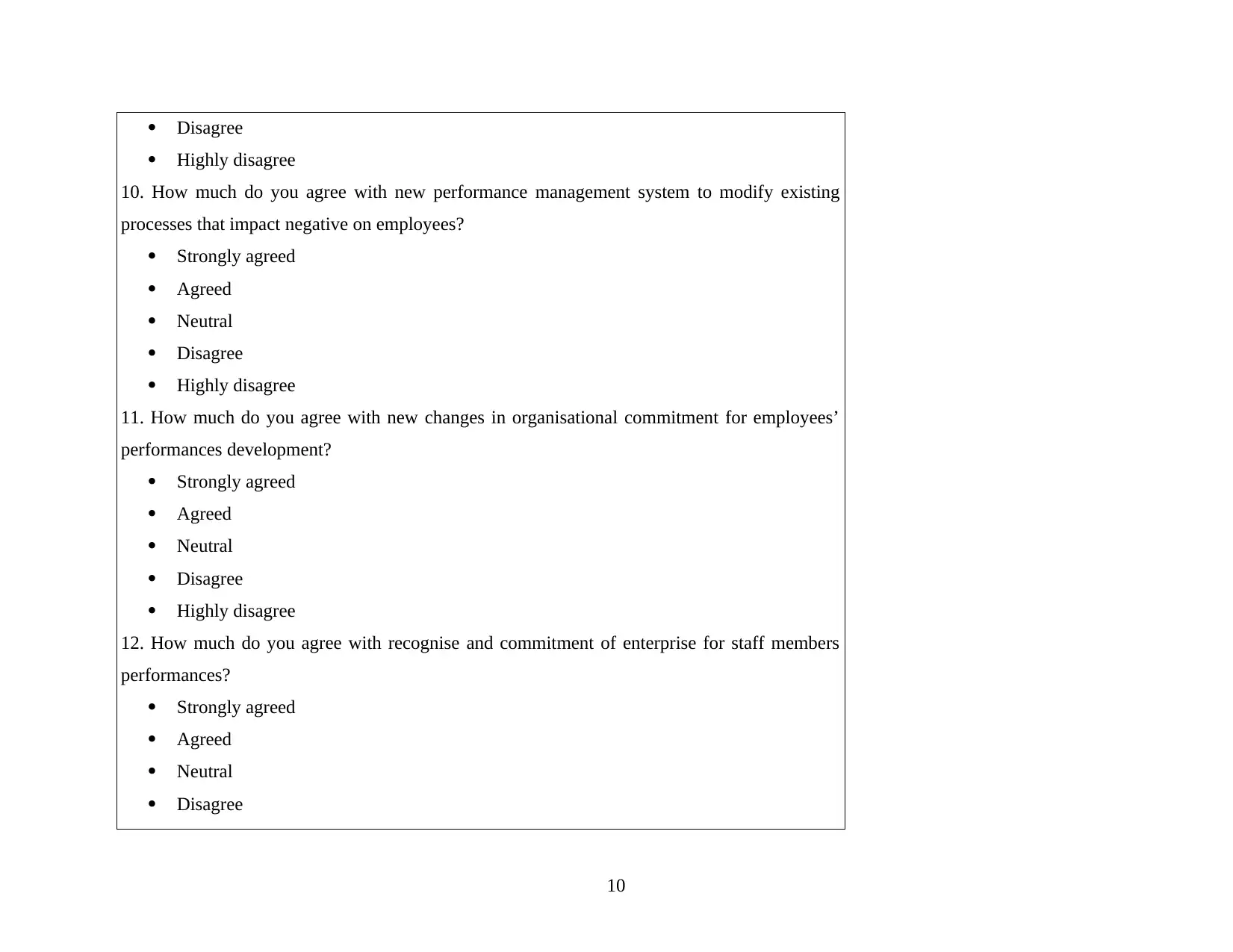
Disagree
Highly disagree
10. How much do you agree with new performance management system to modify existing
processes that impact negative on employees?
Strongly agreed
Agreed
Neutral
Disagree
Highly disagree
11. How much do you agree with new changes in organisational commitment for employees’
performances development?
Strongly agreed
Agreed
Neutral
Disagree
Highly disagree
12. How much do you agree with recognise and commitment of enterprise for staff members
performances?
Strongly agreed
Agreed
Neutral
Disagree
10
Highly disagree
10. How much do you agree with new performance management system to modify existing
processes that impact negative on employees?
Strongly agreed
Agreed
Neutral
Disagree
Highly disagree
11. How much do you agree with new changes in organisational commitment for employees’
performances development?
Strongly agreed
Agreed
Neutral
Disagree
Highly disagree
12. How much do you agree with recognise and commitment of enterprise for staff members
performances?
Strongly agreed
Agreed
Neutral
Disagree
10
Paraphrase This Document
Need a fresh take? Get an instant paraphrase of this document with our AI Paraphraser
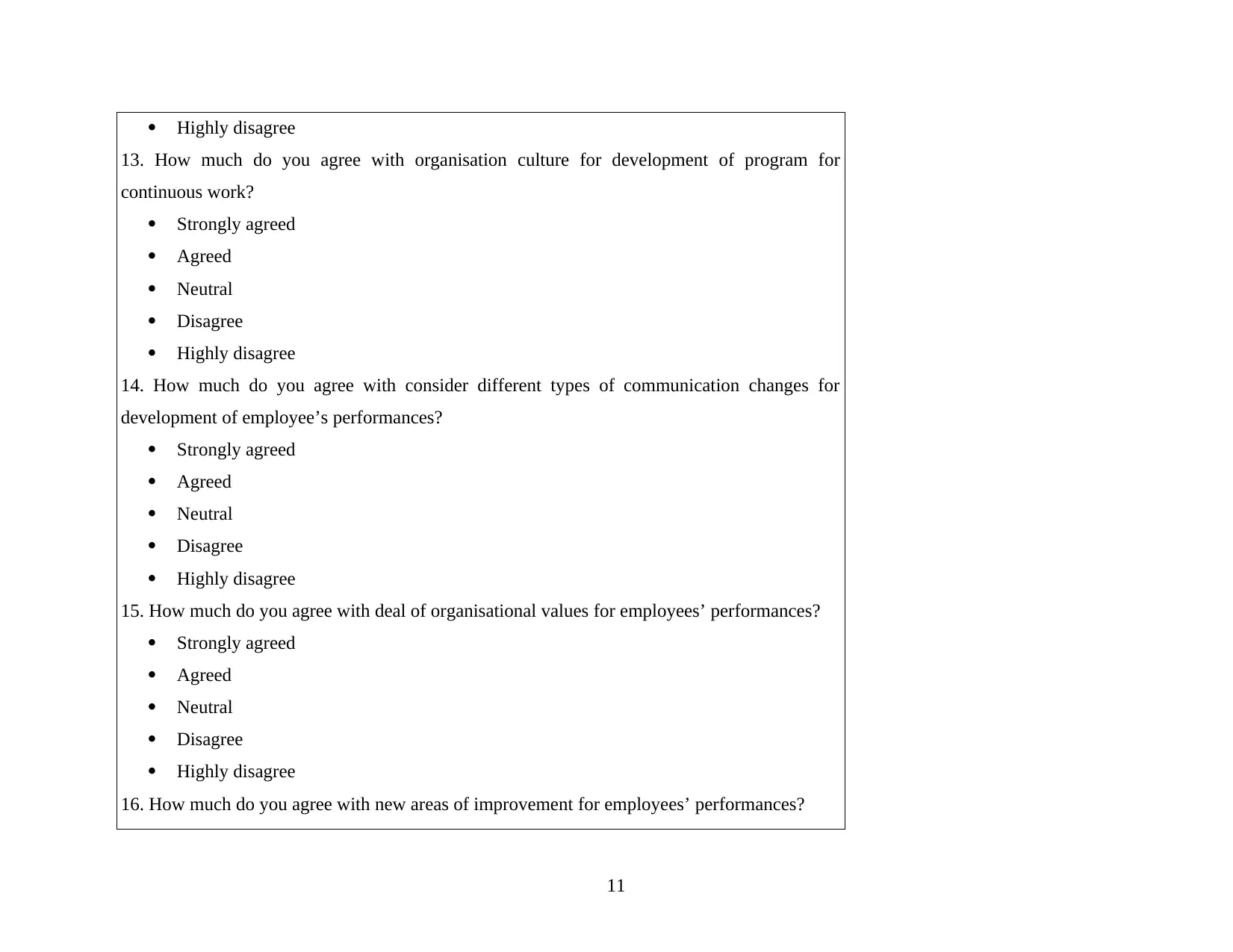
Highly disagree
13. How much do you agree with organisation culture for development of program for
continuous work?
Strongly agreed
Agreed
Neutral
Disagree
Highly disagree
14. How much do you agree with consider different types of communication changes for
development of employee’s performances?
Strongly agreed
Agreed
Neutral
Disagree
Highly disagree
15. How much do you agree with deal of organisational values for employees’ performances?
Strongly agreed
Agreed
Neutral
Disagree
Highly disagree
16. How much do you agree with new areas of improvement for employees’ performances?
11
13. How much do you agree with organisation culture for development of program for
continuous work?
Strongly agreed
Agreed
Neutral
Disagree
Highly disagree
14. How much do you agree with consider different types of communication changes for
development of employee’s performances?
Strongly agreed
Agreed
Neutral
Disagree
Highly disagree
15. How much do you agree with deal of organisational values for employees’ performances?
Strongly agreed
Agreed
Neutral
Disagree
Highly disagree
16. How much do you agree with new areas of improvement for employees’ performances?
11

Strongly agreed
Agreed
Neutral
Disagree
Highly disagree
17. How much do you agree with cultural values that make faster and stronger work in
employee’s performances?
Strongly agreed
Agreed
Neutral
Disagree
Highly disagree
18. How much do you agree with organisational commitment for positive impact on employees'
efficiency?
Strongly agreed
Agreed
Neutral
Disagree
Highly disagree
19. How much do you agree with organisational break down for commitment with employees?
Strongly agreed
Agreed
12
Agreed
Neutral
Disagree
Highly disagree
17. How much do you agree with cultural values that make faster and stronger work in
employee’s performances?
Strongly agreed
Agreed
Neutral
Disagree
Highly disagree
18. How much do you agree with organisational commitment for positive impact on employees'
efficiency?
Strongly agreed
Agreed
Neutral
Disagree
Highly disagree
19. How much do you agree with organisational break down for commitment with employees?
Strongly agreed
Agreed
12
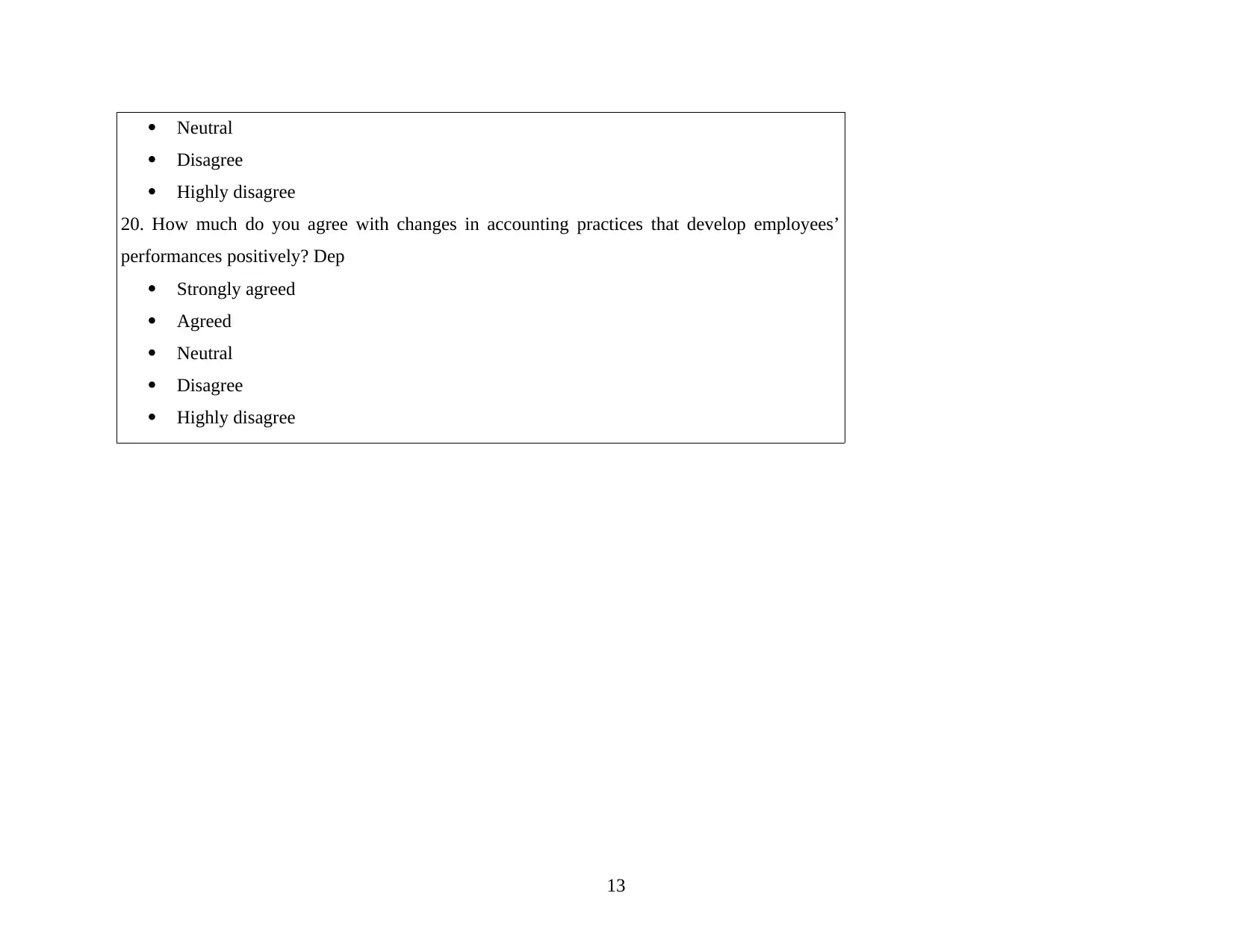
Neutral
Disagree
Highly disagree
20. How much do you agree with changes in accounting practices that develop employees’
performances positively? Dep
Strongly agreed
Agreed
Neutral
Disagree
Highly disagree
13
Disagree
Highly disagree
20. How much do you agree with changes in accounting practices that develop employees’
performances positively? Dep
Strongly agreed
Agreed
Neutral
Disagree
Highly disagree
13
Secure Best Marks with AI Grader
Need help grading? Try our AI Grader for instant feedback on your assignments.

14
1 out of 83
Related Documents
Your All-in-One AI-Powered Toolkit for Academic Success.
+13062052269
info@desklib.com
Available 24*7 on WhatsApp / Email
![[object Object]](/_next/static/media/star-bottom.7253800d.svg)
Unlock your academic potential
© 2024 | Zucol Services PVT LTD | All rights reserved.





